US Ultrarunning Trip
1500 miles, 4 states and 2 time zones through the history of ultrarunning. And 100 miles in the desert, to remember your own name.
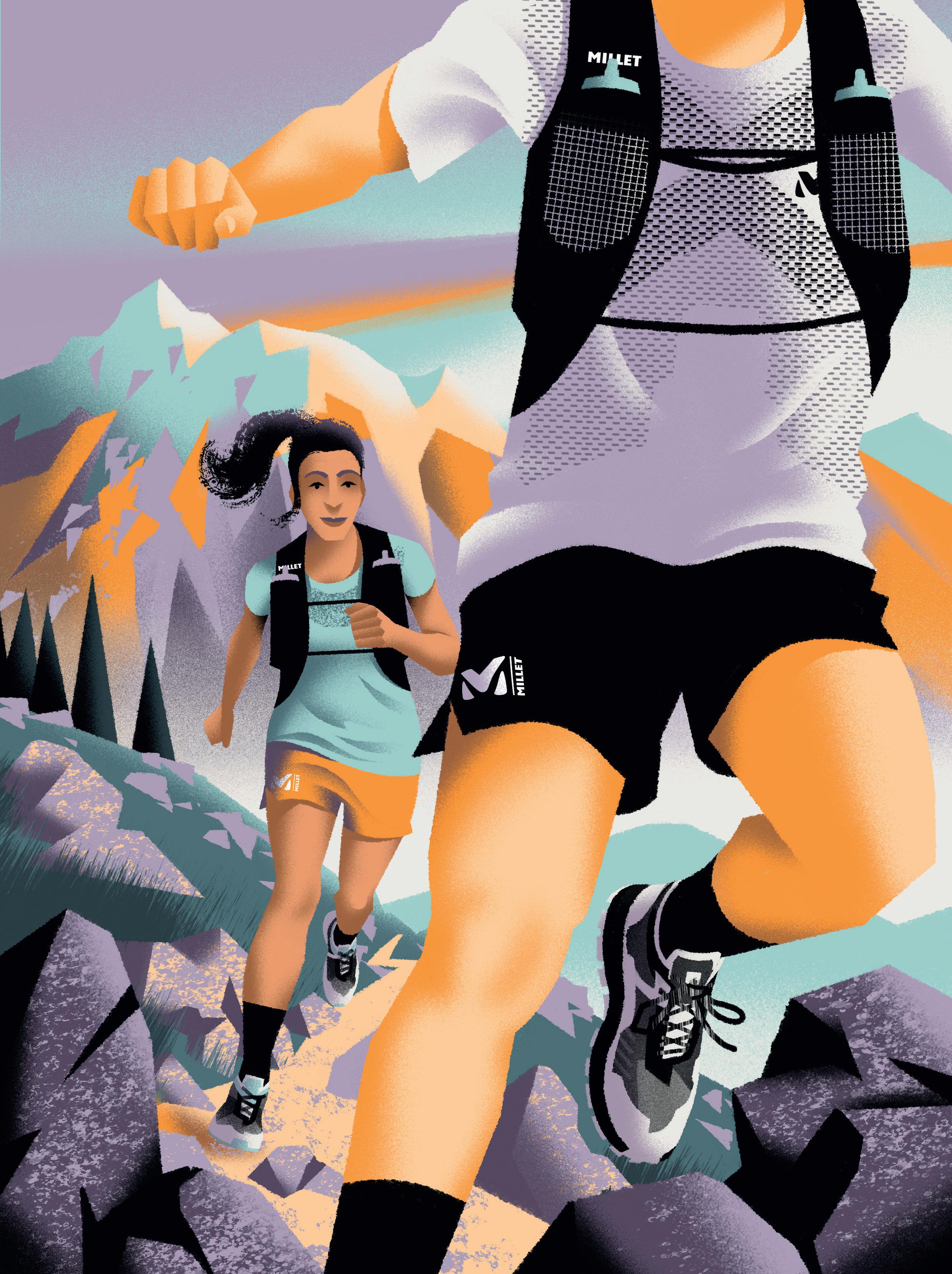
Trail Special
Far and near horizons: athletes, travels, stories, projects, ideas, intuitions and dreams. In short, pieces of life, left on the roadside.
The Speed Project
500 kilometers from Los Angeles to Las Vegas with a team: 90 kilometers each through fictional characters and unlikely places.
€7






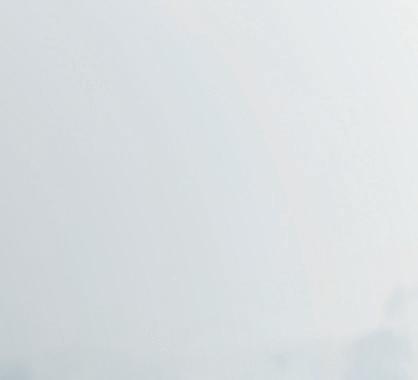







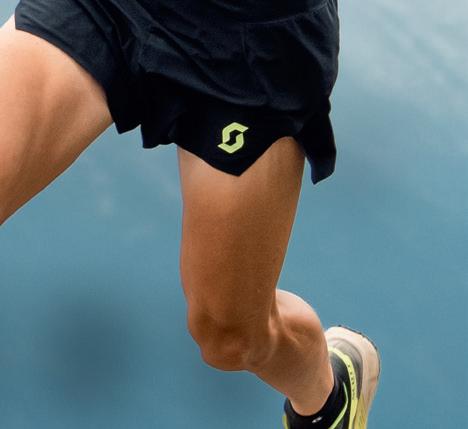
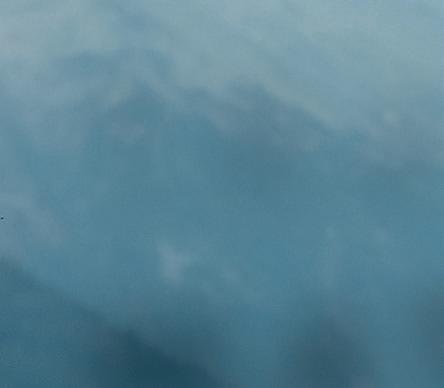




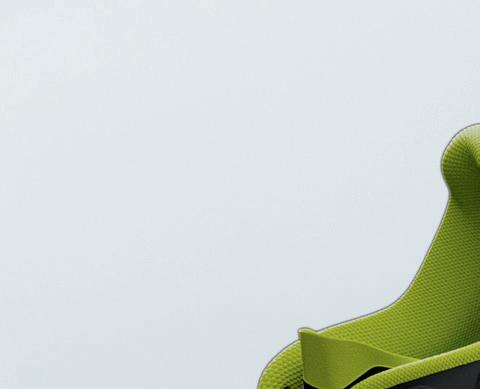

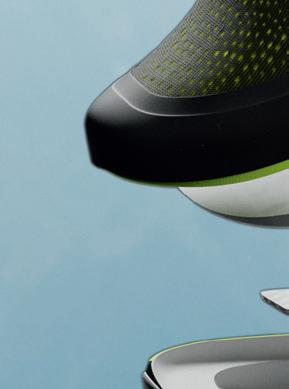



















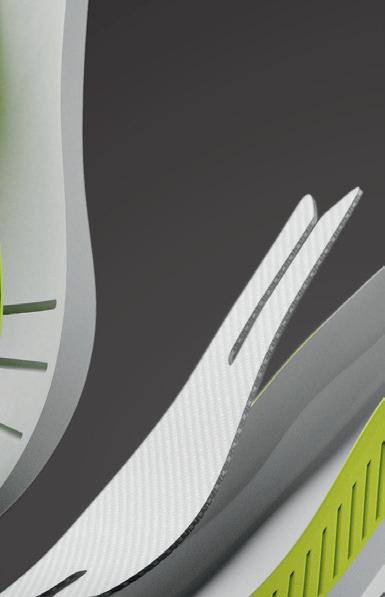






















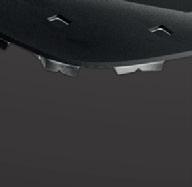



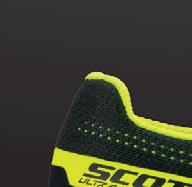



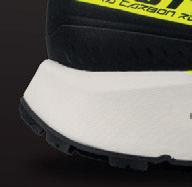
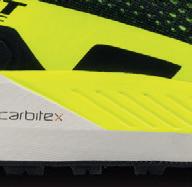
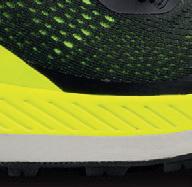










third Brandenburg Concertos in the background. Behind the cashier there is a magazine section with a couple of stools to flip through. I think of an old Joel Wolpert movie, with Krupicka sitting on one of those stools reading Alpinist. Ten years have passed and Denis and I are sitting there browsing through the same legendary magazines: Outside, Alpinist, Ultrarunning Magazine. Outside has its editorial office a few hundred meters after the
and go looking for an ice cream shop. The birches are orange and autumn is late. At Burton's we pick up a couple of snowboard free presses, they're the same as they were twenty years ago. “When I travel I always come home with some magazines” Denis tells me. “I don't know if I'll ever read them all but I like them, I like having them at home, I like looking at them all on display and as the historical memory of my travels, perhaps of my life.”
Denis has been making magazines since he was my age, and this is his 20th something time in the United States for work, for me it's the first. I'm about as old as he was when he started working, but in both cases, at least at a certain point in our lives, we idealized this job. Leafing through Outside today isn't that much of a thing: sure, it's the magazine of stories by Krakauer, Into the Wild and Thin Air, but the paper is poor, the photos are mediocre. However, for me it remains wrapped in an irreducible charm.
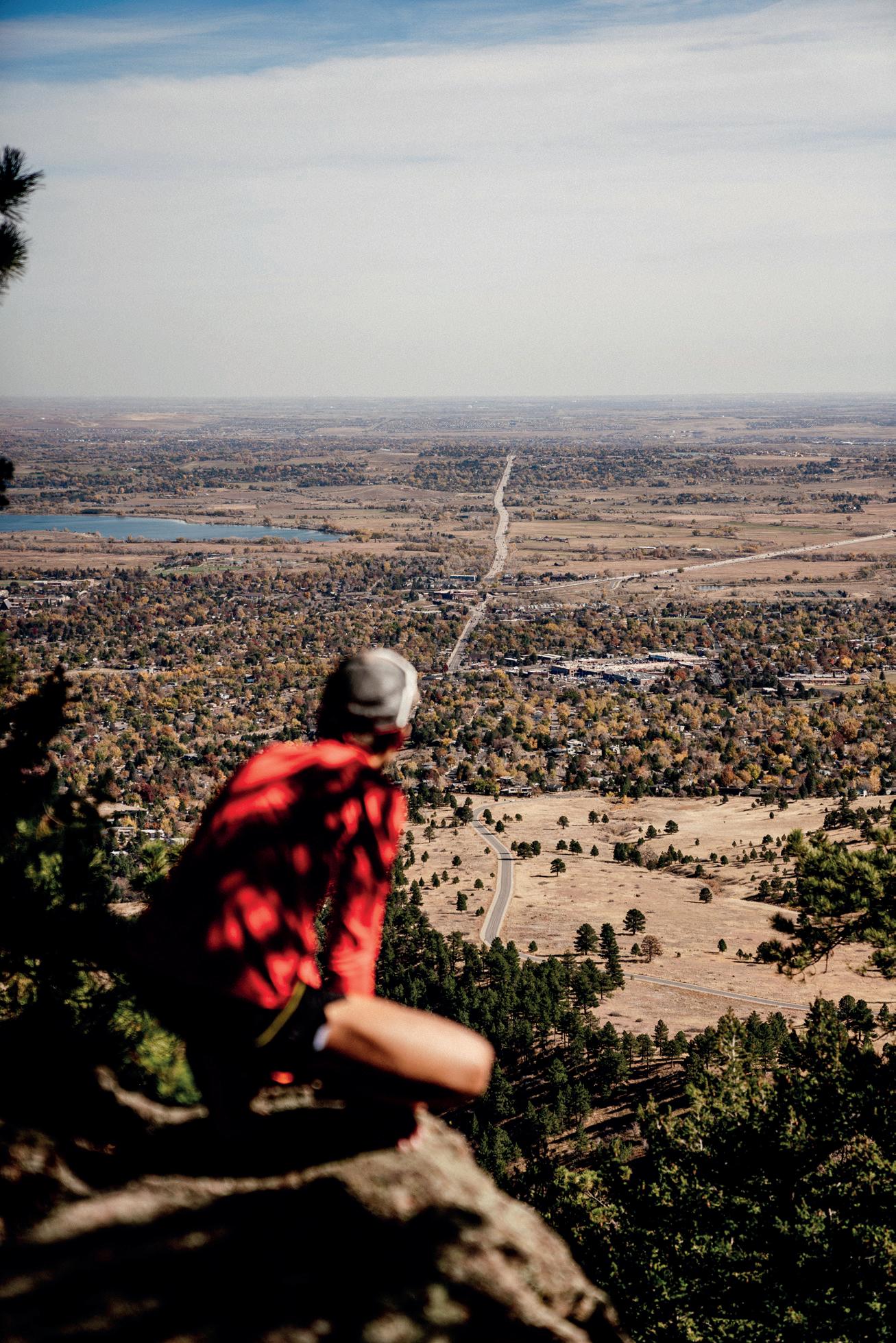
2
RUN. LONGER.
Affronta ogni tipo di terreno, oltre il tempo, oltre la di stanza. Massima stabilità, ammortizzazione e ritorno di energia. Il trail è ai tuoi pie di RUN. LONGER.


CONNESSO UN FIT PRECISO E MICRO-REGOLABILE AVVOLGENTE OFFRE UNA MAGGIORE VELOCITÀ E MIGLIORE STABILITÀ DELLE CAVIGLIE SICURO PENSATO PER OFFRIRE LE MIGLIORI PRESTAZIONI NELLE CONDIZIONI PIÙ DIFFICILI
I started writing for a magazine because I love the very concept of a magazine. I love magazines as an object, I love newsstands. Do you know The Secret Life of Walter Mitty? With Sean Penn shooting for Life and mailing negatives to Ben Stiller who works hidden away in a basement? That thing there. Is our job like this? Rarely. But now I'm in the States to write an article, and that's enough.
While I'm writing a report that becomes the most important thing in my life, regardless of how it's done, it doesn't matter. In that moment it becomes
BY FILIPPO CAON PHOTO DENIS PICCOLO
the thing I care most about and the best thing I've written. Then the article got published and I forget about it, or at least I don't find it that important or that beautiful anymore. I don't know if it will be like this again this time, but I think that this issue, for the moment, comes closest to my ideal of a magazine more than any other. Does it satisfy me completely? No, but I'm still very happy about it.
Inside you will find various reports, interviews, product articles, in short, a little bit of everything you need, and what's more, you will also find a special, a re-
ally long special: 50 pages, four countries, two time zones, three deserts, a mountain range. A special that starts from an idea: to retrace a movement that from the west, from California, where ultrarunning was born in the seventies, returns eastward, towards the mountains, like a tide, and arrives in Boulder, Colorado, where this sport has developed and grown, and where perhaps its descending phase began, and on the other hand where our journey ended. We have retraced the history of this sport, through the places that have marked it, to try to see where we are and where we are going.
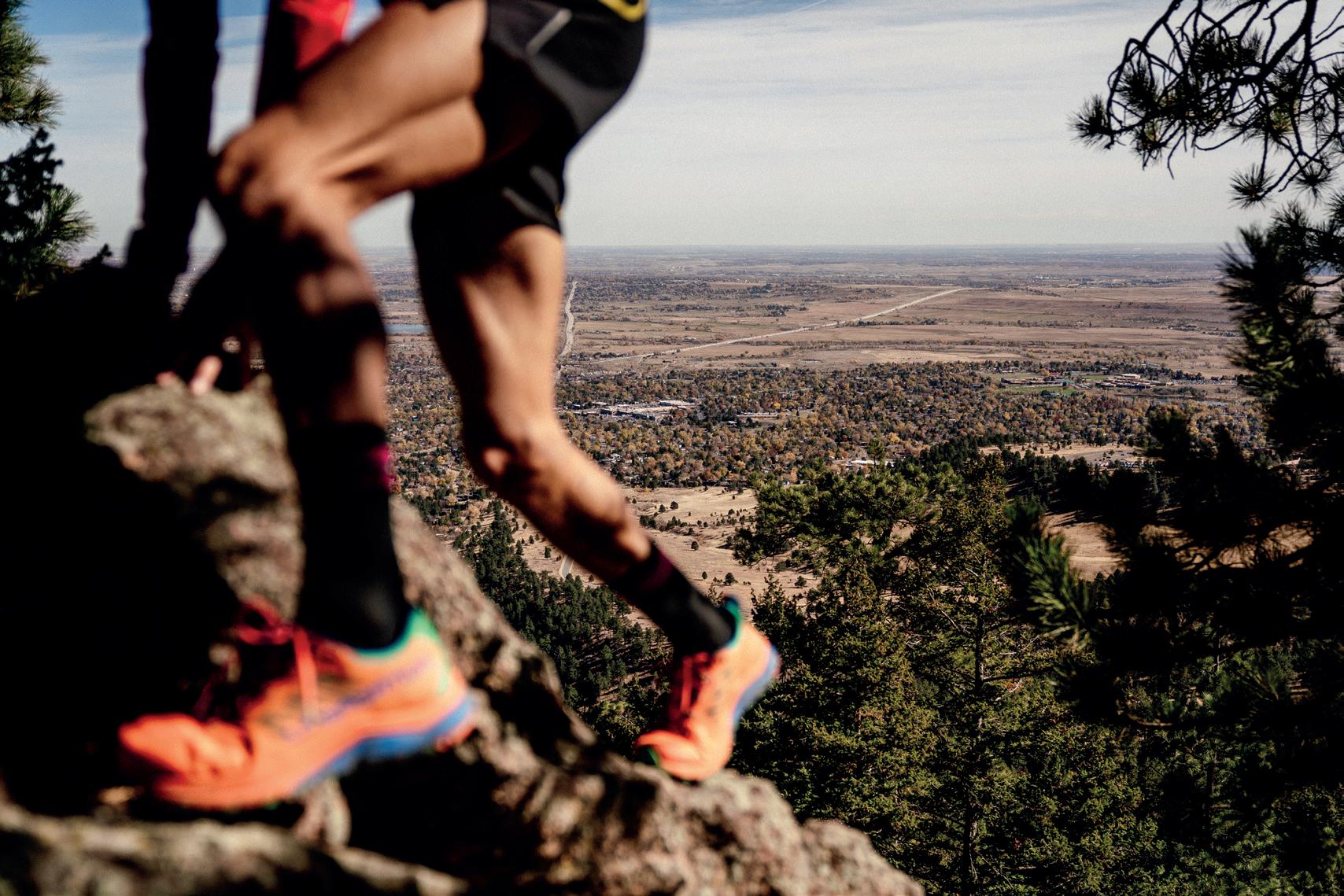
4
EDITO
THE TREKKING COLLECTION


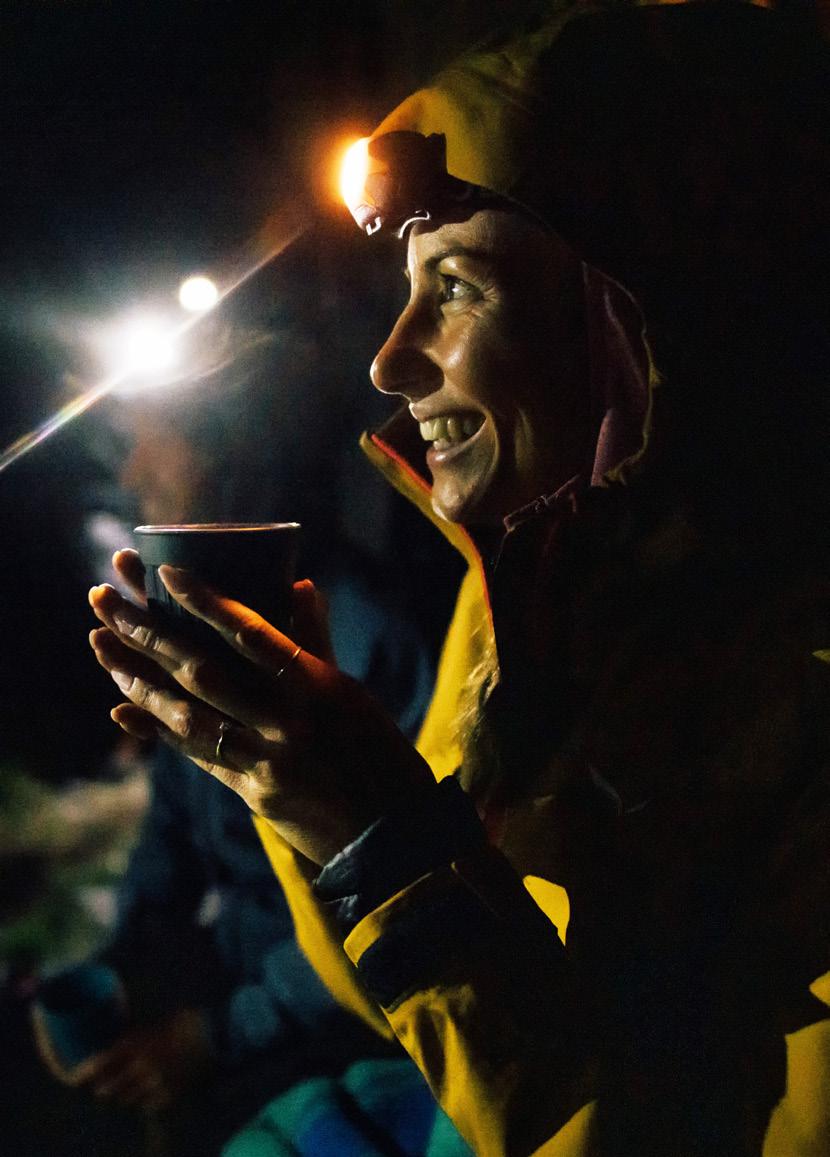

LAGORAI DOLOMITES
PRODUCTION
The Pill Agency | www.thepillagency.com
EDITOR IN CHIEF
Denis Piccolo | denis@thepillagency.com
EDITORIAL COORDINATOR

Lisa Misconel | lisa@thepillagency.com
EDITING & TRANSLATIONS
Silvia Galliani
ART DIRECTION
George Boutall | Evergreen Design House Niccolò Galeotti, Francesca Pagliaro
THEPILLOUTDOOR.COM
hello@thepillagency.com
PHOTOGRAPHERS & FILMERS
Matteo Pavana, Thomas Monsorno, Camilla Pizzini, Chiara Guglielmina, Silvia Galliani, Francesco Pierini, Elisa Bessega, Andrea Schilirò, Denis Piccolo, Achille Mauri, Simone Mondino, Alice Russolo, Patrick De Lorenzi, Giulia Bertolazzi, Tito Capovilla, Luigi Chiurchi, Isacco Emiliani, Pierre Lucianaz
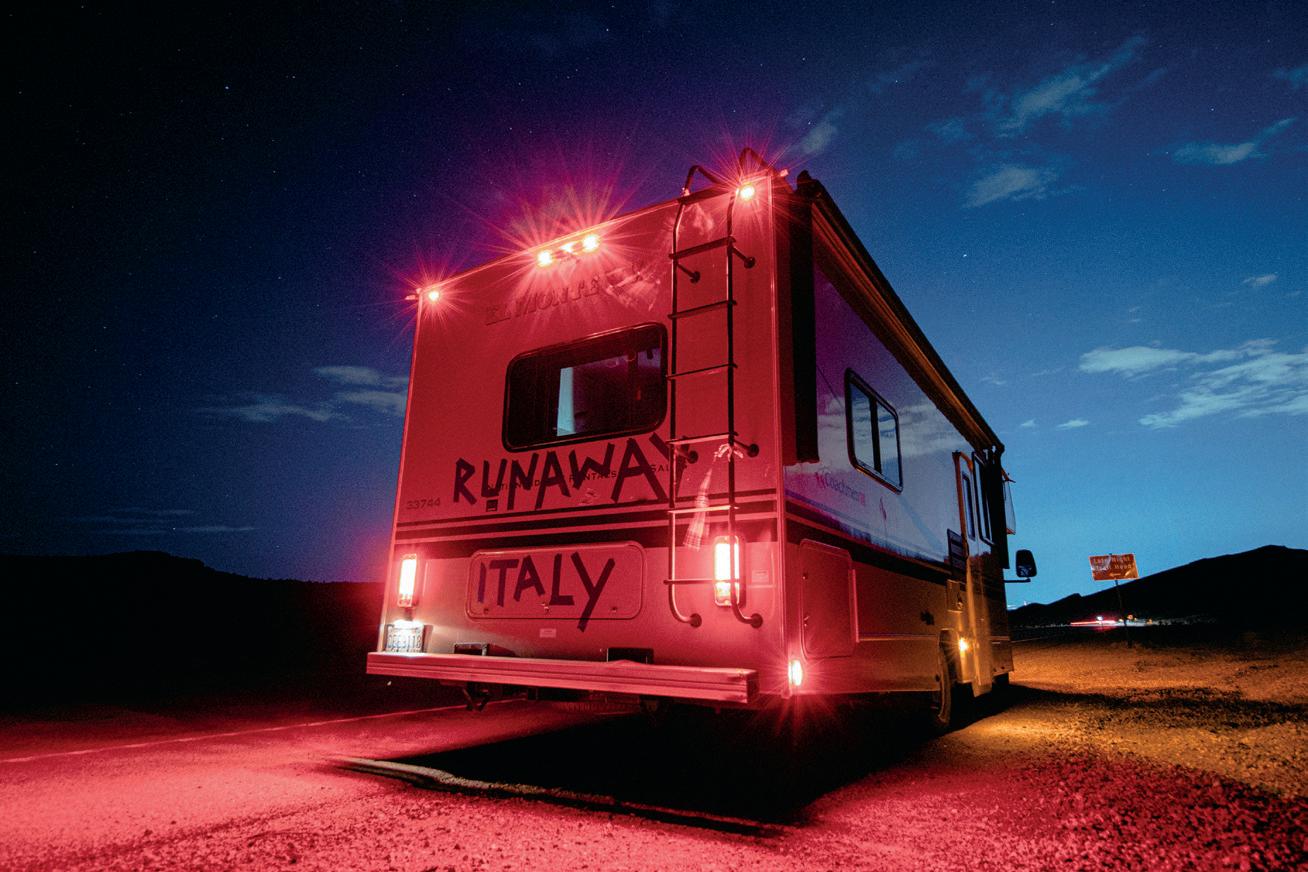
COLLABORATORS
Filippo Caon, Chiara Guglielmina, Marta Manzoni, Sofia Parisi, Fabrizio Bertone, Eva Toschi, Luca Albrisi, Luca Schiera, Giulia Boccola, Valeria Margherita Mosca, Lisa Misconel, Chiara Beretta
SHOP & SUBSCRIPTIONS
www.thepilloutdoorshop.com
SHOP MAGAZINE MAP www.thepilloutdoor.com/magazine-finder
COMPANY EDITOR
Hand Communication, Piazza XX Settembre 17, Saluzzo CN 12037, Italy hello@thepillagency.com
COVER
Illustration Federico Epis X Millet
PRINT
L'artistica Savigliano, Savigliano - Cuneo - Italy, lartisavi.it
DISTRIBUTION
25.000 copies distribuited in 1100 shops in Italy, Switzerland, Austria, Germany, France, Belgium, Spain, England & The Netherlands
ADVERTISING
hello@thepillagency.com | +39 333.7741506
FOLLOW US www.thepilloutdoor.com www.facebook.com/thepilloutdoor Instagram.com/thepilloutdoor
The Pill rivista bimestrale registrata al tribunale di Milano il 29/02/2016 al numero 73
6
THE CREW
PHOTO ACHILLE MAURI
SPIN PLANET LONG DISTANCE, LOW IMPACT.
SPIN PLANET introduces a new sustainability concept into the Trail Running footwear category. Perfect for long distance runs, with protective cushioning and instant comfort.

SCARPA.COM
Go further, together
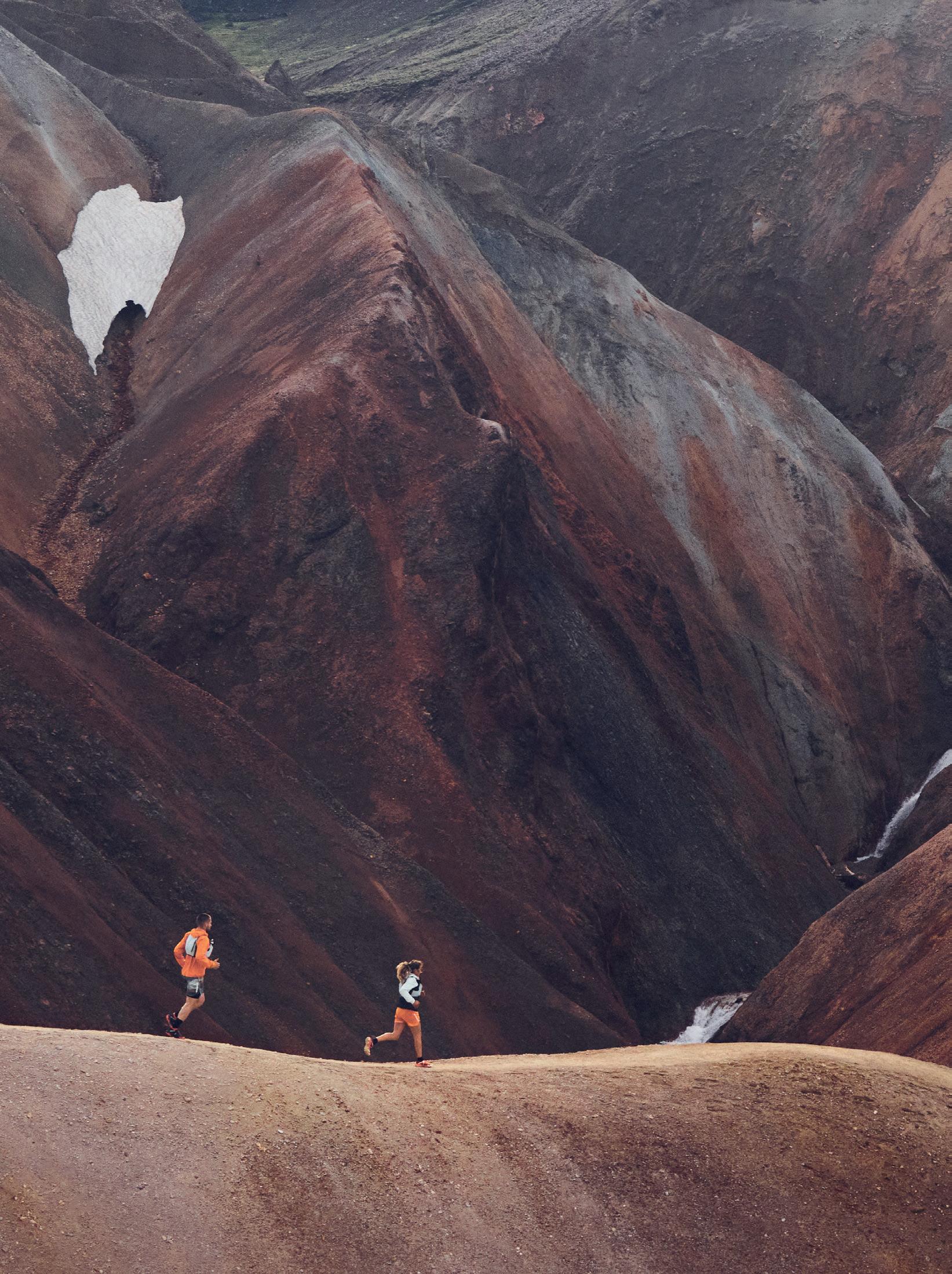
Connected in stride
Inspired by the scenery, driven by the challenge, the bond between runners is the shared pursuit of shaky legs and tested limits. Always there for the next push, Mammut’s trail running collection is made to go further as we reduce our impact together. A 100% decarbonized collection*
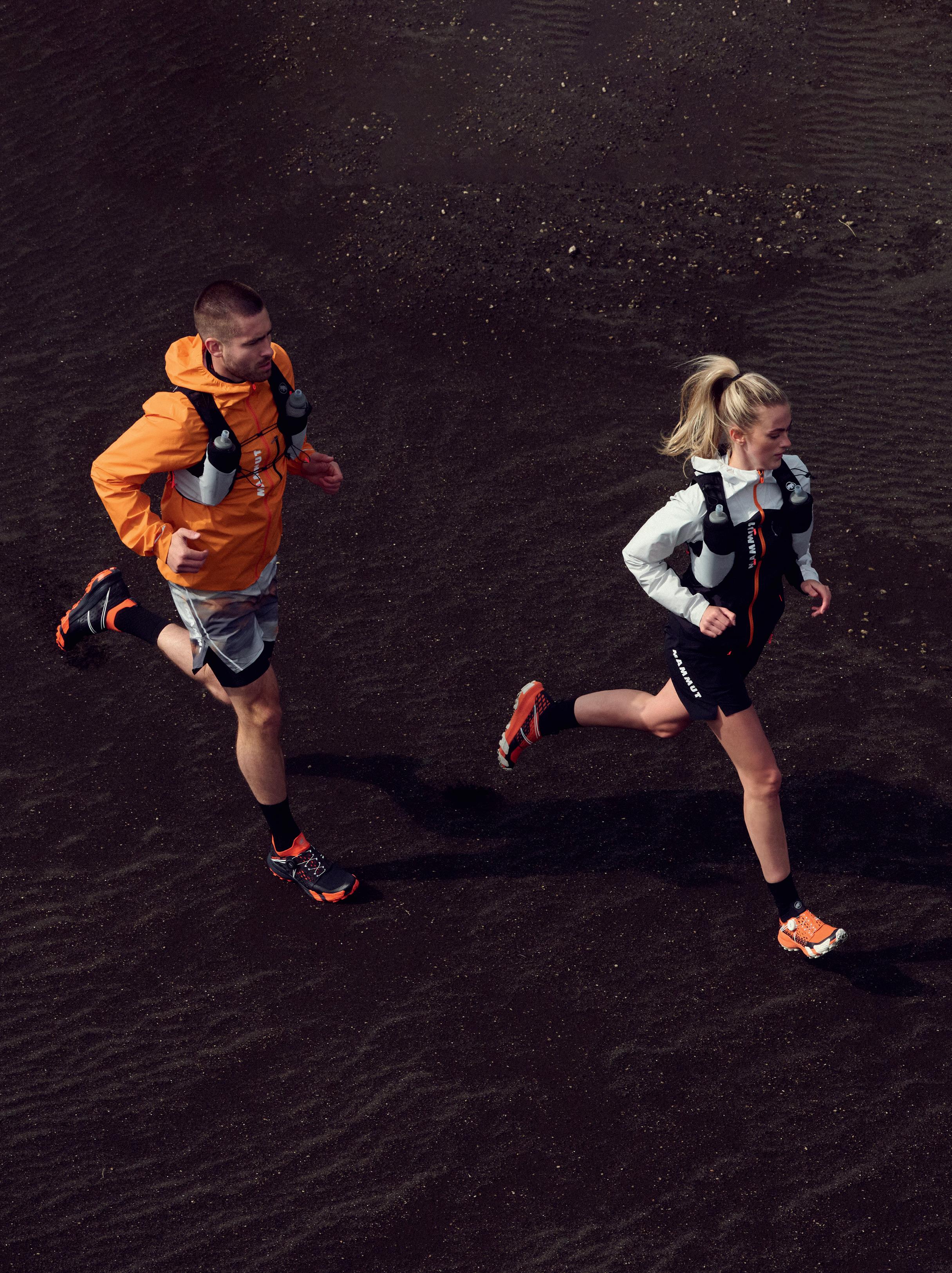
*CO 2 emissions removed with support from Climeworks. Learn more at www.climeworks.com

THE DAILY PILL
BEST MADE
KILLER COLLABS
ECO SEVEN
ULTRA TRAIL SNOWDONIA
ROSANNA BUCHAUER
ODLO
OVERALP SUMMIT
LIVIGNO & BROOKS
ELISA BROCARD
SCOTT ULTRA CARBON RC
CORTINA DOBBIACO RUN
SAUCONY PEREGRINE 13
PICTURE OCEAN PROTECTION
TRENTINO
SUMMER LIFE
LA VENTA
PETER MOSER
BEAR GRYLLS
CHASING RECORDS
BENJAMIN ROUBIOL
SERGIO & PATAGONIA RUN
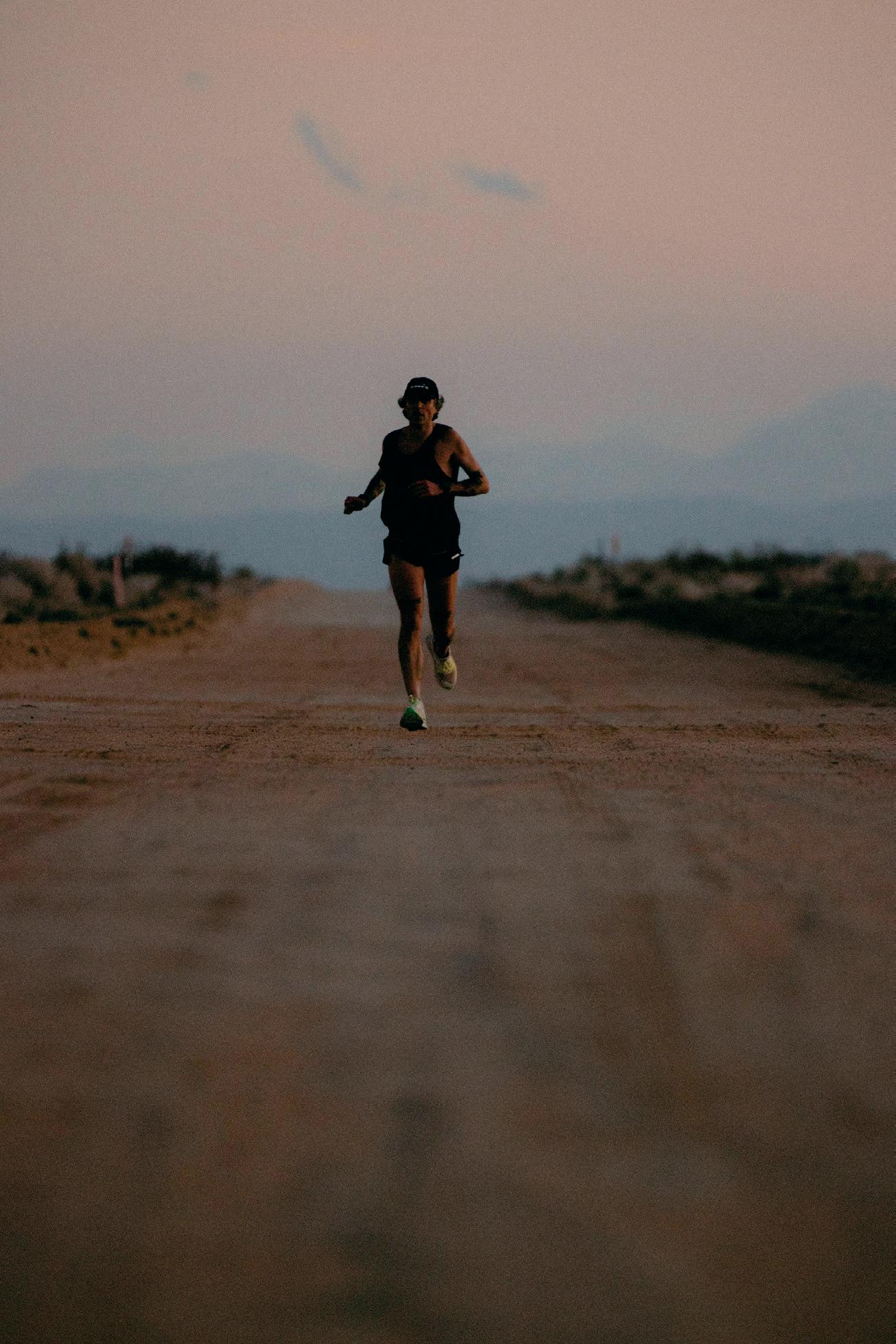
THEO LE BOUDEC
ANTON KRUPICKA
MILLET UP FOR ANYTHING
SCIACCHE TRAIL
MAG MACKENZIE
THE BASQUE FEVER
THE SPEED PROJECT
THE SEARCHERS
10 P.12 P.16 P.20 P.24 P.28 P.32 P.36 P.38 P.40 P.42 P.44 P.48 P.50 P.52 P.54 P.60 P.64 P.68 P.72 P.76 P.80 P.84 P.88 P.92 P.98 P.104 P.108 P.114 P.122 P.138
PHOTO ACHILLE MAURI


THE DAILY PILL
BY SILVIA GALLIANI
THE NEW DYNAFIT ULTRA SET UP FOR THE 2023 SUMMER ULTRAMARATHONS
Ready for more distance? For the 2023 summer Dynafit season presents the new Ultra set up, a system dedicated to ultramarathons and made up of perfectly matched products that fit from head to toe. Among these products are the new Ultra 100 trail running shoes, highly functional and ultra-lightweight garments, Ultra sunglasses, which offer a view with sharp contrasts at high altitudes, and equipment with sophisticated properties for greater comfort and more storage space.
THE NORTH FACE PRESENTS THE NEW FREE CAMPING EQUIPMENT RENTAL SERVICE
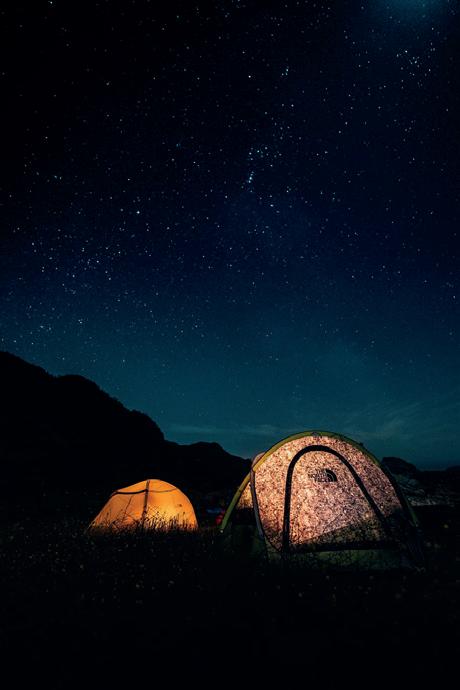
The North Face offers to all those who like to spend their free time outdoors the new free camping equipment rental service, designed to accompany enthusiasts with the best of the technology offered by the brand. The service will start on July 1st for 5 weekends at the Italian stores of Milan, Verona and Turin. In order to take advantage of it, it will be necessary to register for the XPLR PASS loyalty program and select a date of interest.
FERRINO RUNS WITH MEHT AND UTLM
What binds Ferrino to the Monte Rosa area is a real love story. To confirm this historic link, Ferrino has always been close to the initiatives linked to mountain sports that have the Rosa and the neighboring territories as a theater. Last year the partnership with the Monterosa EST Himalayan Trail was born, the great race that takes place on the eastern side of the mountain, a collaboration that will also be renewed this year on the occasion of the fifth edition of the competition, which will be held on 29 and 30 July with its five trails of different length and elevation gain.
MIDNIGHT RUNNERS: MIZUNO BRINGS THE FAMOUS LONDON CREW TO MILAN
On July 15th the "Midnight Runners" will arrive in Milan: the race was born in London in 2015 from the idea of two friends who decided to invite other people to their evening trainings, an engaging experience thanks to bluetooth speakers. Since 2023 Mizuno has been a global partner of the project which joins the brand's local initiative "For Every Run Tour": a journey involving 18 retailers with the aim of testing the brand's new models in an atmosphere of fun and good vibes. The event in Milan will also mark the launch of the new Wave Sky 7.


AKU EXPANDS ITS REFUGE NETWORK TO 13 FACILITIES
With the arrival of the summer season, the mountains are preparing to welcome hikers and mountaineers eager for adventure. Among the numerous structures in the Alps, 13 are part of the Aku refuge network. Launched in 2021 with 4 facilities, it now includes 13 refuges in the Alps and in the Apennines. In addition to providing the managers and service personnel with suitable footwear for carrying out the work inside and outside the refuge, the collaboration with Aku envisages shared communication actions and support for initiatives aimed at promoting a more responsible, safe and low cost approach to the mountains environmental impact.


12

THE DAILY PILL
BY SILVIA GALLIANI
JACK WOLFSKIN AND REINHOLD MESSNER ANNOUNCE THEIR COLLABORATION
Outdoor icon Reinhold Messner and his wife Diane will become advisors and members of the Brand Council of Jack Wolfskin, one of the world's leading specialists in outdoor clothing, equipment and footwear. The couple and other international members will work to develop strategic sustainability concepts and long-term rewilding projects. The brand follows the principle "Rewild yourself - Rewild the world" and supports all those who reconnect with nature and share its knowledge. Attention is also focused on the reconstruction of ecosystems.
MILLET IS OFFICIAL PARTNER OF THE MASTERS SKYRUNNING WORLD CHAMPIONSHIP

Millet has signed the sponsorship agreement for the first Masters Skyrunning World Championship to be held on July 30th at the Royal Ultra SkyMarathon in Ceresole Reale. The agreement sees the French brand alongside the International Skyrunning Federation and confirms its vertical DNA and commitment to high altitude running. This is the first competition dedicated to the Masters category where skyrunners over forty will compete for the title in a 55km race that crosses hills, moraines and snowfields up to an altitude of 3002 metres.
LA SPORTIVA STRENGTHENS ITS STRATEGIC POSITIONING BY ACQUIRING MEET ITALIA

La Sportiva takes an important step to consolidate its high quality Made in Italy production chain. The company led by the Delladio family has in fact acquired the majority stake in the Veneto-based company Meet Italia, a historic manufacturer specialized in the production of mountain footwear that has always been Made in Italy. The relationship between the two companies consolidates a strategic partnership of more than twenty years that goes from the supply of semi-finished products to the creation of some historical models of the Trentino company.
MATTEO DELLA BORDELLA STARTED THE APPROACH HIKE TO OGRE

The mountaineer member of Ragni di Lecco and his companions François Cazzanelli, Silvan Schüpbach and Symon Welfringer began the approach hike to Ogre (7285m). It is one of the most beautiful and difficult mountains in Karakorum, Pakistan. Della Bordella's climbs are always conducted with a light approach and "by fair means", respectful of the mountains and of their natural context. Matteo has found valid support in this sense in the collaboration with Ferrino, which places the best of its technical equipment at his disposal.
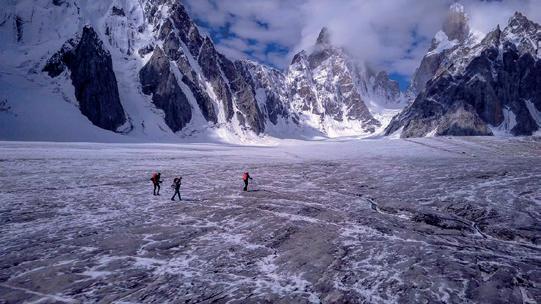
GARMIN PRESENTS FENIX 7 PRO AND EPIX PRO: THE IDEAL COMPANIONS FOR OUTDOOR ADVENTURES
In the snowy setting of the Skyway Monte Bianco, Garmin presented the new fēnix 7 Pro and epix Pro multisport smartwatches, the latest arrivals that will surely make many outdoor sports enthusiasts happy. Among the many innovative features, the Pro series are equipped with functions dedicated to training and competition, even clearer navigation and in-depth monitoring of the state of physical fitness. Both models are designed to support athletes and outdoor enthusiasts and push them to give their best in any context.

14

ROSANNA BUCHAUER READY FOR MORE DISTANCE ULTRA
1.LA SPORTIVA
TRACER T-SHIRT
Short runs and quick training sessions require comfort and functionality. The innovative S-Café technology, which combines recycled coffee grounds on the surface of the yarn, naturally regulates odors and perspiration. The athletic design follows the movements of the body and it is enriched by reflective details.

4.BROOKS
C ASCADIA 17
The latest version of Brooks' flagship trail running model, Cascadia 17 is improved and features new technical details for even higher performance. With Trail Adapt stabilization system for stability and safety on the most technical trails. On the sole there’s a TrailTrak Green lugs system for great traction with 25% recycled materials.
BEST MADE
BY DAVIDE FIORASO
2.NEW BALANCE


S UMMIT UNKNOWN V4
FuelCell midsole with high energy return, particularly aggressive Hydrohesion sole, combined with a Rock Stop Plate that guarantees traction on wet and treacherous surfaces. Bootie-style upper that offers just the right amount of support and helps keep feet clear of debris. Designed to move quickly on technical terrain.
5.MILLET
I NTENSE BEL T
Large elasticated compartment for soft flasks, side mesh pockets, zipped pocket, key clip, smartphone pouch and pole holder. Equipped with an emergency whistle, this trail running belt in recycled polyester was developed together with the Sidas Matryx Team. Available in four sizes.
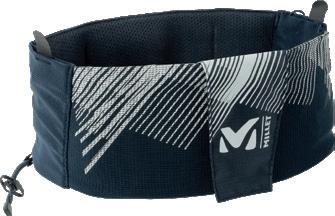
3. BLACK DIAMOND
D ISTANCE 4 HYDRATION VEST

Designed for long distances, the second generation of the Black Diamond vest features an innovative stretch structure that further improves fit and comfort during the race. Z-Pole carrying system, large quick access back pocket, HydraPak soft flasks included
6.MIZUNO
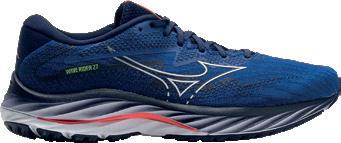
WAVE RIDER 27
The 27th edition of the iconic Wave Rider reconfirms itself as the running shoe suitable for everyone. The renewed upper in jacquard mesh, even lighter, and the improved fit of the heel complete the perfect formula for daily trainings. A dynamic shoe that combines cushioning, speed and support.
16
1.
2.
3.
4.
5.
6.
MONT BLANC BOA ®


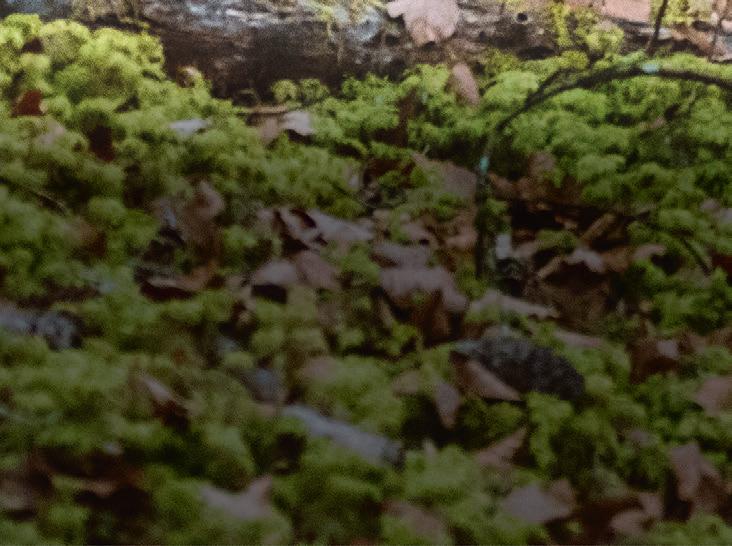

COMFORT MEET SPEED
THÉO LE BOUDEC ALTRA ELITE ATHLETE


FOOTSHAPETM TOE BOX



Indossare per la prima volta un paio di scarpe Altra Running significa eseguire prestazioni eccezionali con un comfort mai provato prima. Ma non solo: indossare una scarpa Altra significa anche correre verso una nuova passione, un nuovo record personale, nuovi obiettivi e tanto altro ancora.





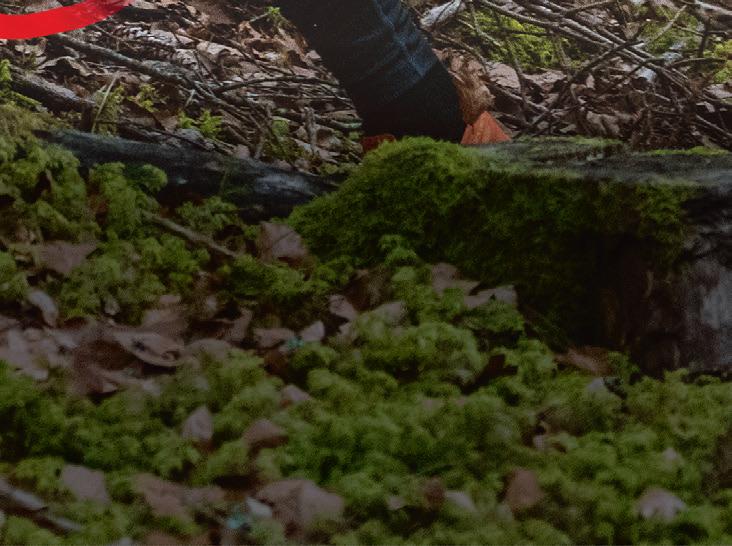
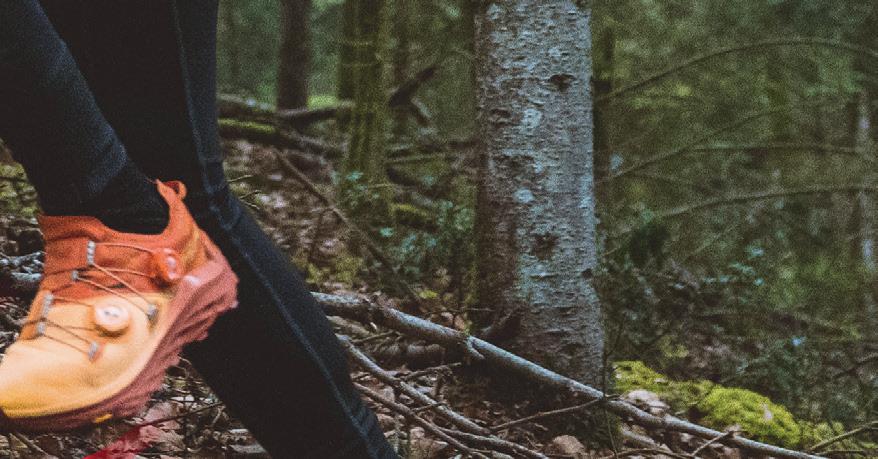
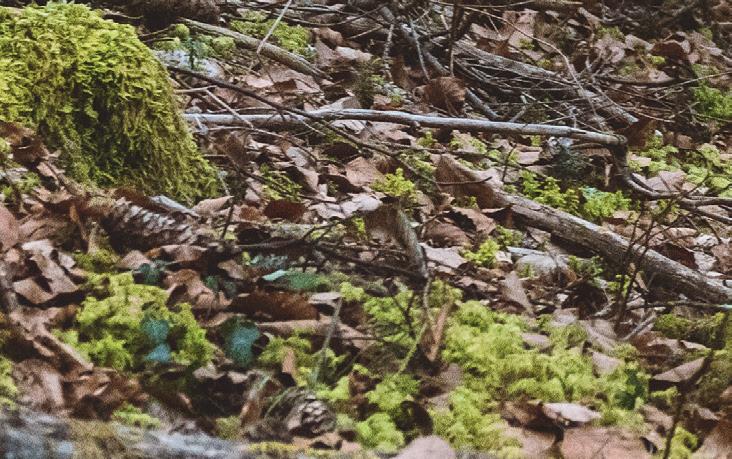
Scopri di più

ALTRARUNNING.EU
8.SUUNTO V ERTICAL

The highest standards of durability, the best accuracy on the market, offline cartographic maps, an incredible battery life enhanced by solar charging. Suunto Vertical is the new GPS sportwatch for exploring the highest peaks and steepest valleys. Made entirely in Finland with 100% renewable energy.
10.JACK WOLFSKIN
3D AERORISE 40
Breathable, robust and comfortable: 3D Aerorise 40 has an innovative carry system for unprecedented comfort. Four independent 3D-printed panels on the shoulders and lumbar areas provide a lightweight, multi-zone body fit. The panels’ open cell structures with thousands of individual struts enhance ventilation, maintain comfort and improve load control.
BEST MADE
BY DAVIDE FIORASO
8.ALTRA
MONT BLANC BOA
Made from the same features as the original Mont Blanc, it integrates PerformFit Wrap technology with a double dial BOA Fit System, for quick and precise micro-adjustment during the run. Designed to face long distances in maximum comfort thanks to the Standard FootShape Fit and the Ego Max midsole.
11.SALEWA

E RGO TEX SET VIA FERRATA
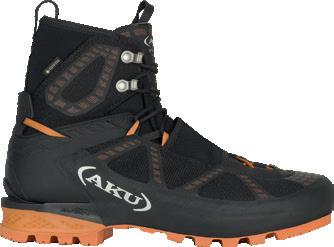
Lightweight, highly ergonomic and ultra-compact via ferrata set with easy-to-use, self-locking Ergotec 3.0 carabiners, abrasion-resistant bungee cords and special integrated swivel system to prevent tangling. Equipped with a compact tear-off heatsink and a rest ring. It can be stored in a handy mesh pouch.
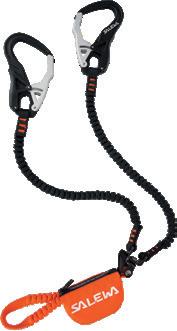

9.AKU
VIAZ DFS GTX
Viaz DFS GTX redefines a new standard of multipurpose footwear for technical and fast mountaineering, demanding hiking and via ferrata. Evolution of the historic Viaz model, it uses Dynamic Fit technology which allows you to dynamically adapt the heel tension to your step, with better comfort and stability.
12.SAUCONY

ENDORPHIN RIFT
Saucony presents Endorphin Rift, to push yourself at maximum speed on any trail. This trail shoe combines some of the brand's most advanced technologies in a lightweight design. PWRRUN PB cushioning for a feeling of lightness and maximum energy return, PWRTRAC outsole for high grip even off the beaten track
18
7. 8.
9.
10.
11.
12.
CURIOUS BY NATURE
We venture out into nature to reconnect with ourselves and change our perspective to look at things differently than before.
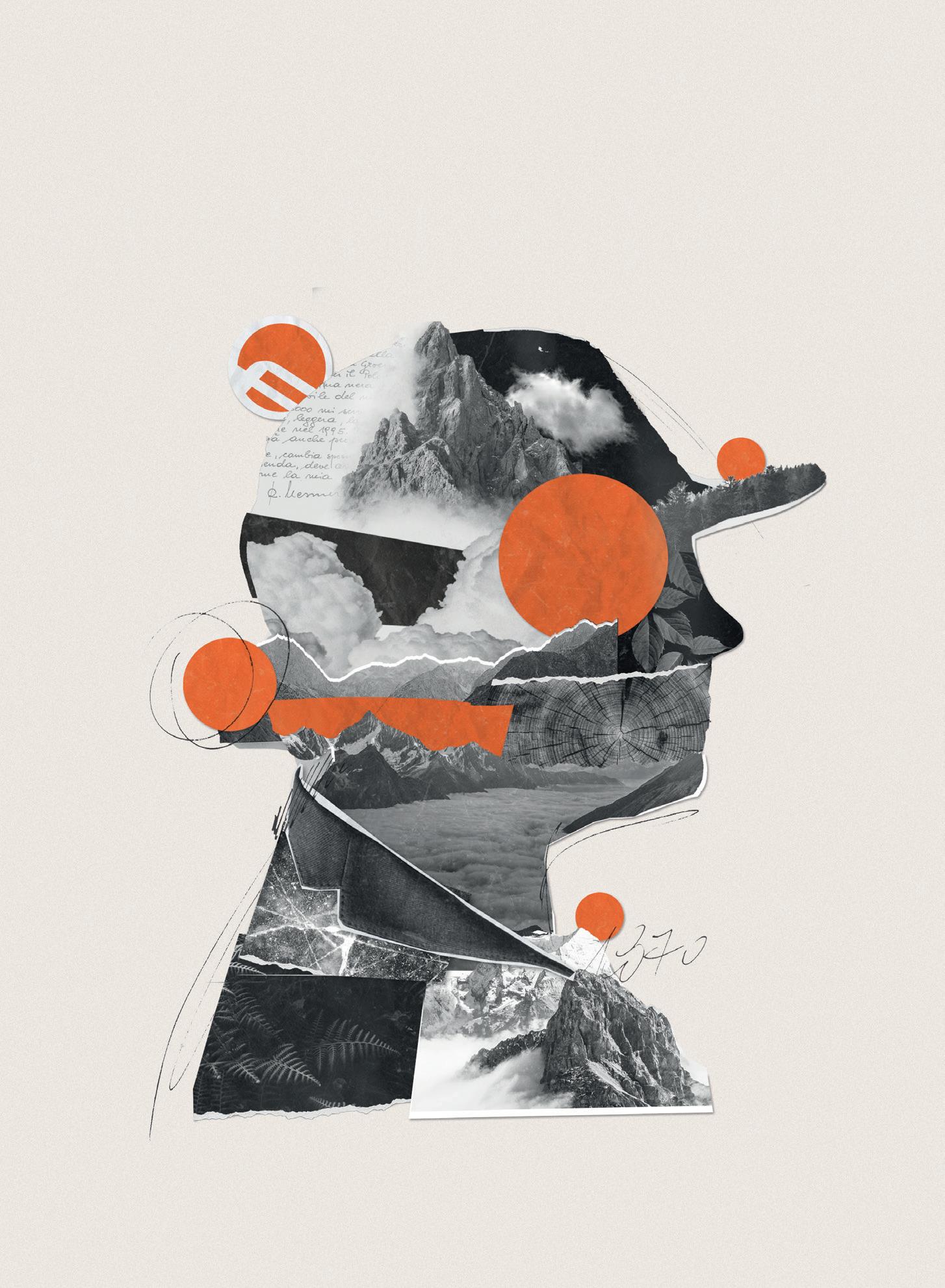
Contemporary outdoor since 1870
1.L.L. BEAN X BEAMS GREENLABEL

Beams revealed its collaboration with LL Bean, a historic outdoor gear brand based in Freeport, Maine. Part of a wider deal with sub-labels Beams Plus and Beams Boy, the full collection of relaxed fit casual wear was presented in a lovely campaign themed “a little clever daily wear”.
4.BRAIN DEAD X OAKLEY
Throughout its evolution, the Radar collection has taken on different forms, adapting to an ever-changing environment. This release marks an important starting point, the birth of the Oakley Factory Team, an innovation laboratory created by Oakley with Brain Dead, a collective of artists and designers founded in Los Angeles in 2014.

KILLER COLLABS
BY DAVIDE FIORASO
A model that was born from the incubator of ideas called Merrell Mountain Lab, and evolved into the 1TRL collection, designed for those looking for other dimensions off the trail. A concentrate of style and functionality in two new colors proposed by Reese Cooper, Californian stylist and multidisciplinary artist.

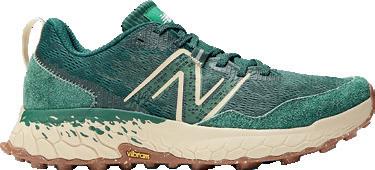
5.CIELE ATHLETICS X ROARK

The Lost and Found is the new joint adventure between Ciele and Run Amok, born in Tahiti, deep in the jungle. The Bommer Ridge Short has been updated with a lightweight perforated 4-way stretch fabric that improves breathability. Compression lining, pockets with magnetic closure, pockets with zip on the back.
3.PAS NORMAL STUDIOS X SALOMON XT 20 HIKING BAG

Salomon and Pas are back with the second chapter of the collaboration presented at the beginning of 2023. It is a small capsule characterized by an olive green color. The RX Snug sneaker is accompanied by the XT 20 backpack, designed for those who love traveling and hiking. Bold design, soft fabrics and endless compartments.
6.PARKS PROJECT X NEW BALANCE FRESH FOAM HIERRO V7
Among the many initiatives of Parks Project, in support and protection of American national parks, the collaborative debut with New Balance stands out: a large collection of functional clothing and the reworking of the Hierro V7 in a Nightwatch Green upper reinforced by suede overlays.
20
1.
2.
3.
5.
4.
6.
BOMMER SHORT 3.5"
RADAR EV PATH
2.RC X MERRELL 1 TRL MTL LONG SKY 2
SWEAT HOODIE
Soften your impact.
Fresh Foam X More Trail
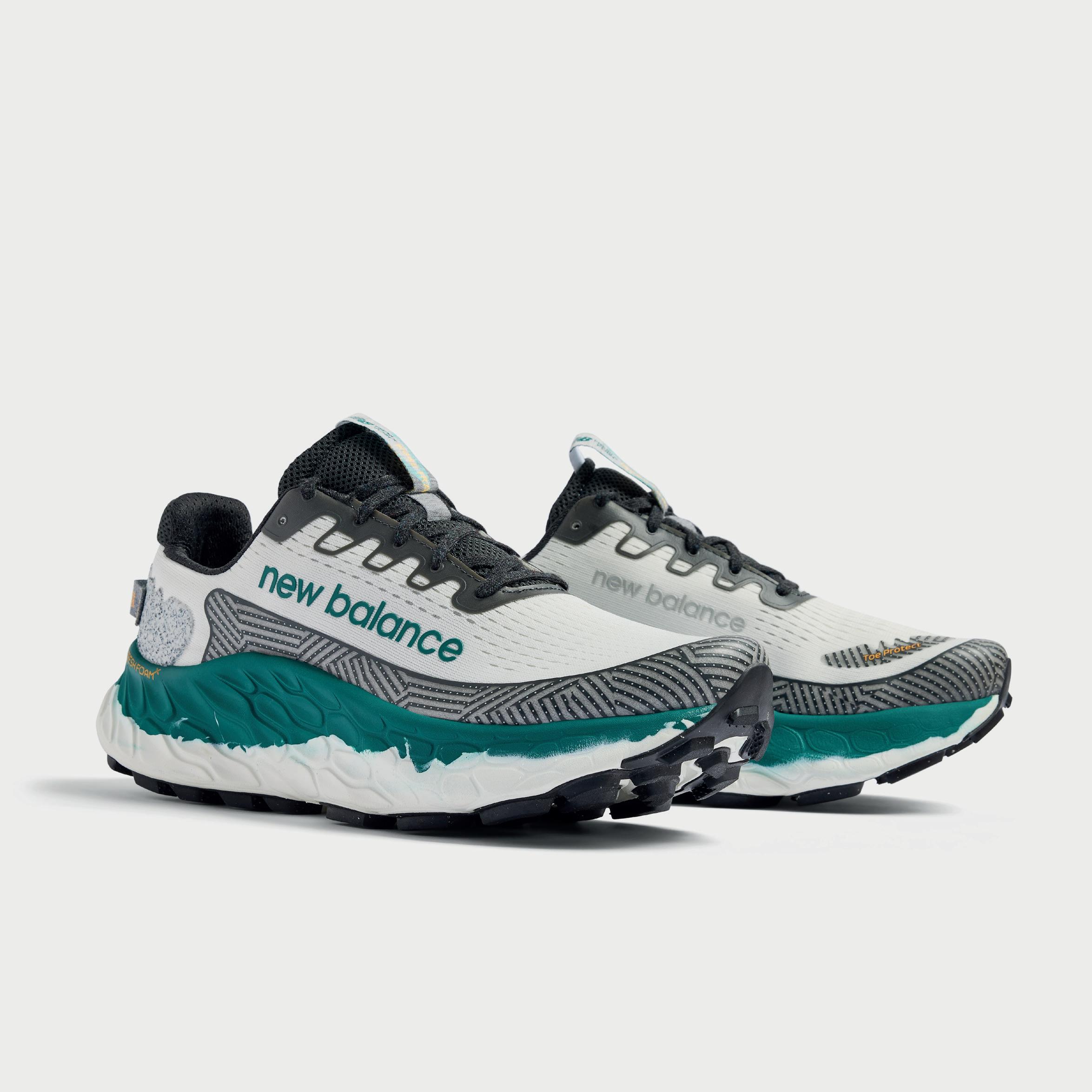
7.SKIDA X WILD RYE BRIM
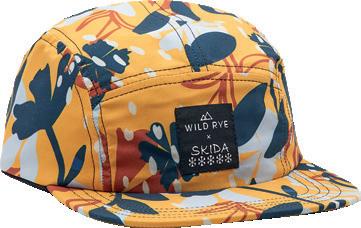
The meeting of two brands, all female, who share a passion for beauty: Wild Rye, B-Corp of the Sun Valley and Skida, a headwear and accessories company based in Vermont. Brim Hat is a lightweight, packable and quick drying cap for all outdoor occasions. Available in this unique Chonky Floral print.
10.HOKA X COTOPAXI ANACAPA BREEZE LOW
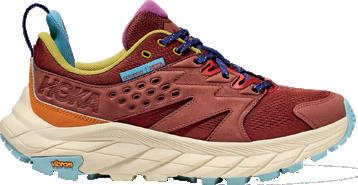
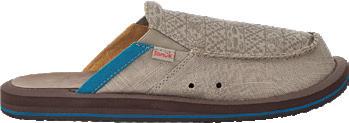
After the 2021 success, Cotopaxi renews the collaboration with the brand of the Deckers group. It does so with another impactful interpretation, the one on Anacapa Breeze Low, whose ultra-ventilated upper offers a lively remix supported by the main Hoka performance features: Vibram Megagrip sole and enlarged Hubble heel.
KILLER COLLABS
BY DAVIDE FIORASO
8.STANLEY X PENDLETON
CLASSIC PERFECT-BREW POUR OVER SET
The authentic Pendleton pattern is once again paired with Stanley form and function in a set that honors and supports wilderness firefighters. The stainless steel pour-over includes a reusable filter, while the Camp Mug's legendary vacuum-sealed construction will keep your coffee at the perfect temperature.
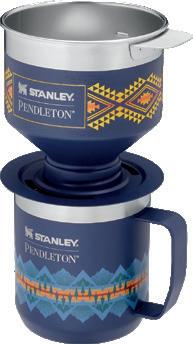
11.FAXE KONDI X SAYSKY COMBAT T-SHIRT

Saysky's Scandinavian style, urban and casual, is revived with the iconic colors of Faxe Kondi, a Danish drink produced for more than 50 years by Faxe Bryggeri. In the collection this version of the Combat running t-shirt in SAYSKYDRY performance fabric. On the sleeve there’s the slogan "Når der går sport i den”: when there is sport inside.
9.STONE BREWING X SANUK YOU GOT MY BREW ST
Classic Sidewalk Surfer ideal for ensuring comfort from day to night. 100% hemp upper with traditional raised toe stitching, leather-lined Bloom foam Soft Top footbed and co-branded detail to highlight the collaboration with Stone Brewing, one of the largest craft breweries in all of California.
12.THE NORTH FACE X ONLINE CERAMICS BASE CAMP GEAR BOX
The North Face announces the second chapter of the collaboration with Online Ceramics, a streetwear brand, founded in Los Angeles in 2016, known for its hand-dyed t-shirts. Among the new proposals, the Base Camp Gear Box bag in recycled polyester, ideal for carrying the equipment thanks to its foldable metal supports.
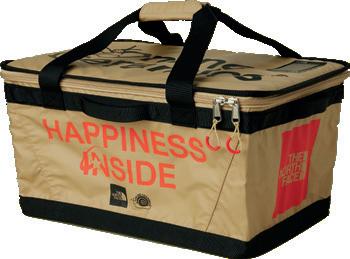
22 7. 8.
9. 10. 12.
HAT
11.
Non farti ostacolare dalle intemperie. Libera il tuo istinto animale con la collezione High Point, che ti o re massima libertà di movimento, spazio e protezione. D'ora in poi completa la tua dotazione trail con i nuovi capi dotati di sistemi di termoregolazione in lana merino e le giacche impermeabili 14K/14K.
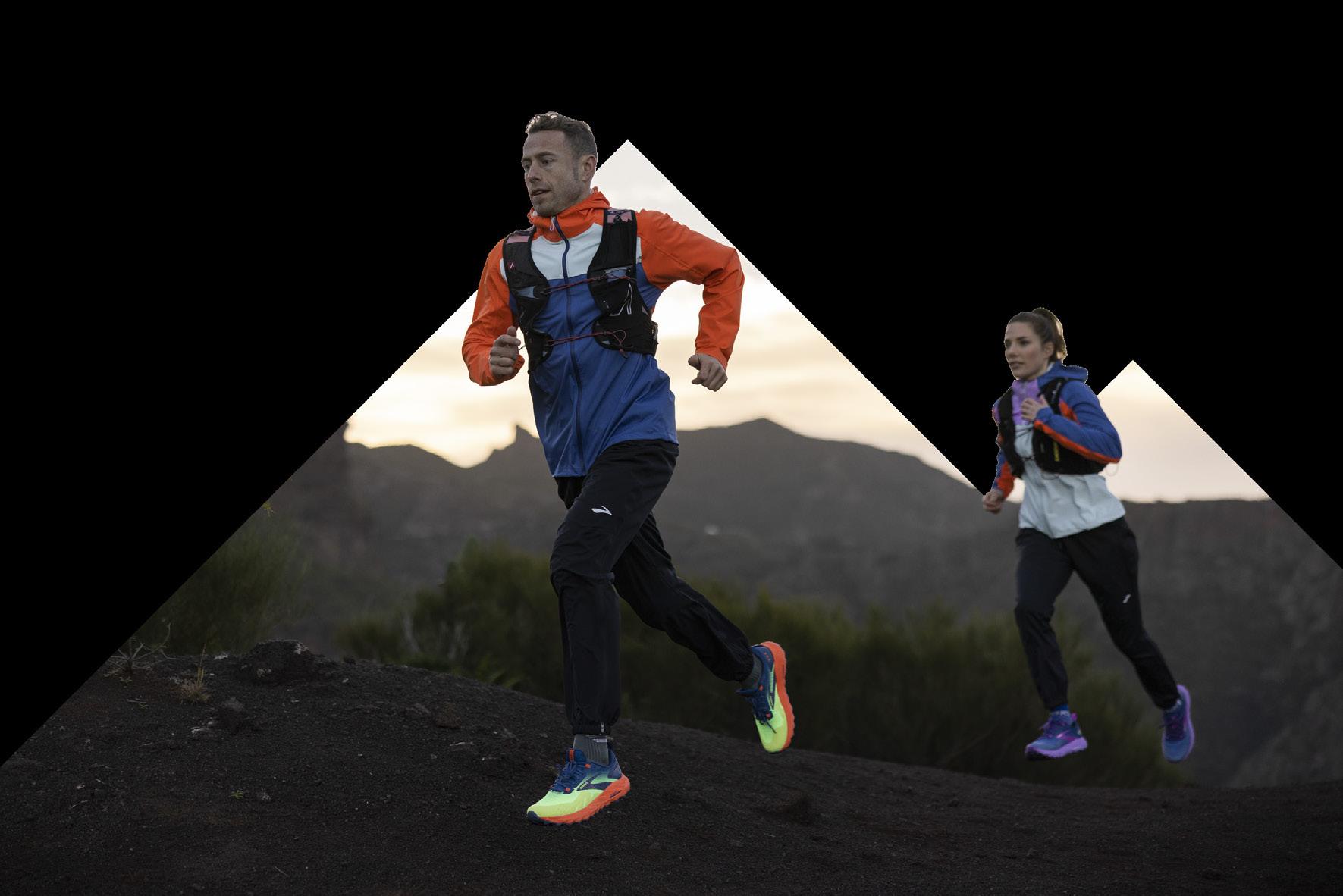

ECO SEVEN
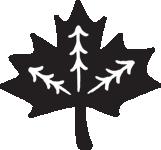 BY DAVIDE FIORASO & SILVIA GALLIANI
BY DAVIDE FIORASO & SILVIA GALLIANI
S CARPA: HERVÉ BARMASSE IS THE NEW SUSTAINABILITY AMBASSADOR
SCARPA renews the tradition that links its brand to the most important protagonists of international mountaineering: Hervé Barmasse will in fact be the new brand ambassador, with a particular focus on sustainability. The athlete from Valle d'Aosta will represent SCARPA internationally, collaborating in the development of new products and giving his contribution to the search for innovative solutions for the world of mountaineering. Barmasse will also make his experience as a popularizer available to SCARPA, promoting initiatives aimed at spreading the values of respect for the environment and sustainability.

V IBRAM AND NNORMAL SIGN A NEW PARTNERSHIP AND LAUNCH THE REPAIRABILITY PROGRAM
O ne of the pillars of NNormal's commitment is represented by the durability of a shoe. The Repairability Program is certainly an excellent solution to extend the life of shoes and highlights the shared commitment between the two brands towards transforming the way shoes are produced and used. Vibram’s resoling programme, to which a team of expert shoemakers in the repair of technical running shoes has been dedicated, underlines the value of this practice and the role that everyone can play in reducing waste.
S ALEWA LAUNCHES VENTO, ITS FIRST MOUNTAIN BIKE CAPSULE COLLECTION

A lways synonymous with innovative technical equipment for mountaineering and climbing as well as an international point of reference. For the 2023 season, the brand has decided to develop its first mountain bike collection. True to the motto "Live the Mountains, ride with nature", the line has been designed to have a minimal environmental footprint thanks to the use of natural fabrics such as Alpine Hemp and Alpine Merino wool. In addition, the Salewa Committed label certifies compliance with stringent social and environmental responsibility criteria.
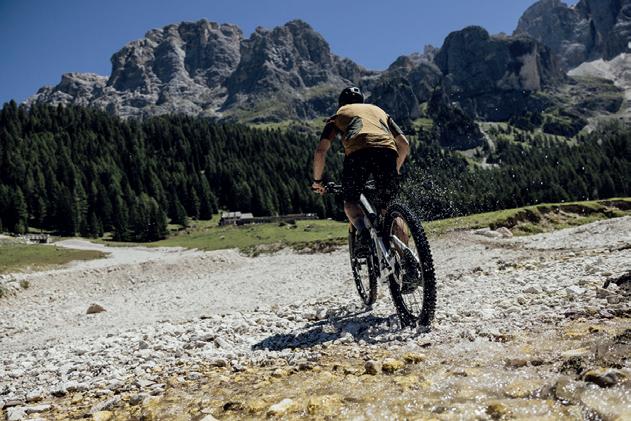
24
VIAZ DFS GTX


PERFORMANCE, SICUREZZA E COMFORT
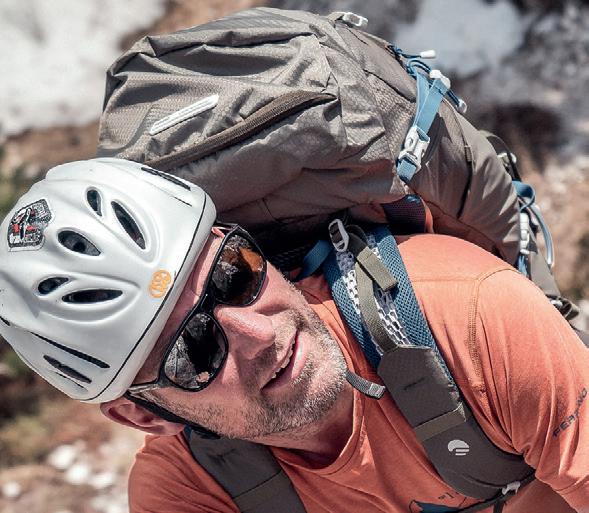



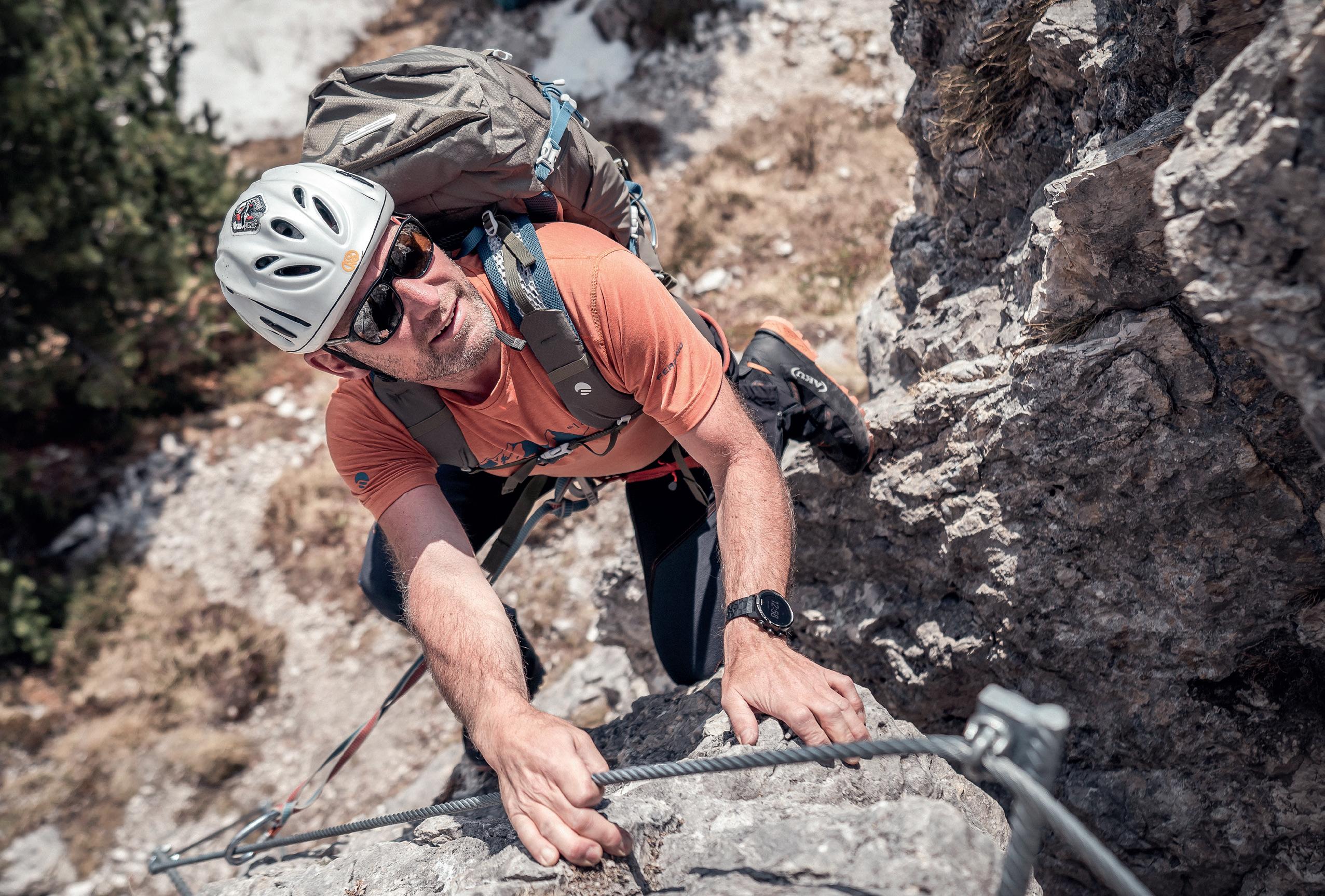
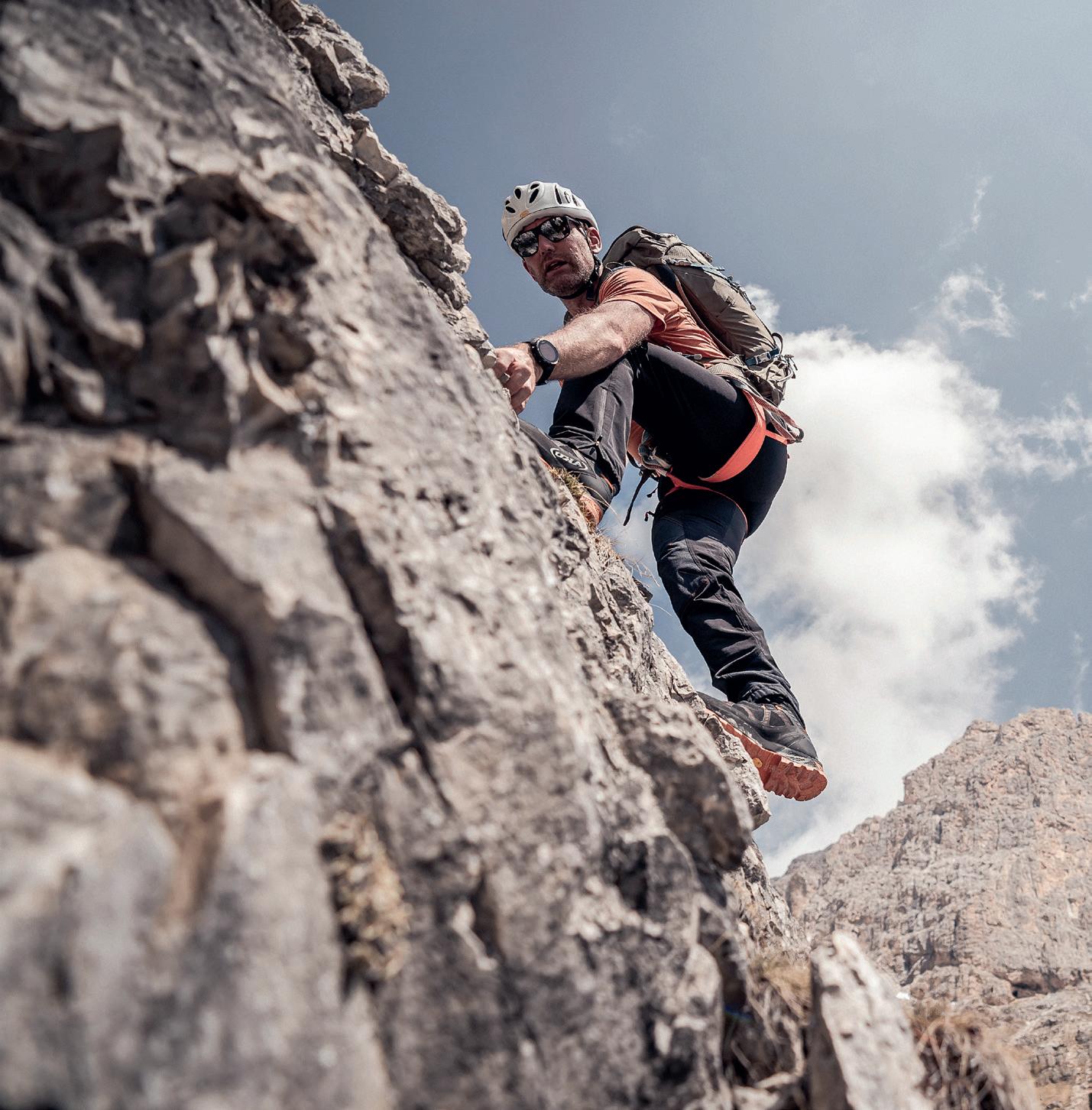
NATURAL STRIDE SYSTEM
ECO SEVEN
BY DAVIDE FIORASO
“ CUT, RIP, SEW” AT CAMPO BASE FESTIVAL WITH FERRINO
From September 2 to 4 at Campo Base Festival in Val d'Ossola, Ferrino will host an appointment for all outdoor enthusiasts with its upcycling project. "Cut, rip, sew" are in fact the watchwords of Ferrino's approach to upcycling which has entrusted its modelists with the task of finding practical and easily achievable creative reuse solutions that allow, for example, to give new life to the tent that has accompanied us on so many adventures, transforming it into a sack, a picnic towel or a practical backpack cover.
M AMMUT, STRAVA AND CLIMEWORKS IN THE FIGHT AGAINST CLIMATE CHANGE

Following its "do our best, remove the rest" climate strategy, Mammut has invested heavily in the search for innovative solutions to minimize carbon emissions throughout the supply chain. The result of these efforts is represented by the collaboration with Climeworks, leader in the removal of carbon dioxide. In this context, Mammut has undertaken an important initiative by challenging athletes on Strava to the "race to zero" in May 2023 with the aim of covering 100km to raise public awareness of the urgency of acting in relation to climate change.

J ACK WOLFSKIN TOWARDS AN INCREASINGLY CIRCULAR ECONOMY

Jack Wolfskin, the German brand of outdoor clothing, footwear and equipment, is working to implement a new and sustainable way of using textile waste within its production line. In this virtuous cycle, polyester fabrics will be recycled once zippers, buttons and Velcro fasteners are removed. Through a chemical process, a PET granulate certified by the Global Recycle Standard (GRS) will be produced, indistinguishable from a non-recycled material in terms of properties and tactile sensation. From here new and increasingly sustainable products will be born.

O RTOVOX SS24: PROTECTING MOUNTAINS AND MOUNTAINEERS
O rtovox has always had the goal of protecting those who practice mountain sports and, at the same time, preserving the environment by adopting a responsible and coherent approach. The new Westalpen series fits into this perspective, representing an innovation that aims to guarantee a higher level of protection at high altitudes. The products in the line offer specific hardshell technical protection for the most demanding terrains. They are also made with a new Merino blend material that protects against abrasion while offering the breathability needed at high altitudes.
26
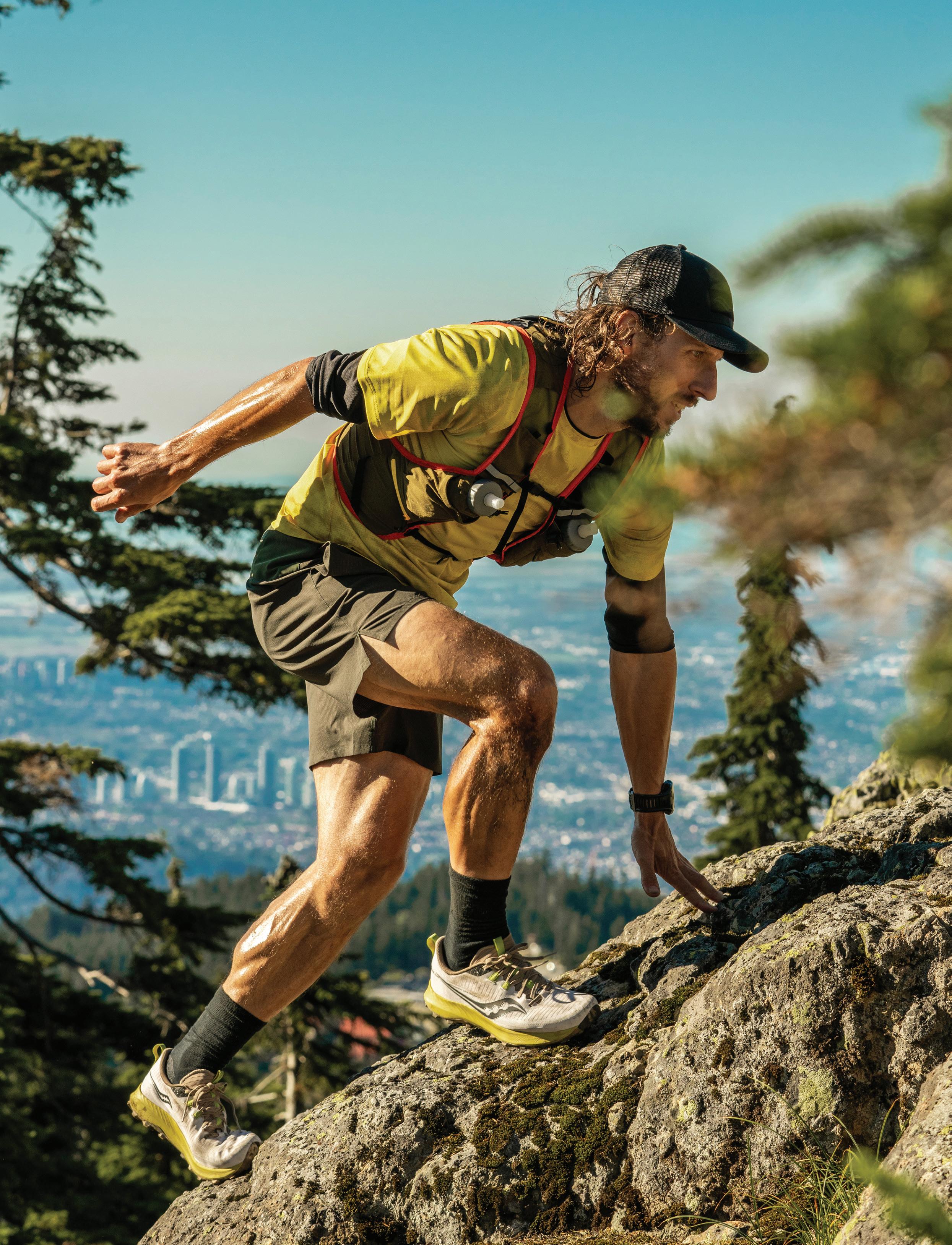

saucony.com
Hit the trails. Ditch the speed limits.
PEREGRINE 13
Ultra Trail Snowdonia

I left Venice with the sun and landed in Manchester with the rain, the heavy one, which mixed with fog and wind laid the foundations for a weekend in full British style. As the car rental agent looks at the condition of the car, I notice that the steering wheel is on the right, a detail I had completely overlooked. It won't be a big deal, but the memory of years ago, of that first time, gets my heart racing. Yet ten minutes of cold sweat are enough to get me into the cli mate, and then the people here seem to respect limits and indications. I would say that’s good.
I head to Llanberis in the Gwynedd region of North Wales. About two hours by car on wide multi-lane ro ads, then a single left turn and I find myself immersed in nature. It is all as described in the books, as I had seen in documentaries: expanses of emerald green grass, trees, sheep, a lake and small streams scattered everywhere. I roll down the window and slow down, it's quiet and I hear the birds chirping. The shoulder muscles relax and in the meantime it has even stopped raining. There's still a bit of haze but I'm optimistic, no forecast speaks of bad weather for the next two days. That would be enough to repay the immense work of organizing Snowdonia Ultra trail. The reason I'm here. That would be enough for around 2800 trail runners from over 64 nationalities to enjoy Snowdonia National Park.
Ultra Trail Snowdonia is the only race of the prestigious circuit "by UTMB" in the United Kingdom and is the brainchild of British runner Michael Jones, while training for the UTMB (Ultra Trail du Mont Blanc) in 2015.
BY ALBERTO FERRETTO
Michael wondered why there weren't similar ultra trail races in the UK and so, at the end of 2017, after finishing 8th in the CCC (Courmayeur/Champex/Chamonix), he launched the race. It was an immediate success in its first edition of 50 and 100 miles. Today it is in its fifth edition and offers 4 distances: 25k, 50k, 100k, 100m.
The organization has reserved a splendid, very welcoming house for the media. I knock on the door and Mathieu, a Frenchman who will run the 50k, opens it for me. With him there is Louis, another Frenchman, the race assistant. I meet Sange right away, he's playing the flute, he's Nepalese and he's going to run the 100 miles. Claire, on the other hand, is an English YouTuber and will, she calmly says, run the 50k. There are about 2000 inhabitants in this village but they seem much less. The main street, which is in fact the
center of the village, is made up of narrow houses of various colors. Shops, pubs, supermarkets. There seems to be everything you need. I close the door to take a walk, after hours of planes and cars it seems the right thing to do. I reach the race village. I'm curious. Across a waterlogged field of grass, then a narrow wooden bridge, with the mother duck and its cubs passing by. Suddenly I hear the sound of a steam train. I'm scared but it's all true. It's the train that takes you from the start and finish area of the race to Llanberis Pass, where most hikers leave to reach the summit of Snowdon, the highest mountain in Wales. The next day I searched all the refreshment points of the race with the two Frenchmen, by car. Everything is wonderful, there is not a cloud, the sun is shining, the temperature is mild, the breeze is blowing. If it stays like this, it will be perfect tomorrow! In Italy it rains very hard. The world has turned
28
THE PILL EVENTS
PERFORMANCE, NATURALLY.
Crafted from nature. Engineered for the trail. Experience running in lightweight Performance Wool. EXPLORE OUR NEW X-ALP TRAIL RUNNING COLLECTION. You’ll never look back.
ODLO.COM

upside down. Let's enjoy the moment. I want to start running, to make my legs spin, to get to know new places. Race day has finally arrived. It's 7 in the morning and the starting grid is almost full, we are about 1200 runners in the 50k, in fact the most popular distance of the weekend. We warm up, I'm with Alessandro, a friend who lives in London. We try to make room for it so as not to risk getting stranded in the group. We arrive there in front, where a few meters away there are riders like Tom Evans.
If you don't know him, that’s bad. He’s one of my idols, in sport and in life.
The start is explosive. I knew it. I'm used to it. Whether it's ten kilometres, fifty or a hundred, the thing is always the same: start fast! The elevation profile of the race speaks for itself. Two ascents of about a thousand meters, two descents, two ascents of about 600 meters, for a total of about 3300 d+ in 55 km. The first climb is almost all runnable, with a steep patch in the middle. The first descent, on the other hand, is incredibly laid out on more or less flat, more or less stable, more or less wet stones. I won't deny it, I love the technical segments and had a blast. The open view of the valley filled my heart. In the second part of the descent, the technicalities give way to a first flat, then nervous route, made up of continuous ups and downs between mud and soaked grass, in the shade of ancient trees with trunks as thick as cars and intertwined branches. After literally climbing over the cattle fences with purpose built ladders, we begin the ascent to Snowdon. Finally, I'm curious to get on it.
Long, steep, hard and between effort, joy and fun my Achilles tendon, already sore in the months leading up to the race, decides not to cooperate, almost as if it wanted to tell me to lift that blessed head, to enjoy the landscapes, not to look at the clock. It almost wanted to tell me that two sunny days in Wales are a gift for the few. It seems strange,
THE PILL EVENTS
BY ALBERTO FERRETTO
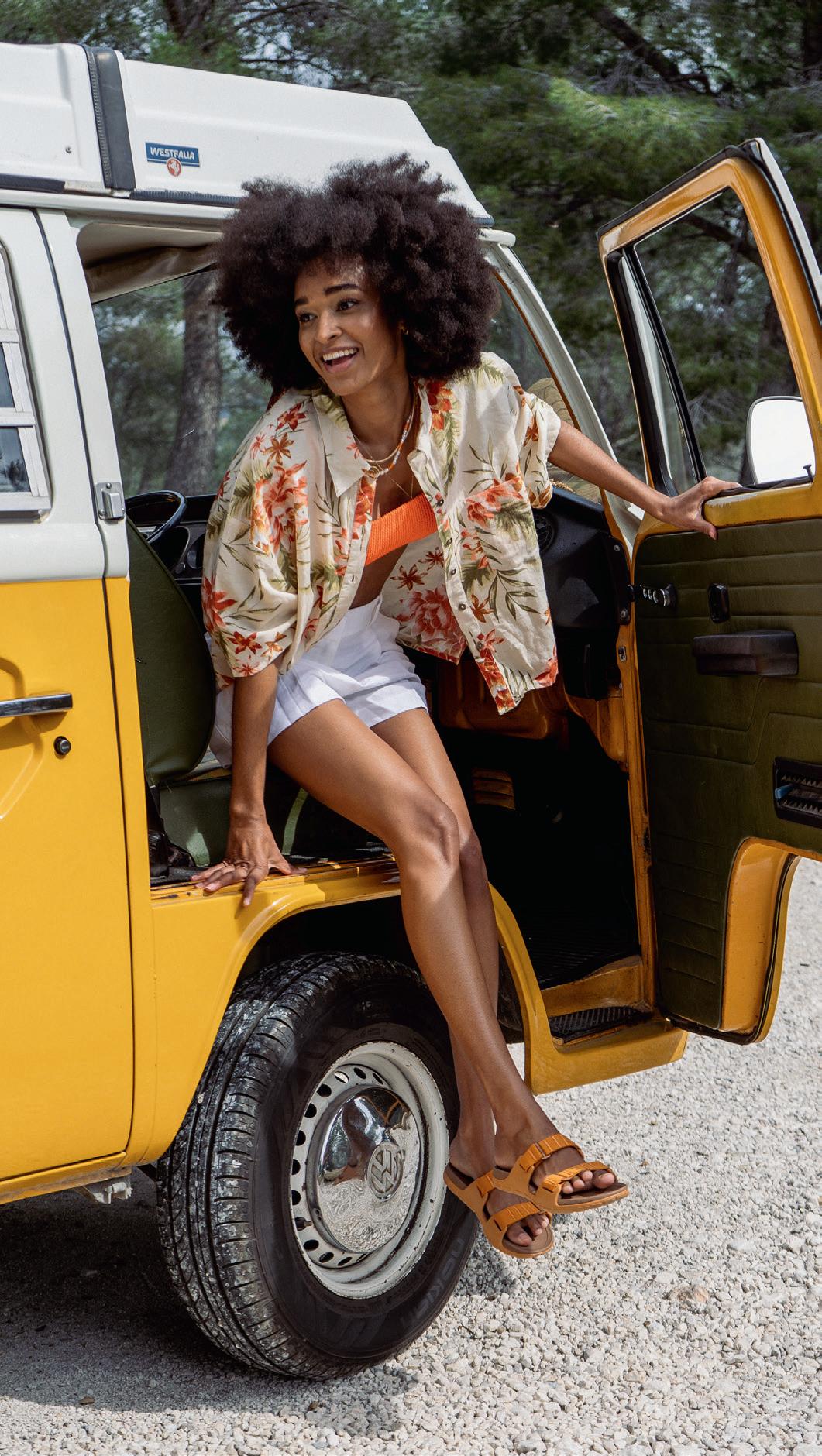
I listen to this feeling. I am serene and I climb very slowly compared to a race pace. I even stop to look around. Pain takes a back seat. I enjoy the moment. I observe the undulating crests of the other peaks, I perceive the entire course of the race. I even see Llaneberis down there. I even get to know some competitors. Portuguese, Chinese, Spanish, Colombian. From the top of Snowdon, and we are only at 1086 meters above sea level, you can see the sea. Amazing. Despite the pace, the tendon still gets pissed off and I decide to stop at the 30th kilometer so as not to aggravate the situation. I smile and an amazed and perplexed volunteer asks me what I've done. Having explained the situation, he gives me a smile, hugs me, calls another volunteer. While I eat. I'm still hungry. I drink. Another volunteer smiles at me, takes me near the means of transport. They are smiling and helpful here, I thought these Welshmen were different. What wrong prejudices! I get on the DNF (do not finish) van and despite everything that’s never pleasant, I assure you. Despite the inner joy, capable of making me live the moment with a big smile, the journey is infinite and runners retired from 50k, 100k, 100 miles jump on. There are eight of us and there is not a free seat. There are
people sleepy and destroyed by life. Upon arrival, I meet Mathieu, my flatmate. He finished second, behind Tom Evans, first today with a time of about 5 hours and 30 minutes. I ask him how the second part of the race was and he tells me I could have continued. The second part is fantastic, you run in the shade, in the middle of the woods, you climb the two ridges, very similar to each other, where you can see Snowdon in the distance, the lakes and the small villages. Then you swoop down towards Llanberis hoping someone won’t pass you. And so, you arrive second. It doesn't take much, he tells me smiling!
I hug him, I congratulate him and tell him that I will go back to Wales, I will go back to Snowdonia, because the serenity that this place has given me is not to be underestimated, because the beauty and variety of its routes have amazed me, because the organization it was flawless and despite everything, this will remain an incredible experience to add to my mountain explorer baggage. The next edition will take place from 10 to 12 May 2024 and registrations are already close to sold-out. Think about it!

30

















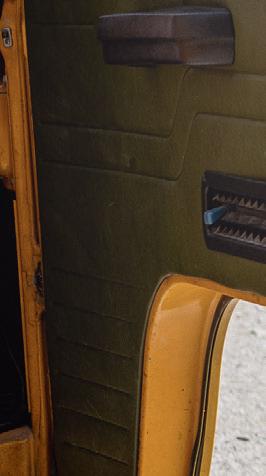
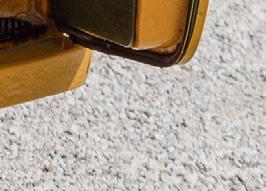

















Environment and discipline Rosanna Buchauer
Rosanna Buchauer is a German runner, who moved to Tyrol Austria, where she works for the tourism agency. Other than that she obviously runs and runs a lot. She has been running since she was a child, after a short break where she practiced ice skating, she started again with the passion of running, which in truth she had never abandoned. However, it was only when she moved to Innsbruck to study that she discovered the beauty of doing it on trails, raising the meters in altitude more and more every day until she reached the highest peaks.
What are you passionate about trail running? I don't think I'm passionate about just the running, but rather the combination of the environment and the discipline - the mountain and the running - because I like being alone and when I run in the mountains I don't meet so many people and being alone I can really enjoy the nature. Another thing I look for is that feeling when you push yourself to the limit but keep going even if you're exhausted and then, once you get home, you treat yourself to small rewards: good food or something that makes you feel good.
Your worst and best moment on the trails? I think both were during the World Championships in Innsbruck. The worst moment was when in the
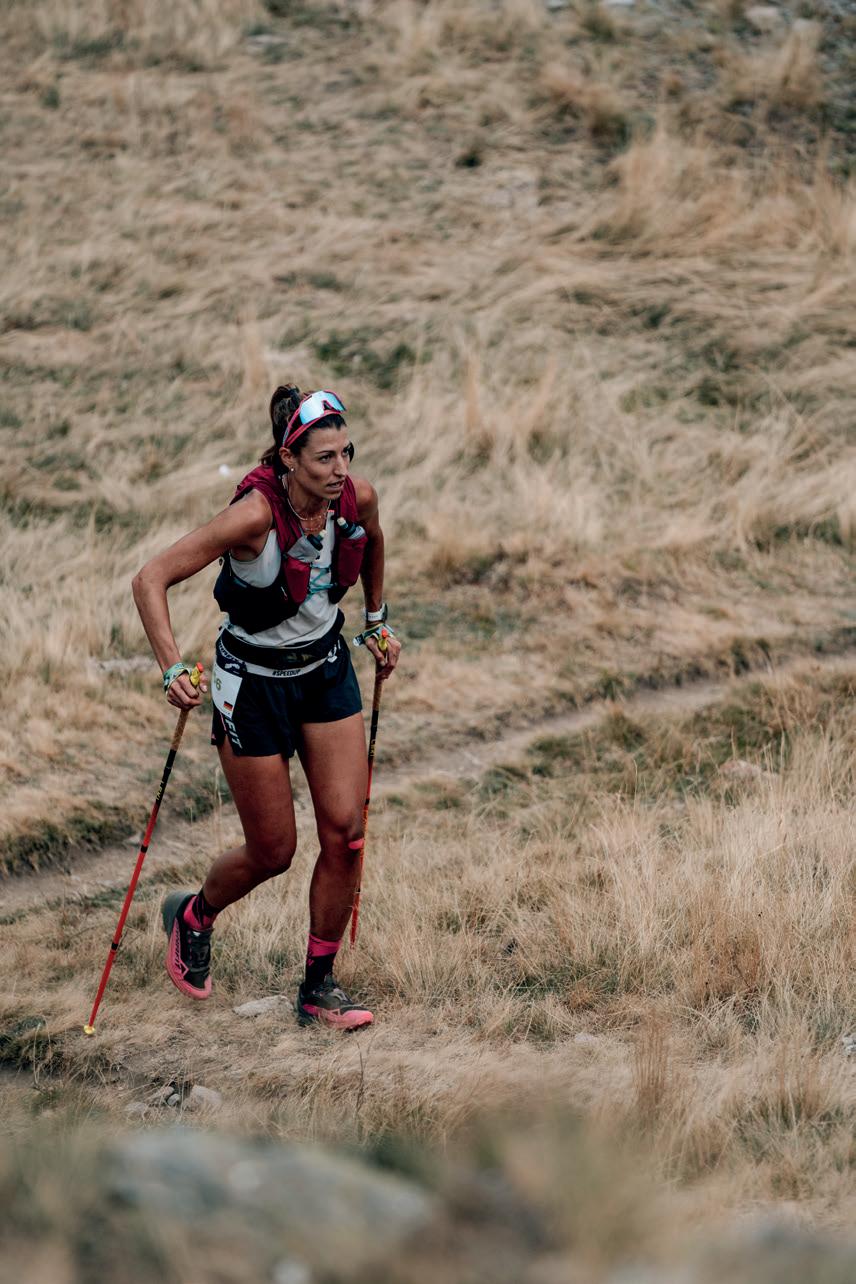 BY EVA TOSCHI
BY EVA TOSCHI
middle of the race I realized that my legs were really tired and absolutely too much to run downhill and I have never felt like this before. I seriously thought about giving up. But then I thought about what it would be like to finish a race with your friends and family at the finish line, and in fact I had my best racing moment passing the finish line in Innsbruck because it's my city and seeing so many familiar faces, so many smiles and hearing so many voices screaming my name
was definitely emotional. In the end they were only there because I had decided to run a race.
Is there a race or an adventure you dream of? There are still many things I would like to do in the mountains. I have a project in the Austrian Alps with a glacier traverse part that I don't know if I will be able to do this year or next due to the weather conditions. Then I would like to do a race that is technical and in some nice
32 THE PILL INTERVIEW
THE PILL INTERVIEW
BY EVA TOSCHI


33
place and in fact the Snowman Race in Bhutan is on my list. It inspires me mainly for the place and then because it takes place at high altitudes.
What principles do you and Dyna fit share?
and I both hold dear can be explained well by their slogan "Speed Up" whi ch I translate as going fast and light in the mountains. Furthermore, as for the brand, mountain running and ski mountaineering are the activities that I am most passionate about. We are aligned on this aspect.
What are your plans for the summer? My big goal was the World
and I've had the answer in my head for some time. For me this person is Martina Valmassoi, it was very nice to share some moments with her during the Championship. I've met her a
few times but I've been following her for a long time and I love her approach to racing and moving around in the mountains. Martina always combines racing with mountain adventures and projects and I do the same both for training and for motivation. I really admire her both as an athlete and as a person.
If you had to choose just one album to listen to while running what would it be? If I had to pick just one album by just one artist to listen to while running it would be something by Macklemore. I have a lot of his songs in my playlists that I listen to while running.

34
ACTIVEWEAR
Inspired by our winter exploration and outerwear expertise, the Activewear line is designed for environmentally friendly adventurers looking for technicity but not only. Modernity, lightness, freedom of movement, breathability, insulation, thermoregulation and waterproofing... Armed with cutting-edge technologies and with a reduced carbon footprint, the explorer of surf spots or the most remote summits will stand out all the year long.

info@boardcore.it www.boardcore.it
Distribuito da BOARDCORE S.R.L.
BY ILARIA CHIAVACCI
Odlo: Heightening outdoor experiences
Odlo was born in Norway more than 70 years ago from a need to create quality performance clothing that could function in harsh conditions. The brand invented functional base layers and has been innovating ever since, creating exceptional products for active year-round lifestyles.
Their trail running designs appeal to people who love getting lost in the mountains. We catch up about plans to invest in the collection in conversation with Kilian Breuer, Odlo’s
Product Director. Kilian joined Odlo on February 1st, 2023, having built a progressively senior career in merchandising and sales and product development across four different brands. He’s also a passionate cyclist, trail runner and cross-country skier.
To develop the best products that respond to the need of athletes and enthusiasts, Odlo has been collaborating with like-minded personalities and athletes that input on product development. Their sponsorships are targeted towards individuals, te -
ams and events that share the brand’s passions and interests, and inspire more athletes to explore the outdoors across a multitude of sports. This commitment is evidenced in their title sponsorship of Team Odlo X-Alp, the Annecy-based trail running team.

“This team shares our passion for running” says Kilian. “It’s a partnership based on spending time together, staying close to the sport and listening to their insights and experiences. This inspires our product creation and fuels our desire to find the best possible solutions for the specific needs of athletes. The team is also a critical part of our product validation process, inputting on prototypes and design concepts at every stage.”
Odlo’s goal is to create clothing that’s extremely comfortable and purpo -
36
THE PILL BRAND
se built so runners can focus on the beauty of running, not what they’re wearing. “Once we’ve created something that’s so comfy that you barely notice you have it on, that’s when we’ve got something exceptional” says Breuer. But what does Odlo do to respond to the specific needs of trail runners?
“When it comes to warmer weather, running kit is about lightness, staying dry, range of motion and durability. This is especially true when you’re dealing with elevation changes and fast-moving mountain weather. For these conditions, we prioritise lightweight, fast-drying fabrics that stretch and move, but that are also long-lasting. Designs that respond to running in all its forms but are further enhanced with appreciable details that speak to the needs of mountain running.”
THE PILL BRAND
BY ILARIA CHIAVACCI
This season saw some of the most innovative trail running products of the brand, starting with the X-Alp Performance Wool 115 T-Shirt, a very light and breathable garment that recently won an ISPO award. Then Odlo’s Zeroweight Waterproof Jacket, a pair of men's shorts and a 2-in-1 skirt for women.
“Partnerships create an ongoing dialogue between us and athletes. We get inspired working closely with them because we want to see our products being proven in the most extreme circumstances” concludes Kilian. “We also want athletes to be inspired by what we’re creating. We enable each other to push beyond boundaries for the best possible results. It’s really a pleasure to work with athletes that share our passions. Simply put, it helps us craft the best product out there.”

37
We also want athletes to be inspired by what we’re creating. We enable each other to push beyond boundaries for the best possible results. It’s really a pleasure to work with athletes that share our passions.
Oberalp Summit between Mountain and Metaverse
Will the mountain become an experience to be lived also in the virtual world? Will communities and alpine sports enthusiasts be born in the Metaverse? And again, is this Metaverse actually a business case for the outdoor industry, so distant in terms of identity and features? We’ve been talking about the Metaverse for a while now in various fields and occasions. But is all this talk today an awareness among consumers and players in the outdoor world?
Every tear the Oberalp Group organizes two Summits, during which it not only presents the new collections in unique locations and with its iconic fashion shows, but also wants to investigate and study relevant issues for the entire mountain sports sector. To do this, it relies on experts and people related to the issue, offering the public food for thought and information. Last May, therefore, there was talk of contradictions that can turn into enrichment on the island of San Servolo in Venice, where the Dolomites can be seen from the sea not many kilometers further north. So the choice of location is no coincidence, so far and different from the mountain at first glance, but so close and united if you just stop for a while to reflect. So that was the beginning of "Mountain and Metaverse - synergy or contradiction?" where an attempt was made to analyze and dee-
THE PILL EVENTS
BY LISA MISCONEL
pen the opportunities and limits of the Metaverse for companies specialized in mountain sports.
“The issue of the Metaverse immediately fascinated us, because it brings with it more questions than answers.” With these words Christoph Engl, Oberalp Group CEO, opened the convention, with him Ruth Oberrauch, member of the Board of Directors of the group, their respective avatars projected on the big screen behind them. “What will be the next step in the development of the online industry? We have a world that is increasingly omnichannel, will the Metaverse be part of that? It's something really abstract and the more I think about the future, the more I like to think about a plural future where different scenarios coexist and different ways of acting are brought about." Three cards, red, yellow and green were the means to represent the knowledge of this issue among the listeners in the audience and the majority of red and yellow represented a great uncertainty. Isn't it true that the greatest cultural changes and phenomena started in the same way? Who would have thought that climbing gyms would become a mass phenomenon? And what about the idea of being able to send emails, take pictures, browse the internet and talk from one part of the planet to another through a single small portable device?
The interventions of specialists such as Martino Marchetti, Oberalp's Innovation Lab Manager, brought some clarity. He spoke about a visionary approach and the need to think outside the box in order to build new paths, specific to the needs of the company. Marchetti and his team, supported by the consultancy firm Dr. Wieselhuber & Partners, have carried out a study about the possibility of the mountain of becoming part of the Metaverse: out of more than 2500 interviewees, it emerges that the times for presenting products in an
exclusively virtual format are still premature, but that ample space is given to educational programs for their best use and to work on awareness in the community. By 2030, according to estimates by Dr. Wieselhuber & Partners, this market will be worth between 1 and 8 trillion dollars. However, it is excluded that the Metaverse with its features such as augmented reality (AR), virtual realities (VR) and related technologies such as glasses and visors would replace a real experience.
These results were based on five Metaverse myths reviewed and further investigated:
1 Mountaineers prefer the outdoors and see no interest in the Metaverse
Despite this, it can be a valid tool for offering immersive experiences, allowing you to try new sports, plan itineraries in advance and identify any risks, but also give you the opportunity to socialize and share information with other mountain users.
2 The identity of an outdoor brand will not be strengthened through Metaverse platforms
There will be the opportunity to visit real virtual stores where users, impersonated by their avatars, will be able to try on mountain clothing and equipment as if they were in a physical store, making shopping an immersive experience, where consumers co-create together with companies, generating new business opportunities. In this sense, Oberalp will develop virtual showrooms and other digital services for its six mountain brands Salewa, Dynafit, Wild Country, Pomoca, Evolv and LaMunt.
3 Physical Mountain Gear will not be sold through Metaverse platforms
This point has not yet found a use in terms of conversion of the physical product, but it will support the incre -
38
ase in sales thanks to the possibility of deepening and presenting each product in detail. On this point, an innovative solution was recently developed with Salewa to view one's tents inside physical stores thanks to the use of VR technology which, although not yet present in points of sale, leads to discussion of its possibility. In this way, space and set up would no longer be obstacles and the customer could view and better understand the product thanks to its digital version.
4 Digital Skins and Mountain Gear NFTs will not become a relevant category
Sale of digital skins and NFTs and
THE PILL EVENTS
BY LISA MISCONEL
technologies necessary for this process: at a certainly very advanced technological level, it seems to be more of a theme for the future.
5 Virtual worlds will have limited impact on the mountain sports value chain

Virtual showrooms can actually be an added value for a brand, improving collaboration with suppliers by creating a visualization with the help of Multiuser VR, breaking down language barriers and reducing costs for travel and, consequently, the environmental impact. It also offers the possibility of remote training and it guarantees greater flexibility of the
processes obviously taking into account a basic IT preparation process.
In short, in the end the question is: is it worth it? Does the Metaverse have real potential for the outdoor sector?
Stefan Rainer, Oberalp CSO talks about the need for a digital strategy to strengthen the identity and physical value of the company using the Metaverse not so much as an end or as an entity in itself but as a support and tool to facilitate physical processes such as the visual in-store merchandising, understanding products, placing orders.
39
BY ENRICA GOUTHIER
Livigno and Brooks Cascadia 17
A successful combo
With the renewal of the partnership between the Lombard resort and the American brand, Brooks confirms itself as increasingly present in the trail running world, taking this opportunity to launch the new Cascadia 17.

I had never been to Livigno and I think I literally fell in love with it. It was love at first sight. After almost five hours of travel, between the motorway and endless state roads, we descend into this jewel of a valley where one of the toughest skyrunning race in Italy is organized. It is no coincidence that it is a way to qualify for the Kima trophy (one of the most beautiful skyrunning races in the world, 52km and 4200 D+). Divided over two distances, the marathon of 34km and 2700 D+ and the skytrail of ''only'' 17km and 1400 D+, it gave anyone the opportunity to people to challenge themselves on a real skyrunning race.
With this event, Brooks has decided to present its flagship trail running shoe by inviting athletes, retailers and media. Let's talk about Cascadia 17, the evergreen model with cutting-edge improvements and details. The first big news is the Trail Adapt stabilization system that integrates the midsole, the protective plate and the sole. This new technology makes every step stable and safe, ideal for all terrains encountered, offering greater control during the run. Moving to the sole, we find the new TrailTack Green which with a completely redesigned lugs system ensuring more efficient traction on dry and wet surfaces. It also gives greater safety on uneven terrains. Everything is made with 25% recycled materials. Note, in this area, the reference to the hoof of the mountain goat, a certainty in terms of balance and stability.
Between the midsole and the outsole there is the Ballistic Rock Shield, a Pebax plate that protects the forefoot from rough terrains and sharp rocks. On
the outsole, six different independent sections compress individually depending on the terrain and create greater traction on the surface.
‘’Every part of the outsole performs in a way that absorbs shock and allows a smooth ride” says Francesco Caroni, Brooks’ Apparel e Footwear champion.
The success of the DNA Loft V2 compound inserted in Cascadia 16 continues. This guarantees great cushioning even on difficult terrains. Ideal for those who love to spend a lot of time in the mountains, on rough trails and rocks. The lugs are positioned so that they compress individually in the off-load phase, creating a feeling of softness on the surface of the foot and greater grip on rocks and uneven terrains.
The latest eco news is the PrintDye technology which saves about 2/3 of the energy required for traditional dyeing and 75% of water during the coloring process.
We had the opportunity to try it on the trails of Livigno, engaging in the race for those who liked it or simply going on the course to encourage the athletes. Compared to the previous version, once I put it on I felt it stiffer and more stable with a softness component that allows you to run well. It is not a fast shoe but it’s certainly protective, for all those runners who love to run in the high mountains on even rough terrains. The upper is very snug on the foot but still breathable. The space in the front optimizes better movement of the toes and avoids the creation of chafing blisters in the event of foot swelling. The fit of the shoe does not give the feeling of having the ankle exposed and even after many kilometers and tired legs you have the certainty of constantly having control of the foot.
Cascadia 17 is a trail running shoe, personally I would venture it even for a technical ultra trail race where you can find stony grounds and rough sections, thumbs up for this new release.
40 THE PILL PRODUCTS
THE PILL PRODUCTS
PHOTO ALESSANDRO BELLUSCIO
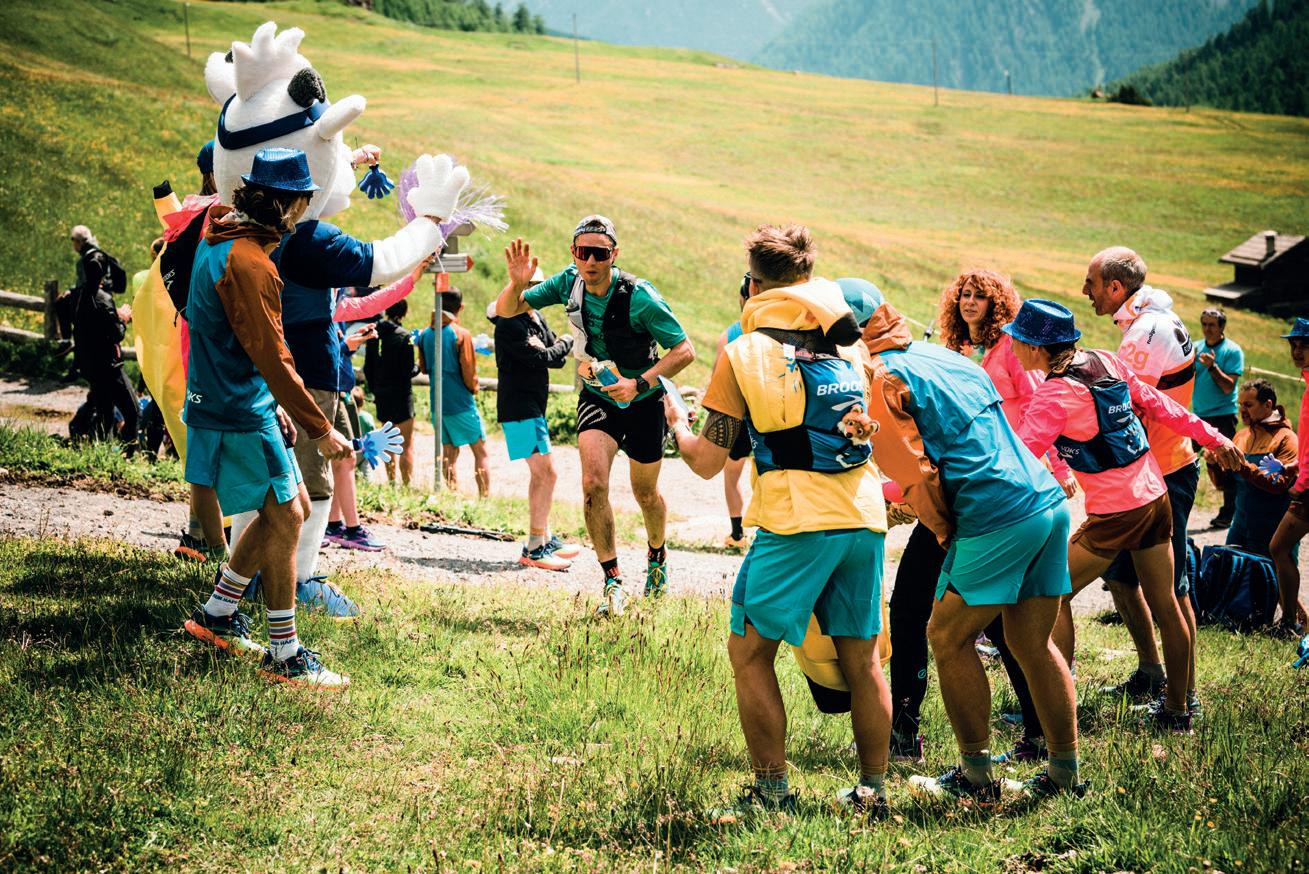
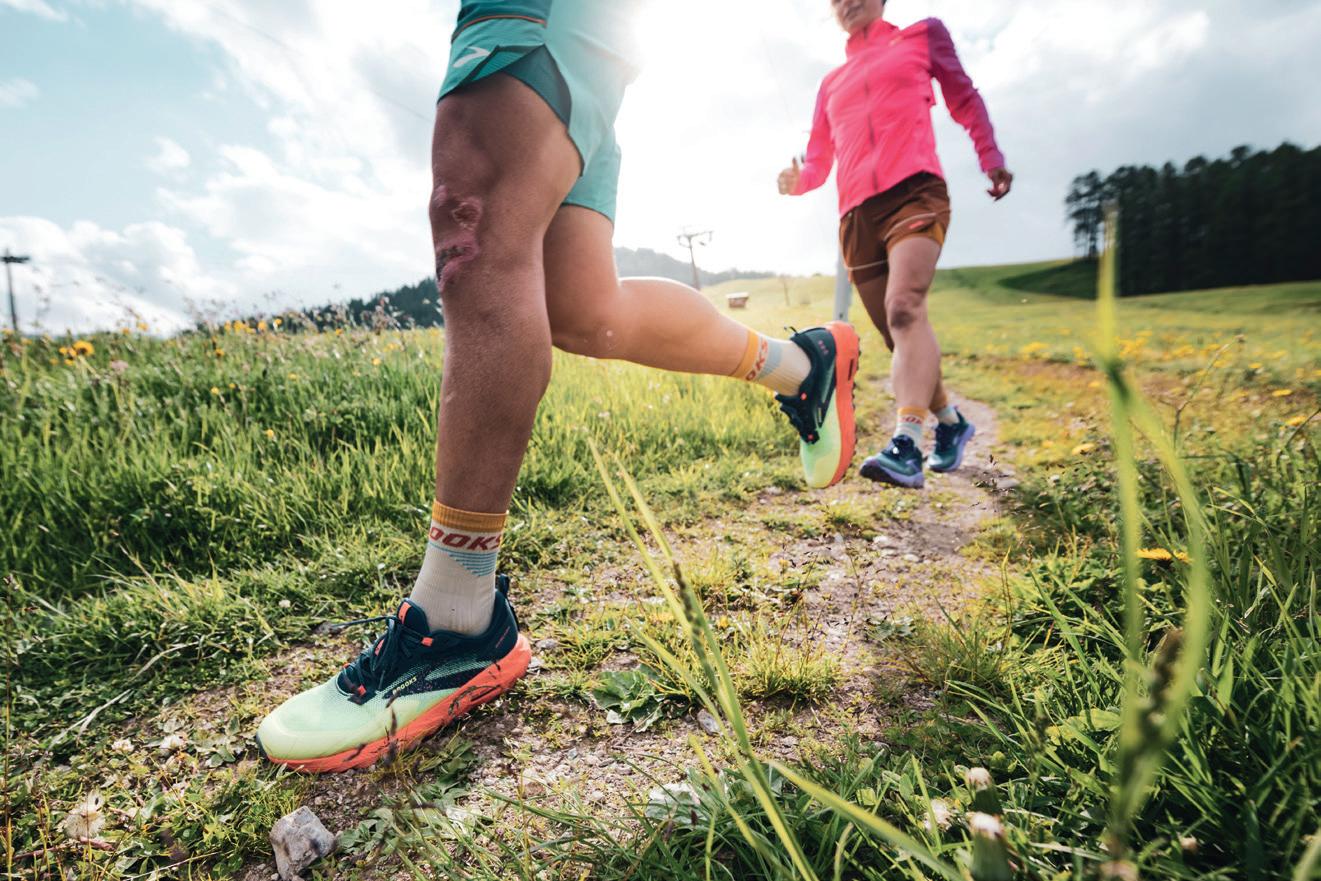
41
BY EVA TOSCHI
Tie your shoes and get back into the game: Elisa Brocard
Many will associate the name Elisa Brocard with narrow skis and performance, professionalism in cross country skiing, the Olympics and the World Championships. But here the last part is only the starting point to talk about who is Elisa and what she does today, how she got into running and how she became an ASICS FrontRunner. So let's enter the new life of this athlete, of this woman, together.
Tell us something about you. I'm from Gressan, Aosta Valley, and obviously living in the mountains I put on my first narrow skis when I was three years old. My first sport and my greatest passion was cross country skiing, which has also become a profession: first as an athlete, now as a coach, always remaining in the Army Sports Center. I have participated in 3 Olympics and 4 World Championships and as a professional my best performance was a 10th place at the World Cup. Today I'm 39 and I finished my professional career a couple of years ago, starting to work alongside my coach as an instructor and coach. I'm living a moment in my life of great changes and discoveries: it seems absurd but I'm starting to work now (not as an athlete, of course) and I feel very lucky to be able to do it in a familiar environment and above all spending my days in nature.
How did running enter your life?
Running has always been present in my life: as a little girl I did athletics
and then I kept running, especially for training in the summer. However, after I stopped competing, something unlocked and I got the impulse to get closer to this world of which I felt I knew so little. I had this idea of applying to ASICS to join their team and I was accepted. It was a nice springboard to get involved in something new, with a totally different spirit from the past and from how I've always approached sport.
What does it mean to be part of the ASICS community? When I joined the team a world opened up for me. I didn't expect to receive such a warm welcome and I realized that I had joined a family, not a company. It's different, starting from the message we want to convey: Anima Sana in un Corpo Sano - Sound Mind, Sound Body. At that moment in my life this message struck an important chord, because I had just come out of professional sport and the difficulties associated with it. I rediscovered what it means to play sports for yourself, to feel good, not just to achieve a result. Of course, even today if I put on a bib I try to give my best, but I do it with a different spirit than before. I don't do it to prove anything but only for myself and to convey something to others. I'd really like to inspire young kids to play sports, to exercise to feel good. Among other things, running is very easy: all you need is a pair of shoes and you can get where you want. To explain what it means to be part of the ASICS community, an event comes to mind: at the Malcesine-Baldo Trail, my first trail among
other things, I accidentally found myself running together with two of my team mates, and we ran together for the whole race. We really shared the experience. In a cross country race this has never happened to me. The world of racing is very different: on the starting grid of a competition you can meet a pro and an amateur at his first experience next to each other. As a rookie, I entered this world with extreme humility and I'm discovering so many things about running. There is a whole world to discover and beautiful messages to convey. Among these, the first, because without it nothing can be done, is to bring people closer to running. In this sense, ASICS and we in the team, thanks to completely free courses in collaboration with Julia Jones and Correre al femminile, have involved more than 4000 women. Here, this is another great thing that makes me proud to be part of this team and that gives me the opportunity to discover many other realities in addition to my own as a former professional.
Trail or road running? Elevation gain or distance? Living in the mountains, I've always run on trails, and since as a cross country skier the goal of the running sessions was to suffer, I've always covered vertical sections and significant elevation gain. Among the many things I also set the record uphill of the Aosta-Becca di Nona, in 2009. Today, however, I like a little bit of everything, I'm also starting to appreciate road running after running a few half marathons. And since my goal is to run the NYC marathon in November, I'm going to have to like it. Having, in a sense, just entered this fantastic world, I have time to find out which distances and terrains I like best. I leave myself time to find out. Meanwhile, I tie my running shoes and start running. It will get me somewhere.
42 THE PILL PRODUCTS
THE PILL PRODUCTS
 BY EVA TOSCHI
BY EVA TOSCHI
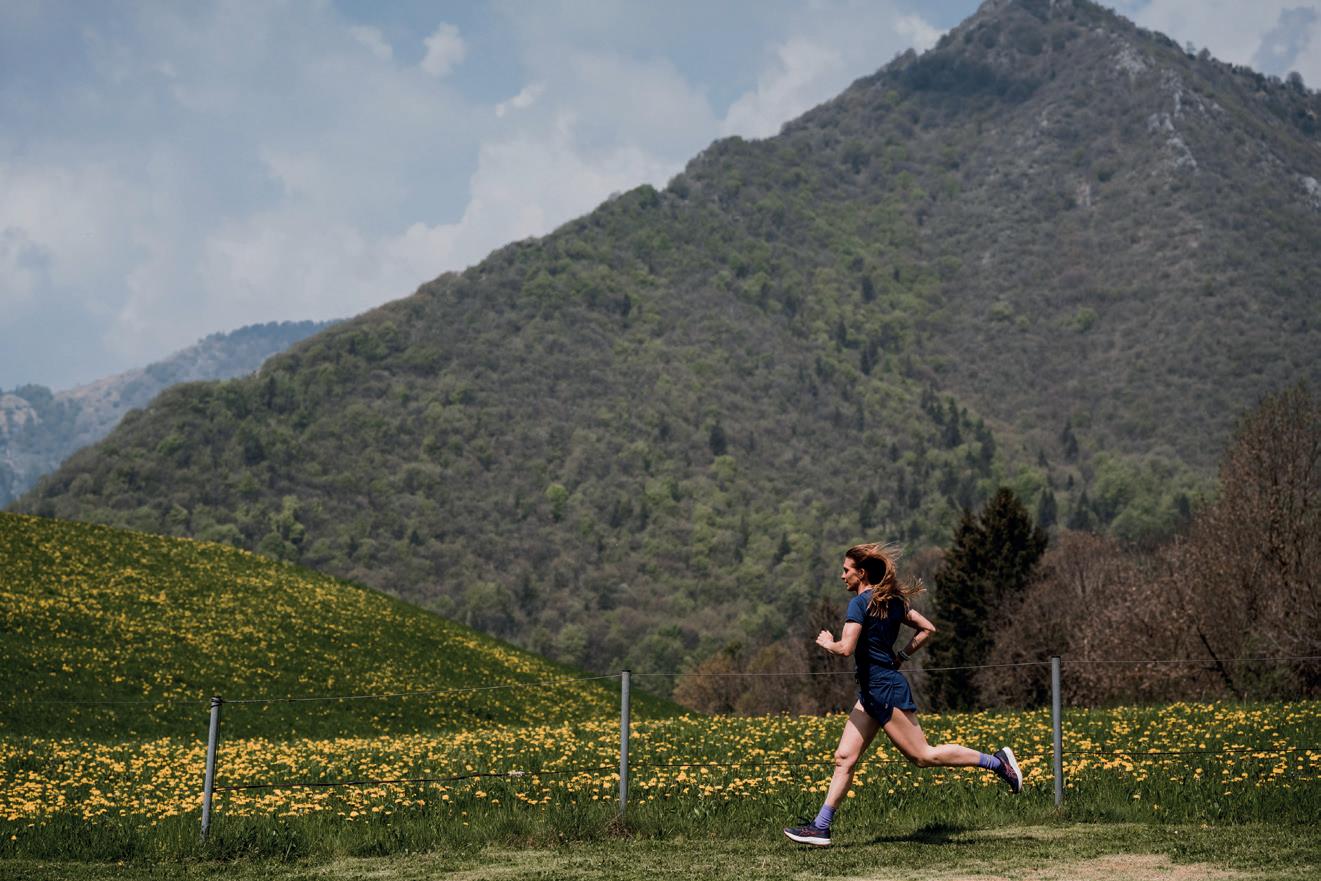
43
Masters in traction Scott Ultra Carbon RC
Scott has brought together the best discoveries in terms of technology and the experience of great athletes to arrive at the definition of their best trail running shoe model that is able to offer at the moment.
The keywords in trail running are lightweight, resistance and flexibility: these are the main words for athletes, but even more so for what concerns the equipment. Scott has done a lot of work towards this direction, involving experts in every field, leading companies in the production of elements such as carbon fiber for example, and athletes from the running team, such as Cody Lind, who reporting their needs to the company has expressed the need to have more space under the foot for longer distances. This is all part of the design process of Scott Ultra Carbon RC, a shoe that was specifically designed to improve the efficiency of runners in ultra trail races and, in particular, for one race that Cody Lind set out to run. In fact, his dream had always been to compete in the legendary 100 miles of US’ Western States. Working closely with the development team on the entire shoe concept and thoroughly testing it during his training before the Western States race, Cody was a key cog in creating the highest performing trail shoe Scott is capable to offer today.
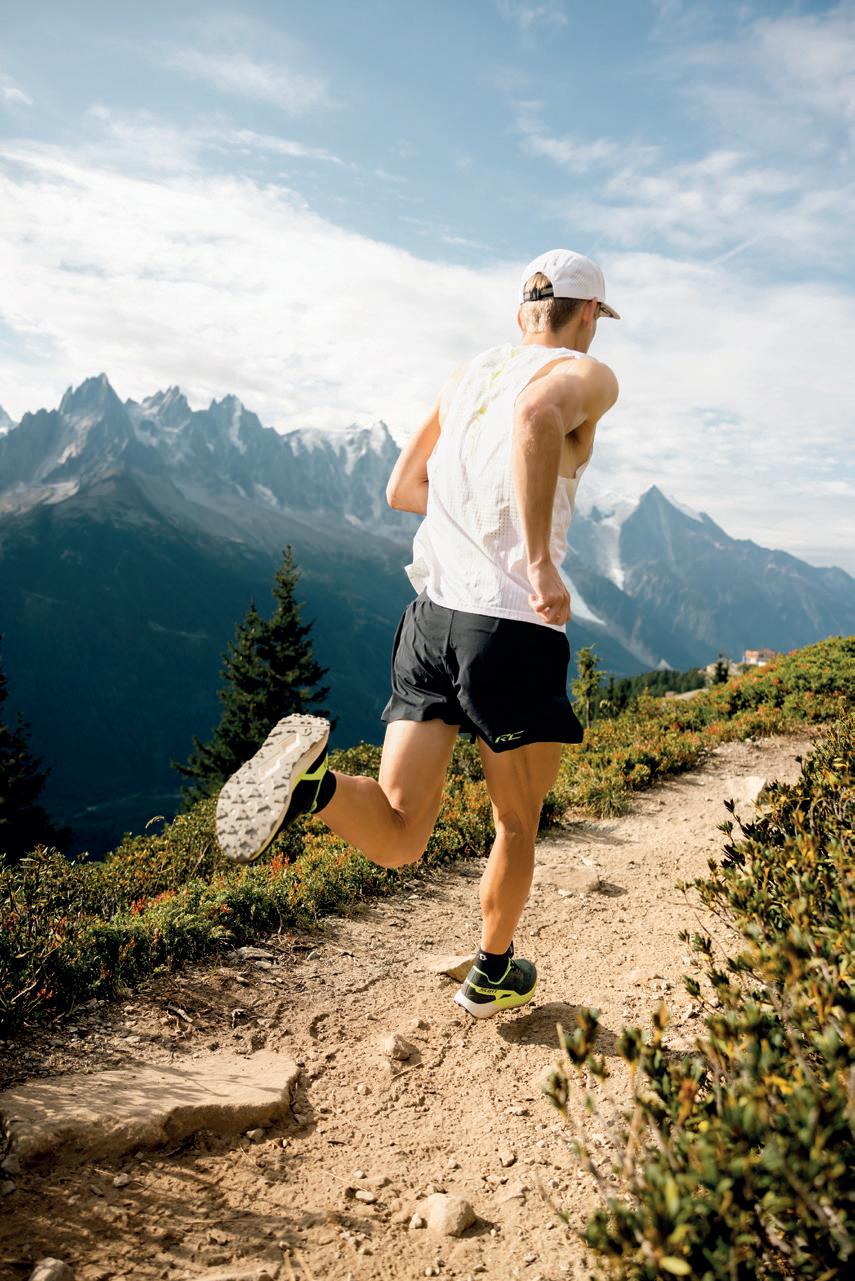 BY ILARIA CHIAVACCI
BY ILARIA CHIAVACCI
The collaboration with Carbitex also fits into this context: a leading company in the sector and a pioneer in the field of flexible carbon fiber composites. The Carbitex Gearflex plate has in fact been integrated into both the Speed Carbon RC road shoe and in the Ultra Carbon RC trail running shoe: it is soft and flexible, but above all it is able to increase stiffness as speed increases. This dynamism is the trump card given by the carbon fiber, which makes the shoe very flexible with respect to the needs of the runner. The
advantage of using a Carbitex GearFlex carbon plate is in fact the dynamic flexibility: the plate responds to the impulse given by the runner, increasing stiffness as speed increases and maintaining good flexibility at a slower pace. For trail running, the carbon fiber plate needs to be light, thin and more flexible than a full length carbon plate, to give the runner the right agility and the right feeling towards the terrain, especially when dealing with irregular grounds. Hence the need for a plate that is divided
44 THE PILL PRODUCTS
THE PILL PRODUCTS
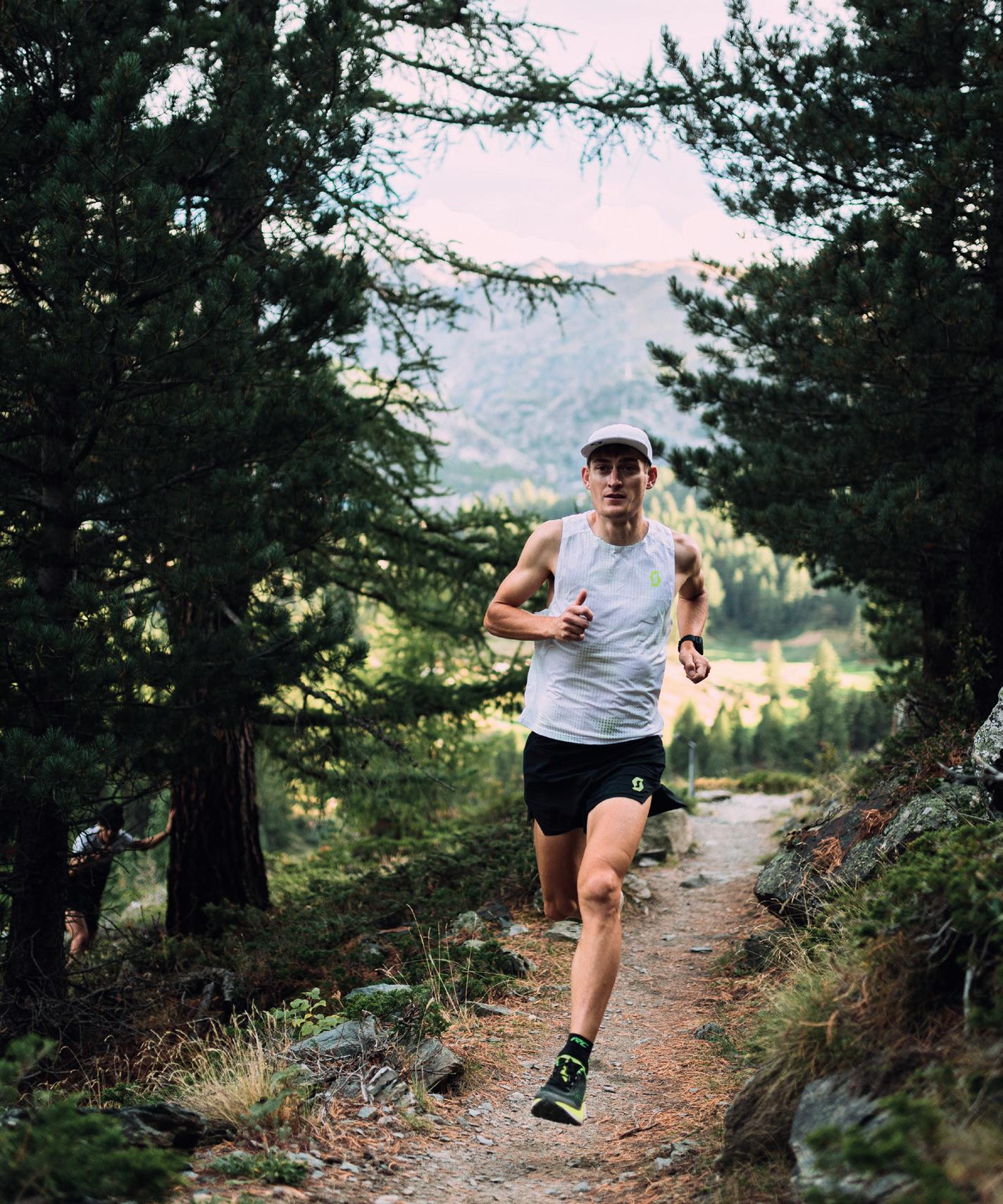
45
PHOTO SIMON DUGUÈ
into two parts: under the forefoot and towards the heel, with the aim of increasing lateral flexion. The dovetail shape is in fact the aspect that allows greater lateral flexion and a natural decoupling of the forefoot and the rearfoot: this ensures that neither the technology given by the carbon fiber nor the flexibility of a shoe is lost from trails.
In this aspect, Carbon Ultra RC differs from Speed Carbon RC, which has a large carbon plate in the forefoot and narrower towards the heel: this helps to increase stability and at the same time support the continuous and constant movement that occurs in marathons. The Ultra Traction sole has also been specifically designed for ultra races on fast courses: thanks to a semi-radial design it is able to offer maximum efficiency in forward movement, while maintaining multidirectional traction elements that
BY ILARIA CHIAVACCI
give the runner safety during turns and in the most impervious stretches. Sneakers on average have 65 components: well, in trail running shoes there are much less, but each one has a very specific function, perhaps the result of years of research and development. This is the case of Evolved Rocker 2, created thanks to 10 years of study, research and development that have led ER2 to apply the advanced understanding of biomechanical principles to arrive at a more dynamic running position, reducing the impact of the heel and increasing running efficiency: that is, what is needed to run faster and longer, using less energy. As we have already said, the other essential element for a running shoe dedicated to the trail is lightweight, an aspect that Scott takes care of together with the cushioning thanks to the Kinetic Light Foam and the engineered upper.

46
THE PILL PRODUCTS
The dovetail shape is in fact the aspect that allows greater lateral flexion and a natural decoupling of the forefoot and the rearfoot: this ensures that neither the technology given by the carbon fiber nor the flexibility of a shoe is lost from trails.
THE PILL INTERVIEW


47
PHOTO SIMON DUGUÈ
Cortina Dobbiaco Run: Welcome Mizuno Wave Rider 27
30km starting from Corso Italia in Cortina to run through uncontaminated nature, bridges and tunnels up to the South Tyrolean town of Dobbiaco.

The now famous Cortina Dobbiaco Run took place on the 4th of June 2023, with thousands of runners at the star ting line ready to do battle along the route of the former railway that con nected the small town close to Bellu no to the other in South Tyrol. For the ninth consecutive year, the partnership with Mizuno, the technical sponsor of the event, has been renewed.On this occasion the new Mizuno Wave Rider 27 has been presented to the press, with which our runner Gabriele Pinzin ran during this event.
The presentation is part of the Mizuno campaign "For Every Run Tour" which arises from the need to make runners understand how much, regardless of their goals and the type of training, there is always a shoe suitable for their running style, their type of support, their habits. The campaign will see 18 events between June and September and 18 specialized retailers that will involve their crews and customers to test Mizuno models during training sessions. The latest evolution of the Wave Rider is a neutral shoe suitable for everyone, with excellent cushioning and a flu-
BY ENRICA GOUTHIER
id heel-toe transition. This is thanks to the Wave plate in Bio Pebax Rnew based on castor oil, redesigned with a flattened heel area for greater comfort in the support phase, side wings that give greater stability and a medial area with a 3D design to give further support. The upper has also been renewed with a more enveloping fabric, without seams and which allows the foot to breathe well. Furthermore, the
new Wave Rider 27 is a highly eco-sustainable shoe: in addition to the castor oil-based Wave plate, it has 90% of the upper, padding and insole in recycled material. to the Wave Plate in Pebax Rnew which offers great stability and guarantees little fatigue during long rides. The upper has also been renewed with a more enveloping fabric, without seams and which allows the foot to breathe well. Tested along the
48
THE PILL PRODUCTS
way, Gabriele told us about his Cortina Dobbiaco Run, starting from the beginning. What kind of runner is he, how long has he been running and whether he prefers the road or gravel.
"I've been running for quite a while. I don't remember exactly how many years, at the beginning it was just that couple of km to start doing some physical activity again after several years of stalling between idleness and revelry, then it evolved and slowly entered my routine. One date is certain: in 2018 I ran my first marathon. I mainly run, train and compete on asphalt roads, but for a few years now I've also started training on gravel roads... I haven’t run many races however. I experience trail running as an escape from times, rhythms and data: it's more of a pleasure, an enjoyment of silence and nature and perhaps this is also what has kept me away from competitions up to now. I tend to be a tables type: I have a coach and I try to follow all the trainings that he plans for me with precision, but I don't hide that sometimes my more "punk" side leads me to go out and run without thinking, ruining a bit my training schedule.”
Tell me how the race went. I’ve read your recap post, what went wrong and how did you manage to see this competition from a different perspective? Many runners,
PHOTO GABRIELE PINZIN
if it doesn't go as it should, prefer to go DNF. Cortina Dobbiaco is a race I’ve been thinking about for many years, especially for its course, and being more gravel than trail it could have been right up my alley. Also this year I was unable to register due to logistical problems, but one morning Denis (The Pill’s editor ed) unexpectedly called me and offered me this opportunity: I could not refuse and so I took the opportunity. At that time I was in my maintenance phase and I had not so much time to train properly for the run. In the end it's always 30km and many aspects need to be taken care of, not just the physical preparation, if you want to do it well. As usual then, in the race, I started too fast and at 1/3 of the run I was already tired. I'm one of those who thinks endlessly about abandoning a race, but in the end never does. When I realized I couldn't cross the finish line in the time I wanted, I changed my approach, reminding myself why I had wanted to participate in that competition for some time and in general what drives me to race not only on asphalt. I slowed down a little bit, found a comfortable pace and enjoyed the scenery and the unique track. I immersed myself in the environment, in the silence and filled my eyes and soul
with those things that only certain places can give you. Until the finish line. What kind of race is it? Because it's neither a half marathon nor a marathon, right? It's a particular race: it's not a road and not even a trail race, it runs on a practically gravel route along part of an old railway line. You cross bridges, tunnels, woods, with wonderful views of Croda Rossa, of Tre Cime di Lavaredo and of the lakes of Dobbiaco and Landro. It immediately starts uphill, with slopes that are not exaggerated but constant up to the middle and then it descends to Dobbiaco. It's not technical, but you need to know how to dose your legs without exaggerating in the first part... In short, the opposite of my management.
What is the most beautiful memory and the one you would like to forget? Surely I take home a wonderful landscape and a very particular route. At the same time, I would forget my competitive performance. But sooner or later I'll race it again, preparing it better!
Next races and events? I would like to run a marathon in the fall, I took a look at Amsterdam’s. Then this year I did the right times both for the marathon and the half marathon to get into Boston or New York’s, so at least one of them will be my main goal in the near future.
Did you use the new Mizuno’s Wave Rider 27 in the race? In the three days in Dobbiaco I had the opportunity to try the new Wave Rider 27. I had already raced with Mizuno shoes in the past, and always with the Wave Rider model. I did both a pre-race training on Saturday and then raced on Sunday. They are very comfortable and soft, as soon as you put them on you feel that immediately. I also found them stable and well cushioned. I would definitely recommend them for specific trainings. This model allowed me to live this experience as it should be lived, savoring kilometer after kilometer.
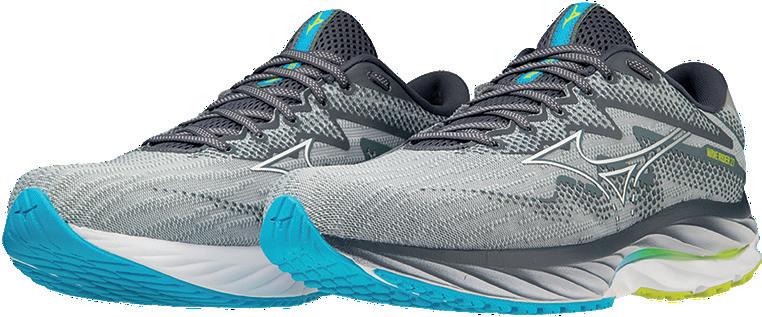
49
THE PILLPRODUCTS
Saucony Peregrine 13 running Dolomiti Extreme Trail
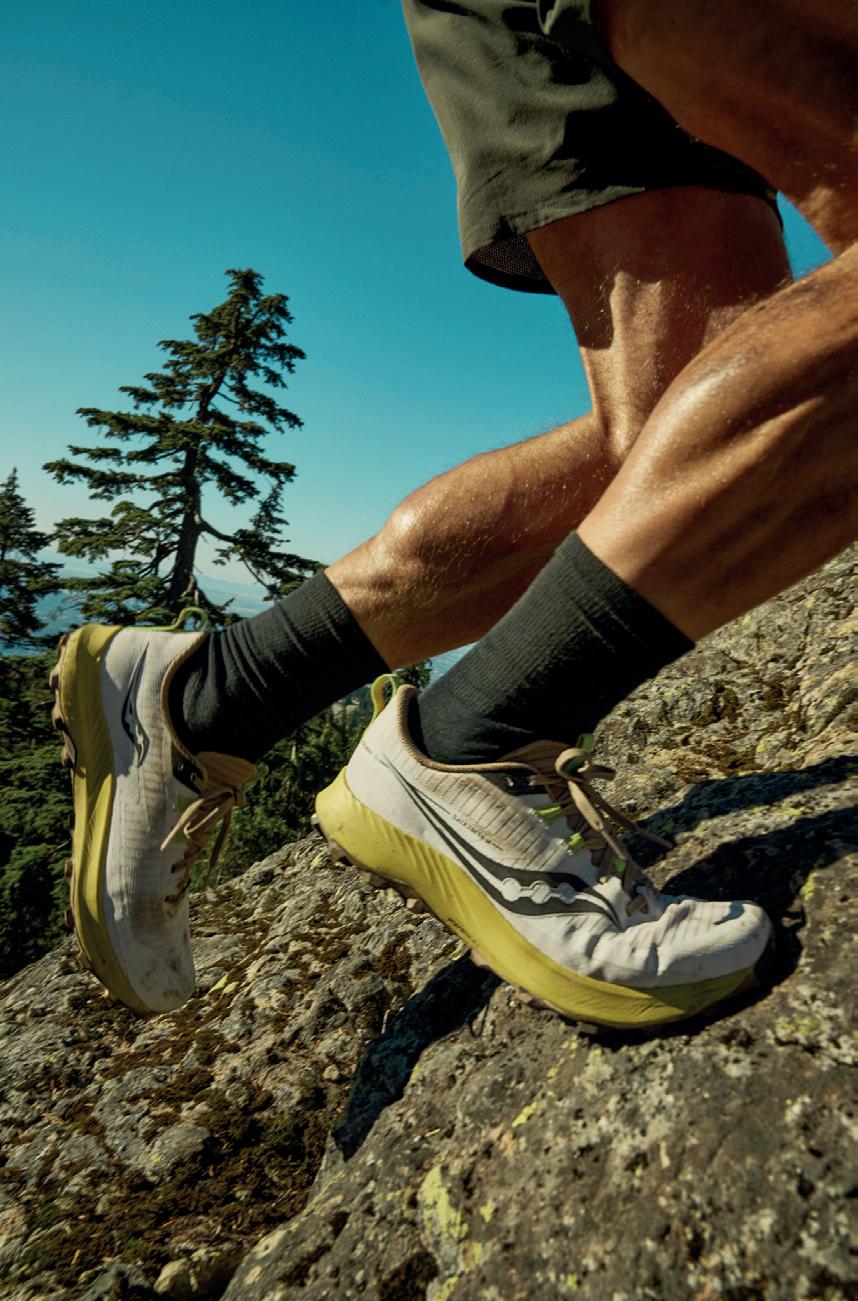
More than twenty kilometers up and down Val di Zoldo, one of the wildest and toughest in the Veneto Dolomites, at the foot of Moiazza, Civetta and Pelmo, for the Dolomiti Extreme Trail. We ran it last month, with a pair of Saucony Peregrine 13, which arrived in the new version this spring.
Peregrine has been Saucony's competition shoe for years, dedicated to technical and fast races in the mountains, just like Dolomiti Extreme Trail. The geometry and shape of the shoe are still lean and streamlined as in the previous versions: the fit is snug, both on the instep and on the forefoot, while the padded tongue protects the foot from the laces. Compared to Peregrine 12, this new version has been better structured on the upper part, which has now been thickened and softened compared to the previous one, where there was a super minimal upper. The shell is very containing and the new midsole accommodates the foot well. This one is made of PWRRUN and PWRRUN+ foams, molded with such a density that the shoe manages to balance a good weight with excellent reactivity: all of this gives life to a low, compact shoe, ideal to be pushed on flat grounds and to let it run freely downhill, where it is very precise and elastic. Uphill, on the other hand, it
stands out for its generous soul. The outsole has been redesigned, while retaining Saucony's PRWTRAC tread compound and now it sees much more pronounced and deep lugs, almost like a mud shoe, and which helped us in the downhill race, where the fir forest creates that soft ground full of needles that get soaked in water.
Having rained in the days leading up to the race, at DXT we found a particularly wet and muddy terrain that gave us the opportunity to test Peregrine in not impossible but still technical conditions. Overall we found it a shoe very suitable for races like these, both in terms of distance, terrain and weather
conditions. It is also a suitable model for pre-alpine terrains, most of the time made of limestone, therefore with very broken and rocky paths. Dolomiti Extreme is now one of the most important ultra trail events in the Dolomites and one of the races that has managed to establish itself better in the calendar: routes, over all distances, which copy the morphology of the Dolomites very well, with long and steep climbs, a lot of elevation gain and steep descents, and above all wonderful panoramas. As for the 100-kilometer race, it is perhaps the only competition of this type and with these characteristics in the whole area: if you have the opportunity, go to Val di Zoldo, it's worth it.
50 THE PILL PRODUCTS
THE PILL PRODUCTS
BY DAVIDE FIORASO

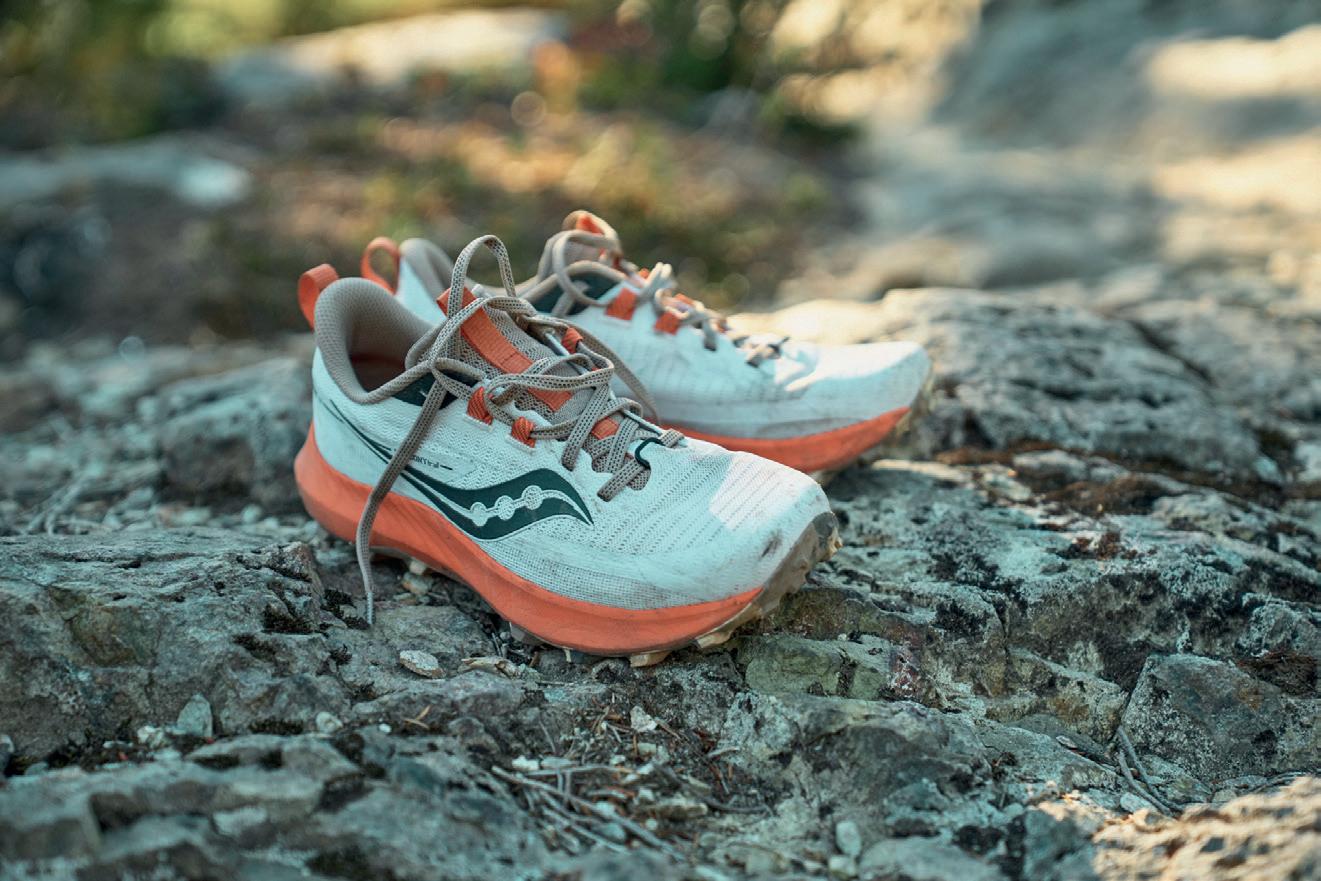
51
THE PILL BRAND
BY ILARIA CHIAVACCI
and the other looks to the sea and to its waves to ride. The common trait is having a board under your feet: in winter for snowboarding and in summer for surfing. In fact, these two worlds are not only tangent, but they share many aspects at a level that we could define as philosophical. Surfers and snowboarders often share a deep communion with the environment that hosts them and which allows them to practice their favorite sports, so they are more inclined to commit themselves to protect it.
The summer soul of Picture and the protection of the ocean
Between sea and mountains, between surfing and snowboarding, with a mission that looks to the environment above all else
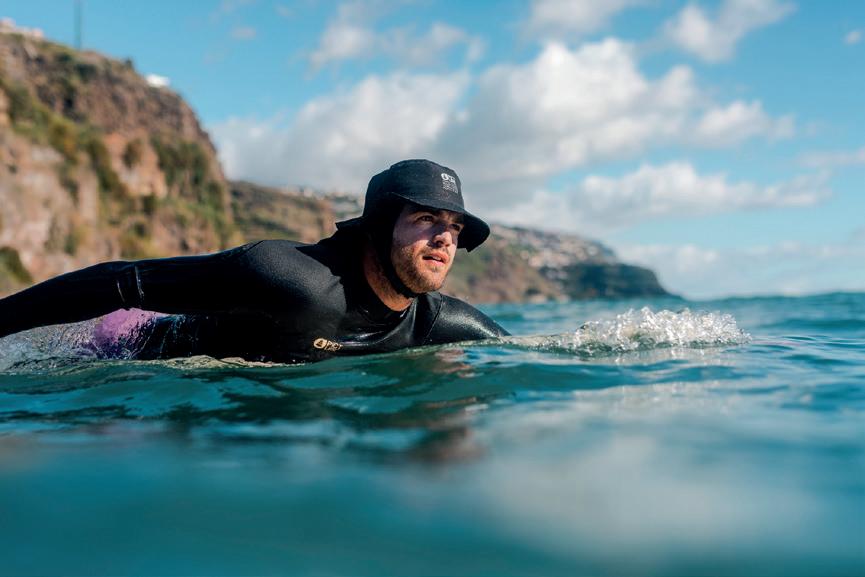
Ride, protect and share are the three key terms around which Picture has shaped its business model, its products and its communication. On the other hand, all the brands that have a strong connection with the world of nature and the outdoors are necessarily more receptive, more attentive to the needs of the environment, whether it be in the mountains or in the sea. Picture is a reality straddling these two worlds, the sea and the mountains: it produces clothing for snowboarding, skiing, surfing and the outdoors but, in doing so, it wants to have as little impact as possible. We live in a historic moment in which the textile industry is responsible for 7 percent of global greenhouse gas emissions and in which the climate crisis has reached its peak, we are one step away from what is called the “point of no return". Picture's philosophy is that even the smallest action can make a difference and that the contribution of the individual is
Avery important. This is why, since it started its activity in 2008, this brand has always strived to go one step ahead of the others in terms of environmental impact.
“Our commitment to a sustainable, ethical and environmentally responsible approach affects every aspect of our business, from supply chain, to manufacturing, to shipping. To reduce the consequences of commercial activity on climate and people, we must eliminate our dependence on fossil fuels, limit growth, change conventional production patterns and promote reasonable consumption.”
The path that led Picture to acquire the B-Corp certification which, from a management point of view, has a profound sense of community, fits into this perspective: “Using business and our influence as a force for good is central to our mission. Our goal is to galvanize as many of our community, partners and stakeholders from the outdoor and apparel industry as possible to participate in the energy transition and carbon elimination from the global economy. Fighting climate change through our passion for board sports and the great outdoors is our mission.”
Picture, as we said earlier, has two souls: one looks up, to the peaks to descend, on the track or freeriding,
One of the aspects on which a company operating in the textile sector has more room for maneuver is obviously the one concerning the materials it chooses to use, especially as regards as technical clothing, where it is still very difficult to reduce the dependence on fibers deriving from petroleum. However, what can be worked on is the use of recycled fibers, which partially reduce the impact of consumption and demand for petrolatum. On the surfing side, since materials play an important role in the life cycle of a product, Picture chooses alternatives that are as sustainable as possible: Regen recycled nylon for swimwear, Repreve for shorts, Repreve for boardshorts and Eicoprene Oyster shell for wetsuits. When it comes to performance and the need to feel comfortable in a natural environment, whether it's a peak or a marine environment, it is necessary to prefer textile fibers that are able to protect us from the cold or from water, but which are also breathable and that guarantee the right comfort and the right freedom of movement of the body. Picture's commitment is to combine the aspect of performance with the one of sustainability to guarantee, on the one hand, its customers to practice their favorite outdoor sport in safety and in comfort, and on the other hand a lower impact on the environment.
52
THE PILL BRAND
BY ILARIA CHIAVACCI

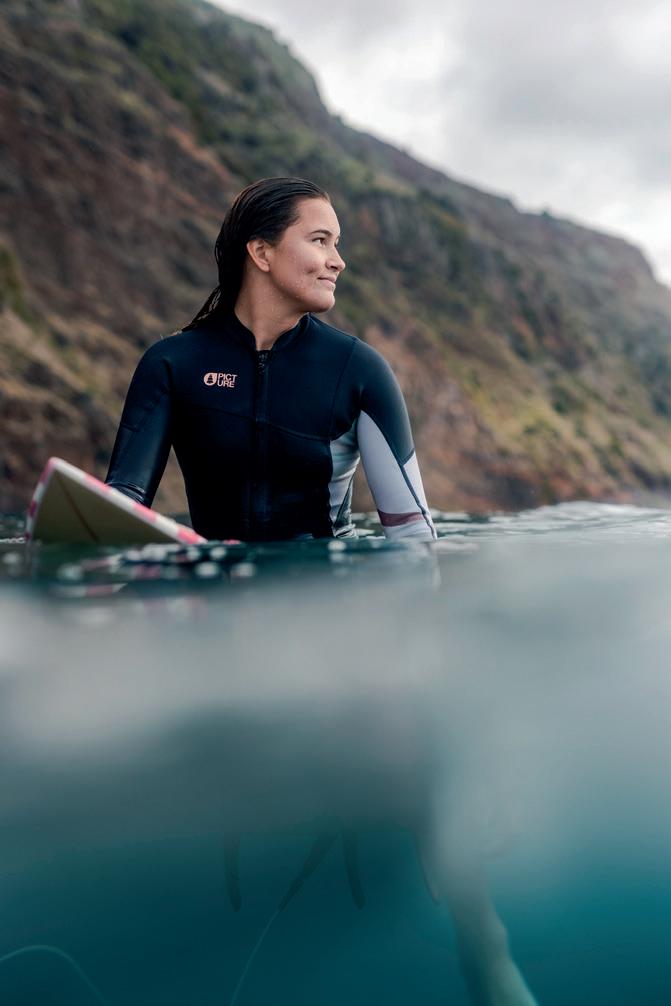
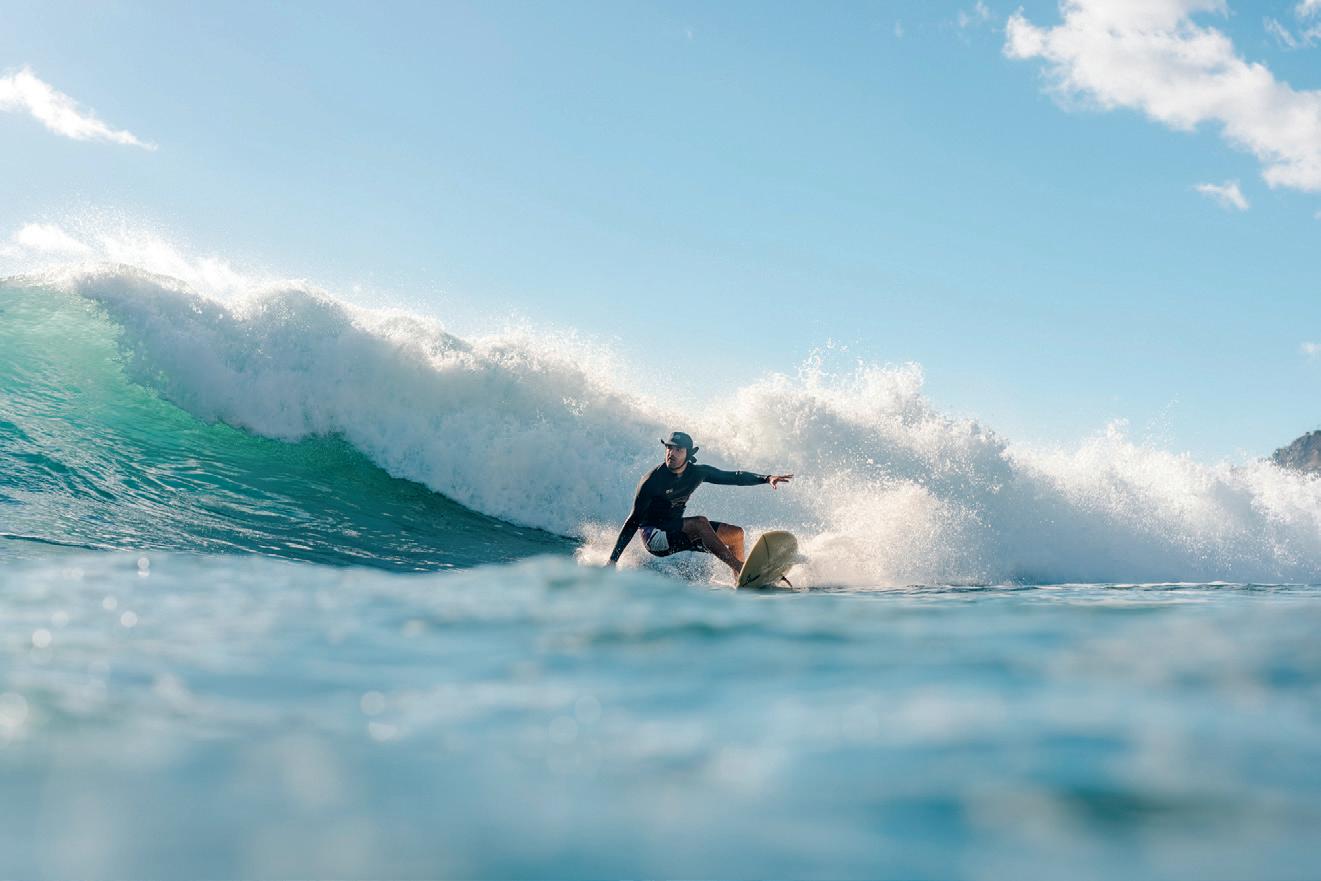
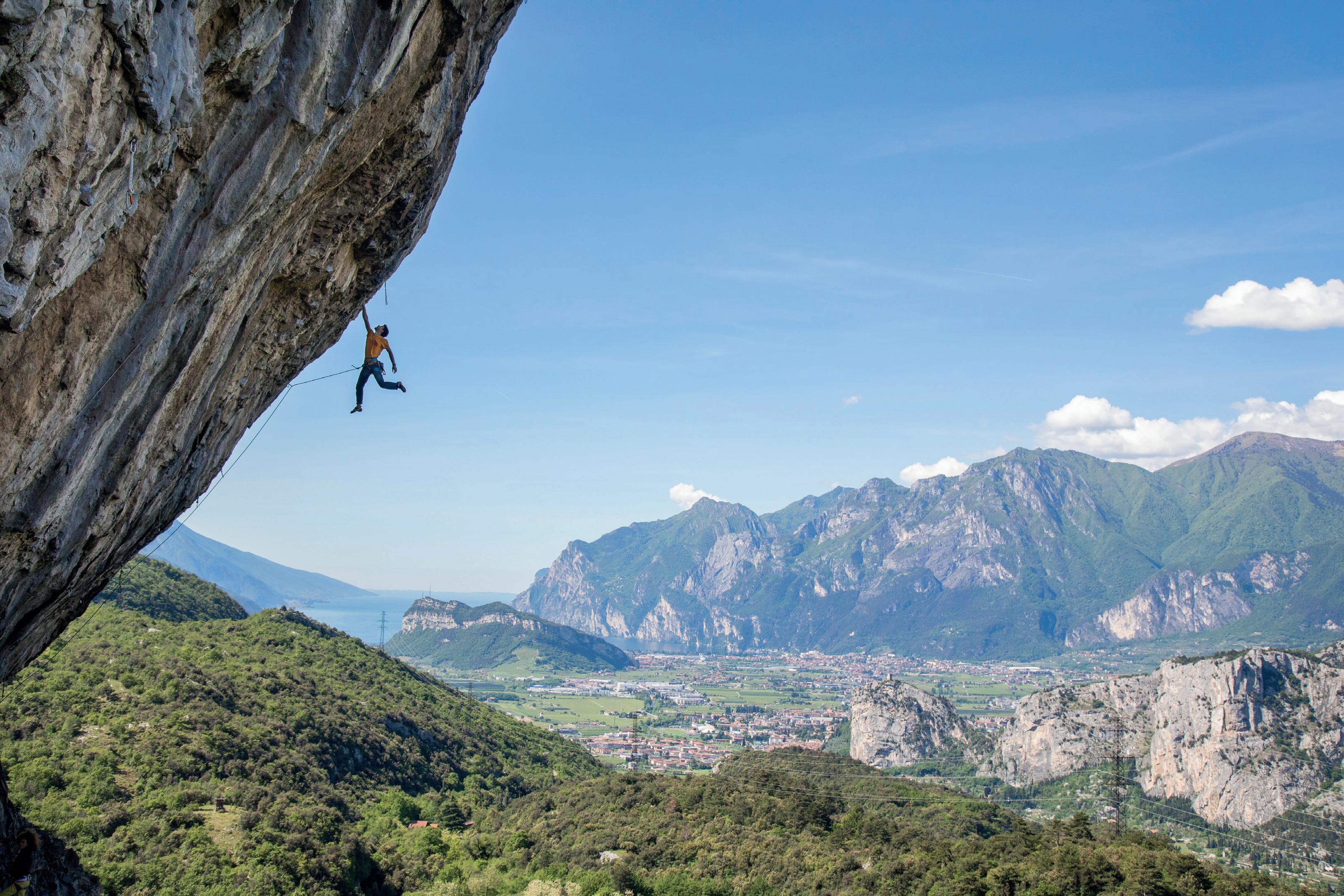
Trentino

Home sweet Home
Davide Magnini & Stefano Ghisolfi
BY LISA MISCONEL


From the high snow-capped peaks, to the scent of cut grass in the valley in the summer months, passing through the wooded trails and under the shiny rocky slabs up to the calm waters of Lake Garda. Trentino knows how to be of a thousand colors: it is green in the meadows and in the alpine landscapes and white on the Dolomite slopes, it is also vertical enough to host the hardest climbing route in Italy without ever forgetting the incredible historical mountaineering heritage of the great masters of the world landscape.
It is a gentle area, which gives its guests the opportunity to experience it as it suits them best, without ever being too aggressive in moving from valley to mountain and leaving room for those who love every type of element. This kindness is reciprocated by a great wealth also in terms of leading figures who then become front-line promoters of their house. We liked the idea of talking to those who experience this territory every day out of not only internal but also professional needs. This is why we decided to talk to two sportsmen who are very different from each other in terms of passions and origins but linked by the same keyword: the territory. Davide Magnini is one of those people from Trentino whose immense pride in his roots can already be perceived from afar, born and raised in the charming Val di Sole.
Stefano Ghisolfi, on the other hand, has brought the fame of Italian sport climbing around the world and he arrived in Trentino by choice and remained there out of necessity.

Davide Magnini
Davide tell us about your origins. I was born and raised in the mountains of the upper Val di Sole near the Tonale pass surrounded by Adamello and Presanella on one side and Ortles and Cevedale on the other. Precisely in the village of Vermiglio, when I was born, my father had just opened a sports shop, Lodo Sport. There, I have been in contact with sporting goods since I was a child, while my father, also a former ski mountaineer on a national level, transmitted his passion for the mountains to me year after year. He has always pushed me to try various sports from cross country skiing to downhill to up Nordic combined while in the summer he took me to the mountains with SAT on excursions and via ferratas. In short: I have always been immersed in nature in Val di Sole and the passion was born and raised with me.
Tell us about your area. For me it is one of the most beautiful: it lends itself to any outdoor activity and sport, allowing you to experience
57
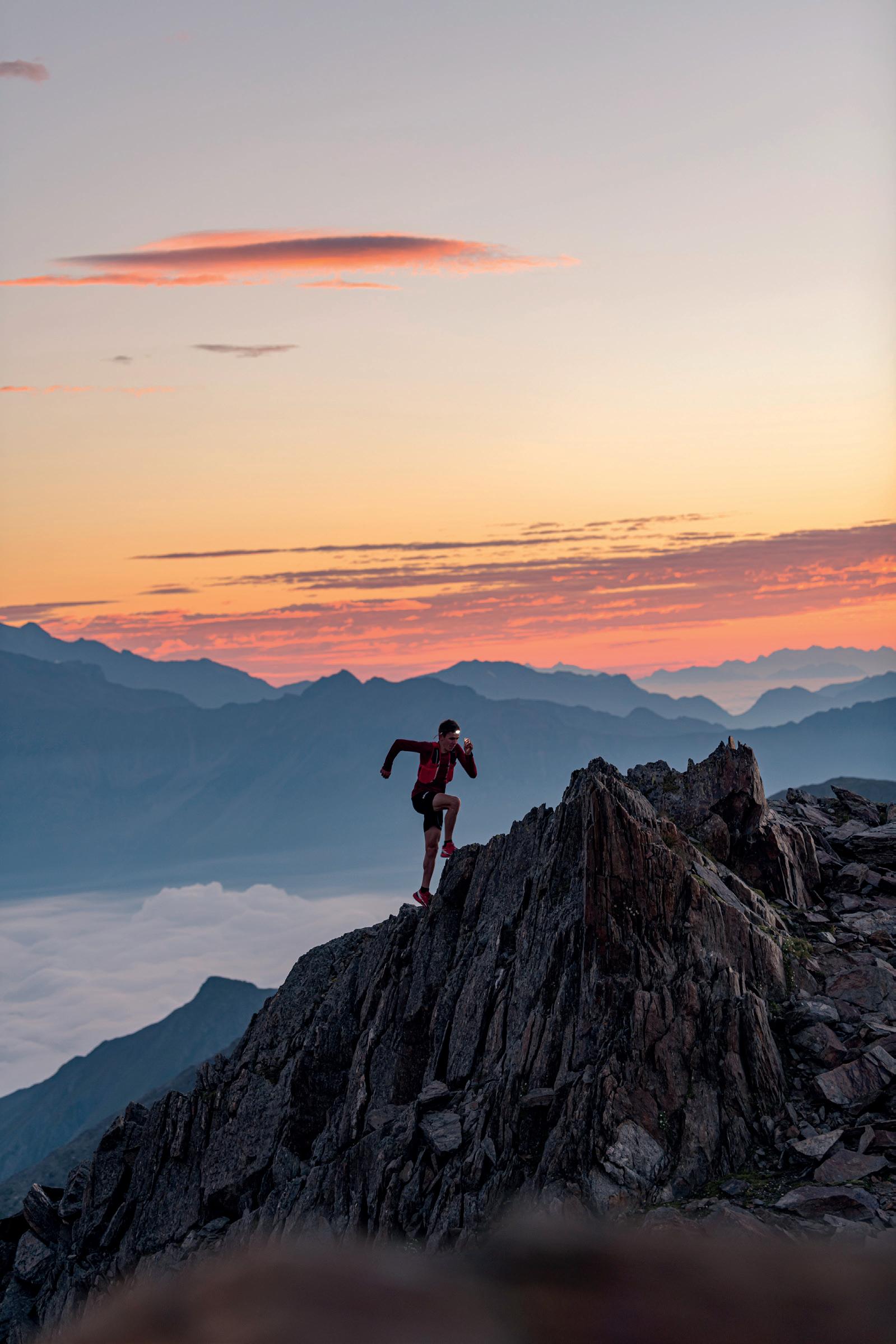
the mountain in all its facets and in all seasons, from summer with trail running, MTB and downhill with all the specific routes to winter with the true mountaineering on the peaks of Adamello/Presanella and Ortles/Cevedale. For skiing there is everything you need with three very large and beautiful ski areas that also leave room for ski mountaineering for those like me who prefer to climb on their own legs.
What is your favorite place in Trentino to run and ski away from home? A place in Trentino where I like running and skiing is definitely Madonna di Campiglio, which is also good for the mountaineering and climbing in spring. Another place I love is definitely Val di Fassa in every season thanks to the Sella mountains chain.
What do you think makes a region like Trentino different from the others? In my opinion, Trentino is a region that offers many varieties: starting from Lake Garda with a mild climate all year round with the possibility of practicing water sports such as swimming and sailing which, however, also offers tough and long excursions, via ferratas and cliffs to clim. In addition to the vast variety of outdoor sports for which it is possible to find ideal terrain, there is also a large variety of mountains, from the Brenta Dolomites to the Marmolada group to the Adamello/ Presanella Alps and very important and famous mountain groups in the world that make it unique. Furthermore, it is a territory that has always invested and continues to do so in services and structures to let everyone, citizens and tourists, experience its territory and its nature. We have a truly great wealth to preserve and enhance.
Stefano Ghisolfi
Stefano, you chose to move to Arco for sport and passion. The first time I arrived in Arco was in 2006 when I took part in Rock Junior, the Rock Master youth competition. This competition introduced me to Arco for the first time and all the children liked climbing in Arco because, in addition to the legendary Rock Master wall, it is nice to experience the days of the competition between a few swims in the lake and ice cream in the historic centre. There was the first approach; later, many years later, I decided to move there together with Sara (climber Sara Grippo, his partner ed): before we lived in Turin but we both had the same desire to live in a place where
you could always climb, with the crags nearby and away from the chaos of the city. We had both already thought about this thing before we met, and once together the desire was so strong that as soon as we finished the university we looked for a house to rent and we moved.
What is it like to experience Arco between season, off-season tourism and routine? There is a big difference between the seasons: in winter there is little movement except for climbers given the excellent period for climbing, while in summer it is filled with tourists and visitors. However, there are always different places to climb and the crags we frequent are not crowded places so there is room for everyone.
What does a region like Trentino give to sportsmen like you who make a job out of the outdoors? Surely the beautiful thing about Trentino is the possibility of experiencing the outdoors every day: very little is needed, everything is so close that many people after work can just go climbing as long as there is light because in a short time they are able to reach the cliffs (apart from my case, which is a stopover for work and therefore I can do it at any time every day). There isn't the traffic I used to find in Turin, and I know that in a maximum of half an hour I can be at the crag to climb. But I'm not just talking about the climb: in ten minutes I can get to the lake shore for a swim, in winter I get to Madonna di Campiglio in an hour... In short, the outdoors can be experienced at 360 degrees in an area where everything is comfortable and close and not dispersive.
What is your favorite place in your new home in Trentino? One of the most beautiful places where I spent a lot of time last winter is Excalibur, the route I climbed, not so much for the route itself but because nearby there is an open space where you can see the whole landscape of Marocche di Dro and a whole different part of Arco. It is a very relaxing place, little known and therefore very peaceful. It all started from Excalibur and I've always come back from there, even for interviews or shootings.
The most beautiful moment of the year in Arco? Definitely spring and fall. When it starts to get slightly warmer and it’s nice to climb well, you can also go to the lake.
Do you feel a little at home Trentino? I would say that I feel at home! Obviously I am fond of my origins but Arco is now part of me and I strongly believe in this area.
59
Summer Life on the Move
BY LISA MISCONEL PHOTOS DANIELE BOFFELLI
There are some things that really make you feel that it's summer and that you've been waiting for it all winter: live festivals, the scent of peaches, moonlit evenings wearing light clothes... In the mountains, June is the month of wild strawberries and elderflowers, and it's also when after a run you know you can throw yourself into the first stream you find. Cryotherapy or not, it is undoubtedly the most regenerating post-activity for mind and body, even if instead of a stream there is a fountain or a lake.
Like every year, we spent the days of the Lavaredo Ultra Trail in Cortina, both for its atmosphere and for cheering, but also to run one of the famous distances on the Dolomite trails.
Precisely on these paths, in 1992 a footwear reality was born capable of distinguishing itself in the world of walking and free time. With its sandals, for over twenty years Lizard has put values such as lightness, sustainability and comfort in the first place while offering traction, stability and protection for the feet while off road. Whether we are talking about walking immersed in the Dolomites or on the sand of ex-
tensive beaches by the ocean, as a go-to for travel by van or combined with a backpack for spontaneous adventures, this is the world of Lizard, with a different sandal for every mood.
One shoe test after the other, where we put our feet to the test between heat, intensity and rapid paces on kilometers of ascents and descents, we found the perfect days to escape to the banks of a stream and immerse ourselves in the regenerating water that flowed among the rocks. It is in these cases that you would like to move with the safety of a shoe with maximum grip but with the feeling of being barefoot: and
60

of 8mm and a reactive recycled EVA footbed, offers a dynamic and cushioned walk. In addition, the unique Vibram Eco Step tread design ensures support, grip and comfort even during long days on rough terrain.
For those who prefer more protection, Ultra Trek is the perfect combination of the comfort of a sandal and the protection of a
Finally, the Lizard Way Slide is the perfect choice for everyday adventures. These sandals are incredibly comfortable and light, designed to move freely. Invaluable companions on trips to remote places or daily excursions, they are easy to put on and adjust, ensuring a secure and comfortable fit. Thanks to the metal hook, they can be easily adapted to your needs.
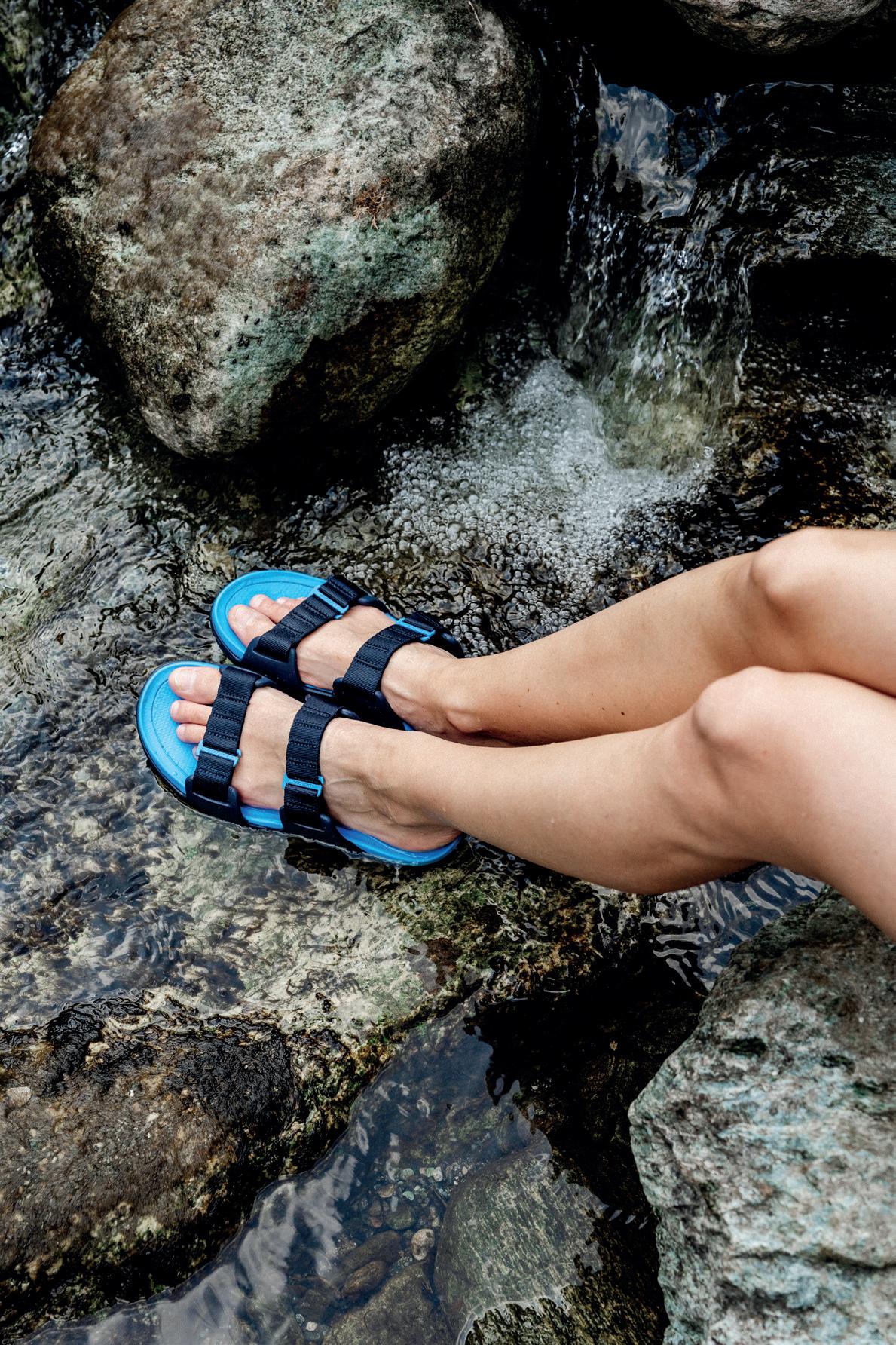
62


64
Exploration group La Venta: return to Chiapas
Thanks to them, incredible geological and anthropological discoveries have been made: now the La Venta group is back in Chiapas where it all began, thirty years ago.
BY ILARIA CHIAVACCI
PHOTOS DANIELE BERARDI, FRANCESCO LO MASTRO, NATALINO RUSSO
The enormous quantity of equipment that the La Venta exploration group brought with them to Mexico includes tents, backpacks, ropes, quickdraws, camp stoves, machetes. An incredible expanse of baggage that was essential to complete the exploratory mission with which fifteen caves were sifted inch by inch in the jungle of Chiapas, Mexico. Fifteen days, fifteen caves explored and monitored, fifteen springs sampled and analysed. La Venta team does this: it conducts exploratory missions in the most remote places on earth and it started its activity in 1991 right in the Mexican canyon excavated by Rio La Venta, which was the goal of their last mission and which gives its name to the group. La Venta can count on about fifty members, most of them Italians, but it can also boast international members and, by statute, its mission is to explore, map and above all document places on the earth of geological or archaeological interest that are difficult to reach and therefore need a team of professionals able to manage missions in extreme situations and territories.
“In thirty years of activity we are now very known worldwide: we have done things that no one else has been able to do” says Tullio Bernabei, the project manager in Chiapas. “In Greenland
and in the glaciers of the Alps we have conducted research on the variation of glacial masses, in Chiapas we have made hydrogeological and archaeological discoveries, in Central Asia we have been in the highest, narrowest and deepest caves in the world. More recently we have been conducting missions on the Gorner Glacier, Switzerland, to research glacial caves, while, even as we speak, others of us are in Iceland on a lava cave expedition. By statute, our goal is to discover something significant and then to disseminate and make these discoveries public, contributing to collective knowledge: we have published books, filmed about twenty documentaries, even for National Geographic. The data that we collect is then available to institutions and scholars: the canyon explored in Mexico is part of a natural park that based its management plan on our data, we are part of the technical council of the park and are engaged in the front line, especially with regard to conservation activities.”
The Chiapas expedition, of which Ferrino was the technical partner as regards the supply of the equipment needed to set up the base camp, perfectly exemplifies the complexity and value of what La Venta group does: that is to allow scientists, hydrogeologists and archaeologists in this case, to conduct research in places
that, without their help, they would never be able to reach. Simply put, it gets scientists to the right places. How was the mission carried out on a practical level? How many people were involved? There were a total of twenty-eight people between Italians and Mexicans, then there were a Colombian and a Spaniard guy and, once we set foot in Mexico, we divided into three groups. From Tuxtla Gutiérrez, the capital of Chiapas, we moved together with the civil defense in this eighty kilometer long canyon. The access to the canyon is difficult, which is why each group arrived at a different point: two managed to reach it on foot, with the support of the local communities who helped us carry the bulk of the equipment with animals, while the third group needed helicopter support because it was an even more remote place, generally it took two days. Once in position we set up a base camp for each group, which gave us the possibility, for about ten days, to explore the pertinent part of the canyon and scour it inch by inch.
So you had three logistic bases for daily explorations… The camps were fundamental because the exploration consisted of climbing up to the entrance to the caves, which were
65

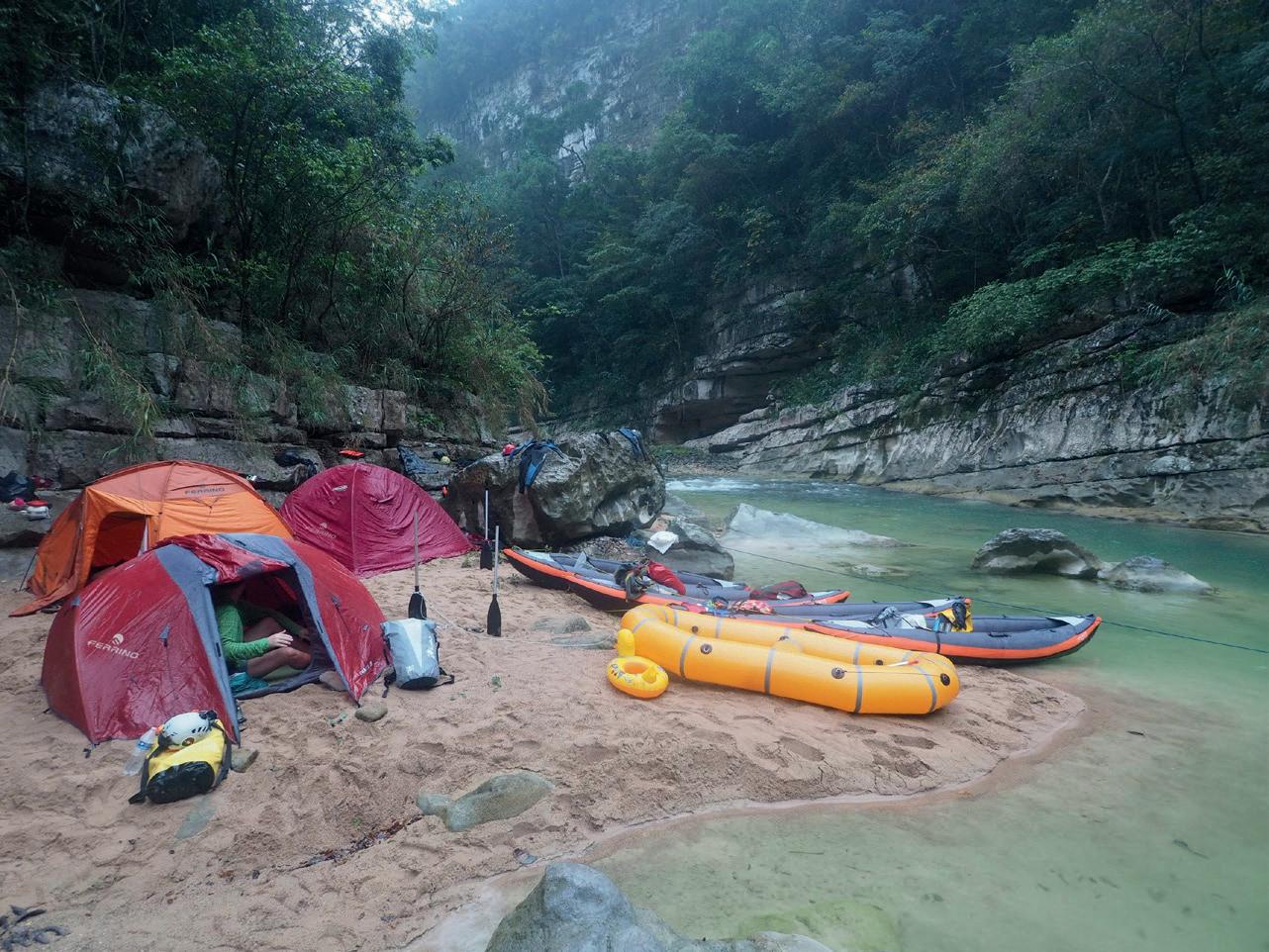
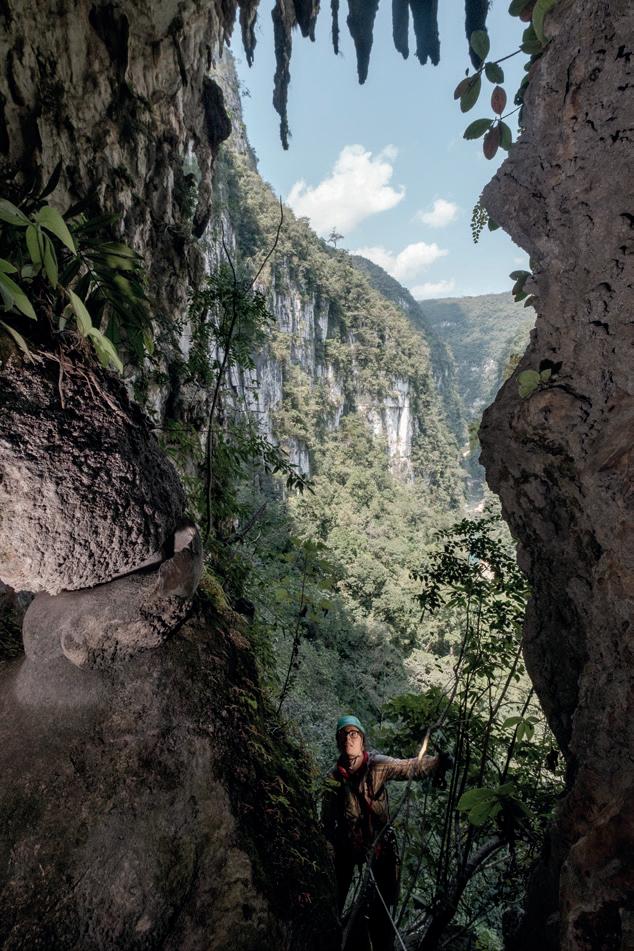
66
positioned on the canyon walls. We had identified most of them thanks to a helicopter flyover about a year ago: we already had a list of a dozen pre-established goals, but most of them were difficult to access. To carry out this kind of operation you need mountaineering skills, but also speleological skills: the aim of the mission is in fact to map what is inside the caves.
How important is the base camp in this kind of operation? Huge: recovering strength at night is essential. You can work your way through the day if you eat in the evening and sleep at night, otherwise you can't make it, you lose efficiency: in a situation like that, the type of equipment that Ferrino supplied us made the difference. Being able to count on comfortable, breathable tents that effectively protect against insects can fulfill a mission.
What is a typical day like in a base camp during such an expedition?
The days start very early, at sunrise, around 6.30am, for this reason it is essential to be able to rest well, then someone takes turns preparing breakfast for everyone and we leave for the real missions. Someone stays in the camp, to clean and guard, and communicates between the various groups by radio. Around six or seven in the evening we all return to the camp, wash our equipment, have dinner and make plans for the following day. At nine o'clock we are all in the tent ready to sleep.
What are the risks involved in such a mission? Expeditions like these are very difficult both for the risks that are usually run in an area like this, and then for those connected to mountaineering. In the canyon we didn't have the possibility to choose one better route than another, we necessarily had to reach the entrance to the caves: the greatest risk was that of finding bad rock, perhaps too friable. This with regard to the upper part, in the lower part of the walls
instead there is the jungle: you have to open your way with machetes. The presence of insects is massive and, on balance, it is one of the things that has given us the most trouble: both because there may be some spiders or some scorpions in the holes where we put our hands to grip, and both because there is the possibility of being attacked by bees or wasps. Which, by the way, happened.
Could a bee mess it all up? Another explorer and I were stung, I'm also allergic so for me it was a bit more problematic: since there were many stings we went back down immediately and were rescued by a civil protection helicopter that took us to the hospital. After that we equipped ourselves with anti bee suits and went back to doing what we had started, this time operating at night, when the insects are less active, and this time all fully covered. We managed to reach all the caves.
And once you reach the caves?
At that point the actual exploratory work begins, which includes three phases: first of all, exploration is done through the topography, i.e. the caves are measured, because it is important to have a survey, a drawing of the territory, because it gives us important information on the geology. At that point we start with the search for watercourses to take samplings and see if there is pollution: around the canyon there are inhabited areas and this is one of the first things to establish. The last step instead consists in the archaeological documentation: many of these caves, the most accessible ones, were frequented in ancient times, we are talking about 500-600 a.C., by a pre-Columbian population parallel to the more famous Mayas, the Zoque, one of the mothers of meso Americas. The Zoque are little known because little studied, however in this canyon there are incredible things: think that they climbed the walls with their bare hands or
by building scaffolding to celebrate sacred religious rites in these caves.
To do all these things you need many different skills, in fact you are a diverse team… In this case we had a Mexican archaeologist with us, then we had two hydrogeologists to take water samples and carry out analyzes on site, some samples instead we had to send them by helicopter to the capital of Chiapas because some analyses, such as those of colibacteria, which serve to establish human activity and presence, must be done within 12 hours and the samples must be kept in the cold. Then there were surveyors, mountaineers, cavers and a nurse.
What has been the most significant discovery of this mission?
First of all, we did a comprehensive analysis of the major springs in the canyon to understand their state of health. This place is wonderful, but it has undergone an important human impact and, in the meantime, to conserve these springs, we need to discover their state of health. First of all, we need to understand if it is as virgin a place as it seems at first glance, or if it is already suffering the consequences of anthropization. Speaking of caves, if this were the case, it is not something that can be solved in a short time: let's assume that the cause is an intensive animal breeding, it is not that if you move the breeding the cave is clean after a day: since it is aquifers karsts can remain polluted for decades, so it is necessary to intervene in time.
Have you received the results on the water samples yet? Not yet, they take a long time: however, it seems that there is pollution, but less strong than we thought, because these caves have a very strong power of oxygenation and water purification, it is as if their conformation acts as a filter.
67
Peter Moser Pioneer reloaded
BY ILARIA CHIAVACCI & ALESSANDRO BELTRAME
On August 10th 2021 Peter Moser chained, in just one day, six of the main mountains of the Pala group trying to retrace the footsteps of the first climbers. In fact, Peter Moser worked by subtraction: he took off the rope, the harness, even his partner. He did that to get to the ultimate essence of the mountain, to try to carry out a mission that celebrates and reveals its purest essence: a bit like what happens when children draw it, with their ability to get to the heart of things by cutting the superfluous.
This experience gave birth to a movie, directed by Alessandro Beltrame and supported by Aku, with an evocative title: “Pioneers”. Moser's will was in fact to retrace the steps of those who, on the Pala group, opened the first routes, explored as a pioneer a territory that was still unknown to most. On August 10th 1896 Bartolo Zagonel, Michele Bettega and Beatrice Thomasson had in fact set off on a series of explorations which would last years and which would allow mountaineers to enjoy these routes. Peter Moser wanted to repeat the ascent of the three, choosing the same day, August 10, but 125 years later and proposing to enchain six peaks in one day. To be able to chain all the peaks and stay on schedule, he set off at 2:45, this was not only a sporting performance on Moser's part, but also a search for his roots, firstly as a mountaineer, then as a mountain guide and finally, also as a mountain lover.
The fi rst peak of the route is also the highest one: Cimon della Pala rises 3184 meters above sea level, the village of San Martino from up here is nothing but a handful of flickering lights in the dark. «Around 4 in the morning I slipped on a still frozen slab of snow: maybe that's where I really woke up and it all started. Taken individually these routes are not difficult routes, on the contrary, but put all together they forced me
68
Here is the route, both of the pioneers and of Moser
M
M
M
M
M
M
CIMO N DELLA PALA 3.184
PALA DI SAN MARTINO 2.982
CIMA CANALI 2.900
SASS MAOR 2.812
SASS D’ORTIGA 2.631
PIZ DE SAGRON 2.486
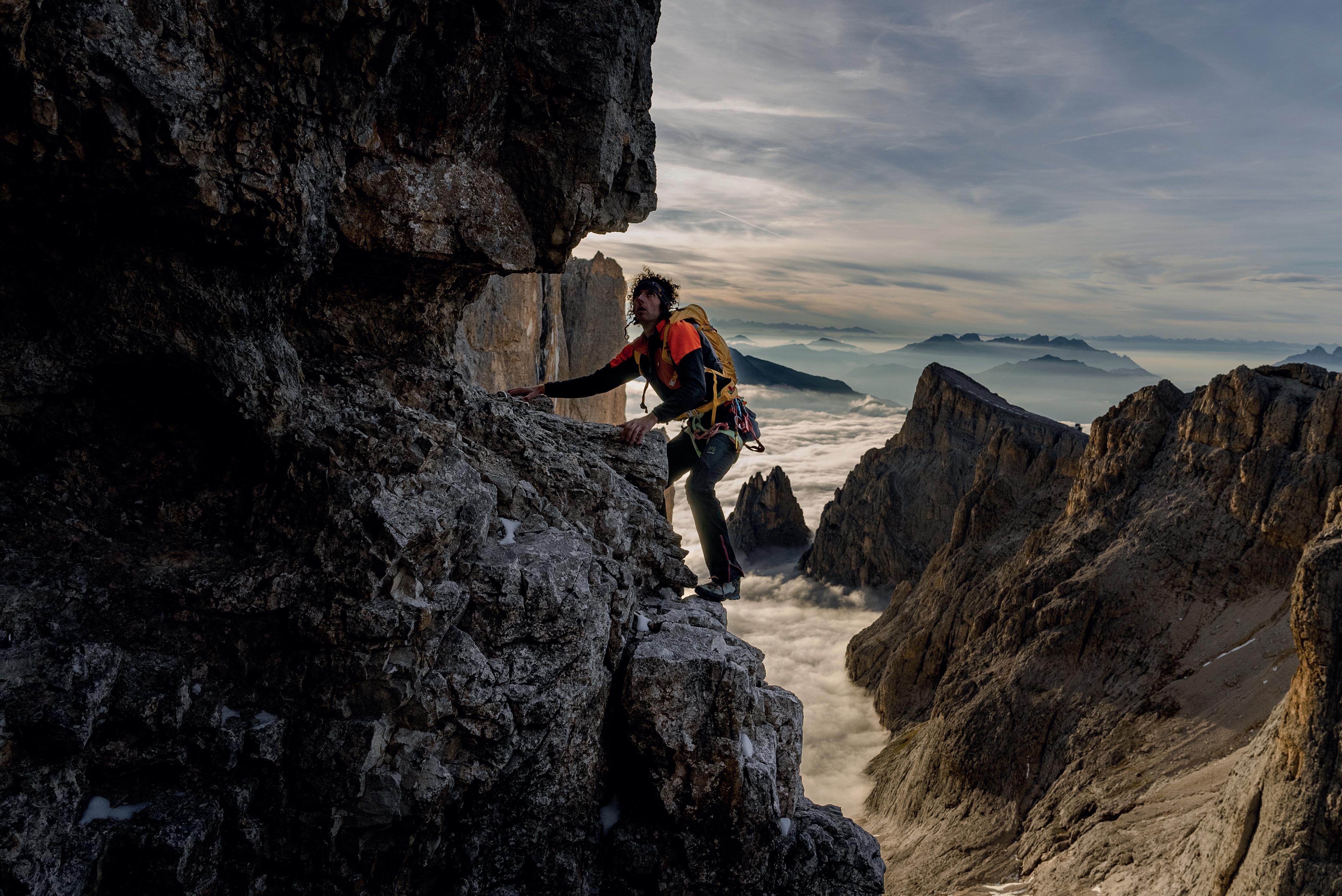
to concentrate continuously. They left me with a very deep sense of respect for those who opened these first lines: it took them a total of 20 years to climb these peaks, thanks to their work and their genius I was able to do it in one day» says Peter Moser. «The truth is that I deeply envy them, because they had everything at their disposal, an immense territory and a thousand possibilities for exploration: now you have to carve out a corridor in history to be able to create a new itinerary on a wall.» Much of the romanticism of first ascents is inevitably over, today the world has become small: all the knowledge and technique we have at our disposal considerably narrows the field of “firsts".
«However, what these mountains still give you is the sense of freedom: they are itineraries at the edge of the sky that give you crazy energy. Moving at speed without being tied down is like being one with the rock, with the mountain. There have been some particularly difficult moments, both from the point of view of fatigue, but also from the point of view of safety: when you're fast you have to take risks, it's part of the game. As a mountaineer I always look for adventure: for me that is the priority, even with respect to the difficulty. In mountaineering, as in life, I always choose to get involved: this was undoubtedly a great adventure. Sports performance was the last thing that interested me: I did it at speed, it's true, but without haste, without a stopwatch, my goal was to live the experience, not measure time». Today, when mountaineers are all looking for their own figure, it is not trivial to find a path that has not yet been beaten, a record that has not already been broken, or simply find a new idea for a mission. «I have yet to understand what kind of mountaineer I am: the only thing that is clear to me is that I love the mountains, they are part of my habitat, to feel good I am forced to stay among the peaks. I was born a mountaineer and I will die a mountaineer, perhaps this is the essence of mountaineering for me. For me, this adventure also represented a bit of a journey within myself, or perhaps a kind of escape that lasted a day.»
If it is impressive to chain six peaks all between two thousand and three thousand and some meters high, it is also impressive to imagine the adventures of the pioneers of the late nineteenth century, when perhaps there may not have been the anxiety of discovery, but certainly there weren't even the products and knowledge that today's climbers can count on. «These walls are real labyrinths, being able to climb these very imposing, intimidating peaks with the gear of that time was something truly grandiose. They probably had to observe the mountains for days. maybe waiting for the first snow to fall to see the weak points. It is not obvious even for an expert mountaineer to be able to find the best route, let alone with the means of the time. These itineraries are based on the weak points of the mountain, which are real access points to get to the top, I think there was an incredible work of interpretation from the first climbers.»
Returning to those paths and those difficulties, which today seem trivial, but putting them together in one day, however, makes the path complicated, also and above all from the point of view of the stress to which the body is subjected. «I gave myself the only mini break at the Treviso refuge, to start slowing down since my body was rather exhausted.»
70
If it is impressive to chain six peaks all between two thousand and three thousand and some meters high, it is also impressive to imagine the adventures of the pioneers of the late nineteenth century, when perhaps there may not have been the anxiety of discovery, but certainly there weren't even the products and knowledge that today's climbers can count on.
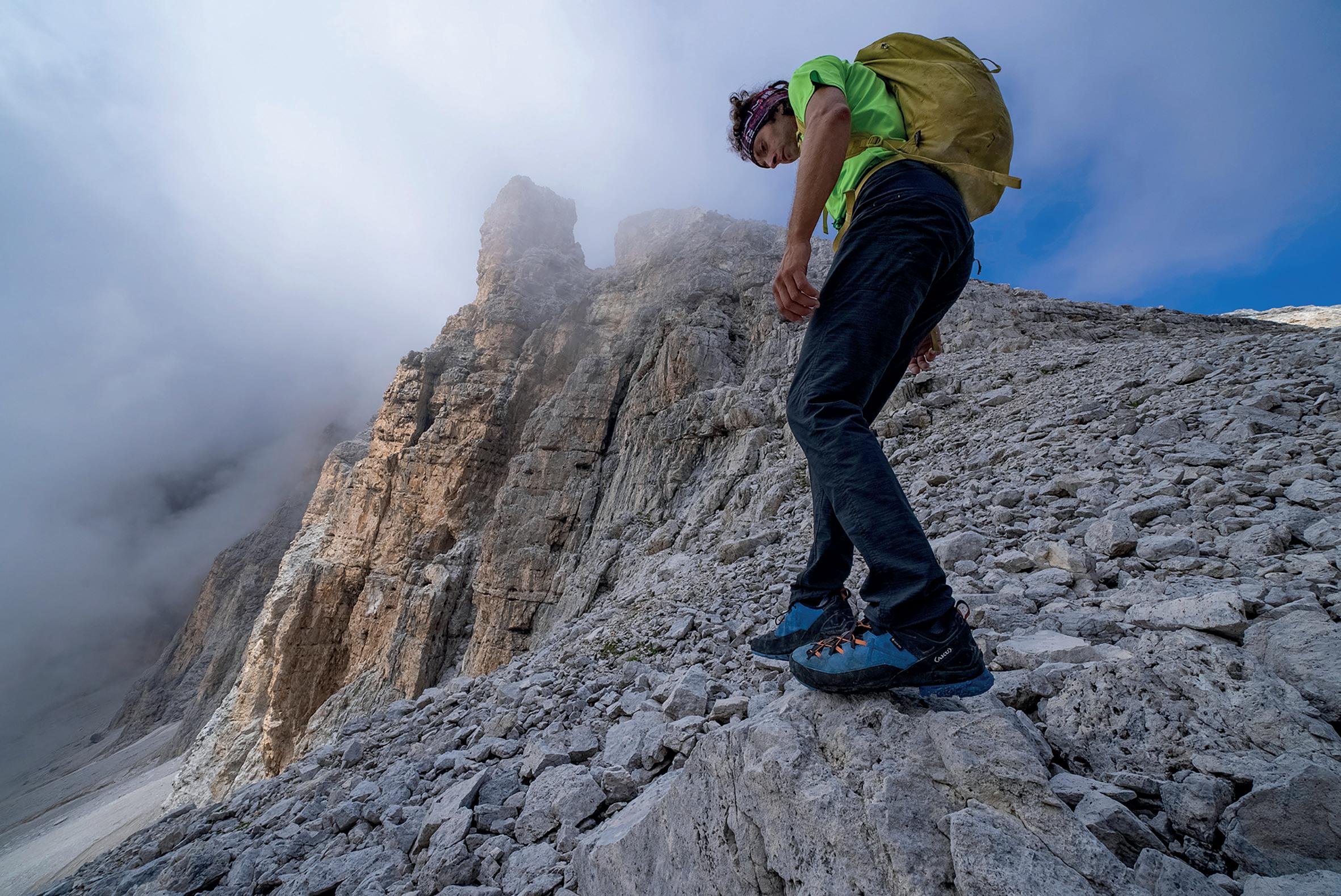
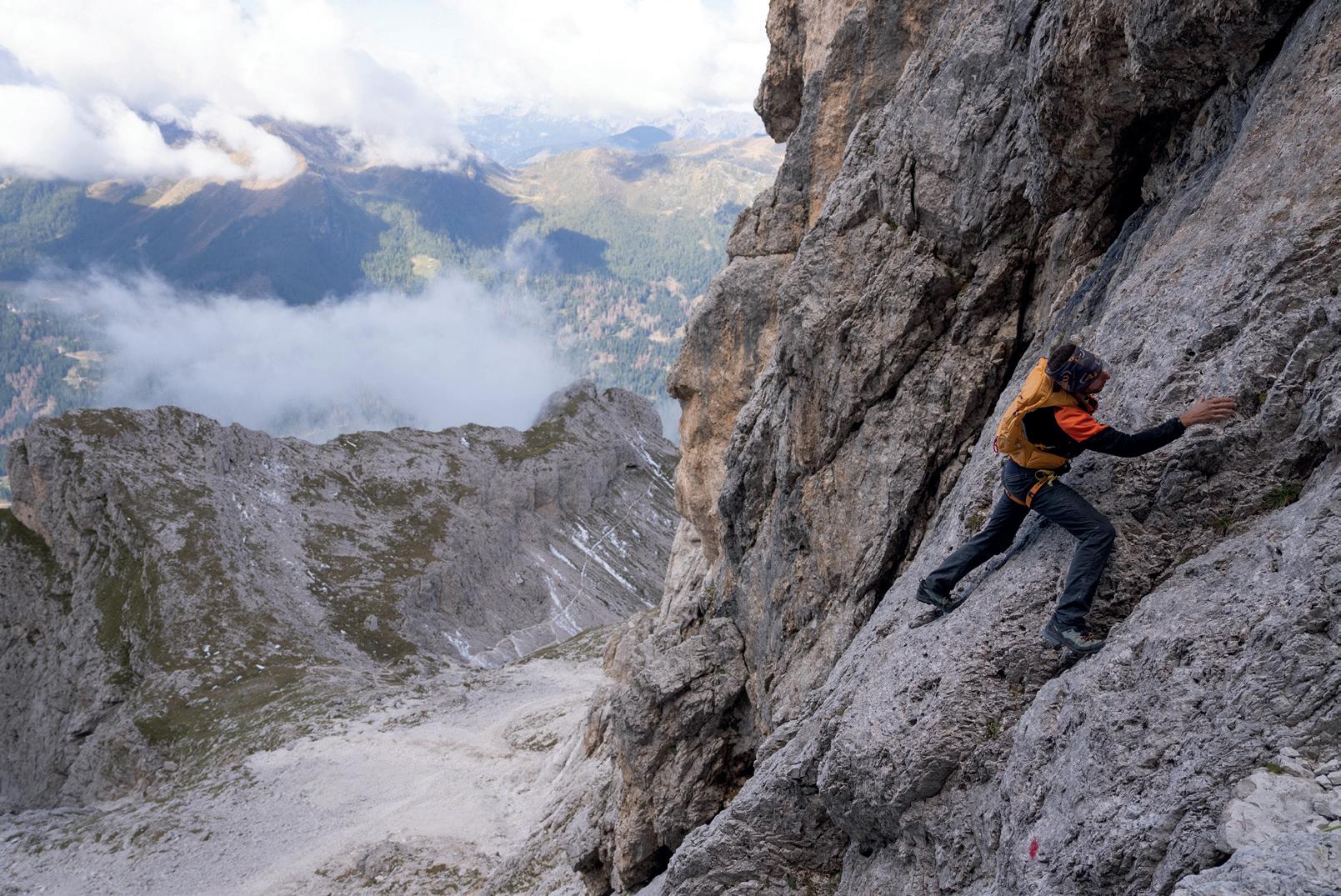

He Lives to Discover Bear Grylls
BY LISA MISCONEL
With a military background, he was also the youngest Briton to conquer Everest in 1997 after surviving a skydiving accident. About him, every kind of story has been written: that he is dead and done with his adventures, what he eats, what he wears, and some argue about the genuineness of his adventures.
Edward Michael Grylls has probably been part of all of us Millennials' imaginary since our teenage years with the name Bear Grylls and titles such as "Man vs Wild": extreme adventures, survival expeditions... he escaped sharks and crocodiles by tackling situations at the limit, even in terms of nutrition. With a military background, he was also the youngest Briton to conquer Everest in 1997 after surviving a skydiving accident. About him, every kind of story has been written: that he is dead and done with his adventures, what he eats, what he wears, and some argue about the genuineness of his adventures. The truth is that he never stopped exploring, and his will and passion are unquestionable and to be separated from the television product, which he himself considers only one among the many components of all his work.
For most people you represent THE explorer and adventurer. How did your character evolve through time, and who is Bear Gryl-
ls today? In truth a big part of me is the same kid that loved to climb with his dad back home aged 8 on the small sea cliffs near our home where I grew up. It is the connection to the outdoors and those close to me that has always been my driving energy. Obviously, lots has also evolved and changed but what hasn’t changed is the joy of being able to share the empowering nature of wild places with great people - that is a privilege that I never take that for granted.
Media have always played an important role you your career: how can you imagine a life in the outdoors without a camera following you or a challenge to document?
For me that is always the end goal. Doing these adventures camera free! If you ask our crew they will laugh at this dynamic - they’re always chasing and I’m always trying to get away! But somehow that tension works. I love the guys for sure, they are like brothers to me, but I genuinely struggle with being on came -
73
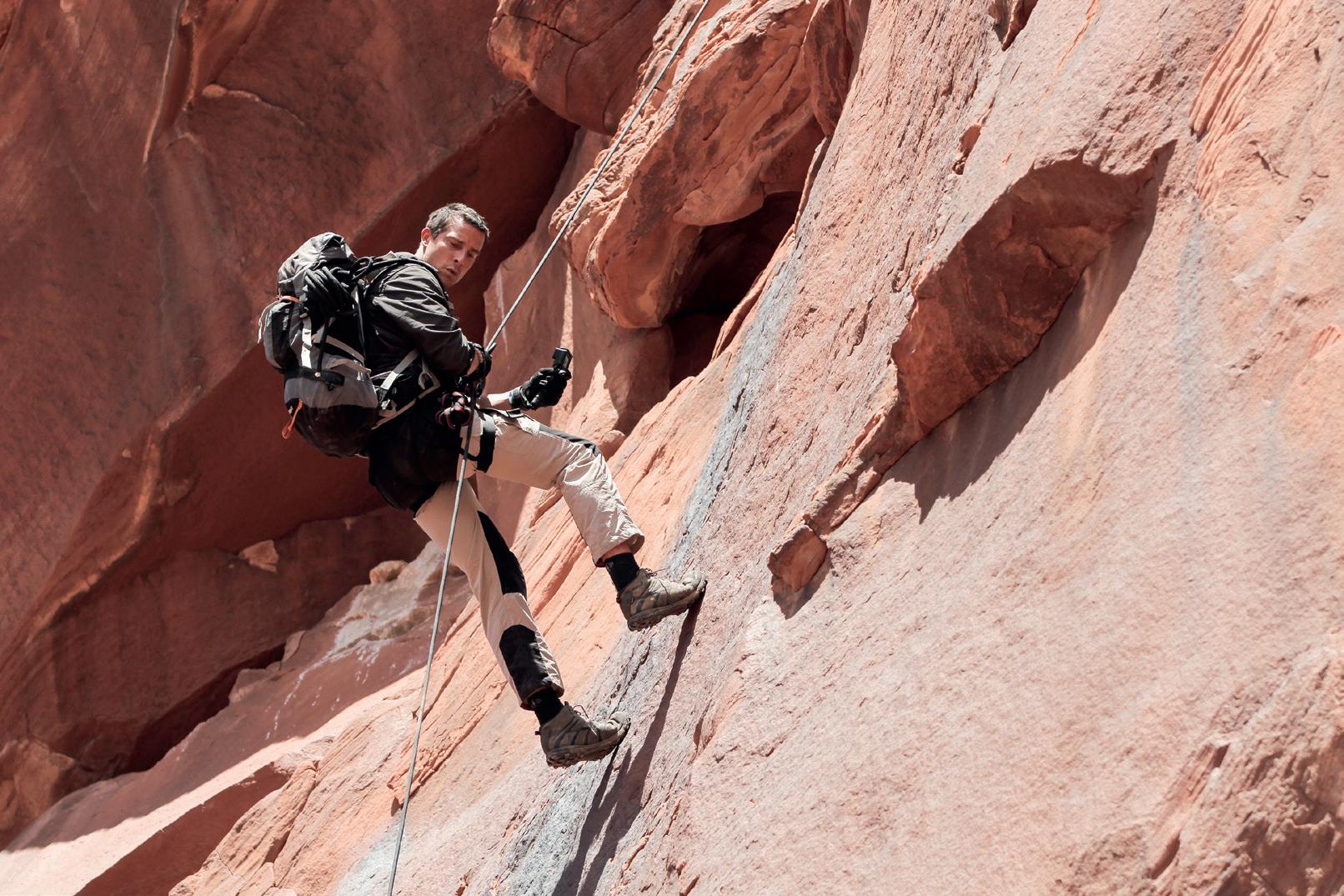
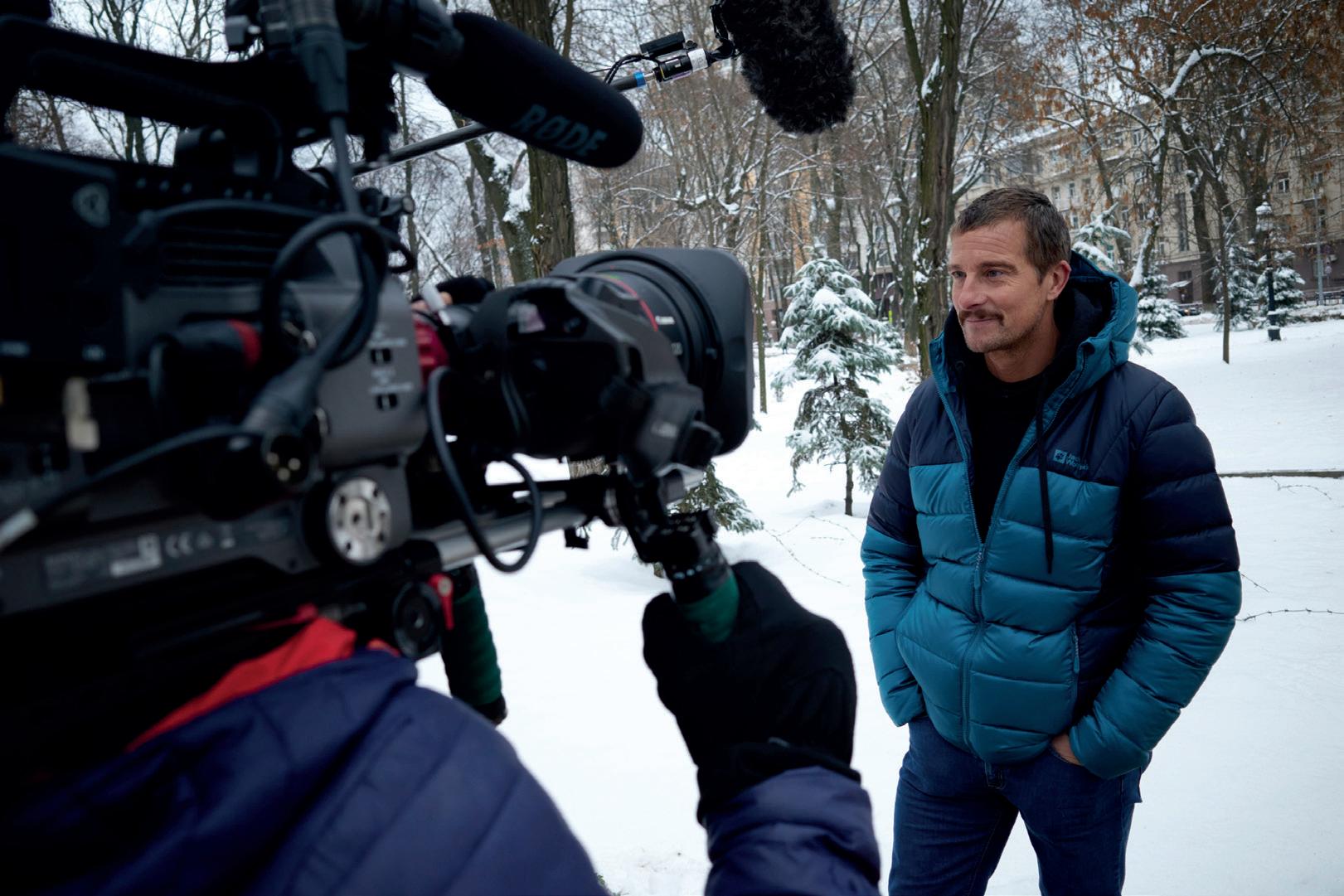
ra. It’s not a natural happy place for me but I do see it is simply as a bi product of my job. We just are intentional nowadays never to say “action” and never to do a second take. We keep it discreet and low key. The crew just quietly turn on the cameras and we start moving… I like that and it makes it less official and formal.
What do you believe to be your biggest achievement? I think it would be becoming Chief Scout, it’s been the biggest honour in my life. To stand alongside so many unsung heroes, of every age, and to know that together we are part of something so incredible. The Scouts are the greatest youth movement on earth, 55 million strong, and such an inspiring force for good. From the stories of courage in refugee camps to the inner-city workings of volunteers, the commitment and values that the Scouts stand for is inspirational. I could not be prouder to be a small cog in the incredible machine and family that is scouting.
In the past couple of years, a young outdoor community has grown and started to look for space to express by hiking and running away from cities and society. Have you had the chance to experience this phenomenon in first person? What are your thoughts? Not yet but it sounds great! The wild parts of our world are hopefully becoming easier to access and people are ever keener to get off grid and really embrace wilderness challenges. The pressures of modern life and being permanently connected via technology and phones means people are wanting to escape those constraints more and more - it’s about having an adventure state of mind, to get out there and discover what we are made of. That spirit of discovery is powerful and it’s in us all. My goal is always to empower people with skills that will allow them to push boundaries and explore safely and experience the magic of adventure.
In this regard, what does it mean to you to be an explorer? To do our best to live with a spirit of quiet courage to face the difficult stuff head on, a heart today tries to do small

tangible kind things for people every day, and to develop and build every day an unconquerable inner resolve to never give up in the important things in life: our dreams, our planet and each other.
In a world where everything has been done, seen, documented is there still somewhere where human haven’t been? So many! The more I see of our planet the more incredible and huge I realise it is. Mother Nature never fails to inspire and take my breath away. Yet I also feel nature is struggling which is why preserving the wild places, habitats and wildlife is so important to me. It is all about preserving the future.
Is there a place or a project you still have on your bucket list? I have a long bucket list, that seems to keep on growing, but I would still love to revisit some of the unclimbed peaks in Greenland and lead some trips there. There are such huge expanses of genuine wilderness, totally unexplored and that brings with it a sense of awe that is hard to describe.
What about your new adventure with Jack Wolfskin? What value of the brand do you feel closer to your vision? Jack Wolfskin and I share a commitment to empowering people of all ages to get out there and find their adventures, whether that be local or further afield. I often think we are all a bit like grapes: its only when we are squeezed that we see what we’re really made of. When you find that adventure spirit in you, whether it is enduring a night out alone or climbing up a high cliff, the wild gives a pride that money cannot buy. The outdoors doesn’t discriminate and it doesn’t judge. The wild is always revealing like that - it is like a mirror to our character and has an incredible way of bringing people together and empowering us. We really want people to live by the mantra “We live to Discover”!
What’s cooking with this new partner for 2023? New gear, new adventures, new shows and new goals. Pushing those limits and taking great people with us for the ride. What did you expect!?

75
Chasing records
BY CHIARA BERETTA
What is the secret of Nicolas Hojac's exceptional high mountain performance? Training, of course. But not just a normal one: it is a training that made alpine trail running the central and most important element. This discipline, in fact, as studies suggest, increases resistance and helps reduce energy consumption during the ascent. Also thanks to this preparation, in 2022 the Swiss Mammut athlete managed to score a new record on the Swiss Skyline Route, the iconic climb that touches Eiger, Mönch and Jungfrau, the three great peaks of the Bernese Oberland which respectively reach 3967, 4110 and 4158 meters of altitude. The itinerary typically takes around four days to complete, but Hojac accomplished the feat with Adrian Zurbrügg in just 13 hours and 8 minutes. Training always and only on high mountain terrain would clearly be ideal for preparing for this and other similar feats. The problem is that the weather conditions, the high risks and the considerable amount of time required do
not always make it possible. And this is where trail running fits in as a very effective option. “As a professional mountaineer, I can't train all the time in the high mountains” confirms Hojac. “My technical skills make it very easy for me to transfer the fitness I get from trail running from trails to mountain terrain.”
The advantages of trail running: from trails to high altitudes
Trail running is a quick training that can offer great benefits to mountain athletes precisely because it stresses the body in a complex and demanding way, much more than what happens during a classic road run or in a forest. In fact, in trail running there are greater elevation gains, with steep ascents and descents, and different terrains, with stretches of mud and stones: all this, as well as considerable resistance, stimulates greater strength and better coordination and concentration skills. However, it is not only the functionality of the training that has fascinated Hojac. With
76
Alpine trail running is the key to achieving excellent performances in the high mountains. From training benefits to essential equipment, here is the experience of Mammut athlete Nicolas Hojac, who set a new record on the Swiss Skyline Route last year.


trail running, added the Mammut athlete, “you can run easily and efficiently, and in this way cover much longer distances than with hiking. As a climber, I love it when your runs take you from hiking trails to a “climbing terrain”. It's a nice change of pace and it makes the course a bit more challenging and varied.”
The challenge of the equipment: essential and light
Trail running on alpine terrain also represents a considerable challenge in terms of equipment: you need to select essential but functional equipment, lighten up with common sense (i.e. without leaving things at home that could later turn out to be fundamental) and obviously you need to know all the risks involved. “Trail running in alpine terrain requires a lot of experience. Since you want to be as minimalist as possible, you sometimes have to do without some equipment” says the Swiss athlete. "But if you don't have enough clothes with you, a sudden change in the weather can have serious consequences." Especially the shoes, for people who practice trail running, have a vital role: they are crucial to be able to move quickly and safely on challenging terrain. “Besides a good fit, the most important thing about trail running shoes is the sole” comments Hojac. Being the point of contact between the athlete and the ground, it is almost the most significant factor in terms of safety. “Slippery soles can lead
to very serious accidents. But you should also know the limits of your trail running shoes, for example if the ground is frozen or if you are running on snow.”
Mammut ’s new proposal for trail running
Well aware of the needs of runners who like to test themselves on challenging trails and alpine terrains, Mammut has launched a new collection dedicated to trail running. Lightweight, breathable and resistant, it has been designed with the specific features of this sport in mind. Among the highlights of the collection are, for example, the TR BOA Mid GTX shoe, the ultralight Aenergy TR 5 vest with pole holder and bottle holder and the Aenergy TR 2-in-1 shorts made from recycled materials. The Aenergy TR BOA Mid GTX Women, in particular, is the top-of-the-range shoe: designed for medium and long distances, it has a Vibram Megagrip sole with Litebase technology, perfect for tackling even the most difficult conditions with a light weight, and a Gore-Tex membrane that protects from water. It also features a comfortable high rebound EVA midsole and a breathable knit upper, with a precise and micro-adjustable BOA Fit system. The entire Mammut trail running collection, among other things, is completely decarbonised, which means that the emissions caused during the production process have been offset and removed from the atmosphere.

78

Le champion du monde: Benjamin Roubiol
BY FILIPPO CAON PHOTOS CYRILLE QUINTARD
 ODLO X-ALP TEAM ATHLETE
ODLO X-ALP TEAM ATHLETE
I'm on a bus going to Arco, I'm watching the World Championships of Trail Lungo, in Stubai, Innsbruck. In the lead, there is Andreas Reiterer: he is the favourite, he is head and shoulders above anyone else, he is fine, he has already come close to that result in the past and he is now launched to finish the job. Then, something stops working, his pace changes, he stops spinning. Runners fight behind him and he stands there in front, he looks like an empty shell, he has nothing left to give. A few minutes behind him, there is a young French guy, unknown to most of people: his name is Benjamin Roubiol, and unlike Andreas, Benjamin is flying, really flying. Andreas slows down and Benjamin approaches him. 15 kilometers to the finish line, after eight and a half hours of racing, the two find themselves 30 seconds apart, 20, 10, zero. On the last climb Benjamin runs twice as fast, he's fine, the other guy is a corpse. Once Benjamin has reached the first runner, he could take advantage of it to catch his breath, staying close to his ankles and then detaching him in progression, in the way the French ultrarunners are used to do. But Benjamin did not: he feels that that's his moment, it’s the moment to attack, and so he leaves all behind and never stops.
It's difficult to get excited during the live coverage of an ultrarunning race: almost nothing happens and when it does it happens very slowly. As far as I'm concerned, it's even more difficult when it comes to the World Cup. But that attack, in that moment it wasn't the World Cup anymore, it was just sport, in its highest and most abstract form. That attack, seen live, was something so violent that it was difficult to explain, I would tell you to go and
watch it again, but it wouldn’t be the same thing. Benjamin won with 8 minutes, earned in 15 kilometers, and with a super action: well done man.
About a month before that I got the usual message: “Hey Filo, would you like to interview team Odlo X-Alp athlete Benjamin Roubiol?” I don't know him, so I start studying: he's about my age, more or less, and he mostly raced in France, but in his palmarès there are some notable exploits: 14th at CCC, 14th at the Diagonale des Fous, 21st at the Marathon du Mont Blanc. On social media he writes in French: I don't speak it, I don't understand it, I sense it: between the folds and ripples I begin to define the person, I find food for thought: they are traces, but I sense the direction to take. On social media he talks about environmentalism in a very uninhibited, sometimes sharp way, he comes out of the hackneyed narrative of the outdoorsy world. During the interview he answers me in a slightly hushed voice, slowly. He hesitates a lot before saying anything, he seems to give it some weight. In interviews it is important to try to adopt the interviewees' tone of voice: if they’re calm, you should speak slowly, if they shoot five thousand words a minute you have to get involved in that enthusiasm. You have to indulge into the posture, their way of doing it: in an interview there is an unnatural hierarchy, it is not a comparison of equals, it is more of a guided monologue.
While we talk I try to give Benjamin time to think, to make him feel at ease, but more likely I just get him drunk, with my Mediterranean and sunny English, or "modern Italian". Between the two of us there is a rock that no one has put there, but we can't do otherwise, so at the end of the interview I have
more questions than when I started. It is strange to wish that you wanted to know a person more deeply, but that’s impossible because of something that does not depend on you: a language. There is nothing that can be done to avoid it, it is not even enough to study it. It is very difficult to really understand a person if you speak two different languages, even if you speak fluent English. The inflections, the little details of a conversation, they all get lost. Maybe that's the fascinating thing, and maybe that's one thing we'll never get over.
How did you start running? And what are you looking for from sport, both in terms of experience and performance? I started running as a child, here in my home mountains, the French Alps. I'm from Cruet, near Chamberry. In my village, a quite famous race is held every year, and seeing it made me passionate about the sport.
You mainly competed in France, first on short distances, then you increased them: you run CCC with great results, then several shorter ultra races. Last year you embarked on a 100-mile race, very tough on the other hand and, all in all, not very popular within the media, however famous: La Diagonale des Fous. What brought you there? I've always been fascinated by 100 miles runs and that kind of racing. As soon as I had the chance, I seized it, I chose Réunion for several reasons, the first one being that I have many friends who live there, and the idea of discovering this place thrilled me a lot. I study Environmental Studies, so the island also interested me from a personal and professional point of view. And discovering it and visiting it while running
81

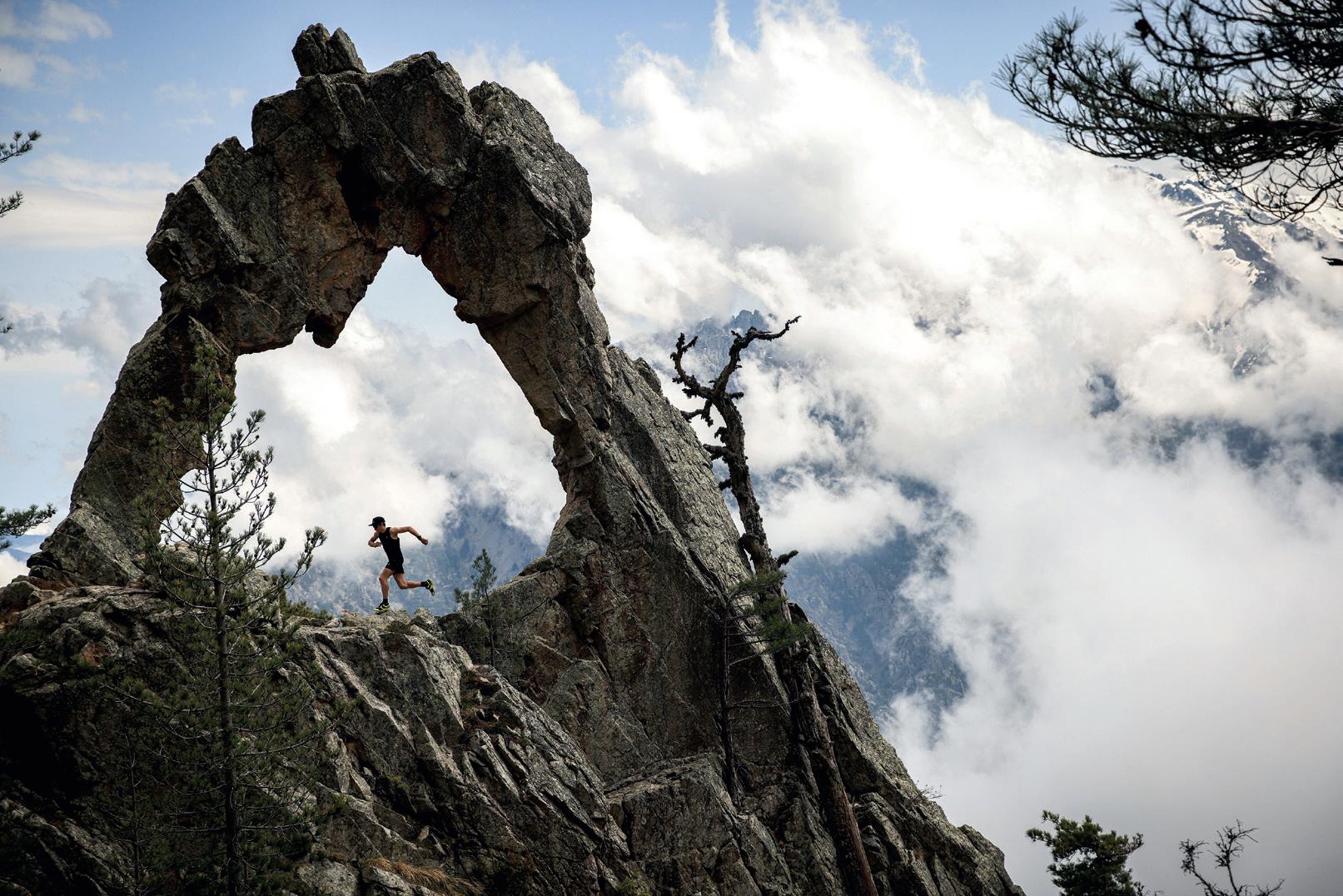
seemed to me the best way to do it, so I decided to undertake this project. What is exactly about? I mean environmental studies. Basically they are scientific studies, but with a more technical point of view and linked both to physical sciences, to economy and to social and human sciences. It deals with studying the environment in its entirety by relating all the things that influence and regulate it. I am specializing in forest management.
I’ve read your post about Réunion where you wrote something like “I realize I'm a stupid privileged person, who can afford to make such a trip having a huge environmental impact just to run a race.” It was an interesting thing said by a professional athlete. Our actions have an impact on the climate and on the weakest societies, I also realize that our lifestyle is harmful: we travel a lot, and above all to places affected by very important difficulties that are not solved by tourism. Every time I take a flight I'm sad and feel guilty, with that post I wanted to apologize, for what it matters. It's a personal belief: I want to be transparent even with those who follow me on social media, the environment is important.
Do you think professional athletes feel under pressure when traveling or are they forced to leave their countries several times a year having an unnecessary impact on the environment? Isn't running supposed to be a clean sport? I guess it's interesting to think about it: it's true, trail running doesn't have a big impact in terms of equipment and gear needed. But the sponsors and organizers encourage athletes to travel a lot, which comes from the desire to participate in the big circuits and be part
of them. This brings numerous advantages both in economic terms and in terms of visibility, and often the brands themselves sponsor these circuits, encouraging their athletes to participate and therefore to travel to very distant places. For many athletes these circuits are the goals of the season. It is difficult to do otherwise when the freedom of athletes to choose what and where to run is reduced. As far as I'm concerned, perhaps because of what I study, I'm very determined and aware of this, but of course this doesn't apply to everyone, and something should be done to increase this awareness.
What goals do you have this year? Do you want to lengthen the distance in Chamonix? I am very attracted to the UTMB, but this year I will be racing L'echappée Belle, which is close to where I live, the following week in Chamonix. During the UTMB weekend I will be the cameraman for the Live Streaming of the race.
That’s interesting. In fact there are several top level athletes who do that, I'm thinking of Seb Chaigneau. May I ask why you do this? It's something I really like, I find it fascinating to see a race like that from the inside, running alongside the lead runners. It's not easy to do because you run fast anyway, and you have to keep the camera straight when filming, it's not automatic.
It is great to see the athletes involved in organizing races. It is not very frequent in Europe but evidently things are changing. How long have you been part of the Odlo X-Alp team and what is it about?
Four years now, in 2020 I had the opportunity to join the French Odlo X-Alp team. It was a great opportunity for me, I would like to invest more of
my time in my professionalization as an athlete. It all started out of a passion, but I'm now becoming a pro and there are a number of ways I would like to do it. In short, I would like to invest more time in the race and in the sport as a whole, as well as wanting to spend more time with the people and sponsors who support me. We recently had a meeting which brought together the Team Odlo X-Alp athletes and the Odlo product and sales teams to discuss product collaboration. It was an interesting moment of discussion, it’s very inspiring to participate in their design process, to be able to share an athlete’s perspective on the future products.
What’s your impression of the Odlo X-Alp trail running apparel? I’ve been wearing the latest Odlo X-Alp trail running collection for over a year. I’ve really put the pieces through their paces on demanding trails and they’re durable, cut well and really comfortable. The X-Alp Performance Wool 115 T-shirt is super light and breathable, the shorts give good muscle support and make you feel more solid on the descent. The impact of being equipped with technical, high-performance apparel should not be overlooked, it helps put me in the best possible position to achieve my goals.
The trail world championships are just over a month away and you're part of the French national team. Will we see you? How far will you run? Yes I'll be there, I'm the youngest in the national team and I should run the long distance, the 80km.
And what is your goal? I would like to live it as an experience, see how it goes and learn from athletes who have more experience than me.
A month later we can say: goal achieved.
83
Sergio & Patagonia Run
BY DENIS PICCOLO
It's the evening of the 2022 World Cup final, I’m in an Argentinian pub downtown. There is a projector showing the match and people are drunk with joy and wine. I start talking to a guy, he doesn't seem like a great sportsman, among the various rantings he asks me what’s my job and we end up talking about races and mountain running. He doesn't know anything about it but he says he has a friend in Argentina who does that kind of thing and that the year before he ran a very famous race, Patagonia Run.
Patagonia Run is such an important event in Patagonia that everyone knows it, even those who don't run, and it has a very large and also local participation. It takes place in April and has six distances, from 10 kilometers to 100 miles, which have allowed it to involve the local population as well as people who don't run, or who practice other outdoor sports. Nonetheless, the level of the competitions is international and the competition is among the most coveted on the continent.
Sergio Gustavo Pereyra is 28 years old, he is Argentinian, and this year he has been racing in the SCARPA team, which in the meantime has expanded its historic family of Spin trail shoes, with the addition of Spin Planet. Sergio is an athlete who, when he
sets himself a goal, knows how to achieve it. Running is in his DNA and to become a professional and be able to devote himself full time to trail running he had to make many sacrifices. He ran from an early age, when he looked after his family's animals in the hills of Costa del Malleo, south of Neuquén, Argentina. At 12 he had already started working: first in a workshop where he cleaned engines, then in the maintenance of parks and houses. Then his family moved to Junín de los Andes: during high school a physical education teacher discovered his skills as a runner, initially on the road. During the day he worked on a construction site, in the evening he trained. There is still a video on Facebook of him pushing a wheelbarrow. “This is another
84
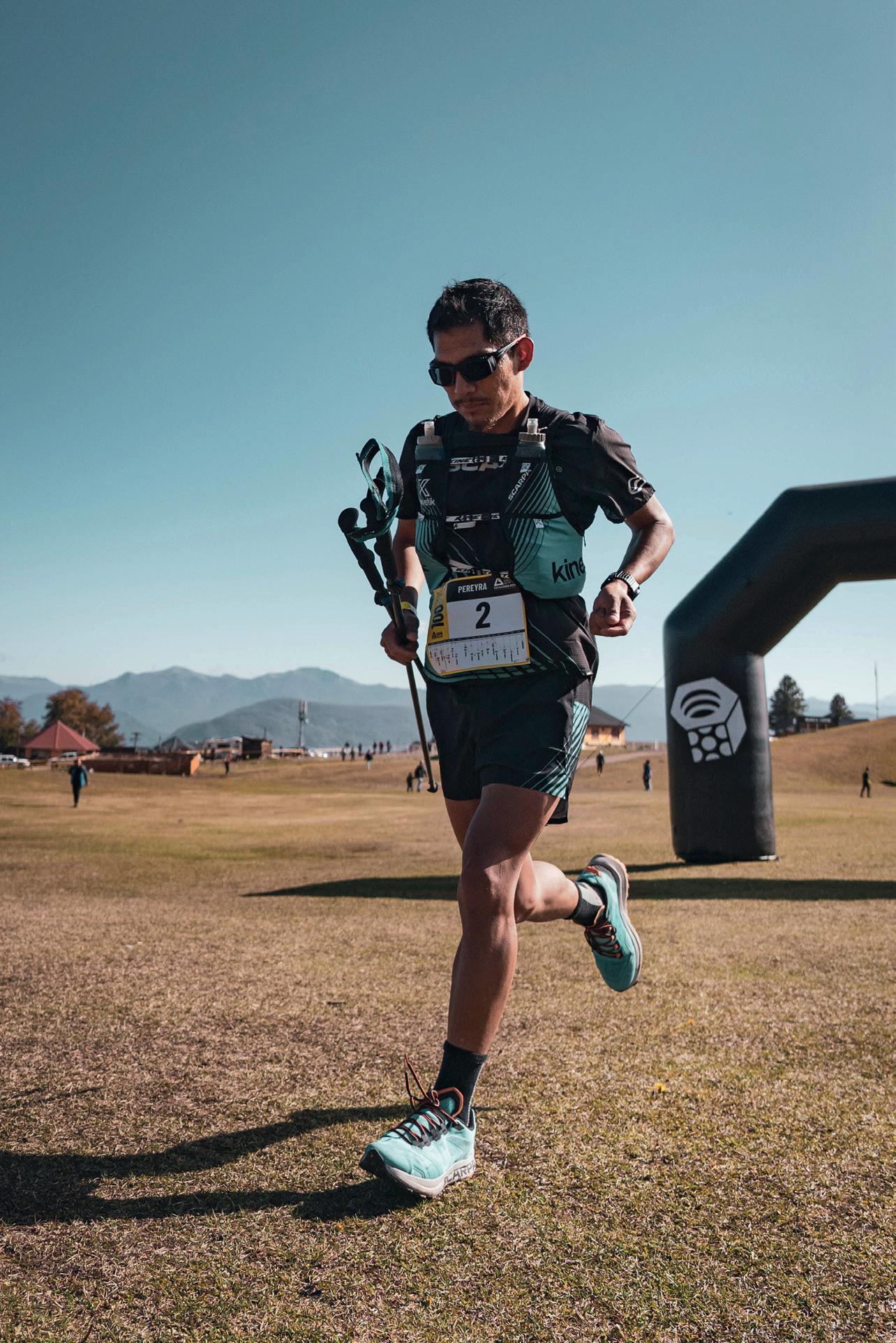
85
speaks his same language, but he's not Argentinian, he's Spanish, his name is Pau Capell and he runs fast: Pau has won several races, but everyone remembers him for one: Ultra Trail du Mont Blanc.
Sergio Pereyra is a fast athlete but Capell is on another level, and finishing behind him, with a second place, would already be a lot. He doesn't think about it. So the race starts, and Sergio starts running.
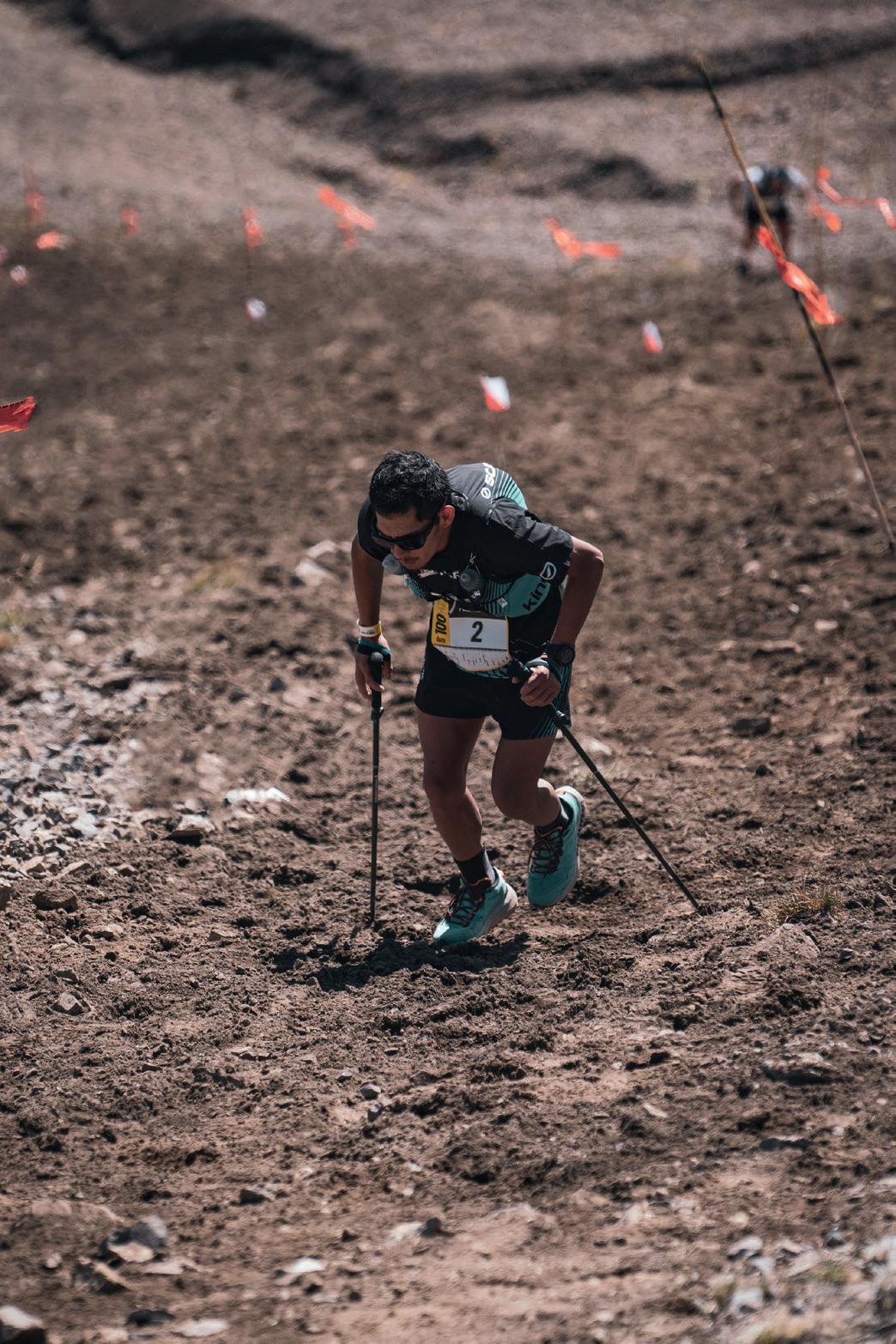
The first kilometers pass by quickly but Pau has another pace. At the eightieth kilometer, halfway through the race, he is 20 minutes behind the leading runnerr. The 100 miles are made up of ups and downs
he no longer looks at Pau as an ultra trail legend, now he is just someone who is running and struggling, and he is running faster. Sergio looks Pau in the face and sees him suffering, and then he goes away.
He crosses the finish line in 19 hours and 25 minutes. It's his first win in an international race, and he is in his home in Argentina. Pau Capell will arrive only 10 minutes later, behind a semi-unknown guy, with a good palmarès but nothing more. Those are the victories that make you dream.
After a LUT gone wrong, Sergio will show up in Place de l'Amitié to run UTMB.
Who knows what he is dreaming of.
86
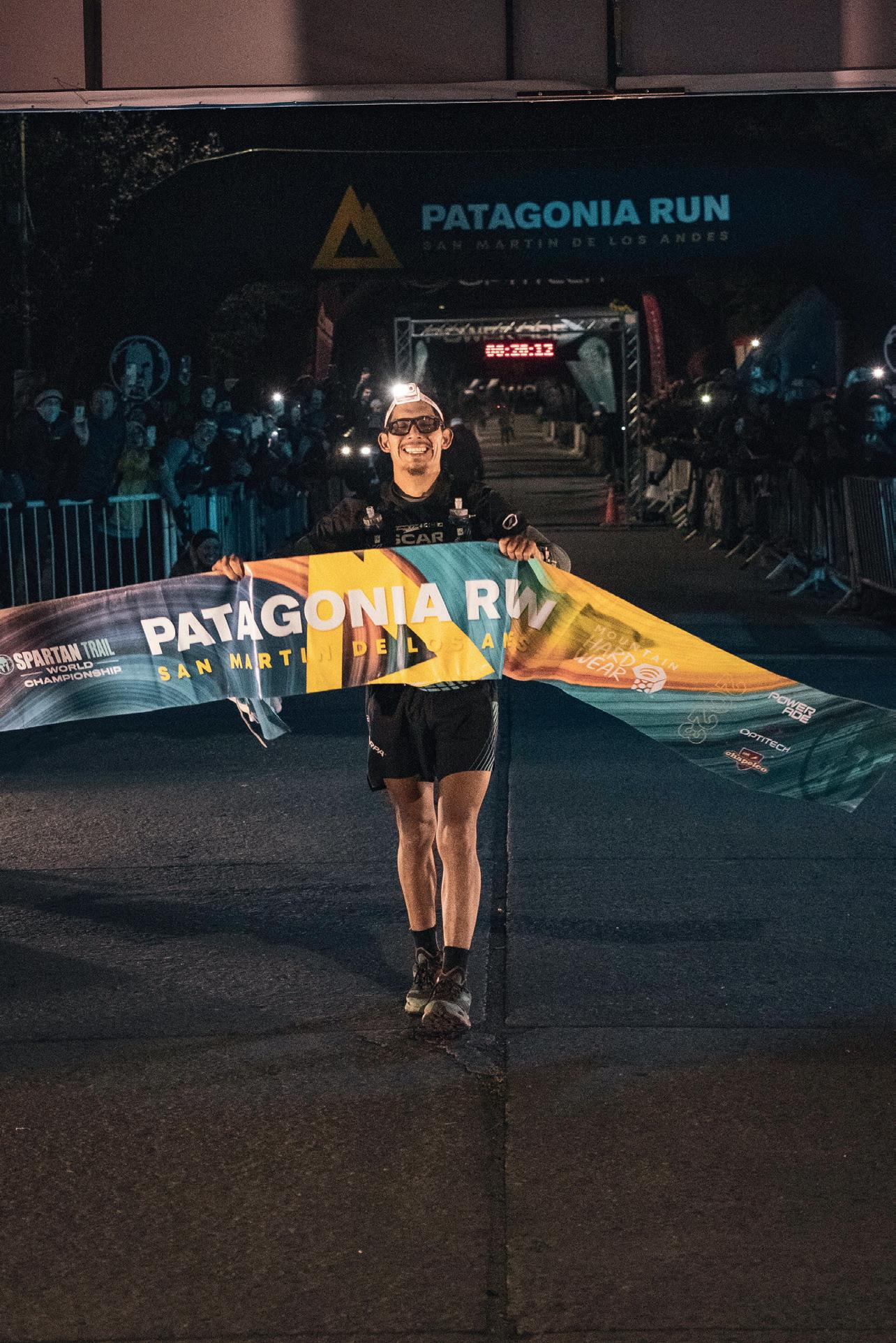
87

Theo Le Boudec
 BY ENRICA GOUTHIER
BY ENRICA GOUTHIER
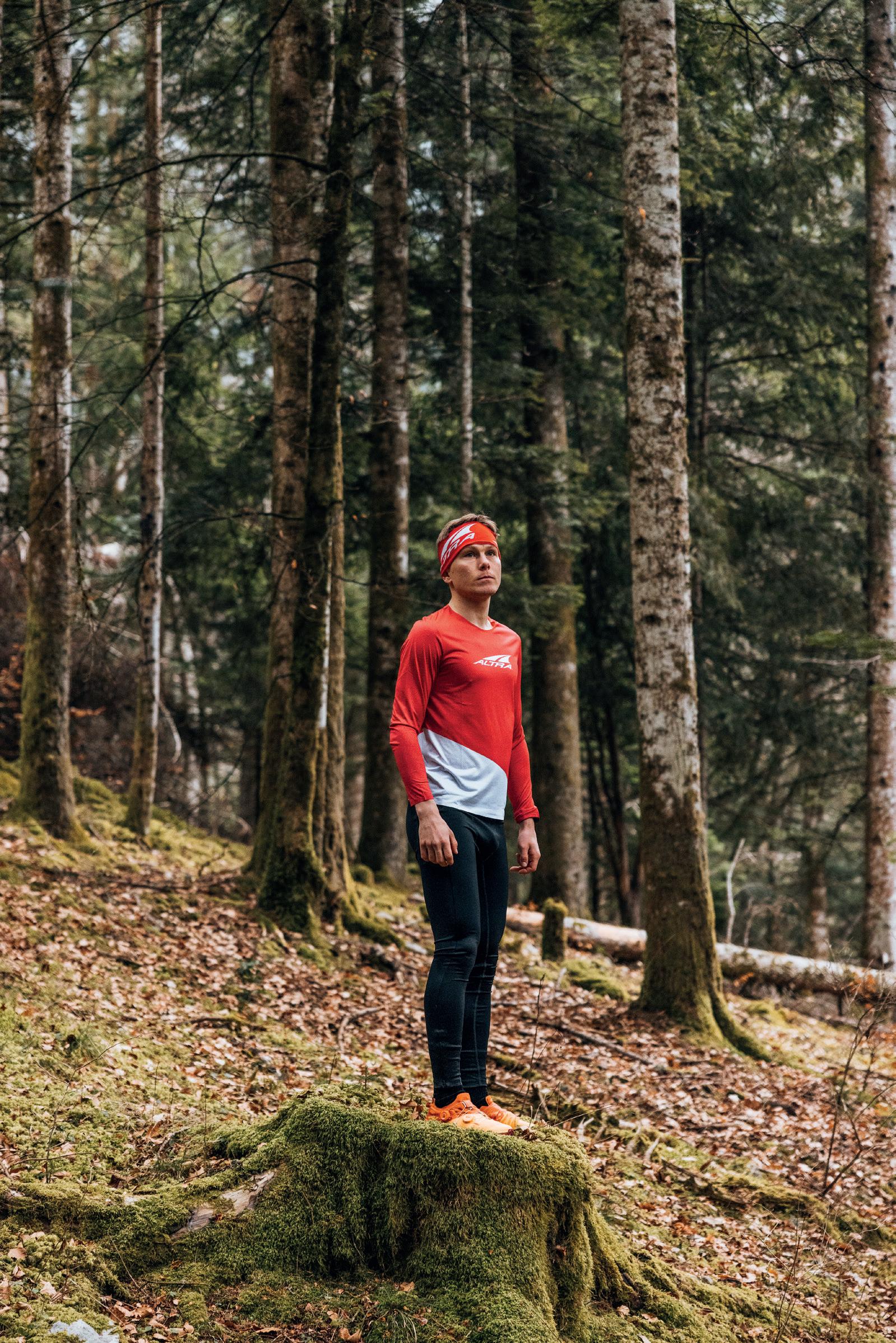
You've been running for four years, how did you start? I started on the treadmill during confinement. I spent my days running in my parents' garage. I wanted to discover a new sport, test myself on an endurance discipline after 12 years of football.
Why long distances? Athletes of your age usually focus more on speed than endurance. I have always enjoyed life in a different way. I was immediately defined by long distances, like Kilian Jornet. He's my idol, I discovered trail running thanks to him. I have stars in my eyes when I watch the UTMB.
How do you feel when you run alone for hours? I feel free! It is this feeling of freedom that makes me happy. I can run where I want and when I want, discover new landscapes, climb mountains. When I run alone I think about my goals, I'm a big dreamer. When I run I have no more limits.
Do you have a coach or do you do all by yourself? I’ve been having a training coach for 1 year now. Christophe Malardé, a former Team Salomon athlete. He is the one who train Francois D’Haene so he has a lot of experience and knows how to handle me. He shares with me both his experience and his wisdom. I needed guidance and Christophe is an important player in the construction of my young career.

You started this year with a great victory in Istria. How was the race? Did you expect this result? I really prepared for this race with the desire to be at the front. My goal was to apply to the UTMB, in Chamonix at the beginning of September. Running alongside Elio Fumo, Christopher Clemente and Harry Jones was just crazy! I felt like a child, I had
chills. That victory was the best of my career. I run the perfect race, I managed to compete with my heart and my head and I proved to myself that I was capable of achieving beautiful things. My year is already successful! Now my dream is to do a good race at the UTMB and to discover a race that has exalted and intrigued me for years.
How long have you been with Altra team? How did you meet them? I have been running in the team since the start of confinement. I joined them after my victory in the Intégrale des Causses in Millau. Altra is now helping me to structure the rest of my career, putting at my disposal what’s necessary so that I can be as efficient as possible. I'm really grateful. The Altra team is doing a fantastic job not just with me but also with the other athletes: our is a very good elite team, it will be fun at the UTMB.
What do you think about Altra’s trail running shoe concept? Altra shoes are innovative and high performing! For me it is the best brand in order to be able to excel on any discipline, from road races to ultrarunning competitions. I especially like the wide toe box because it makes the foot breathe better. Altra shoes allow you to have the most natural running technique possible.
What's your favorite shoe? And which one will you race your next ultra with? My favorite shoe is the Mont Blanc BOA: perfect grip, comfort and great support! I have never felt better with any other shoes. I will run the UTMB with a prototype, but for the moment it's secret! Just wait and see!!
91
I feel free! It is this feeling of freedom that makes me happy. I can run where I want and when I want, discover new landscapes, climb mountains. When I run alone I think about my goals, I'm a big dreamer. When I run I have no more limits.
Anton Krupicka and the bell tower of Cortina, 9 years later
BY LISA MISCONEL
I don't know anything about ultrarunning. I mean real ultrarunning, the one of the past with its people and the scenario in which it spread. But I'm also quite comfortable thinking that I'm not alone, we must recognize that it is not an intrinsic discipline in our territories or at least it is not in a historically or culturally way. I like to think that the reader doesn't necessarily have to always have some basic knowledge at the start but that he can learn from reading.


In the same way, every person we meet on our journey can teach us something and so it happened for me once again, in Cortina. The LUT week is a summer story that has something magical about it: athletes from all over the world run together at 7 in the morning, yellow flags are hung in Corso Italia up to that finish line that awaits all the enthusiasts at the end of the 20, 50, 80 or 120 kilometers race. I also met Harald there, a German journalist who, even before opening his mouth, already made you understand that he has been around for some time in the ultrarunning scene. You can see from the bracelets he proudly wears on his left wrist that he has been taking part in some icons races like Tor des Geants and UTMB more than once. A veil of nostalgia covers his stories about ultrarunning, remembering how it used to be, the calm, the silence before the crowds. This gave me the key to discreetly allowing myself to speak with Anton, starting from the bottom and knowing inside me that if I didn't have the role of spokesperson, I wouldn't have deserved that conversation at all.
Anton Krupicka probably needs no introduction, but let’s leave that probably with a question mark. I asked him to tell how he would like to be known and what he wants to be remembered for but above all who he is today and why he reached the Dolomites despite not competing. His blue eyes flick as he searches for the words to express his thoughts, and his hair no longer touches his shoulders now that he's cut it.
My first question is also the hardest: what would you like people to think of you, who are you really? He answered me with another question. "What do you like to do?"
So I thought of starting from the particular to then get to the general.
Why did you travel here from the States even if you don't compete? Hahaha. So you're wondering why I'm here? Well, I feel that I am getting old, I am 39 years old. I ran
this race in 2014 and won it, I was 30 years old. I'm at a point in my life where I'm curious to understand why I'm still somehow relevant in the sport: I've been racing ultras since 2006, so what time has passed, seventeen years? The reason I'm here today is that I love the mountains... And to go running. Ten years ago I was very competitive and wanted and won races, now I'm not as fast as ten years ago. I did a 100 miles race two years ago, I'm still fine but I don't need it anymore for my ego, I'm more comfortable with myself so I don't need to be validated by a result anymore. I will always be passionate about the mountains and I do a little bit of everything even if I don't excel at anything, hahaha. But running, skiing, climbing, hiking… That will always be important to me. However, I am known in the running community and therefore I feel an obligation to give back what that community has given me previously. That's why I keep going to events like this, to meet people. What always fascinates me is the concept of human performance and overcoming challenges by men, to find something within yourself.
Which is also why you started running and continued to compete? Yes, I did it out of curiosity. I remember when I was very young, even doing a marathon at 12 years old was one of the reason I started running ultras: I wondered if I would make it. Then over time it started to be about racing, beating other people, trying to be the best for a certain amount of time. I think you can't compete at the top level without a certain amount of ego to prove you’re worth in some way.
And when did you decide to stop racing? That happened because of a couple of things: first of all I kept getting injured and therefore I couldn't race for long periods. There were a few years before the pandemic where I couldn't race at all. For a couple of years I was a bit bitter about this sport, as if running didn't want me and therefore I didn't want
94

anything to do with it. But then you mature and understand that sport itself is enough, you don't need competitive results...
Did you live the typical life of an athlete, made up of training, diets and rules? I've never been so strict. I've always tried more than anything else to stay in touch with my passion. I've never been on a strict schedule or had a coach. The competitive result has never been the main goal, but rather the passion for the mountains.
What's the best part about this race? What is it worth coming here for? For me it is the intrinsic passion in Italian culture. Italians are very warm and welcoming, unlike France, for example. It is a peaceful and relaxed environment, but the organization of the race is of a high quality and the region with its Dolomites and landscape are beautiful and spectacular. Sure, it's different than what's in the US, but they're different things. If you want the challenge and high quality organization of a race like the UTMB, but without the huge hype around it, then Lavaredo is a great race.
What is the biggest difference between the European ultra community and the US one? I'm trying to think of a race in the States that starts and ends in front of a church in the town square, hahaha! First: there are no squares in the United States. You cannot occupy a city the same way you can here. Land in the United States is regulated, the government owns a lot of land, and citizens own a lot of private land. As a result there are restrictions on the number of people who can attend an event, for example I don't know how many people run the 20km here, maybe a thousand? In the United States you can max out at 500 people, but usually it's 200 or 300. It's a limited thing with a limited number. So the feeling is different, it's more intimate, there's not as big a crowd. It's a little more relaxed, I think. Here it is as if people, even in the crowd in the race, are looking for a result. In America, on the other hand, you race
for the result in the front rows perhaps, but nobody cares about anything in the middle of the pack.
So, let's go back to the beginning. What would you like people to think and know about you? That's a tough question, really! The only thing I would them like to say is that I was a person who was at the top of the sport a decade ago, but I think that anyone should be allowed to change and evolve and grow. I still see people surprised when I run in heavier shoes, for example. Sure, there was a time when I wore very minimal shoes, but my goodness! We are talking about ten, fifteen years ago. People change and that should be fine, you have to expect it and allow people to change.
But you are still very popular! Maybe it's because people have come to realize your true worth that goes way beyond the race. I appreciate you saying that, but it will always be a mystery to me. I've never understood why I have this sort of popularity… I mean, I've won a few races. I've always been who I am and I think this is part of the evolution of not racing anymore. I still do a couple of races a year, but maybe people can tell when someone is faking or forcing, and I try not to and maybe people see it and appreciate it.
And now? What about cycling? Cycling was born for me as a means to recover from injuries and to continue running, even if less frequently, I like cycling but above all when combined with running. Now I want to go back to Colorado because the summer season is starting there, the snow on the mountains is melting and I want to go on a big bike trip where I ride the mountains along the way… That is definitely what I like to do at the moment. Camping, cycling, running in the mountains if there are any along the way. It's more of a lifestyle, a challenge that interests me much more than the single focus on running.
96


Millet Up for Anything
Trail running made in France
 BY DAVIDE FIORASO PHOTOS MATT GEORGES
BY DAVIDE FIORASO PHOTOS MATT GEORGES
Speed up the pace, free movement, advance unhindered on curvy terrain. Spring Summer 2023 sees the entry of a new player into the world of trail running: we’re talking about Millet, which has been at the side of those who live the mountains for over 100 years. Today Millet wants to continue to be one of the reference brands of the vertical community, it wants to continue collaborating with mountain guides, expeditions and outdoor professionals, but it must align itself with the changing times, evolve together with the mountain. A mountain that changes day after day.
“Millet means mountain and the mountain is changing, compared to the one we knew twenty years ago [...]. You know what made us think we should move to the trail running world too? I had the opportunity to participate in a conference about climate change. There were climatologists, writers, scientists. At one point someone wanted
to tell a story. It was the year 2075 and a young mountain guide from Chamonix spoke to his father. When the father asked what he was going to do that morning, the son replied that he had clients and that he was going to Bossons to do some trail running. And the father replied: «But how do you get customers to run on the Bossons Glacier?» And the son simply replied: "But dad, there are no more glaciers.”
The reputation of Millet has always been inextricably linked to the mountaineering world. But its history, its long tradition and its know-how set no limits in the development of any product dedicated to outdoor sports. As it has been for ski mountaineering, trail running represents a natural evolution. Today the new generations interact with the mountains in a different way, and Millet wants to be with them, to play a role in all of this. A great reason for growth, capable of projecting the brand forward over time. Here then

100
are two collections making room on the market that will be the beginning of a great job, which Millet intends to carry on and grow over the years.
Let’s start from the Trilogy Sky, a collection of essential, very technical garments, dedicated to sky running and to those who are looking for equipment with a truly minimal weight/size ratio. Faithful to its mantra, Millet accompanies with this line athletes and enthusiasts of sky running and "fast & light" mountaineering, eager to evolve on the edge of the ridges, in the purest sense of mountain running, scrambling, expressions of that limit in which it is no longer possible to use only feet and legs, but where, in order to climb, you also need the help of hands. As a long-standing leader in the production of mountain backpacks, these will be the focal point of a strategy that sees the Sky Vest as the flagship model. Accompanying them are


a limited number of extremely high performing clothing and the support of athletes Sandra Sevillano, Ikram Rashalla and Sebastien Guichardaz, protagonists of the Up For Anything campaign.
Much broader, and declined to a more classic conception of this sport, is the Intense series, designed for traditional and less extreme trail running. A line that also wants to offer itself to fast hiking to arrive, by spring 2024, at a much more complete collection dedicated to an even wider public. To launch this brand’s new range, which is primarily based on backpacks, vests and belts, it took two years of development with the collaboration of the Sidas Matryx team, a young and ambitious team made up of some of the most talented elite athletes in France. The collection includes essential clothing items to form highly resistant, reliable and adaptable complete outfits.
101
“Adapting to the unexpected, to what you will encounter during the tour. Regardless of radically changing weather conditions or a different terrain configuration than you had anticipated, Millet's products in the new Trail Running range will never leave you alone on the road. Their durability and versatility are fundamentally intrinsic into their design. You will be ready to face any eventuality. Go find your spontaneity!”
Great news, as well as part of this Intense collection, the first Millet footwear line for trail running. Ideal for short distances, they have the peculiarity of being entirely produced in France, in a combination of transalpine excellence: the famous Matryx fabric, the Michelin soles and the Advanced Shoe Factory 4.0 by Ardoix. A curiosity? Millet is one of the investors who have bet on this cutting-edge plant managed by the Chamatex group, manufacturer of the same Matryx fabric. Just a couple of hours away from the Annecy headquar-
ters, ASF 4.0 is a facility, recently inaugurated, capable of producing footwear using artificial intelligence. The aim is to create an automated sports shoe manufacturing hub and leverage the benefits of local manufacturing. First of all there is a simplified logistics which will allow for greater speed of placing on the market and greater responsiveness to local needs. Secondly, greater flexibility in product line development, allowing for the testing of new models that could be produced in lower volumes. Finally, a production that minimizes the CO2 impact associated with shipments. A short supply chain completely in line with the brand's social and environmental approach.
“We want to enter the world of trail running humbly, without losing our identity, the one that reveals our true soul, the one of a mountain brand. By committing ourselves to working our materials in the best possible way even in the clothing sector, to always
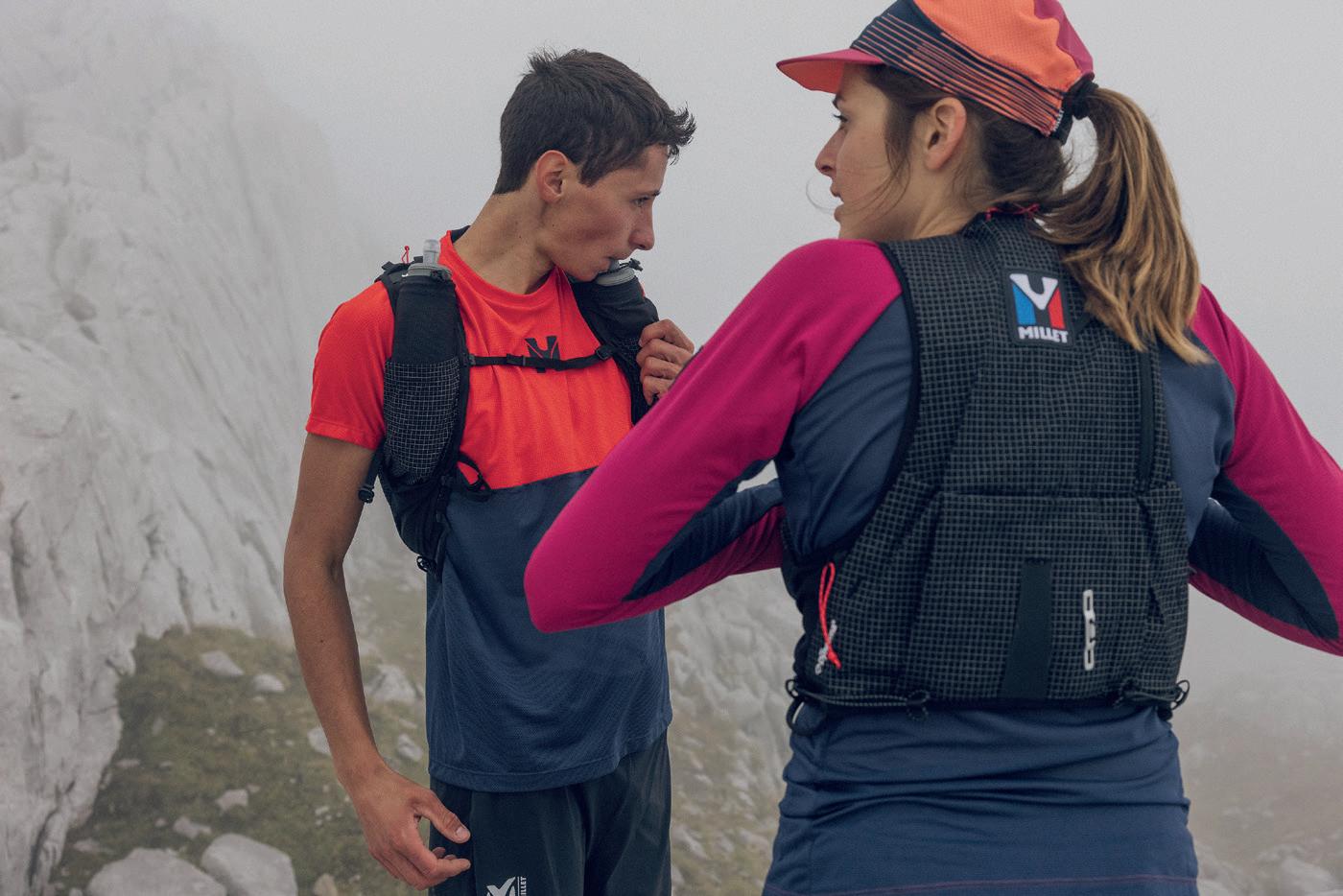
102
give an offer of the highest technical and qualitative level. In specific footwear there is still a lot of work to do, we know this and for this reason we started right from the backpacks, our flagship product.” Frédéric Fages,
Global Millet Brand Manager
A worthy conclusion, as a further element that demonstrates the brand's interest in this discipline, is the partnership with the ISF International Sky Running Federation. The next step for 2023 is the sponsorship of the first Masters Skyrunning World Championships to be held on July 30 at the Royal Ultra SkyMarathon in Ceresole Reale (Italy). A collaboration that will expand in 2024, once again reaffirming the vertical DNA of the company and the image it wants to be linked to.
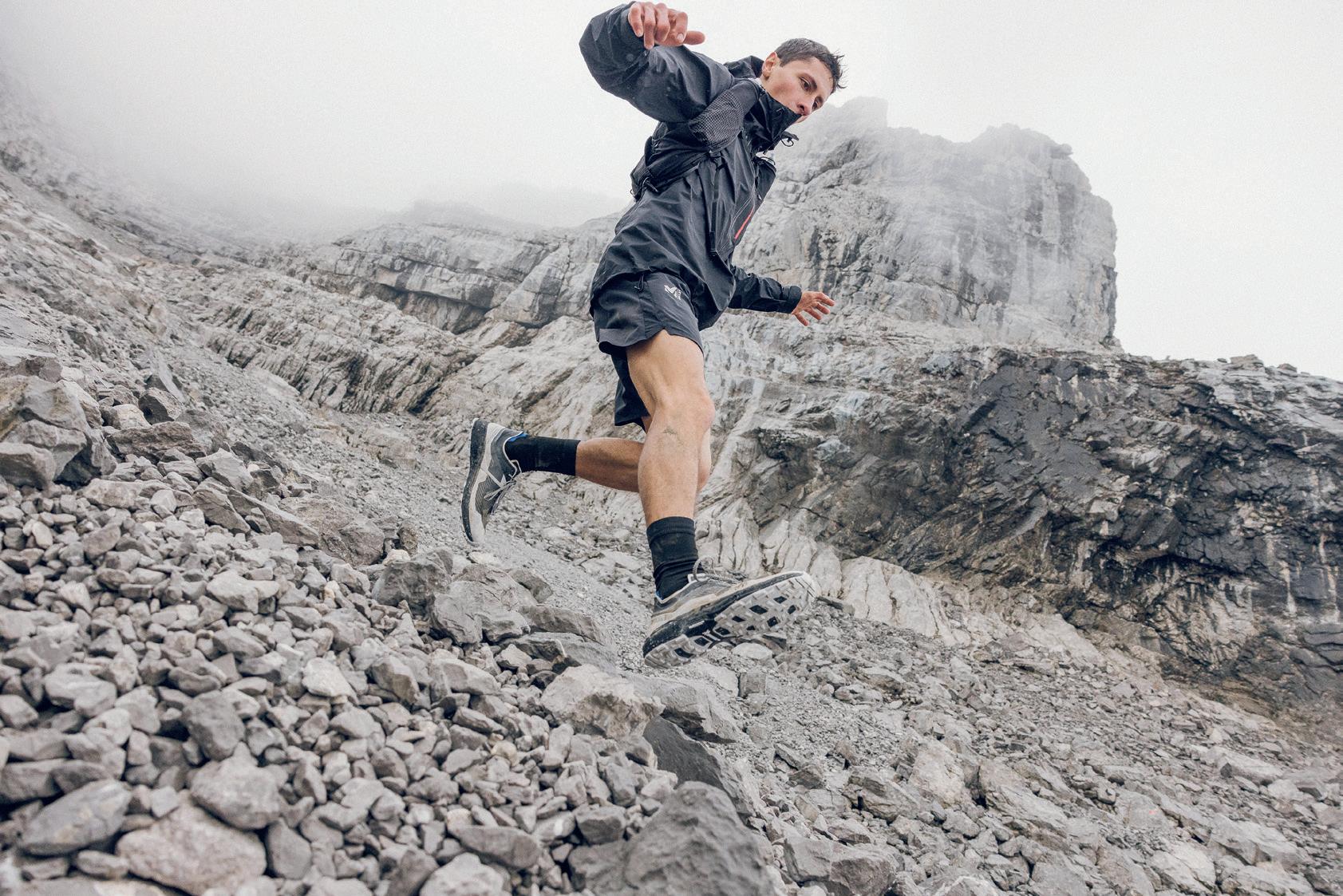
103
We want to enter the world of trail running humbly, without losing our identity, the one that reveals our true soul, the one of a mountain brand. By committing ourselves to working our materials in the best possible way even in the clothing sector, to always give an offer of the highest technical and qualitative level.
Sciacche Trail Of lands of vineyards and corsairs
BY FILIPPO CAON PHOTOS MARCO MANNONI
Andrea is an agronomist and arriving in Monterosso he is keen to underline it: «If someone gave me a vineyard around here, I don't know if I would accept it». Beyond the picturesque appearance of the seaside villages, Cinque Terre is a hostile and inhospitable place.
We are still high up, 500 meters above sea level, and going down the road that leads from Levanto to Monterosso we cross abandoned vineyards and decaying dry stone walls. It's late March and spring has already advanced, and the wood, which looks more like a forest, invades a good part of the road. The road that connects Levanto to La Spezia was only built in the 1960s, before that people moved by train: the coastal railway dates back to the 1870s, connecting Cinque Terre to the rest of the world for the first time, until shortly before closed by the mountains on one side and by the sea on the other one.
Historically, the first towns stood higher than the coast, which until 1300 was dangerous due to attacks by Sara-
cens and corsairs. Enzo, once mayor of Vernazza, tells us that Volastra, which today can be reached via a grueling staircase that ascends the vineyards for a 330-metre drop, is actually older than Manarola, which instead overlooks the sea, and which was only built when the high country dwellers began to come down from the mountains. Contrary to what one might imagine, the history of Cinque Terre is not a sea story, so much so that some towns, such as Corniglia, don't even have a pier. The history of Cinque Terre has to do with the land and with agriculture. Then, with the explosion of tourism, Cinque Terre were gradually abandoned, the houses were transformed into second homes, and the terraces were gradually abandoned too. Sciacchetrà, the traditional local sweet wine, and its thousand-year-old vineyard have become mostly niche products, unable to keep up with a market that requires more and more quantities. But here, where the vineyards cling to nothing and overlook the sea, and where cultivation requires effort and sweat, quantity is not a choice. Today Cinque Terre are abandoned on the one hand and overpopulated on the other, as indeed happens to all places invaded by mass tourism.
The day after the race we find ourselves in the castle of Riomaggiore, the easternmost of Cinque Terre, at the presentation of the new race that the SciaccheTrail organization will introduce starting from 2024. We’re here to hear the news about the race but the presentation turns into a local debate on tourism, between the mayor, the population, institutions and anthropologists, while the only athletes present are Andrea and I. It is at that point that I understand how much SciaccheTrail has become an important event not only for the Italian trail running scene, but also for the life of the place.
I’ve met Nic and Chri, indirectly, a few years ago. He's from Manarola, she's from Duluth, Minnesota. Nic is like his land and speaks freely, while she is more quiet. SciaccheTrail was born from their desire (not only theirs) to tell about Cinque Terre in a different way from the classic Grand Tour postcard. The race begins in Monterosso, the westernmost of the Cinque Terre, and climbs towards the mountains, on the Alta via. The area has a very ancient trail network, roughly divided into three parts: an upper part that passes along the edge of the ridge, one along the hillside, and finally a lower one,
104
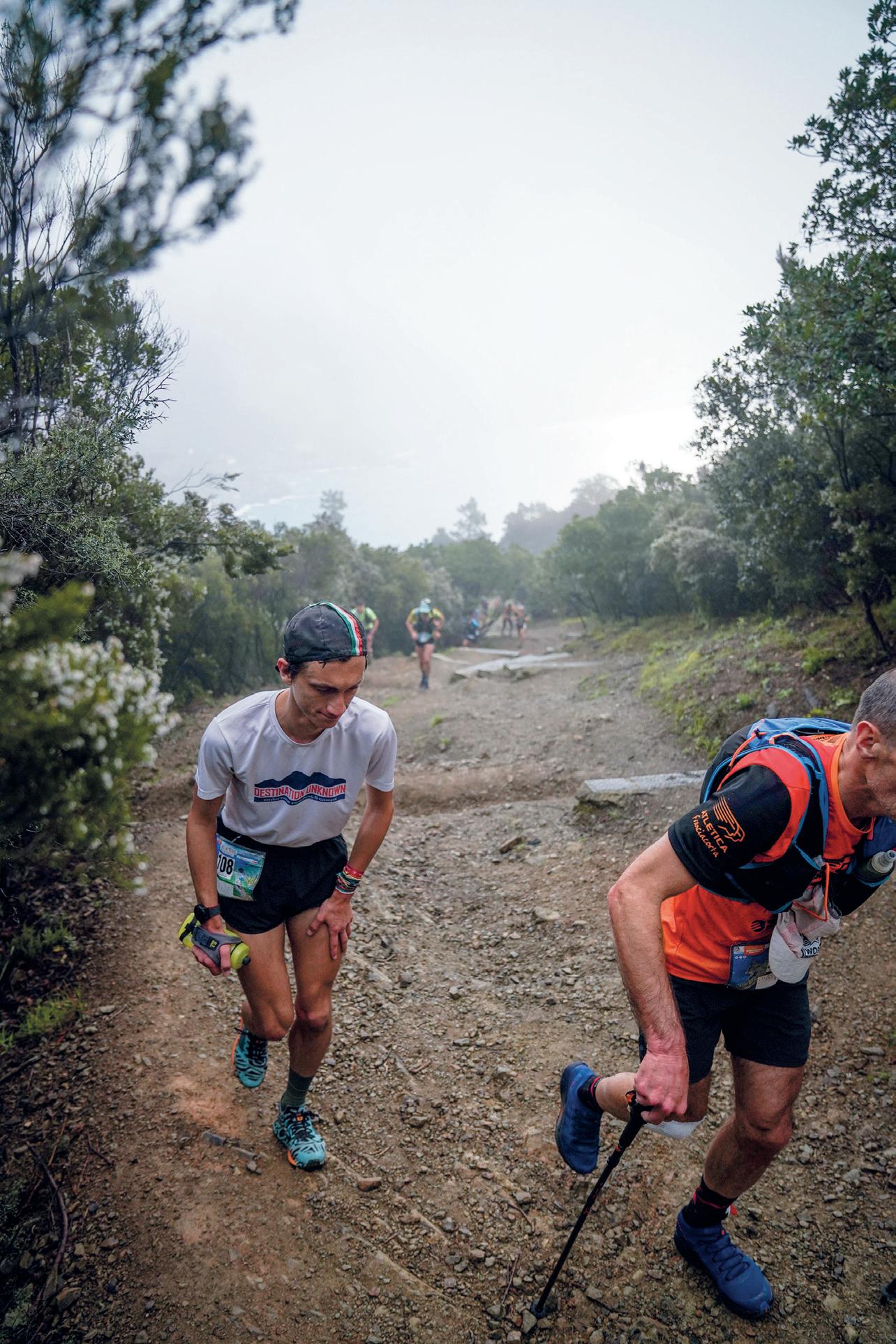
105
which crosses the vineyards and connects the villages on the coast. From the crest, the least frequented area, you can see the sea on one side and the hinterland on the other, and the towns of Pignone and Riccò. The history of the hinterland is linked to Cinque Terre by a seasonal migration that led to the sea during the harvest period, while today, these villages suffer from the same disease that all Italian mid-mountain areas suffer from: depopulation and isolation. That’s why the SciaccheTrail organization has decided to create a new 100k race, to bring attention here too, away from the traditional tourist markers. But for the moment, the race course still passes high up, on the crest that divides that world, covered by mountains, from the one on the coast, instead all too visible.
It is a very practicable stretch, and once you gain altitude you travel through wide forest and soft single tracks surrounded by tropical vegetation. The first kilometers are shrouded in fog and the atmosphere is reminiscent of the previous year's snowfall, except that now it's hot and we are dripping with sweat. It's a very long section, about 20 kilometers, but it goes on by quickly. Then the path bends to the right and throws itself headlong towards the sea, and glides over Riomaggiore, the easternmost of Cinque Terre. Although the upper part is panoramic and uncrowded, the real SciaccheTrail begins in the lower part, which goes from Riomaggiore back to Monterosso. Once back above sea level, the path that leads from Riomaggiore back to Monterosso through the villages along the coast is punctuated by four grueling climbs that from each of the Terre go up the promontories that divide them. These are very popular paths, mostly by groups of German and American hikers, so much so that the Cinque Terre National Park had to impose a ticket on some sectors, especially the easier ones. Running on these paths without being blocked by the crowds that usually invade them is a rare experience: Cinque Terre are like Venice, same
mechanisms, same turnout. Since May, the railway stations have been busier than Rialto, the smell of fried food pervades the alleys, and the villages are filled with a single mass of people who move according to the principles of the law of fluids. The panoramic trails, such as Via dell'Amore, become endless single lines, so much so that the Park, in addition to the toll booth, has also imposed the one-way street on us: there is no autogrill, or maybe there is that too.
Passing through the race there is some movement, but at the end of March it is still a lovely town. After Riomaggiore, the first stairway, which climbs the promontory that divides it from Manarola, runs vertically through terraced vineyards. There are 250 meters in altitude in 500 linear meters of steps. But it is the second stairway, which leads from Manarola to Volastra, that makes the difference, making Volastra the most hated village in the world because the climb is so deadly. In the following 6 kilometres, I slow down and I am overtaken by three people finishing in ninth position, I eat the last gel, I drink and after a while I recover, but I’ve lost some time. In Corniglia I finally start pushing again, then up and down again in Vernazza. From here, I take the last, infamous, stairway. Every time it seems to finish, it starts to climb again, then the path bends to the left and returns following the slope of the coast, from which you can finally see the town and the finish line. I enter the village, go behind the town hall and head towards the beach. On the seafront I realize that everyone is looking in the opposite direction to mine: I took the wrong road, I crossed the finish line, I throw myself on the ground. I just lay there for a while, like I usually do on the finish lines. Then I manage to get up and crawl to a table to eat something. It's hot and sunny and I take off my shirt, I'm so thirsty. I ask a girl to get me a beer, she is waiting for someone but she replies yes.
A September of two years ago we re-
ceived a message from Nic inviting us to SciaccheTrail for the following April. We should have spent the winter pounding mud in the countryside and then come to Liguria to sunbathe, swim and run in a tank top. None of this happened: that "we" had become "I", and I didn't even compete in one of countryside races. Then, when we went to Sciacche, waiting for us instead of the beaches we found rain, wind and snow. At the start it was raining sideways, against the wind, and a little higher up it was snowing: the race was suspended, we returned by train and spent the afternoon drinking wine with friends. I had an open account with Sciacche: I wanted its atmosphere, and the sun, the heat and dehydration. The first glimmer of summer, when the peaks of Trento are still white but it already feels like August there. A weekend to share a good time with good friends. Now I'm here. After the race we stay near the finish tent to eat and drink beers and sunbathe, shirtless, waiting for friends who are still running and talking about something and nothing at the same time. I remember once again why I practice this sport and why I run few races, because only some of them are like this. Schiacce has become the moment that divides my winters from my springs, and when it starts to rain in October, even if it rains in May by now, you look at your phone and wait for that message. I don't know what I'll do next year, maybe I'll come back to volunteer, but one thing is certain: Cinque Terre is hostile and inhospitable land, and damned harsh, but, thinking about it, if someone gave me a vineyard around here, I probably would accept it.
One
106
thing is certain: Cinque Terre is hostile and inhospitable land, and damned harsh, but, thinking about it, if someone gave me a vineyard around here, I probably would accept it.
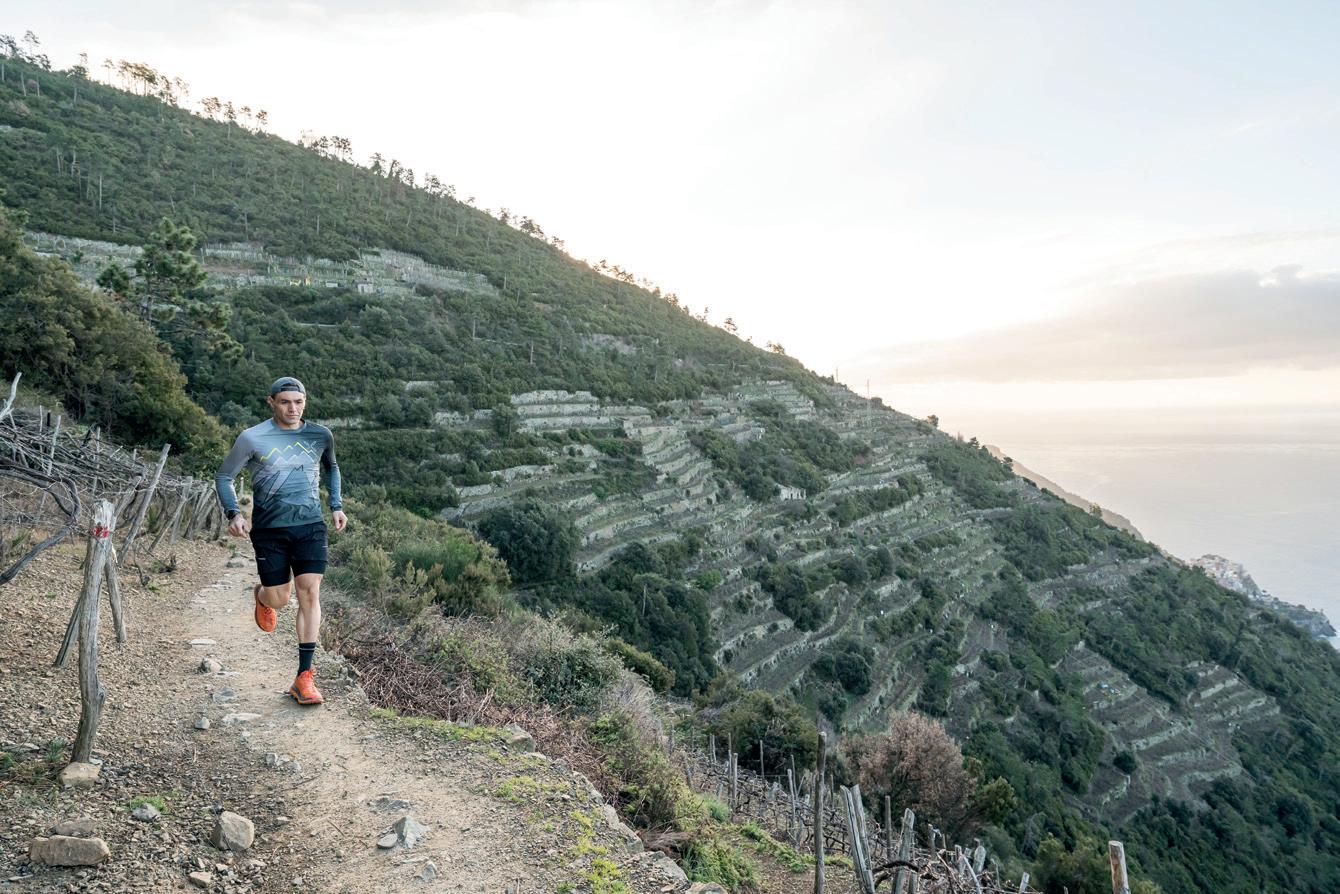
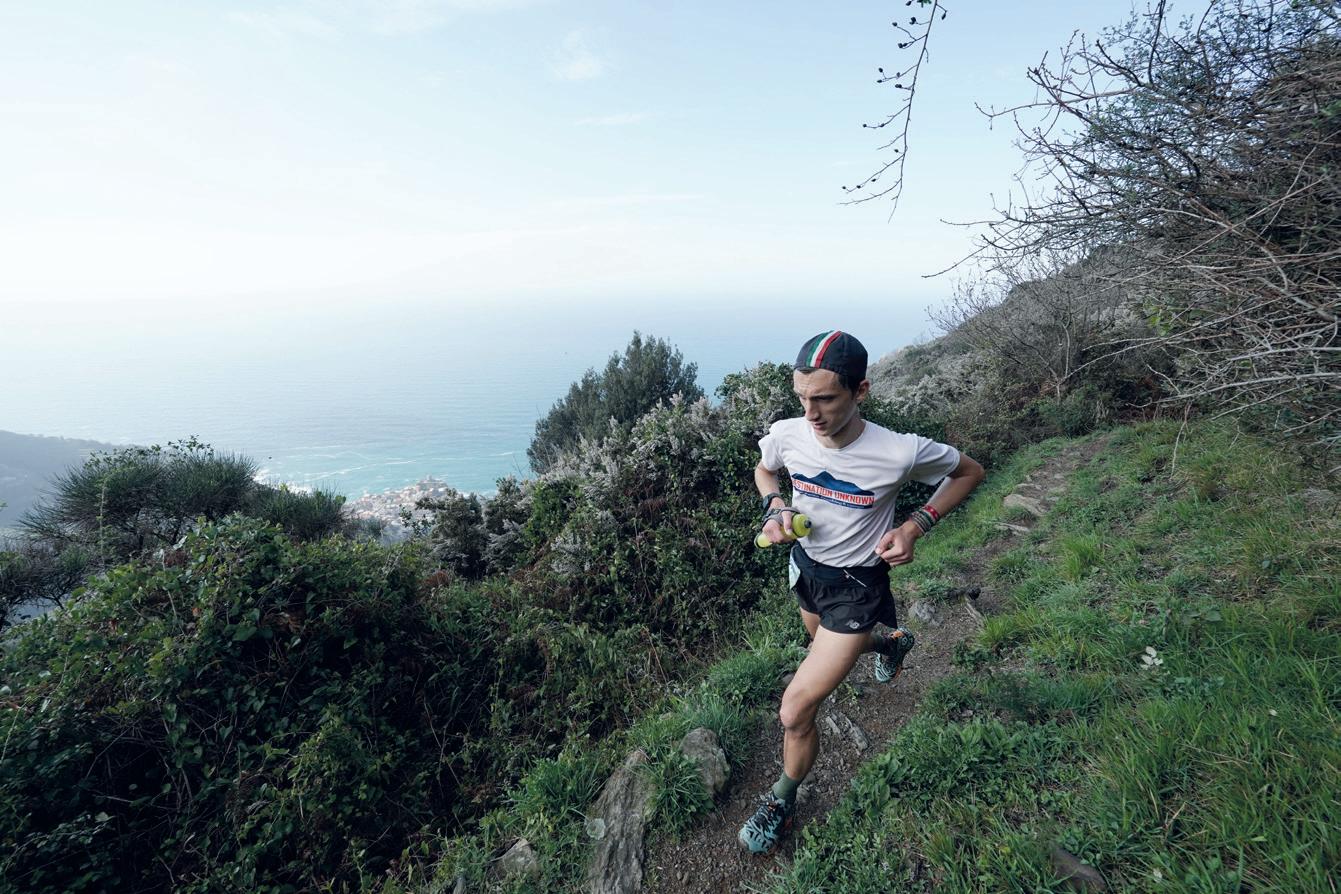
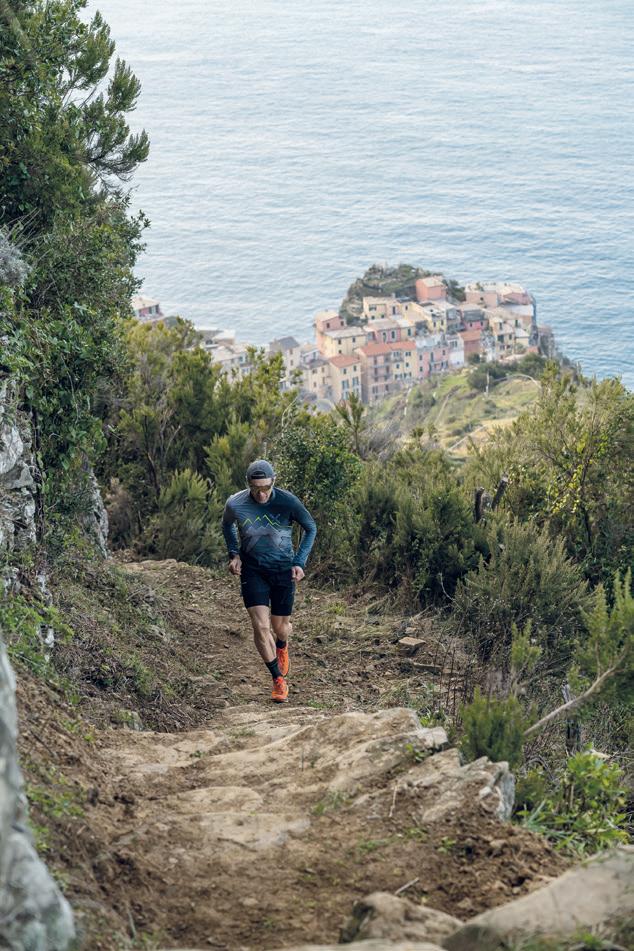
107
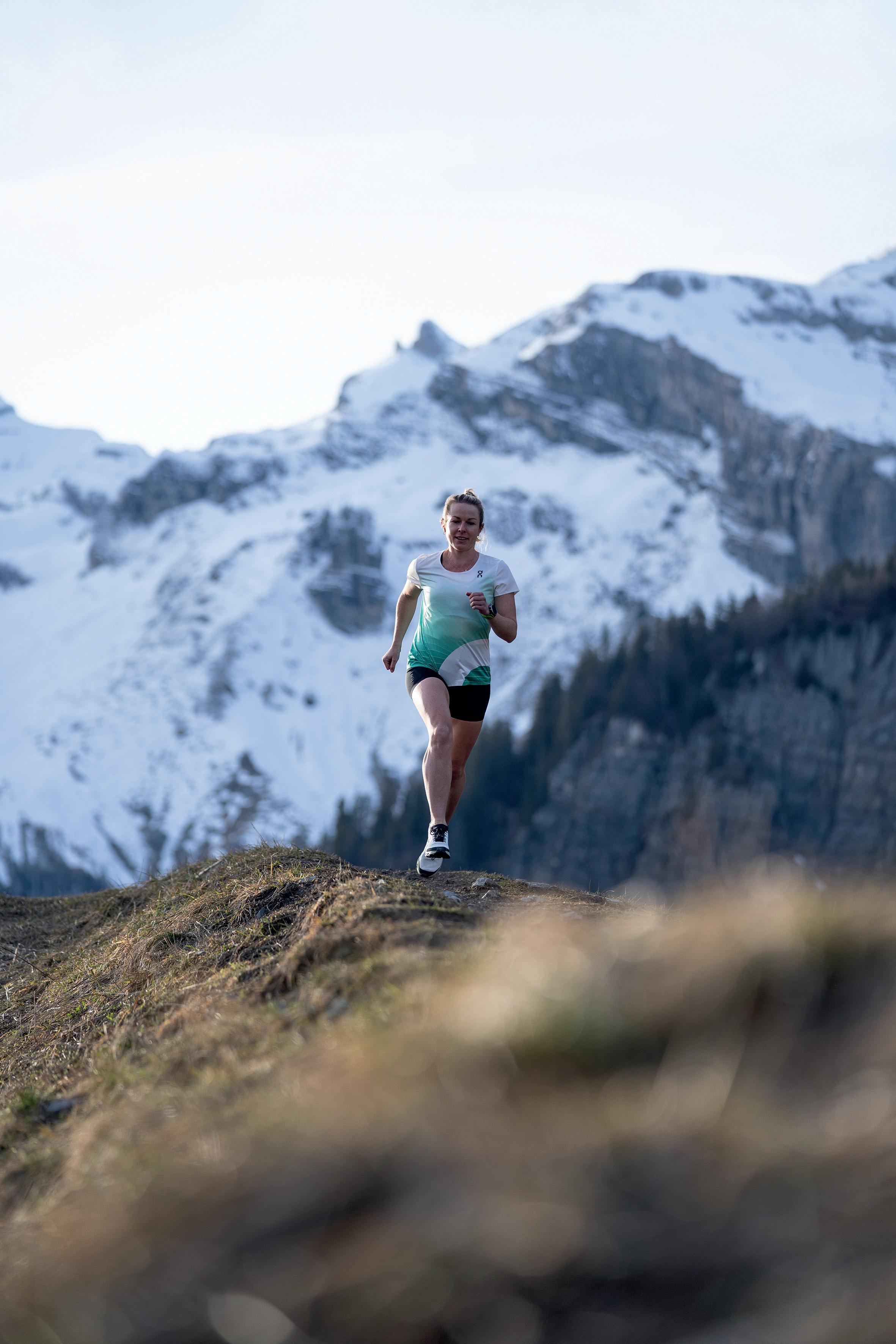
Meg Mackenzie
BY FILIPPO CAON PHOTOS JACK HOLLAND
Meg Mackenzie: South African, 37 years old. If you want to know what races she has done, go to her ITRA page, or to her UTMB athlete profile. I want to use these pages for something else, for things more important than results. The only thing I can say to present her is that the recording of this interview is one of the few ones that I have kept even after having transcribed it. 40 minutes well invested, from a human point of view, and I'm happy to have met her. Let’s leave the rest to her.
Is there still snow in Chamonix? Not so much, there is a little higher up, but not enough to ski. You can run smoothly. There is probably more snow on the Italian side. But on the southern part and on the French side the trails are clean.
How did you arrive in Chamonix? I was born in South Africa where I have lived most of my life, when I started running competitively I had a local contract with Salomon, and then I switched to Salomon International. I started traveling a lot, mainly for the Golden Trail Series and the World Championships, so I started visiting Chamonix more and more, in the summer, until I started thinking that maybe it could become my home, and I star-
ted putting all my emotions and thoughts into this: move here and bring my life here.
I always wonder what it's like to live in Chamonix. Now I go there every year, but always during the UTMB week, which is obviously beautiful for those who run. But then I wonder what the rest of the time is like. Are there any racing groups? Are there any clubs? Are there places to meet? I mean, Flagstaff has Mother Road, Boulder has Trident. Ok, in Chamonix there’s Big Mountain, but what is it like to live there? That’s an interesting question, also because this is a time of change. Obviously it is a place more associated with mountaineering and skiing, but with climate change
109
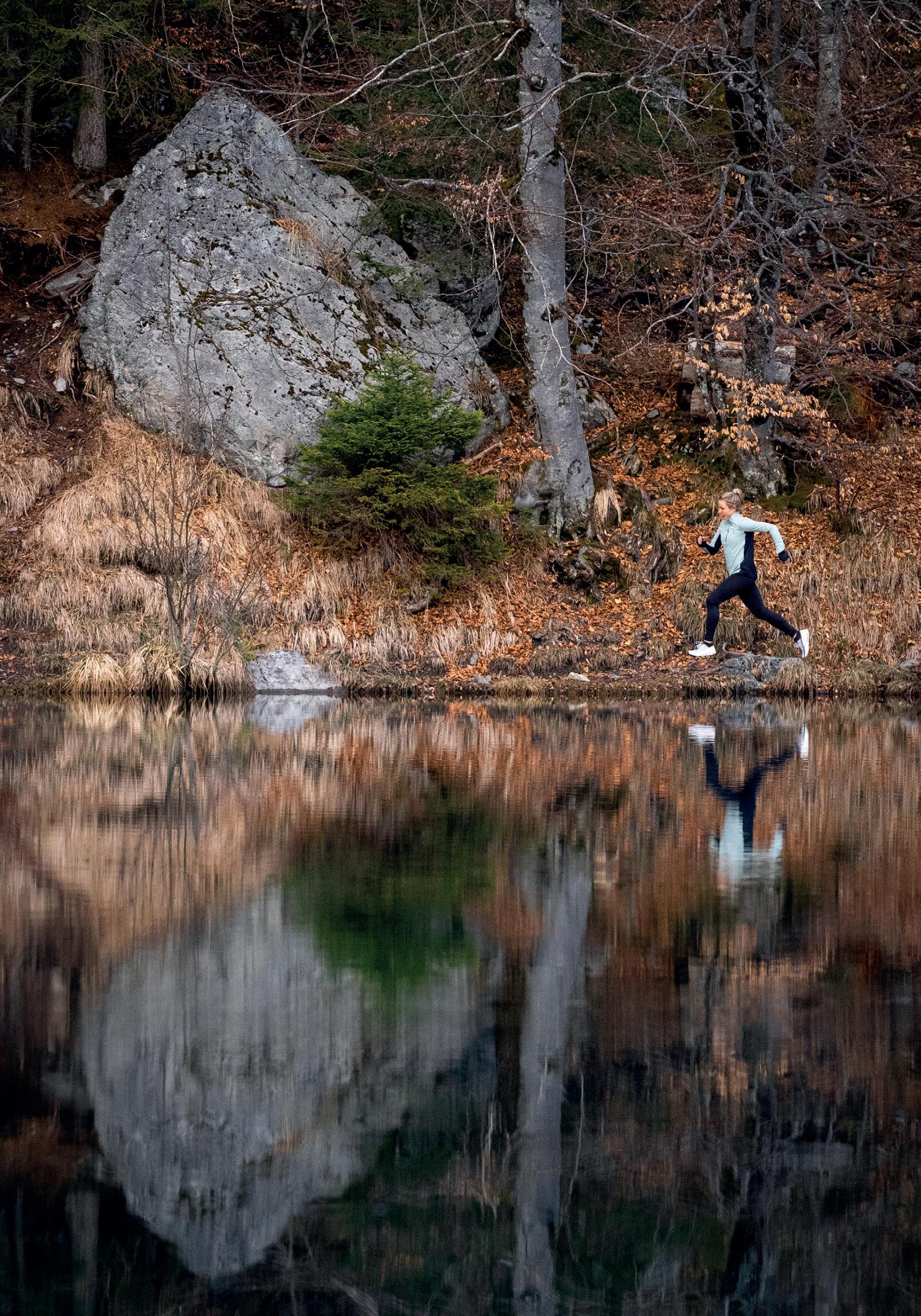

and summers getting longer it is becoming more accessible for trail running. At the same time UTMB is growing and so is this sport. For these reasons, the running community is growing fast, although it is not yet at the level of Boulder or Flagstaff, where there are real communities. However little, I think the reason is mainly cultural and linguistic, but I think that's the direction. With the Run The Alps project, something is improving, not necessarily for the daily lives of the athletes who live here, but it is attracting people who come here to run, and the more people who come, the more they bring with them, like a snowball.
In addition to running you also train other people. Do you work with international athletes or with people from Chamonix and the area? I opened the company in South Africa and most of the athletes are there. We also have American and Canadian athletes, and some from England, but none from here. I think it's because of the linguistic barrier we were talking about earlier.
Is there a cultural difference between the english-speaking world and the people from continental Europe? Do you think it's the reason why the way of experiencing sport and the community is different? If you look at running related media they are more focused on the United States. And also I mostly watch and follow American podcasts and blogs. It's all very American, but I'd be very fascinated to find out what Europeans think about those issues that Americans talk about so much. I think there is a lot of difference and this thing fascinates me. In the US everything is very focused on ultras but in Europe there are such important races and athletes that I would like to know more about. In South Africa, on the other hand, the scene is closely linked to Comrades, and I think it is the same in the collective imagination. But there are several people who are trying to bring attention to other distances as well. The most famous race is Cape Town, which has just introduced a 100mile race following the American way.
What is your approach to coaching and how do you think it influences your approach to running? I trained with David Roche for six years, and I owe a lot of what I know to him. I connect with the athletes I train on a daily basis and I think it's something that has a lot to do with their lives, not just with running. So I try to apply training to these aspects. I have a holistic approach, and it influences me because I think about coaching all the time, what's best for my athletes and consequently what's best for me. I don't want to put too much of what I do into them, but at the same time I would like to convey something to them: it's a continuous game to try not to think in watertight compartments but trying to divide myself from them. So what is your approach to running, not so much as an athlete but as a human being, and what role does it play in your life? Uhm, I’ve got a lot. Obviously it goes in stages, but I still take running as a tool to grow as a person. It teaches me things, it allows me to connect ideas. It is the vehicle I have for experiencing the world. I never let the performance or the racing take me away from that, but of course it's hard to balance that with racing, with ego. Growing up I also realized that running has become a way to talk about topics that interest me such as women and their role in sport.
Do you think running should be deprivation? Deprivation. No, it shouldn't be.
Has running ever been an obsession for you? Oh yeah, and it still is. I think people from the outside say that it's an obsession, when instead it becomes more than an obsession it takes me to unhealthy places: over training, injuries. But on some level, I can't live without running, so yes it's an obsession.
You organize a running camp with Run
The Alps, focused on women and inclusion: it is for women only and it seems like a place where to talk and express. Yes, my idea was to organize a camp that was a safe place to express oneself and share diffi-
111

culties and problems. The idea of creating a place for women was supposed to make them feel less alone, probably by trying to share experiences that are strictly feminine, in a safe place.
I appreciate to see élite athletes engaging in social issues. You are very active on this issue. How do you think athletes should address these topics in order to try to solve them but without damaging the image of sport in any way? Oh, more questions like these! I think if we want to empower athletes to express themselves they should feel they have a way to do it without hurting the sport and the sponsors. On the other hand, we athletes should pay attention to the ways we express ourselves, demonstrating that we can do it without harming anyone. I think this is the long-term goal.
I once asked an athlete, she was one of the strongest in the world, if companies are doing enough to make female athletes equal to men. She didn’t answer and tried to avoid the question. Wow. She probably didn't want to damage the sponsor's image. I don't think silence is always a good thing, and if one has the opportunity to talk about it properly, without necessarily accusing or attacking anyone, he or she should do it. I think there is always a way and that should be the first option. We have to create a space where people, women, can feel comfortable talking about anything.
Is the fact that ultrarunning is a bit primitive as a sport, but at the same time heterogeneous and varied, good for people with eating disorders? Does it help to create a safe zone for them? Or does the fact that being a younger sport it is less prepared and ready to tackle the problem? In my opinion both of them. The fact that there is not so much money means that there is less attention, less research, and from the point of view of eating disorders we do not know many things because there is not much research on it. On the other hand, as you said, it is a sport made up of enthusiasts and not of
interests, and it is linked to nature, this makes it healthier. We should grow up staying as we are.
Organizations much smaller than UTMB are far ahead in terms of inclusion, especially in the US, do you think UTMB, as the most important race in the world, is doing enough? It may seem not. There are cultural differences, there is an important language barrier, things in the United States are different, and perhaps the things communicated at UTMB are maybe not visible enough to an international audience. But maybe yes, maybe they are a little behind on the topic.
What race are you preparing right now?
Transvulcania is my first goal. Then I'd like to represent South Africa at the Stubai World Cup, but I'd also like to run UTMB. Many things, too many: I would have to decide whether to go to the world championships or to UTMB. We will see.
What do you think about the World Cup?
In theory it is a good thing: people represent their country, theoretically there is a large selection, there are the strongest in the world, in practice it is a bit different. Then one wonders what sense there is in being so nationalistic today: I don't even live in my own country, why should I go to yet another country to represent something… I don't know. Probably the very concept of the World Cup is dated, we should move towards other races.
You have recently switched to On, what changes for you? My previous brand was not the best thing for me: it was an outdoor and mountaineering company and running was a relatively small part of it. I was looking for someone who is totally into running, and who is close to Chamonix and where I live, and who is in line with what I believe in, who is socially and environmentally active, I like the gear and I feel good. So I'm happy.
Thanks, that was a good chat. Thank you for not asking me the usual generic questions.
Hope to see you in Chamonix then.
113

The Basque Fever Francesco Puppi a Zegama
 BY FILIPPO CAON
PHILIPP REITER & CORTNEY WHITE
PHOTOS
BY FILIPPO CAON
PHILIPP REITER & CORTNEY WHITE
PHOTOS
I'm on the second floor of an airport restaurant chain. In front of me, a few tables away, there is a large window overlooking the parking lot illuminated by the headlights of cars. A little further on there is the highway, and finally, on the other side, a shopping mall. There is nothing poetic, nothing romantic. In the US the same set of things would make a movie. Here, however, everything is dull: the trucks are different, the distances, the spaces, the road signs, everything is tangled and confused. I look outside and steal a few minutes of power from the restaurant. Trento vs Civitanova are paying, game 4, the championship final, is ends badly. Then I get up, open my wallet, pay.
Late in the evening, the arrivals area is still overrun with people. I find a quiet corner in which to put my sleeping bag, but they send me away, and shortly after I find myself halfstretched on a bench, with three hundred other people. There are several homeless people, some have travellers' suitcases and personal effects. You can't read their lives, you don't understand what brought them there, but you can sense that they've been suspended in this waiting room for hours, months, maybe years. They all have different stories and all the same story, a policeman tells me: they don't have documents. I go out to get some fresh air. Outside, next to the sliding door, there is a man with a purse, leaning on one of those tall ashtrays you find in stations. There's another guy with a bruise on his cheekbone, he asks him something but the price is too high, so he comes to me. He goes back inside pissed off, sits on the floor, under the lost luggage door, drinks a warm beer, talks to himself. I sleep next to him, trying to give myself an attitude: we are lying next to each others, so similar and so different. I am protected by a warm sleeping bag, and a bed that is waiting for me somewhere. I try to sleep.
Francesco had been insisting for some time, he wanted me to cover a race of the Golden
Trail Series, the most important trail racing circuit in the world, so this spring the magazine found a way to send me to Zegama, in the Basques, to cover an event that every year a few thousand people fall ill with a fever that is indeed Spanish, but reminiscent of that of taranta, feverish in its etymology and spirit: they call it The basque fever. I don't know what to expect, maybe a little I do, but I perceive that it's something so big and important, big enough that Nike has given the same name to a pair of shoes, the same ones that Francesco prefers for racing. I have the travel confirmation five days before, so I take the ticket for the first and last flight of the week.
Zegama is a village of 1294 people which, for one day a year, is filled with thousands of athletes, journalists, TV cameras, onlookers: there's no mention of a bed, so I board my single tent and sleeping bag, it's expendable, and then there's no room. Francesco is already at the other end of the air route and sends news from the front, because it's raining in Zegama, well not raining: it's been pouring continuously for days. The paths become mud slides, the rocks of Aizkorri are like soap. A press release announces that the organization has changed the route, but the
116

e-mail is in Spanish and I'm not sure I fully understand its content, I don't stress much about it, I'll understand once I get there. All I know is I'm going to have to set up the tent in the best way possible and pray it will keep it together. A ride with Riccardo Borgialli from the airport to the town, and once the outward journey has been arranged, I organize the return. It's a risky plan, done in a hurry, with at least eight and a half things that could go wrong, but the only way to find out how it goes is to set out and take what's to come. Despite everything, I am convinced that this is basically the only possible way to write about a mountain running race, even if it means not talking about it at all. Ultrarunning, and by extension trail running, isn't about running 100 miles in 14 hours: it's about sleeping badly, getting by, living in a precarious situation. You can limit yourself to reporting a result, listing the facts as they happened, but you would kill their essence. A running race cannot be told.
I think of these things lying on the ground, trying to slow down my mind, which goes at a hundred an hour, thinking and going over all the steps, trying to understand where it went wrong, or what is missing, because something is certainly missing. Anyway, I'm tired; I've been running under the rain for days, I'm cold, maybe I’m getting a flu: in other words, I’m sick of that rain even before I arrive. Sleep deprivation is terrible while running, standing still is unacceptable. I just want to get to Zegama, set up tent at Murgizelai Park and sleep until the next day. The park of Murgizelai - happy to write it not to pronounce it - is located just above the village. From there, the small church of Sancti Spiritu is 7 kilometers away, and it is perhaps the best point from where to see the race, perhaps a bit pimping, but undoubtedly one of the most emblematic: the twentieth kilometre, at the foot of the ramp that leads to Aizkorri, the mountain overlooking the valley. After all, Zegama doesn't look like a great place, or in any case no more beautiful than any pre-Alpine valley, and from the outside it doesn't have any credentials for being one of
the most important races in the world: it's not a significant place, it's not well connected, it isn’t that beautiful but not even that ugly, but it's not clear why it's there. The course is tough, technical, relatively logical, but nothing that can't be found elsewhere. Yet, as Kurt Cobain once said: Zegama is Zegama.
As far as racing is concerned, the Basque Country is completely off the radar of the international public, despite having a great sporting history (La Vuelta a España, La Clásica San Sebastián, La Vuelta al País Basque all pass there); nevertheless, the reason why Zegama-Aizkorri is what it is (we should have written its full name somewhere) – the reason why Zegama is Zegama, I was saying, is the audience, mostly concentrated right there, next to that small church at the foot of Aizkorri. There begins the decisive, more iconic and technical part, where it has been raining continuously for days, wrapped in clouds, and where the athletes will pass covered in mud, transfigured, running and dragging themselves, possessed, so present and absent at the same time.
The level of involvement of a situation like the one created on the crest of Aizkorri, the level of numbness given by the cocktail of lactic acid, noise, rain, and oxygen debt – that level of involvement is something that transcends the sport of running , transcends the race, and also transcends the purpose. It is something so lofty and beautiful that it is no longer the race, that it is no longer Zegama, but pure act, pure theatre. There is no competition or sporting spirit, there is only rotten suffering. The athletes who win Zegama, Francesco, a Nike athlete, tells me, are not elegant and light runners like Bonnet, but angular and square athletes like Merillas. If Sierre-Zinal is an ascent to heaven, Zegama is a descent to Earth, made of mud and stones, in which you got separated by twenty minutes from the first ones in three descents, and fall on your ass, on your wrists, and then start running again.
«On the first stretch of Sancti Spiritu it was very muddy, but there was a good energy,
118

while the upper stretch was cold and windy. At the beginning I was quite scared, at that speed I was less comfortable than many others, even if in the end I think it was the same thing for everyone. The descent from Aratz is a little longer than two kilometers and it took me 17 minutes, Merillas 11'30'': with three descents like this you get separated by 20 minutes from the first one, and then the race is over. At the beginning I tried to stay in the second group with Merillas but I felt I had little margin and I didn't have the feeling of being able to change pace.»
«Often we tend to think about athletes for their best result: the one who won Zinal, the one who won CCC. Forgetting that very often they are exploits within an athlete's career. Initially I felt under pressure but then I tried to put my thoughts aside and focus on myself and what I had to do. But in the end I'm happy: it was a better result than last year, and to arrive intact and with a decent time in those conditions is a lot, and I was pleased.»
«Zegama is a competition of contrasts. Contrasts between the old and the new, between a certain way of organizing races one was used to a decade ago, versus the level of professionalism achieved in recent years, accustomed to live streaming, photographers and offices press, in short, many things to which an event like Zegama had to adapt. Nonetheless, it remains a race that focuses on athletes, perhaps like Giir di Mont. It attracts so much interest, but then people want to go out on the course and cheer on the athletes and have a cider after the race.»
«The party goes on until four in the morning and Zegama, a town of 1500 inhabitants, is transformed into a place with 15.000 people for one day. There is a contrast between these things, but it creates a nice atmosphere. I don't see it as an event that disfigures or pollutes what Zegama is the other 354 days a year.» Almost certainly not, or no more than any other race. But like all events that make the most noise, well, it carries with it an irreducible su-
spicion: what does all this have to do with the mountain? 15.000 people, flags and cameras pointed at 60-kilo horses with red blood cells the size of olives? What does it have to do with the solitary spirit of research of mountaineering? Where is the much proclaimed professionalization of sport leading us? Is there professionalization without commercialization?
I look at Francesco, and I see an intelligent, cultured, sensitive person, but torn between two fires. I see his passion for the sport of running, for his history and his tradition. A tradition that rests on these races, on Zegama, on Sierre Zinal, on Giir di Mont. Then I see a professional athlete, who wins and who loses, who beats Albon at the World Cup and who finishes 15 minutes behind Zegama. An athlete who competes with him, who wears the shirt of a perhaps anachronistic national team (not that one, all national teams are anachronistic), I see an athlete who wants more rights for his colleagues and who moves to claim them, and who wants meritocracy and professionalism. A professionalization that perhaps collides with the history of a sport that has always been anything but professional or professionalised. Finally, I see a person who tries to tell these things, and himself and he does it with an amazement that is rarely found in professional athletes, who instead seem to experience competitions as a routine. Francesco, on the other hand, is still amazed, like a teenager, and tries to talk about that amazement where we all do it: on Instagram, or with a podcast: open spaces. I see a person torn between two times that are trying to coexist, just like Zegama.
I met Francesco a couple of years ago. I had to interview him for a special issue of this magazine, and between various questions I asked him what race he dreamed of at night after turning off the light. He answered without hesitation. Maybe Zegama isn't made for Francesco, maybe it's not his race, too technical, too tough, but somehow confused, and for some obscure reason, maybe Francesco is made for Zegama.
120
 BY STEFANO LIONETTI CREW RUNAWAY MILANO
BY STEFANO LIONETTI CREW RUNAWAY MILANO
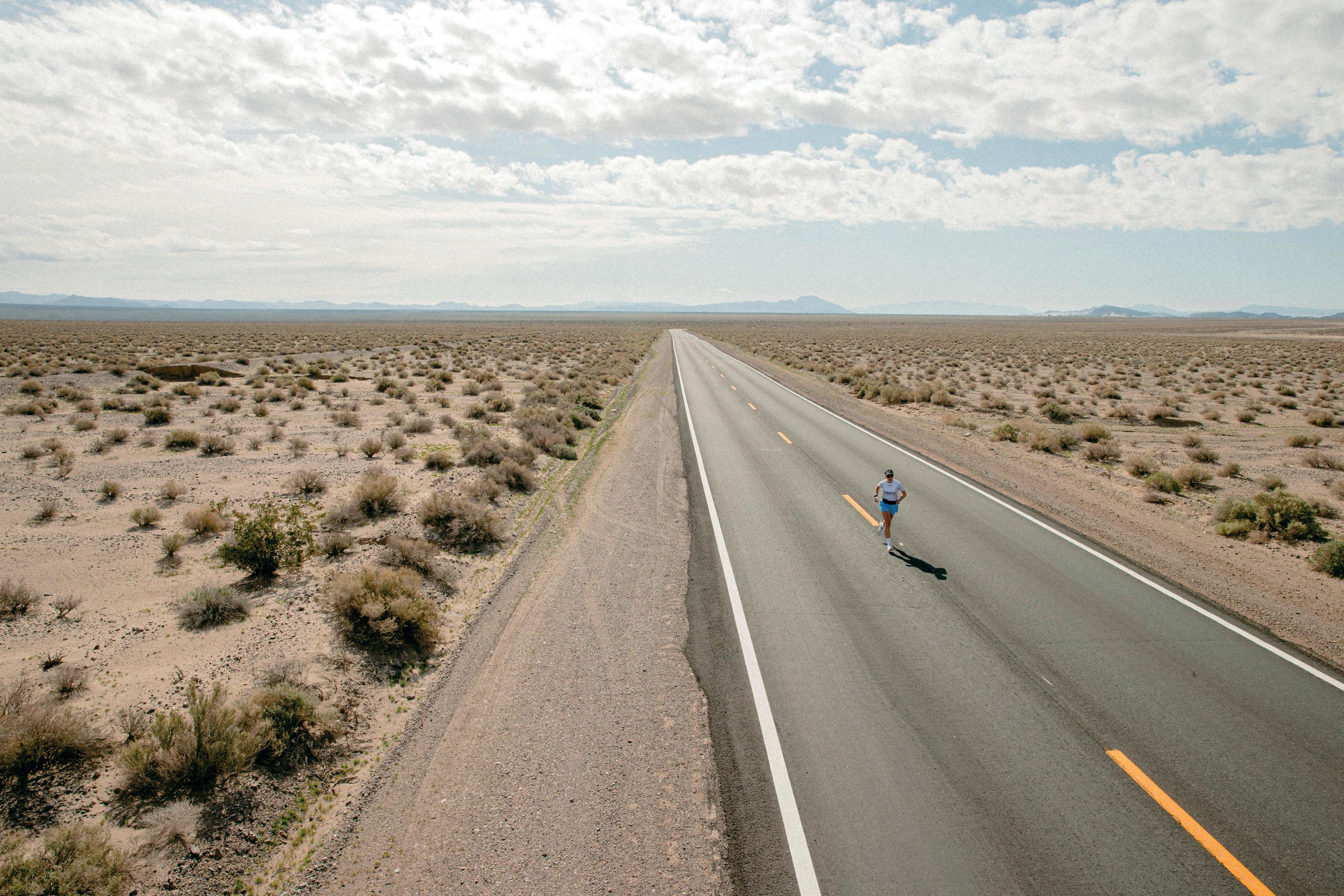
RUNNERS FLORIANO MACCHIONE, GABRIELE CASACCIA, DANIELA BRAVI, LUCA PODETTI, STEFANO LIONETTI, SARA RATTI SUPPORTERS CARLO PIOLTELLI, MICHELE SARZANA PHOTOS AND VIDEOS ACHILLE MAURI, STEFANO STENO
Are they running fast enough? The Speed Project LA to LV

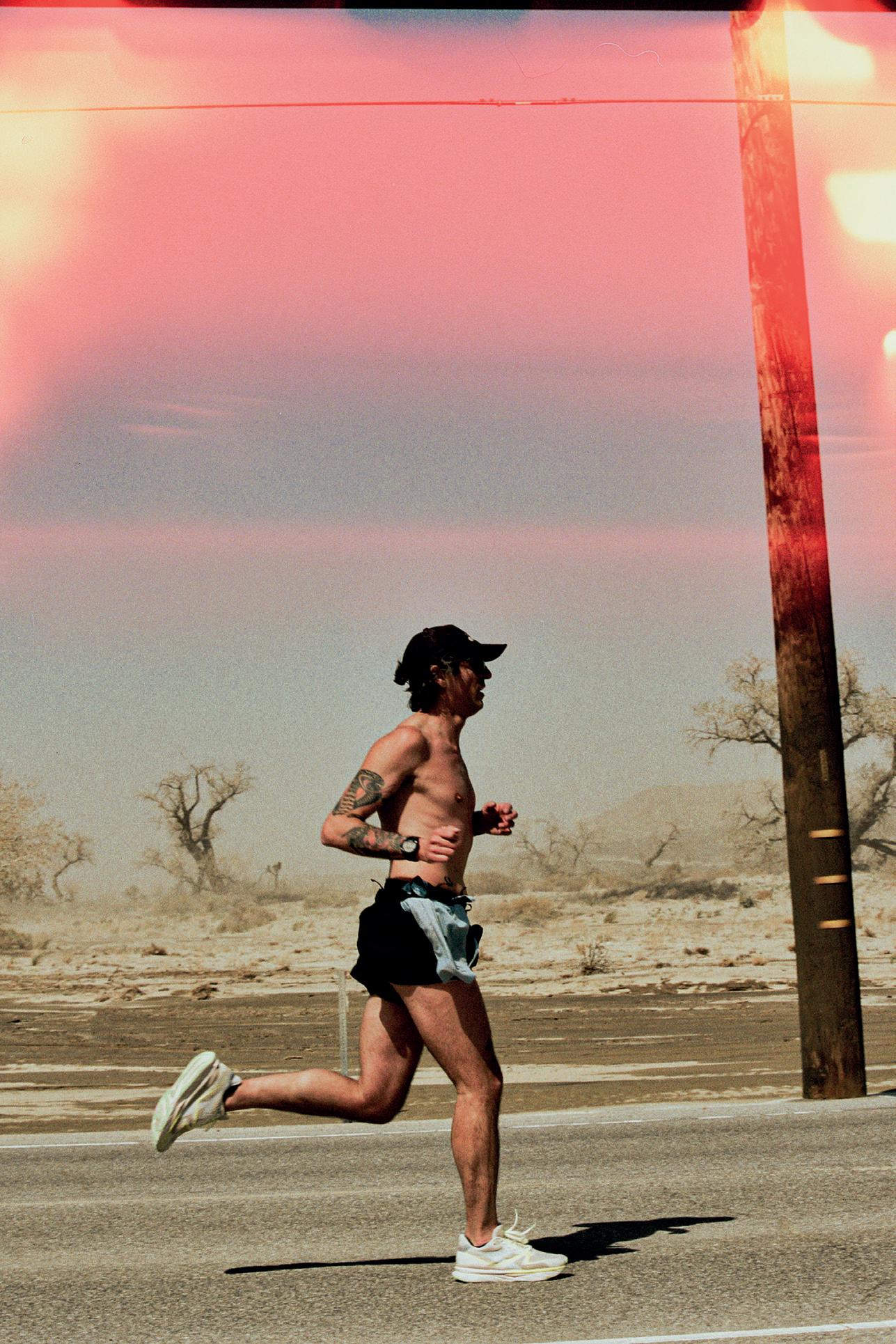
124
*The Speed Project* is just like that: an illegal relay race in the middle of the desert, from the Santa Monica pier to the luminous Welcome to Las Vegas sign (which – let it be recorded – is much smaller than we all imagined). What happens in between is your business. How you get there, the road you choose, too. Just run. No one will monitor you or provide you with a map, no one will give you assistance, there are no refreshments points or aid stations or anything else.
And when night falls – how many hours have you been awake? Thirty?
Thirty two? – it all comes down all together. The road is always straight and equal to itself that you don't realize the time and the kilometers that pass by. The headlamp illuminates the irregular border between the asphalt and the gravel, the dogs bark, now close now far away, and luckily it's not even that cold. On the contrary. Luckily it's not even as *hot* as some people told you. And as the Nevada-California border recedes – or approaches? Today I can't say with certainty where we were, or in any case where I was at that precise moment – you are extremely lucid and alert, despite the non-existent hours of sleep.
When in September Luca told me about *The Speed Project* I wasn't sure I understood it right. How many kilometers did you say it is? Five hundred and forty. But are you serious? He was serious. Now I know that then it would have been five hundred and forty-eight, to be precise. Yes, but don't worry - he said - it's a relay race, there will be six of us, it won't be more than ninety kilometers each. He laughed.
*The Speed Project* is just like that: an illegal relay race in the middle of the desert, from the Santa Monica pier to the luminous Welcome to Las Vegas sign (which – let it be recorded – is much smaller than we all imagined). What happens in between is your business. How you get there, the road you choose, too. Just run. No one will monitor you or provide you with a map, no one will give you assistance, there are no refreshments points or aid stations or anything else.
In case the police will stop you, just tell them you're racing all the way to Vegas with a bunch of friends, that's all. Be kind and cordial. And remember that if you get arrested then you won't make it in time for the pool party in Vegas. You can't even sign up for this *thing* here – there isn't even a website – but you have to be invited: one of the things that Americans are good at is certainly raising the hype. The more I tell you that you cannot freely participate in an event, the more you will want to participate. We are human beings, that's how we are. And that's okay, The Speed Project has never been a race in the truest sense of the term.
125

126

127

128

129

130
All you had to do at that point was to run, stop being a crew and becoming god, for about fifty minutes. Then someone else became god in your place and you went back to being part of the crew: worrying about the road, getting refreshments, resting as much as possible, worrying that god – the god of that moment – was safe.
You don't take home a medal or a prize, you don't take home a *finisher* vest to show off at a party while you sip your Negroni Sbagliato. I brought home something that I still struggle to define and that I certainly can't pigeonhole into any category. Of course, the first word that comes to mind is *ultrarunnig*, but the truth is that it would be extremely reductive. Honestly the running part is almost the easiest, or so it was for me (but I can imagine it's different for everyone). The moment when I had to run, that moment when you got off the camper and saw the other runners coming, when you got ready to hug someone and give a high five, that was moment when you turned off your brain and could relax. All you had to do at that point was to run, stop being a crew and becoming god, for about fifty minutes. Then someone else became god in your place and you went back to being part of the crew: worrying about the road, getting refreshments, resting as much as possible, worrying that god – the god of that moment – was safe.
Let's sum up. Six runners, four men and two women – so the original formula predicts, but you can do as you
like, there are no rules – and then straight to Las Vegas. Those 540km (548) mentioned above are the most sensible route to do, provided that this adjective can be used for anything pertaining to TSP: to do all of this it is customary to rent a camper van that carries the whole team (those who are not racing at that moment) and which serves as your flying life base. The more daring ones can then make the so-called *Power Line*, i.e. a path about fifty miles shorter which however cuts into the desert at the beginning of Death Valley, which means that the whole troop needs a couple of 4x4 vehicles, a in-depth knowledge of the places and an extra budget. We are simple people so have taken the longest route, then let's face it: I had never been to Death Valley and I wouldn't have missed it for the world.
How many people were we? This year – the tenth year – sixty-nine teams, from all over the world. Our crew, the Runaway crew, was the first completely Italian team to participate in the event. This is why we have chosen to be supported by Diadora and Alba Optics, both Italian brands. In this way we have brought a piece of Italian spirit to California
131
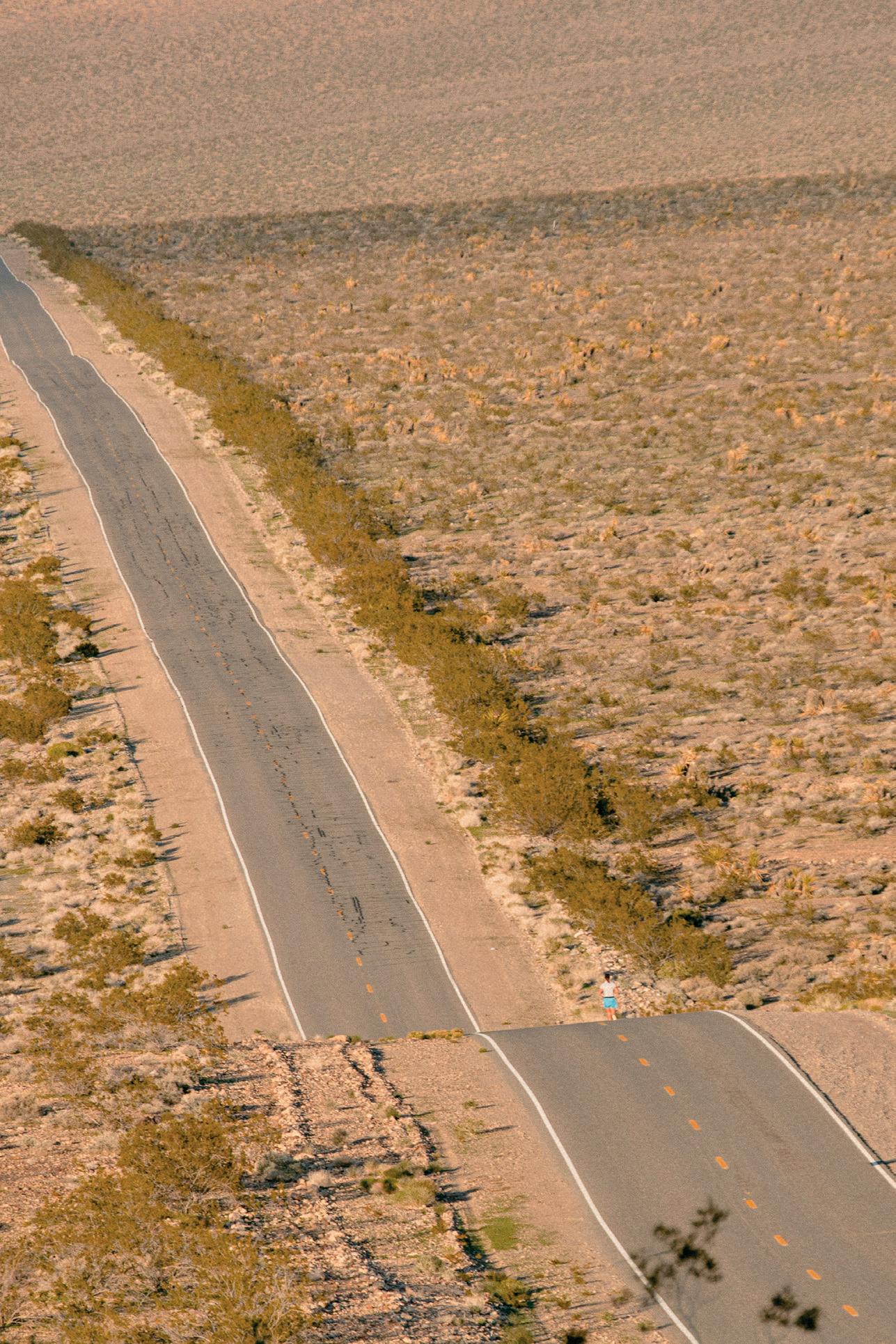
132
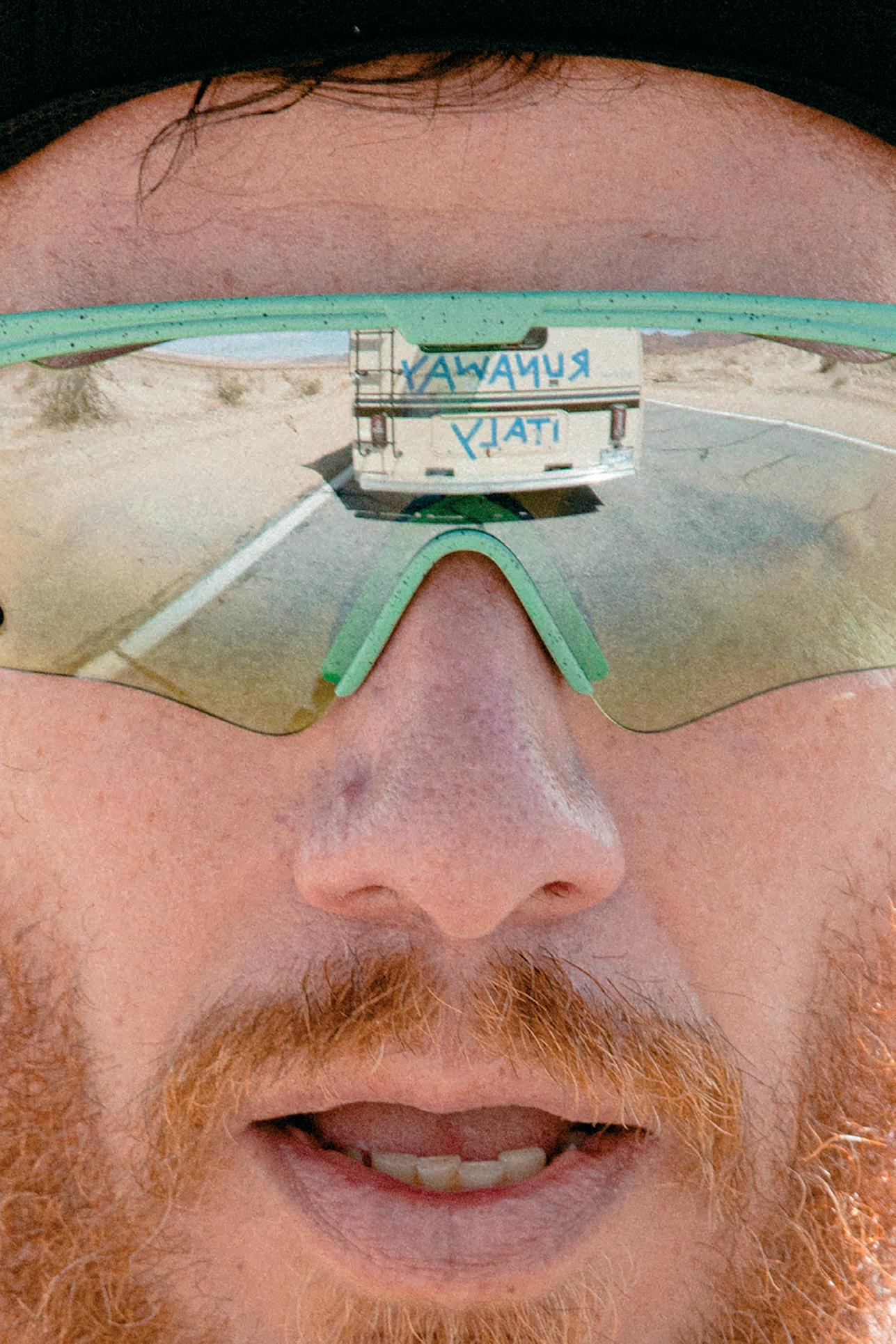
133
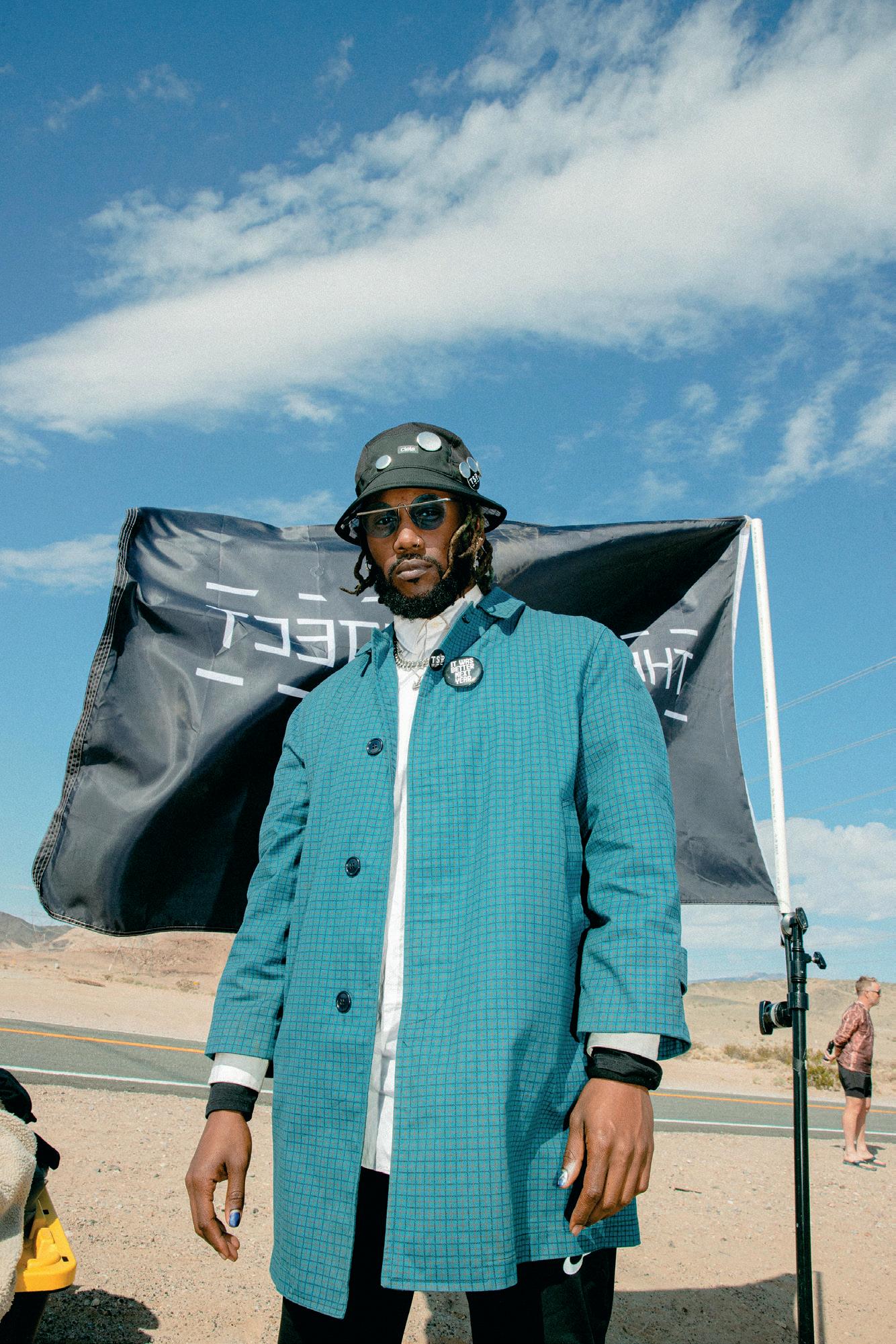
Why we did it? Everyone will have their own answer and I believe that no one can be defined as right or wrong. I wanted my piece of America. My (metaphorical) bathroom on the West Coast with all its contradictions – economic, social, architectural, landscape, everything – so evident as to leave you breathless. And as you run shirtless into the wind in Death Valley you don't wonder why you're doing it, you just do it.
and then to Nevada, with all the resulting stereotypes, including pizza. How many relay changes have we made? Seventy-four I think, maybe seventy-five. It may seem nonsense and pretentious in its own way, but it is as if each of us has run the full five hundred and forty-eight kilometers to go. I remember every meter, every turn. Fifty-five hours of lucid half-sleep – 47h 54’ of race – during which I (we) crossed the busiest streets and the most desolate suburbs. The deserts. The Airplane Cemetery. The mountains. Three dawns. And that guy in that village lost in the middle of nowhere at night - the first? The second? – chasing runners to stun them with the *taser*.
We did it each on his behalf and all together. Those who ran, who drove, who took pictures, who slept (not me anyway). Like a collective mind and body that added their tiredness and emotions to those of others.
We hardly saw Los Angeles, between the preparations, the jet lag, the adrenaline and the almost non-existent public transport. Vegas, on the other hand, well it was Vegas. A city that doesn't make sense. And it is the only reason that allows it to exist and to thrive in its eternal and luminous decadence. Michele and I bought a giant 1kg of *gummi bears*, and that's all I can say about Las Vegas.
Why we did it? Everyone will have their own answer and I believe that no one can be defined as right or wrong. I wanted my piece of America. My (metaphorical) bathroom on the West Coast with all its contradictions – economic, social, architectural, landscape, everything – so evident as to leave you breathless. And as you run shirtless into the wind in Death Valley you don't wonder why you're doing it, you just do it.
135
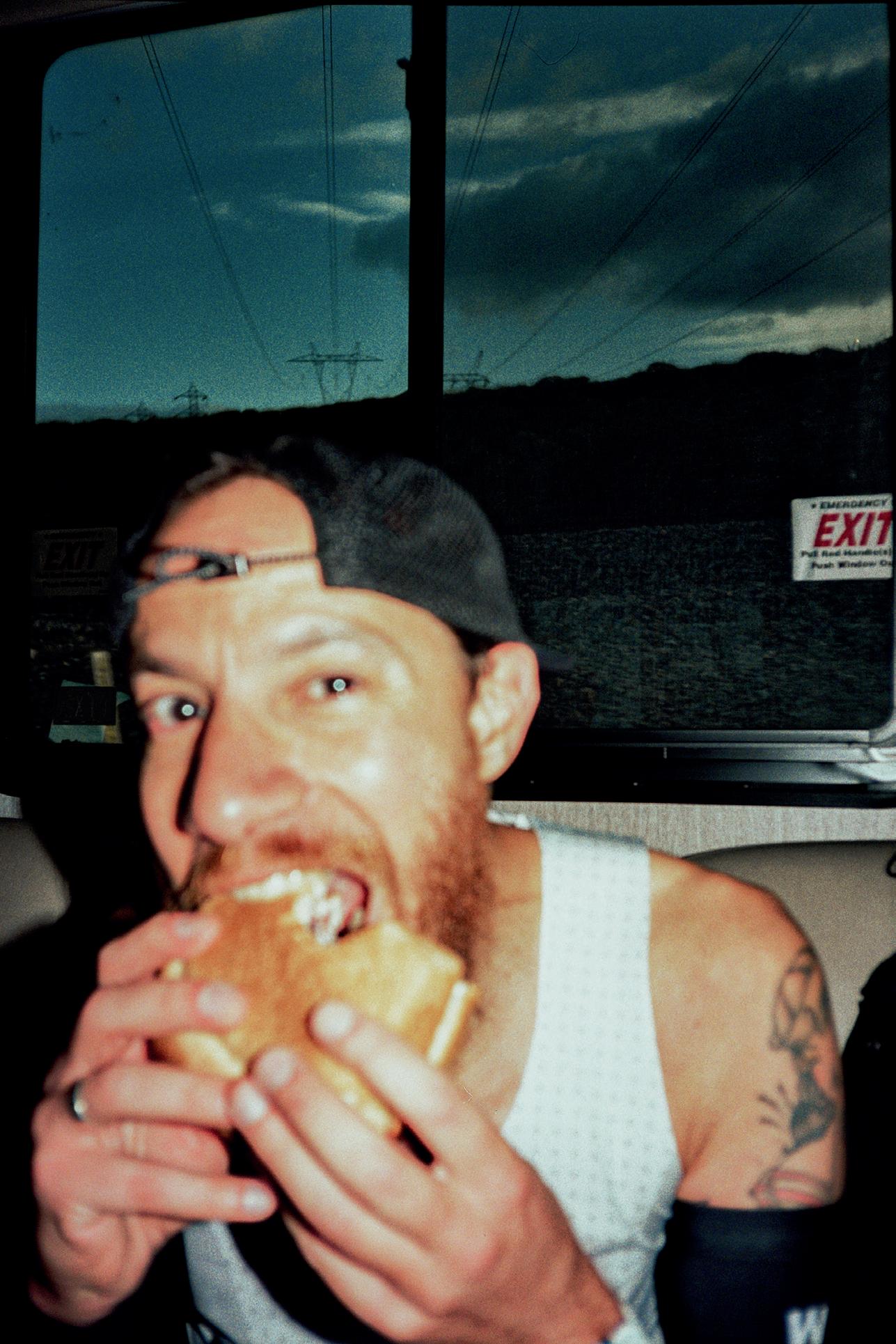
136

137
BY FILIPPO CAON
DENIS PICCOLO
The Searchers
Wild Trails

«A man will search his heart and soul Go searchin’ way out there His peace of mind he knows he’ll find But where, oh Lord, oh where? Ride away, ride away, ride away»
Max Steiner, The Searchers (Ride Away)
PHOTOS
RUNNERS FILIPPO CAON & NOAH GRIENBERG

The airplane is launched at 350 per hour on the runway. A grain of gravel would be enough to propel us forward three or four thousand meters, they would have a lot to do to clean everything up. Then the noise of the wheels disappears and the cockpit is freed from the force that keeps it on the ground. What the hell am I going to do in Arizona? I look at Milan from above, the streets and the haze and that new government of freaks. Down there is a crumpled life between bureaucracy and weeks of insomnia and uncertainties. About a month earlier I found myself in a dusty passport office of the Vicenza Police Headquarters explaining to a policeman that I have to leave, that I need a passport, that there is money at stake and that everything can’t go wrong because one day of my life I met him. I have an assignment letter for the job and a man in Turin, on the
other end of the phone, ready to vouch for me.
«When did you say you were leaving?»

«On the 26th.»

“We will give it to you on the 25th, here's your receipt." Fucking cop.
It sounded so much like a joke that I didn't trust him: three weeks of anxiety and no coffee, at least until the withdrawal started punishing me with headaches.
Now that the insignificant Italy is 30.000 feet below me, shrouded in clouds, and its bike lanes, cops, delayed trains and the Autonomous Province of Bolzano. Now I'm on this plane, and the magazine is sending me across the ocean to write a piece, something that has to be done one way or another.
140
1. Writing the article
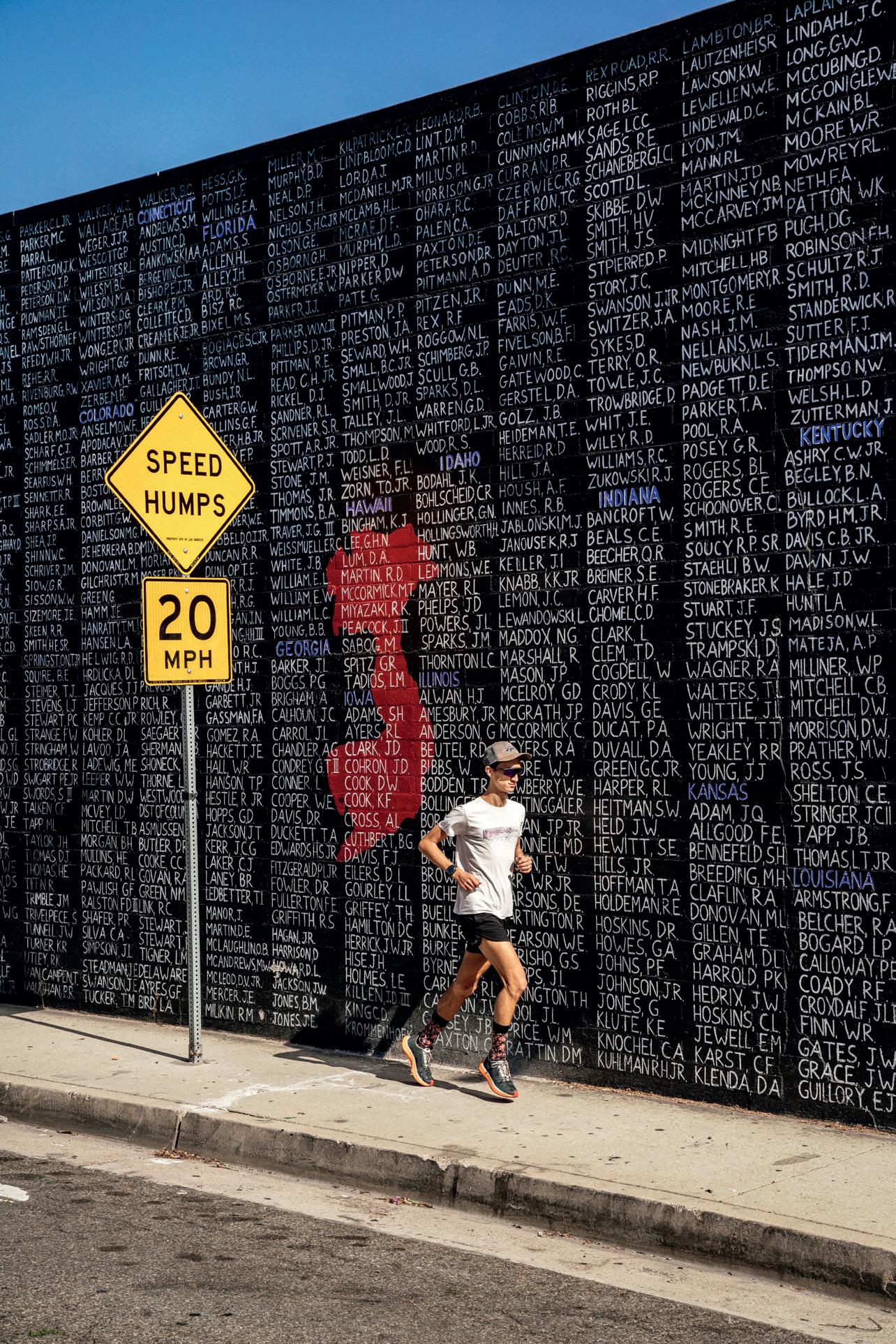
There is something romantic about this thing, about writing this story. But what am I going to do in the desert? Am I going to run a race or to write a piece? Or am I also going to look for the American Dream? All I know is that the only psychotropic in my bag is low-grade sugar in a single-serve gel format stuffed into a pair of running shoes.

Paco had had the idea a year earlier, and it roughly consisted of finding someone foolish enough or smart enough to pay us a vacation to the United States with the excuse of running a 100-mile race and writing an article about it. Two things that in Italy at that moment we seemed to be the only two guys able to do.
A full-blown scam disguised as an editorial project, something still unfathomable. Someone had managed to snatch a ticket to South America to go pull two curves down a mountain and write something existential about it. But with running it was a completely different story, in short, it was unexplored land.
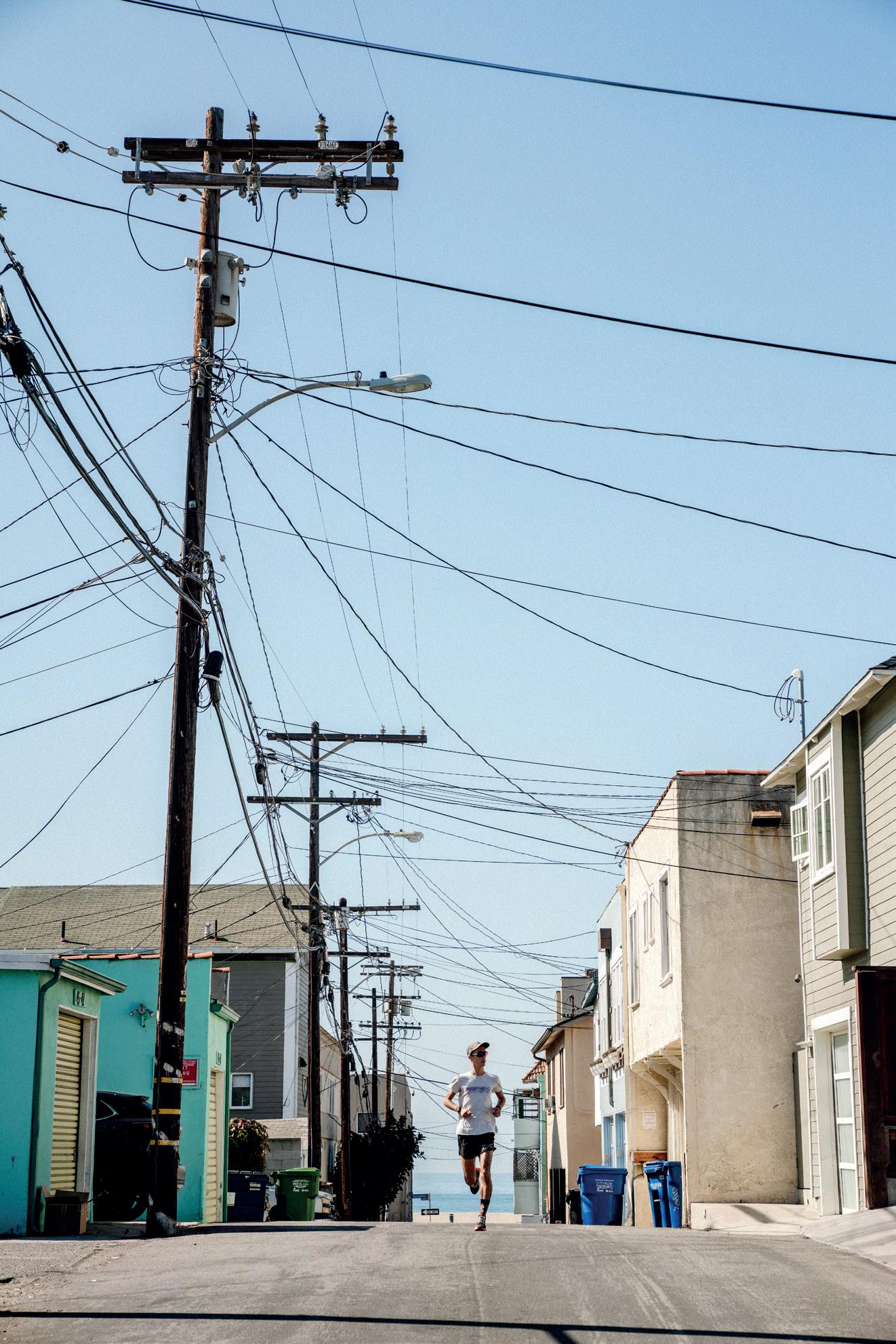
Our first victim should have been AriZona Beverage, a hyperglycemic iced tea company with annual sales of about three billion. Needless to say, it had nothing to do with Arizona, but it was perfect for us. Having a client who has nothing to do with running is a considerable advantage, first of all because the brand will never ask you to account for what
you are going to do. Those marketing jocks up in Amsterdam didn't even know what ultrarunning was. We wrote a presentation asking the $8000 in exchange for a publishing project and eternal gratitude. Eight thousand dollars to give us two geeks to go run a race in the desert in Phoenix, Arizona. Javelina Jundred: undoubtedly the 100 miles with the least fascinating route in history: 160 kilometers on a loop of 30km to be repeated five times. A rave of runners drunk because of the sun and of cinnamon whiskey dressed as Freddy Mercury, on Halloween night, in the middle of the Sonoran desert.
Arizona answered us, but they never gave us money, inexplicably. Instead,
142
for reasons I still don't understand today, Denis gave them to us. Then things went the way they went, and they didn't go well. But for some heavenly reason, or some ultrarunning deity, I'm here now, on this plane heading straight west. A few seats in front of me there are Denis, and Noah, in Los Angeles, at the other end of this route. I'm here, on this plane, maybe broken and in the mood for silly thoughts, and everything around me reminds me of death: a runway-side cemetery at Linate, the new Tumblr icon, and Frances McDormand, in Nomadland, that I watch on the plane, with that phrase said in front of a fire in the desert in winter, «See you down the road».
I’ve had some bad years, but this is just too much. Hearing that sentence my brain decides to close the receptive channels, closes the valves, closes everything. I enter a state of apathy. I want to get excited, but it's difficult, even beautiful things are. I think back to something my grandfather told me, that you have to prepare for death in time, otherwise you risk being left with your ass uncovered. That reminds me that I'm young, because I'm not ready for death at all. I play the Smashing Pumpkins again. That song has been spinning around for a year. A little longer and I'll let it go.
And our lives are forever changed / We will never be the same / The more you
change, the less you feel… In the resolute urgency of now.
When I get out of my seat thirteen hours later, I notice a grease stain on the window: I had passed the flight with my forehead pressed against the glass, I had seen Alberta, the Columbia River, Washington State, Oregon, then Nevada and the salt lakes, and Carson City. Beyond, the Sierra and Lake Tahoe, the slopes of Mammoth Lakes in the distance. Then the plane banked west and my geographical sense became surgical: Tuolumne Meadows, Half Dome and Yosemite Valley straight below me. California. The blunt peaks of granite become hills, then fields. The Central Valley, the Santa Monica Mountains, Los Angeles.

143


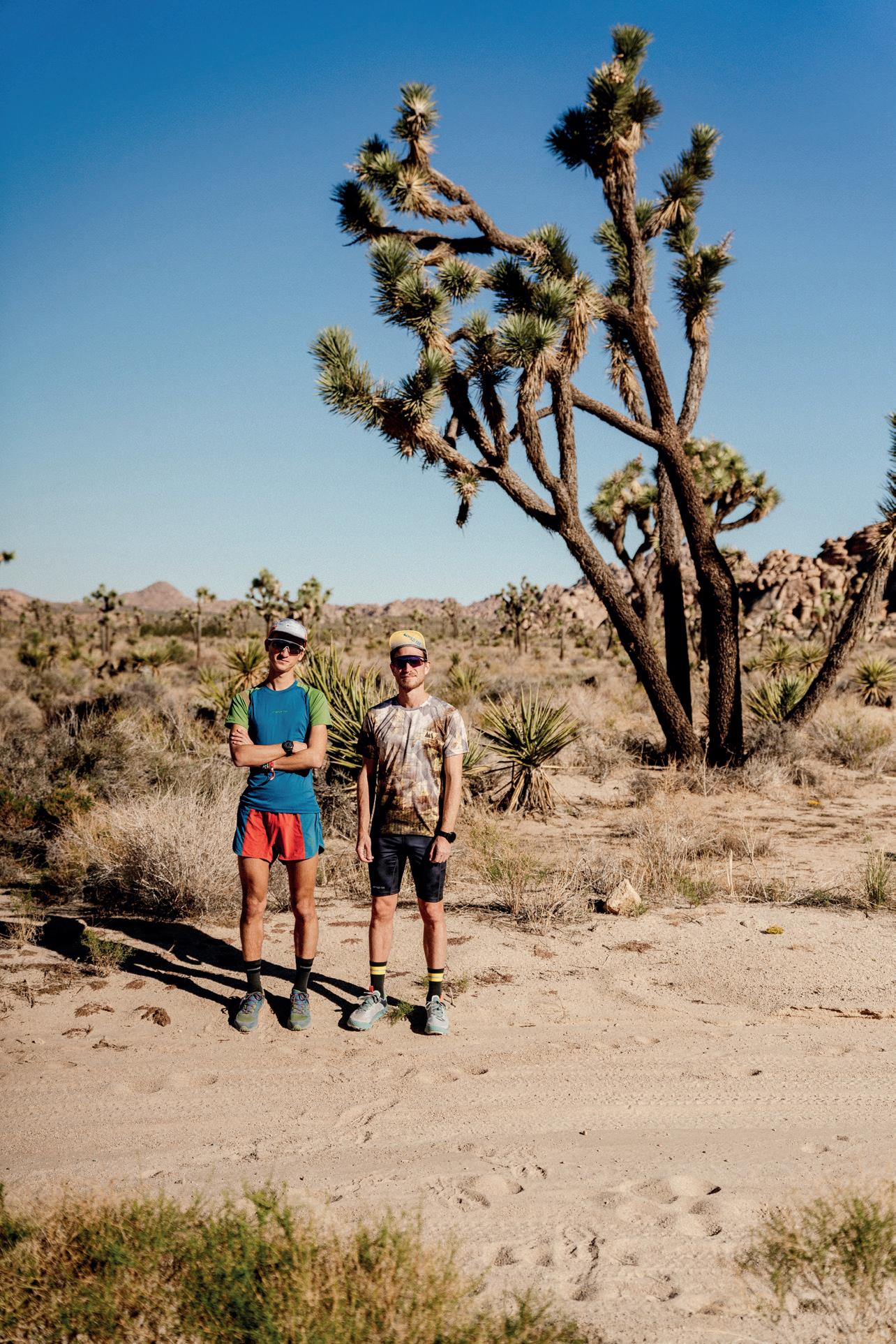
2. California
Los Angeles isn’t beautiful at all. It is battered, but not like Mediterranean cities, where the beautiful and the ugly coexist. In Los Angeles there is only the ugly, very little of the beautiful. Still, it's beautiful. If you look at the details, even without trying too hard, it seems like a bunch of things, but overall everything works. It's not worth spending a week there: or a few hours or a few months. In the absence of time, and we definitely don't have any, it is better to rent a car, put on the right music and drive. Drive a lot. From the sea to the hills, up to the mountains, in San Bernardino. It should be seen like a Monet: fast, with a glance. Fixing yourself on the details only brings trouble and you risk getting stuck in it forever.
See them tumbling down / Pledging their love to the ground / Lonely but free I’ll be found / Drifting along with the tumblin’ tumbleweeds.

To breathe Los Angeles you don't need to go who knows where. A par-

king lot in Inglewood, outside the airport, while looking for a car rental, is enough to be completely absorbed by that light, like in a movie. I don't know what American culture is, but there is a universe of images that all Americans know, a real language, a sort of common ground on which everyone knows how to move. They are not clichés, but collective images: the cowboy, the journey, the road. In the United States, one gets the impression that everything is a symbol. Symbols that we too have learned to decode by watching movies, listening to music, reading some books. We know America because we are immersed in those images, we eat their food, we wear their clothes, we speak their language. And then when we see it we discover that the United States are exactly that stuff.
We don't know what it is, perhaps the pink, soft light, the palm trees, the beach and the houses by the sea. Or maybe those in the second row, those
147
There is something poetic about shooting in Santa Monica, it makes you feel like you are at the end of a journey: it is something so obvious that it is beautiful. The morning air is warm, it's late October and it feels like spring. It's any Thursday and on the beach there are those who surf, those who ride bikes, those who go rollerblading, those who run or walk the dog.
too battered, the light asphalt and the electric cables and peeling walls, which make it real and human. Or maybe it's that feeling of instability that the world could end now, or tomorrow, or the day after tomorrow, but meanwhile we're still here. That feeling that nothing lasts and everything is fleeting. Los Angeles is an inclined plane on which nothing that is placed on it is destined to remain there for long, but rolls away. I don't know who said it, maybe more than anyone, but it sounds good. You've dreamed of it all your life, you know it by heart, you've seen it on television, and in movies, you've read it in books, it's familiar. America is a little further on, but then you remember you've never been there. And that's weird, because
you'd be able to talk about it for hours. You don't even need to see it because it has always been there, next to you. However, we need a car. We have to drive to Colorado, 1300 miles of desert and mountains, four states, two time zones, one week, three people: me, Denis, my editor-in-chief and photographer for the magazine, and Noah, a lawyer with a law degree from Harvard who left East Hollywood and moved to Trento (East Hill) nobody knows for what reason. Yes, we definitely need a car.
At Hertz they give us an estimate of 1700 dollars, at AVIS 2800, for seven days. Same car, same company, online: 800. We take our bags and walk to the nearest AVIS, two kilometers of

148
parking from us. They give us a gray Mitsubishi with Arizona plates, it's not a Coupe de Ville but it's still a car, presentable, and at least until Boulder the problem is solved. We throw the bags in the trunk, turn on the radio and go looking for a beer in Venice.
I wanna tell you a story / Every man oughta know / If you want a little loving / You gotta start real slow / She’s gonna love you tonight now / If you just treat her right.
The most logical thing to do in our only hours in LA is to shoot in Santa Monica. There is something poetic about shooting in Santa Monica, it makes you feel like you are at the end of a journey: it is something so obvious that it is beautiful. The mor-
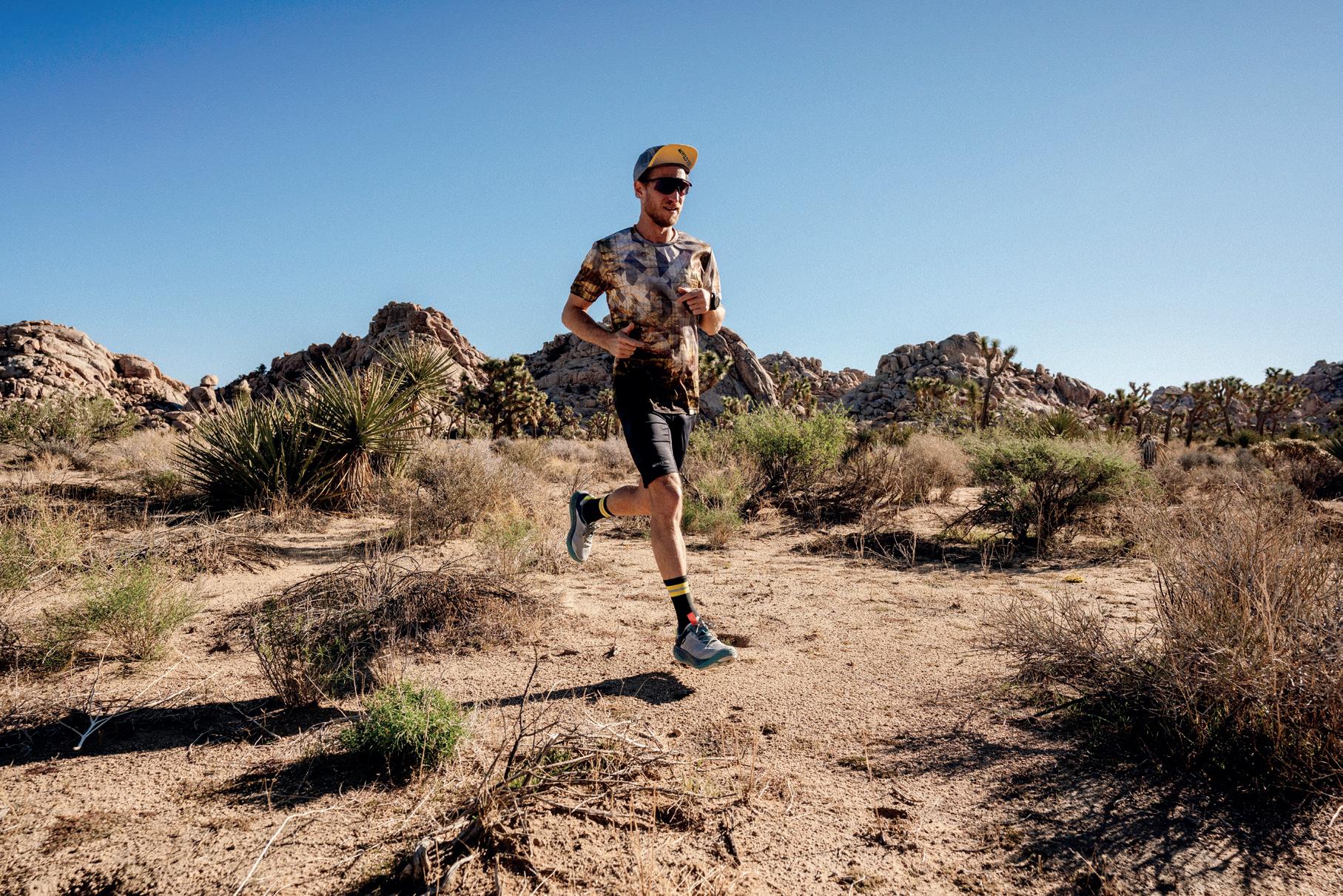

ning air is warm, it's late October and it feels like spring. It's any Thursday and on the beach there are those who surf, those who ride bikes, those who go rollerblading, those who run or walk the dog. I try to think that this is not LA, that a house here costs a million and a half, that with a salary of 60.000 dollars a year you are at the limit of the poverty rate and 70.000 people live on the streets. In LA, the sky turns red every time a fire breaks out in the Sierra, 300 kilometers away, and the neighborhoods of the city remain in darkness for hours. I think of the Californians who are leaving California, returning east to Arizona, Colorado and Texas.
But I'm in Santa Monica and it's hot,
and people are surfing. Who cares.
We meet Noah at Marina del Rey. The last time I saw him was a week earlier in a hipster café in Trento. I had told him something like, next time we see each other it will be in California. I hadn't really believed it when I said it, and instead here we are, together, in Marina del Rey, on the Pacific. It's sunny, and I'm happy. It's always sunny in Los Angeles.
We share a cherry muffin and start driving to West Hollywood. From the sea we take Venice Boulevard east and then S Fairfax Ave north to the hills. Don't listen to anyone who snubs Sunset Boulevard. If you are expecting beauty, strictly speaking, exceptional, strictly speaking, if you
149


expect something different from the rest of the city, if you think it is a place to live, forget it. If you didn't like LA up to there, that street won't make you change your mind: Sunset Boulevard is like the rest of the city, there isn't much exceptional-in-the-strict-sense, yet it continues to look gorgeous and I still don't understand what it is. Maybe that's what it stands for, it's the dream, or it's that numb feeling that nothing really matters, so you might as well surf. It's the sense of freedom, the same as running 100 miles shirtless with a water bottle in hand. That’s it. It is due to a strange inclination of the sun's rays that envelop that piece of land with that irreducible charm. But we're here to run, and to write a piece. Hollywood is
already behind us, we are on the Freeway. It has begun, ready to go, let's go, towards the east. But, oh, what a wonderful feeling / Just to know that you are near / It sets my a heart a-reeling / From my toes up to my ears.
Getting out of LA is a concept that is open to different interpretations. To leave the city of Los Angeles, from East Hollywood, simply take the Hollywood Freeway south and then the Interstate 10, which cuts across the country from Santa Monica to Florida. If you want to get out of Los Angeles County instead, you have to continue driving on the 10 for another hour, all the way to Pomona, passing through 60 kilometers of suburbs.
But if what you want is to get out of the urban fabric, leave behind that amalgam of houses populated by 20 million people, a patch of concrete the size of Piedmont, and you will see nothing more, no more roads, shopping malls and palm trees, if you want to get to the desert, then you have to drive again to San Bernardino, and from there keep driving, through towns of real nothingness at least to Beaumont, and after stopping for a burrito at Chipotle, drive again to Banning. After, only after, you will find the desert.
Between here and Phoenix, where Noah and I will run the race, there are 500 kilometers of highway and two deserts, those of Mojave and Sonora,
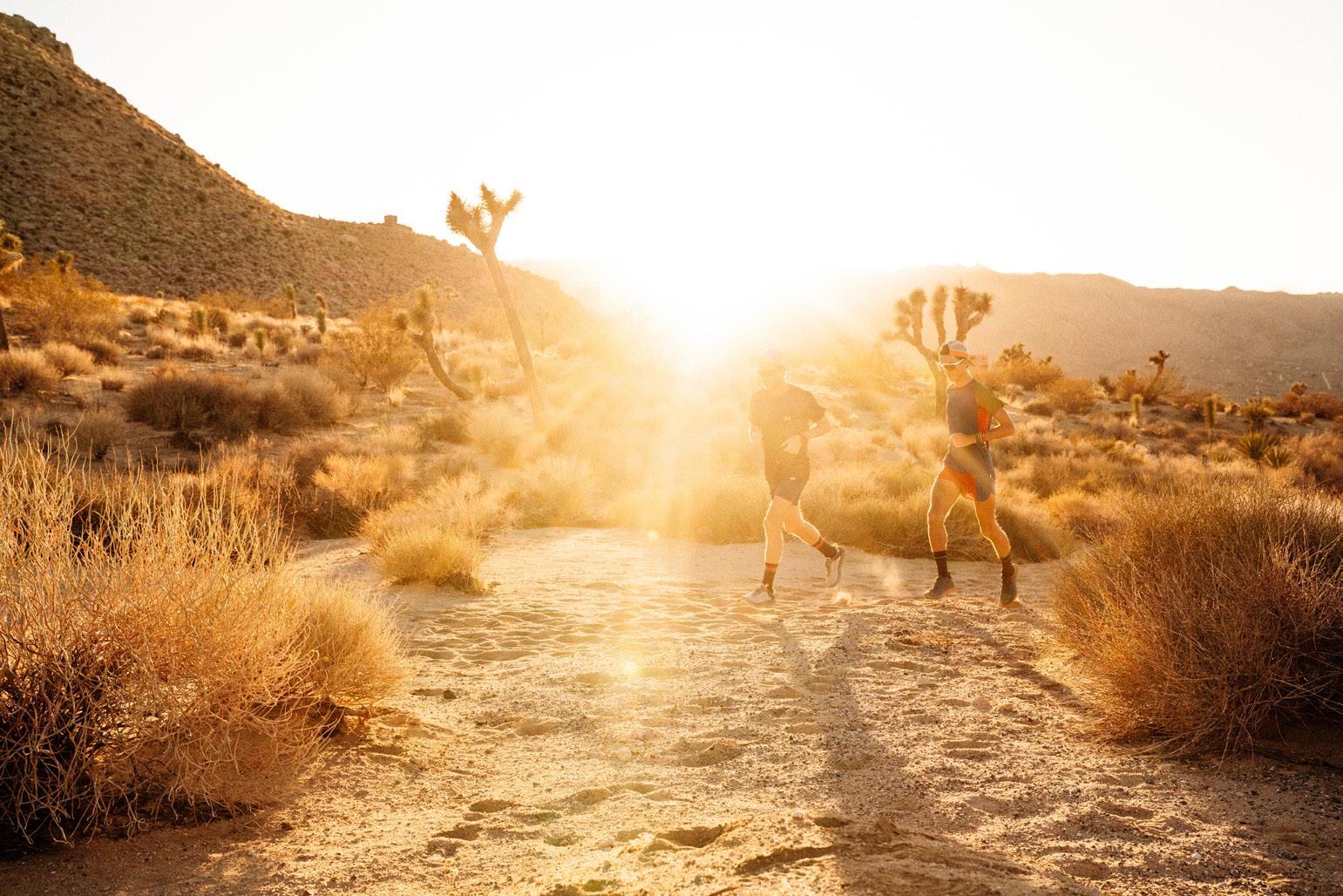
152
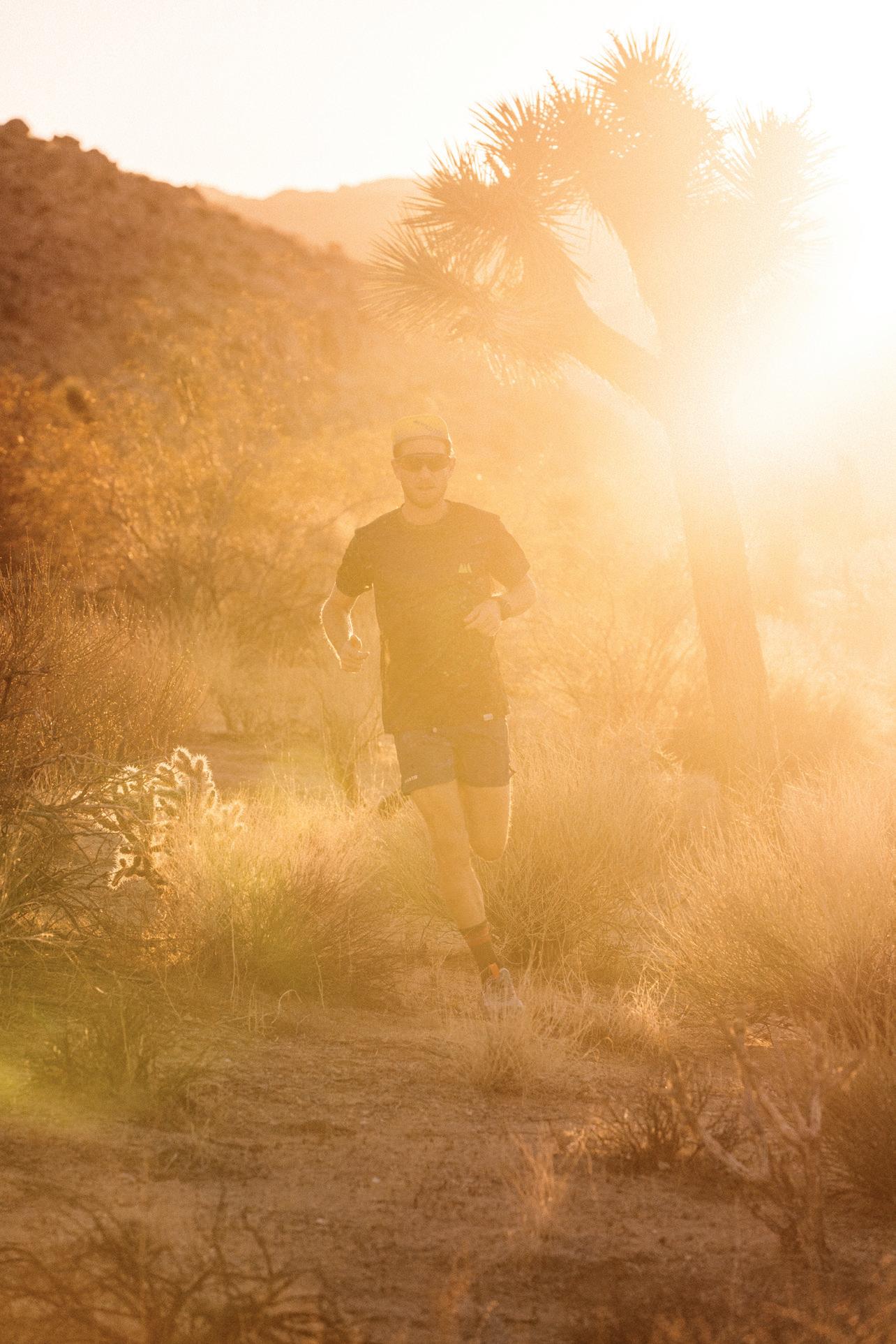
153
cut in half by the Colorado River, which determines the border between the states of California and Arizona. Driving without stopping we could arrive at the place in the evening, but as we don't happen often in the area we decide to make a detour north to Joshua Tree.
Joshua Tree National Park was established in 1994 to be one of the highest densities of Yucca Palm, or Joshua Tree, in the country. It is a very delicate prehistoric tree, so much so that it is forbidden to touch it, with a singular shape that tends to the ridiculous: the bark resembles that of a modern tree, while at the top it looks
more like a palm tree with branches. Really strange. The singular thing is that it is found only here, and moreover it is also the only thing that is found, with the exception of some insignificant bushes that nobody cares about. To avoid mistakes, Denis calls them all cacti. J Tree: cactus, bush: cactus, grass: cactus. Most J Trees are relatively short, but Wikipedia says they can reach 15m, in fact some seem quite tall.
If you want to see them, from the Interstate 10 it is sufficient to take a detour to Morongo Valley, photograph a couple at the side of the road and go back. If, on the other hand, you want

to see many of them, you must enter the Park. It costs $30, but the box office is closed after business hours and admission is free.
In addition to those little trees, there are also strange granite formations called monadnocks in the Park, which formed about 100 million years ago. In all this time, the first to find some use for them were the members of the Sierra Club, the historic environmentalist club of San Francisco founded by John Muir in 1892, who went to the area for a camping trip in the 1940s and thought of climbing them. Starting in the 1950s, J Tree became increasingly popular in the Ca-
154
lifornian climbing scene and began to be frequented by climbers such as Royal Robbins and Yvon Chouinard, fascinated by the existential and romantic aspect of the Park. Indeed, in the evening, with the stars and the fire lit, it becomes something you want to tell. But it wasn't until the late 1960s that it became one of the most representative places on the scene and a symbol in the dirtbag culture, attracting hipsters and sports freaks, who moved there to live on nothing and spend their time smoking weed and inventing what we today know as sport climbing.
Today, writes Cedar Wright in an ar-
ticle in Climbing Magazine, the North American dirtbag scene is dead, and among the things that contributed to its end was the introduction of taxes and stay limits in places like Hidden Valley Campground here in Joshua Tree and Camp 4 in Yosemite, where that movement was born and where climbing legends such as John Bachar and Lynn Hill had lived. Today, in Joshua Tree, the new humans of the outdoors come to climb during the day, and then sleep outside the Park. Climbing has become a sport for rich people, like any other sport, and not just in California.
In the ultrarunning scene, national parks have played a more marginal role. Since it is forbidden to organize sporting events inside them, FKTs have been established on many of the paths that cross them: paths of particular importance on which to record the fastest known time. The most famous FKT in J Tree is the Joshua Tree Traverse, a 60km trail that crosses the park lengthwise, the record is held by Dylan Bowman and Clare Gallagher.

We arrive at sunset, a good time to shoot. It's my first step in the desert but there's no time for fuss, the sun is chasing us and we have to do the work. We shoot for half an hour but we have to hold back to stay focused. Once the light goes down we decide that it's really time to lace up a pair of running shoes, so we open the trunk and randomly choose a pair from the ten we have with us. It's the last run before the race. Before starting my watch freezes without warning, I restore it but it seems completely gone, I notice that it doesn't destabilize me more than it should: I will find a solution, and if I don't find it, I’ll do without. I'm here now and they have to shoot me to keep me from running.
There is still a little light but everything has the same color. We run to the white line at the roadside. Prisoners of the white lines on the freeway sang Joni Mitchell. It has
nothing to do with it but it comes to mind, after all we are all a bit prisoners of something, but not here, not today. We are surrounded by absurd plants and hillocks with high-sounding names: Old Woman Rock, Giant Marbles, Skull Rock. It is the eve of the race and, in the middle of the blue sky above us, there is not a star but the trail of a SpaceX Falcon 9 launched shortly before from some gulf on the Pacific and pointing straight east: that is the our comet, and we are the three fucking wise men. Where have you gone, Joe DiMaggio? / Our nation turns its lonely eyes to you / Woo, woo, woo.
“By the way, I can't stand Simon & Garfunkel.”
"I don't know, I don't know anything about music." [Music continues…] We spend the night in a Motel 6 in 29 Palms, but we need to stock up first, we need sugar to make the journey. Upon arriving we saw a Walmart on the street, we walk out with two boxes of toast, a pound jar of peanut butter, a family size jar of Nutella, a piece of cheese, a dozen cherry bagels, a pack of chocolate chip cookies, a bag of Snickers, a party-size packet of Oreos, six cans of Dr. Pepper, a can of fresh water, and twelve gallons of bottled water. No trace of AriZona Tea. We also buy five apples, a bunch of bananas and three Kodacolor 200 films. Shit, our shopping sucks more than the average, and the average sucks. We managed to spend 100 dollars at Walmart without buying anything edible: we are really ready to face the desert.
At first the desert looks like a desert. It's big, but as you go along it gets bigger. The changing vegetation, the J Tree, the bush, the cactus, the saguaro. Then the Colorado River Valley and a road sign for Phoenix. Arizona: 7 million inhabitants, one less than the city of New York alone, for 300.000 square kilometers of cacti, desert and mountains.
155
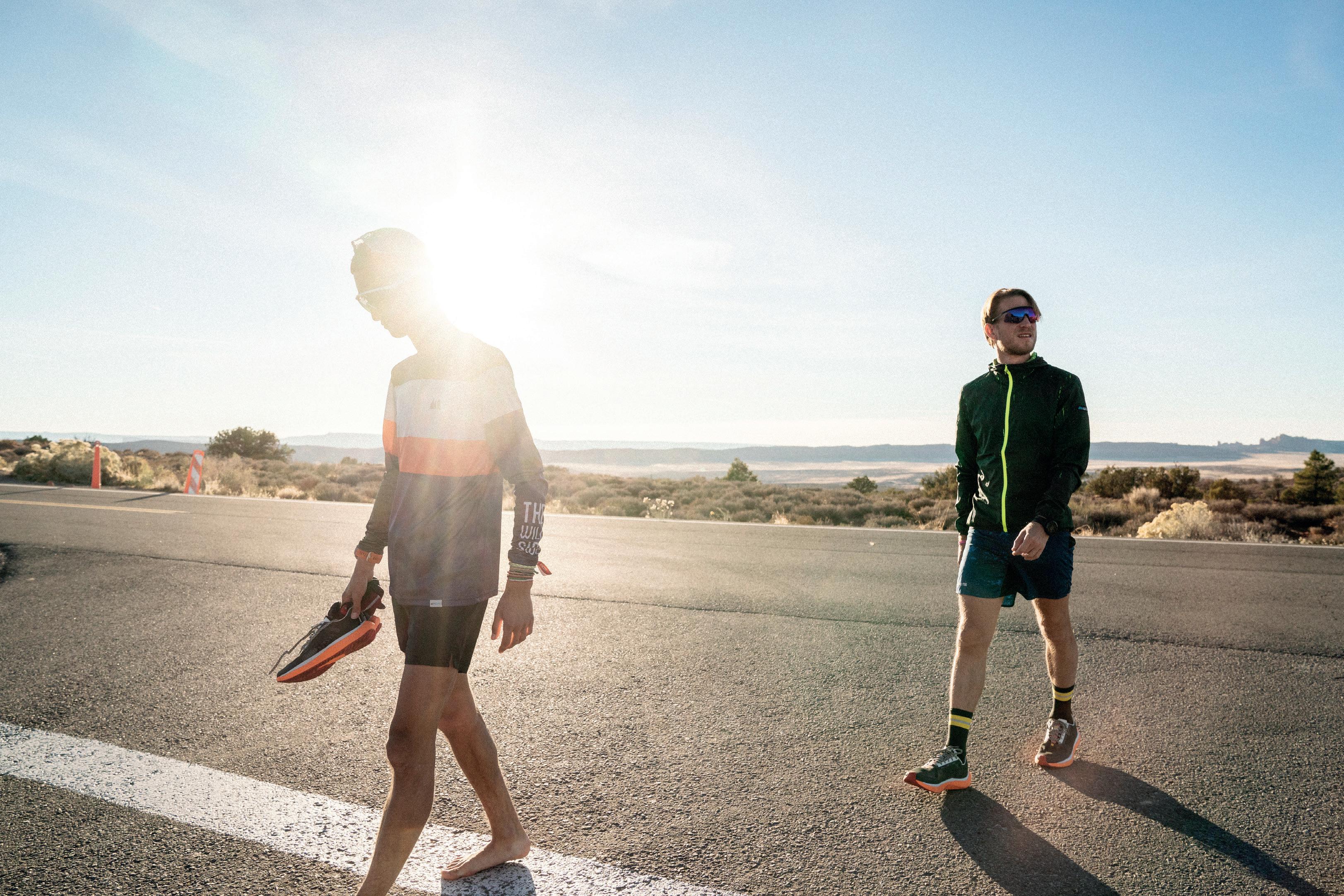

3. No name

and not even the clock, which had abandoned me at the worst moment and without warning, had touched me that much. I was sitting in a Chipotle bathroom at the end of a year gone wrong and fifteen hours away from a race I'd wanted for years. Four months ago a mint had blown my plans for the last six months. Because of that bug I had redefined my priorities, and when I got back to training I realized that what I was doing was only relatively controllable, so it would be better to train less and make sure I got to Arizona in a good form. Eventually, it all fell into place,
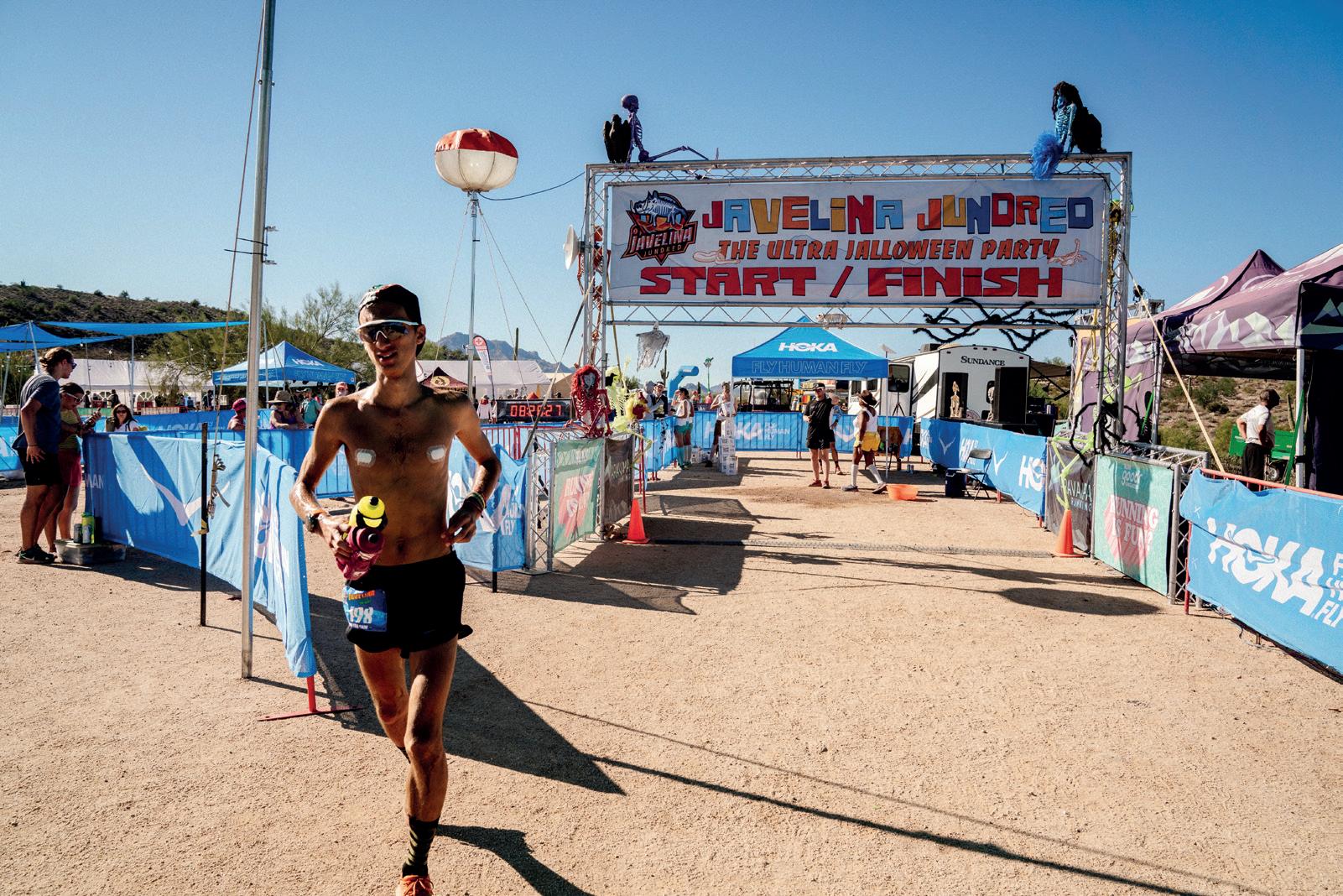
and now there I was, on the Papago Freeway, in a Chipotle bathroom, and I had everything I needed. Not in the car, bag or backpack. Right there, in that bathroom, was everything I needed, everything I would find in the desert and take with me. I didn't know how it was going to go, that's why I had to race it, but as far as I was concerned, as far as I knew at the time, I was ready, with or without a watch and with or without everything else. That was why I had come to that desert, and that was enough for me.
Feeling good was easy Lord when Bobbie sang the blues / And feeling good was good enough for me / Good enough for me and Bobbie McGee.
Once, before a race, a friend said

158
«when you want to quit, think that you are where you were supposed to be». Today I think he said that more to himself than to us. And every now and then he happened to succeed, perhaps after spending six hours in an aid station in the mountains of Los Angeles: he remembered why he was there, put away everything else and started running again. I don't know why we run the 100 miles, I don't care, but I know that when we do we carry our issues and fears with us, and we keep brooding over them for all the miles we have left to run. We run to get the pain out, but we don't need it. We give feelings too much credit, and eventually they give us away. I empty my mind, live in the moment and stay on the trail. I've been trai-
ning on this thing, maybe it's the only thing I've really trained on this year. I want to listen to myself and trust my feelings. There's just me, the rock, the snake, and the coyote. Just be there, run, just like a Jedi. Come what may.

Twenty hours later I am lying in the shade of a bush staring through the leaves at the blue sky. I'm lying on my back, with my knees up and my head resting on the water bottles. I've been like this for less than a minute when a voice asks me «hey dude, you're ok?» I cover the sun with my hand and recognize against the light the silhouette of a devil, with horns, tail and all. I'm out in the Sonoran desert, lying by the trail under the only bush for a four-mile radius, and
Twenty hours later I am lying in the shade of a bush staring through the leaves at the blue sky. I'm lying on my back, with my knees up and my head resting on the water bottles. I've been like this for less than a minute when a voice asks me «hey dude, you're ok?»
159
there's a fucking devil asking me if everything's okay. No man, I’m definitely not good. That fellow is running 100 miles in a toweling suit, and he's doing it damn fast, I'd say 5' per kilometer or so. I'm dehydrated and can't go more than three miles without collapsing under a bush.
I had vomited more or less immediately, at the twenty-third mile, and I had done it after eating the only thing really tried in training, an apple. After throwing up I started running again, but then my stomach closed up and the only calories I was able to ingest from then on were in the form of Gatorade. I drank four liters of that blue shit. Definitely more than a baseball player drinks in three major league games, stuff to stay dumb for life. No, it's defini-
tely not going well, man. Somehow I'd made my way to Coyote Camp, where Noah had joined me, carrying on as he hummed Don McLean and his American pie. For some reason I had felt compelled to brief an aid station volunteer on my state of health, probably an effect of loneliness. In response, the guy had offered me Fireball, a cheap cinnamon whiskey popular within sixteen year old kids, who in the western 100 miles are in the habit of offering it at refreshments. There is no scientific evidence of the effects of one shot of Fireball on the human nervous system during a 100-mile race, but I certainly wouldn't have found out. The guy had also encouraged me not to back down. Yeah, give up: up to that moment that hadn't even crossed my mind.
What the hell do people expect from an ultramarathon? Not that it has to be hell, but it's not easy either. The races are good or bad, but throwing up, not eating, being hot and cold are all quite normal situations in an ultramarathon. Not that there is anything heroic, just be patient, these things are long and there is always time to turn the situation – unless you can't stand or you've been shot, of course. Apart from these limited circumstances, it really doesn't seem right to retire from a race in the desert because it's hot. As Davide Grazielli said to someone: «if you're hot, you sit on a stone and wait for it to pass». Giving up has never been an option.
I don't remember anything about the next 15 miles to Rattlesnake Ranch. If that's where Dakota Jones passed

160
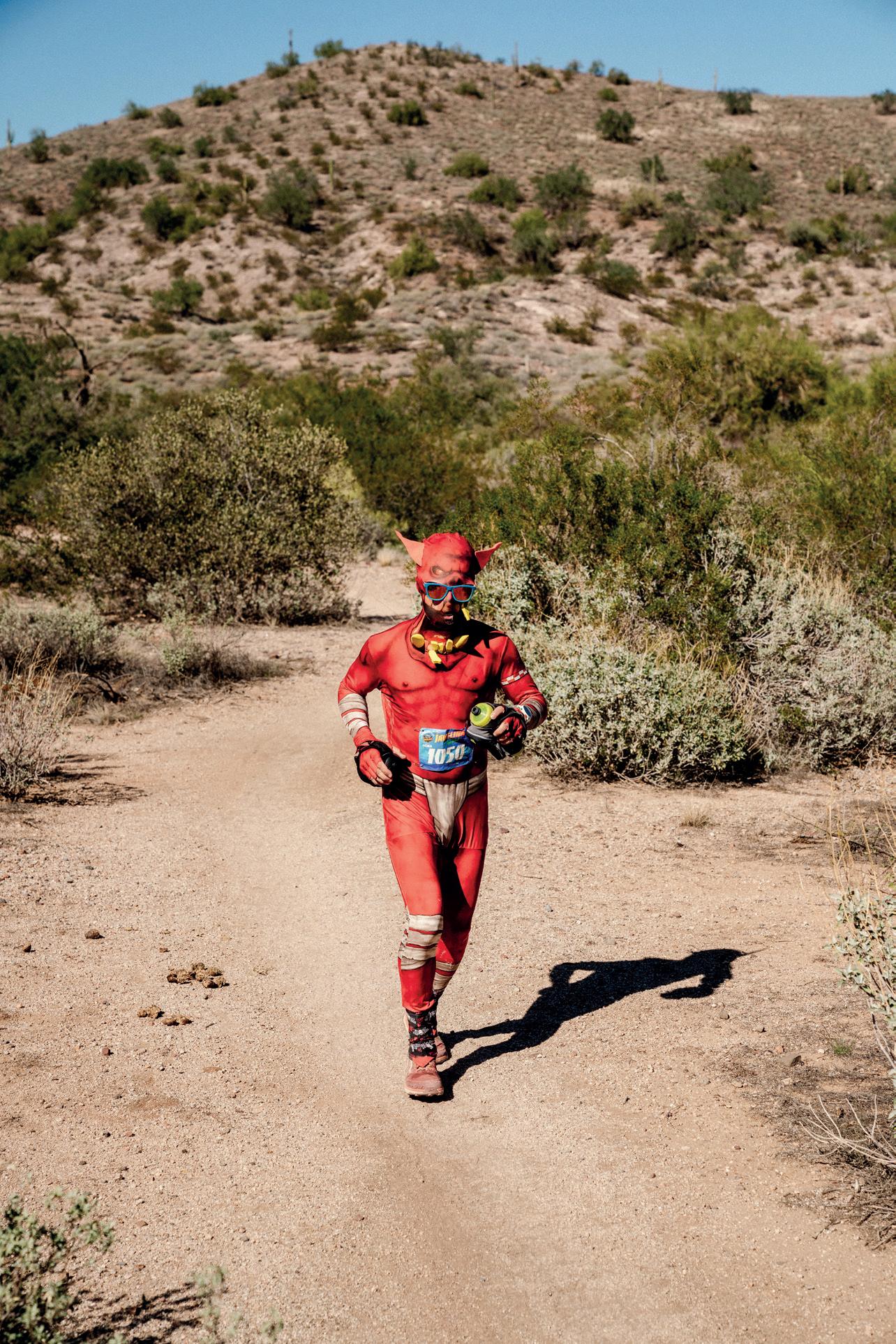
161



me, knees high and legs three feet off the ground, then I remember that. If not, the next image is at the aid station, eating salted watermelon. I stay there for a few minutes, next to someone dressed as a Flintstones: by now the 20 hours have gone to hell, but I have 30 to finish it. All I have to do is reach the next aid station, stuff myself with ice and continue to the next one. For another 100 kilometers.
Of the third loop I remember only the heat and the bushes, and the long shadows of the saguaros. I lay down one last time a few miles before Jackass, and this time I fall asleep.
A guy from Vegas, Jim, wakes me up five minutes later, he says he's a doctor, that he’s running the loop looking for the dead to resurrect. He seems to do it for me. Jim pops two salt capsules, an apple-cinnamon purée, a couple of OJ candies, and a gel into my mouth, all in two minutes. Then he starts talking, Jesus
he really talks a lot, he shoots five thousand words a minute: he says he's from Nevada, that there's a nice community of runners there, he says that in Vegas there are also nice trails, as well as casinos. I really believe it, man. It goes on like this for half an hour, maybe an hour, meanwhile the sun sets, I start eating again, and then I run. At the Jackass aid station he stuffs me into a sleeping bag and asks the captain of the restaurant, a certain Nicky Coupons, to bring me some vegetable broth. I don't protest. The temperature plummets and the world outside the sleeping bag becomes less and less inviting. In addition to the boiling broth, they fill my bottles with water and ice – to date one of the biggest unsolved of this trip. Bro, Nick right? I'm in an expedition sleeping bag drinking boiling broth, the temperature has dropped twenty degrees in half an hour, why the hell would I want to run with ice in my hand? Christ, they're so cold I
can't even touch them. I might as well start running again. It gets dark, I put the headlamp on and launch myself towards Rattlesnake Ranch.

The race takes place in McDowell Mountain Regional Park, just outside the suburb of Fountain Hills. The city is not worthy of note and considering that it is located in the middle of the desert I assume that it takes its name from some puddle that must have been there in the days of the Yavapai, before real estate agencies covered everything with concrete. Reality exceeds expectations: Fountain Hills is a fountain that shoots water at an average of 26.000 liters per minute thanks to three 450 kW turbines. A 90-meter jet of water on an artificial lake in the center of a residential suburb in the middle of the desert. It's the fourth tallest fountain in the world, and it's located here.
Sleep is the last effect of that eight-hour crisis, and it's something
165
you can't counter by eating or drinking. There is only one way to fight it: sleep. If the race goes well, if you eat constantly and stay energized, you can stay awake for up to 35 hours. But if something goes wrong, if you start to shut down, if sleep comes, the only thing to do to fix the situation is to stop and sleep. It's not a waste of time, it's more of an investment. I spend the last three miles of the third loop thinking about whether to stop for 20 or 25 minutes. However, it seems the best way to run the fourth lap in a passable way.
Half an hour later I'm awake, full, and cold: I'm back in the race. The clock reads 100 kilometers. I had replaced it the day before by Shelby Farrell, an
athlete who works for the watch company that sponsors the race, which happens to be the same as my clock. It's a different model and I don't know how to use it, and this doesn't seem like the time to learn. When in doubt I run, I run downhill and I run uphill, I run every metre. I'm playing my quads and keeping a crazy pace, but I want to finish the fourth round. I flyt: finish line, halfway point, another out, another in, fifth lap.
For what reason am I here? I mean, what's the point of all this? Not the race, not the 100 miles, but this one in particular. I'm not the type to wonder who made him do it during a race, but why this one? Javelina Jundred? What is the point of this race?
Imagine that you are immersed in darkness. You only see your feet, one at a time, and a couple of meters of path. The headlamp ran out of batteries and you run with the light of a bicycle in your hand, which moves to the rhythm of your steps. You wasted twenty minutes trading it, but now you are there, in the dark. Straight four kilometers away a beacon shoots straight at you. Four kilometers is about 25 minutes. The light gradually approaches and the sound of your footsteps is progressively covered by the continuous sound of a diesel generator. You go on running, the shadows of the cacti pass you by. The light gets closer and the noise of the generator becomes more intense,

166
then an asphalt road, a guitar, a voice: In the desert you can remember your name / Cause there ain't no one for to give you no pain.

And in my mind the music goes on: La la la la la la... I always pictured myself running through the desert with this song, and now what did they put on? America. It's the last refreshment point, and it couldn't have been different from this. The aid station is like an island of light in the dark of Sonora, the music is loud and there are people busy cutting watermelon and singing America. There it is, the point of the race: to do something extremely difficult surrounded by people who don't make you feel like a hero for it. Nobody gives
a damn about who you are or what you've done, why you're here, if you have any chance of making it: they party, and they also do everything in their power to help you get through. That’s all. That's why I'm here, to run without rhetoric, without epic music, singing America.
Music fixes memories. After years of studying its folds and functions, I still haven't figured out how, but that's how it is. There is a distance between chronological time, psychological time and musical time: they all travel on different tracks at different speeds, but once we understand this, we don't really know what to do with them. I think that's why it's not even so much worth damning your soul,
but letting yourself cross: if that's the moment I keep remembering, of which I still feel the temperature on my skin and the smell in my nostrils, of all those damned 100 miles, is why the air was full of sound.
The last few miles go through a dark narrow valley. Then comes the sound of music and only then you see it. It's like having your eyes closed, then you open them and you see it: the light. I run, I run fast, I run the fastest kilometer of the race. How much time has passed? I do not know. I'm lying with my head resting on my water bottles below the finish line. A little time passes by, I don't know how much, minutes, hours. Then I get up, and there it is. The buckle.

167
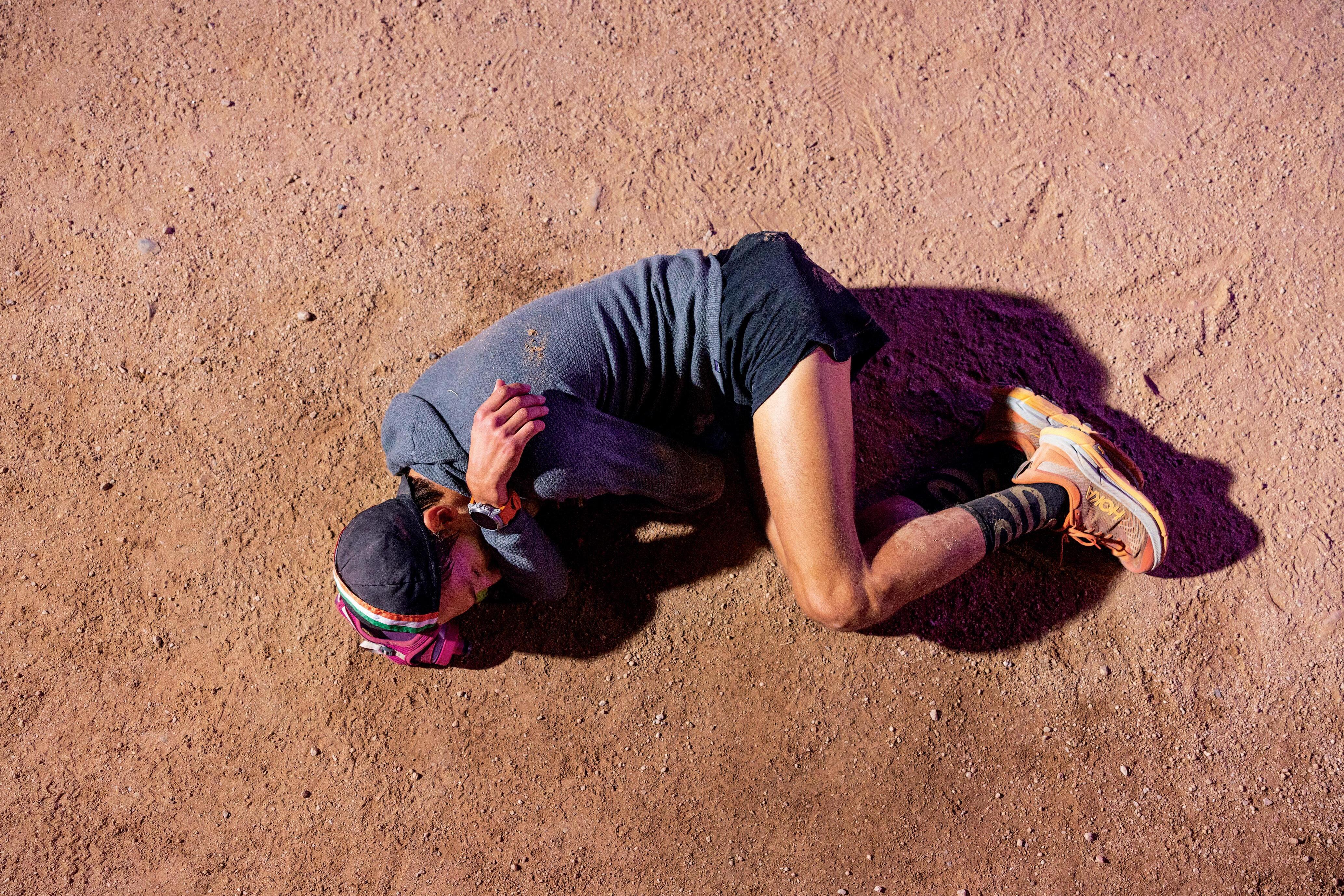

4. Along the road

The sun had beaten down so hard that it melted the cheese on the floor of the tent. Everything was wrapped in a strange invisible slime, impossible to define its nature, it was a mixture of sand, sweat, caramel gel and camembert, and even what hadn't come into contact with it seemed to have absorbed its aura. One thing was certain: there are no showers or laundries in the middle of the desert. The sensible thing would be to burn down the camp and buy some new clothes at Walmart.
We finished running five hours ago, it’s like we got hit by a train and we didn't even notice it. We stay there enjoying the hungover and the post-race atmosphere for a while, telling each other stories from the day, but now we have to get out of the way before the sun starts hitting

again. With what's left of our legs we hop in the car and take Interstate 17 north on Flagstaff.
Flagstaff is located within the Coconino National Forest, a 750.000-hectare area that includes yellow pine forests, a couple of deserts, and several mesas. In recent years it has become one of the liveliest centers in the US running scene, drawing professional athletes from all over the country. It is located on a large plateau at an altitude of 2000 metres, it is close to both the desert and mountains exceeding 3000 metres, it is not far from the Grand Canyon, one of the symbols of running in Arizona, and it is surrounded by forests and from hundreds of kilometers of flat trails, making it particularly suitable for training. It has become one of the meccas of ultrarunning thanks to a
170

171
group of athletes who have made it their base: the Coconino Cowboys. The history of American ultrarunning is written by the people who have marked its generations, such as Eric Clifton, David Horton and Blake Wood in the 1990s, Jurek in the early 2000s, and then that of Born to Run, with Krupicka, Jenn Shelton , Hal Koerner, Dakota Jones and the Skaggs brothers. Coconino are one of those groups that represent, or perhaps have represented, their generation in the best way.
Initially they seem like fresh college rookies, a bunch of geeky and damn cool friends. In fact they win major Southwest races and some historic east coast races, Bandera, JFK 50 miler, Sonoma, but it's only in 2018 when Jim Walmsley wins Western States that they really start to be taken seriously. In addition to winning, the Coconinos are the first group to behave as a team: they appear all together at the races, they help each others, but they are not afraid to challenge each others when they are on the same starting line. Today, not even eight years later, some of them already belong to the history of this sport, others have never blossomed, while others have appeared and disappeared like meteors. But their approach made its mark on the ultrarunning scene and was imitated by other athletes. Meanwhile, the places they used to hang out have become destinations of pilgrimage: Pizzicletta, the Italian pizzeria on Route 66, Mother Road Brewing Company, and Run Flagstaff, the local running store, which is now an iconic shop in the scene.
We stop by it around two in the afternoon, on the day of the race, shortly after having lunch in a classic 1950s diner, one of those with pictures of Johnny Cash and June Carter on the walls. Even too classic, but after all we needed coffee and real food. In all that driving we had forgotten about the shower, and the disgust had only
moved from the tent to the car: the trunk was exploding with sweaty T-shirts and Gatorade filled the air with a sweet smell. Throughout the trip Denis hadn't stopped eating Oreos and crumbs had scattered on the floor mats. There were pieces of rice crackers everywhere, under the seats, on the seats, in the glovebox, and a sort of tower of coffee glasses and Dr. Pepper cans had built up near the handbrake. Christ, we were really unpresentable.
After taking our stink to the only shop in town where no one would be offended, we trudged to Mother Road in search of a long-dreamed-of beer. You dream about it, it's true, but when you find it in front of you, you'll turn away. Then you drink it anyway, but more on principle than
anything else. It's October 30th and the Smashing Pumpkins are on the radio. Places like this have become symbols in our scene but everyone can find them, which makes them all in all still niche places. Flagstaff isn't monopolized by the outdoors, at least not entirely, which still makes it quite livable. The city has an urban trail system that runs through the woods within the city. However, either you spend a week or after two hours you don't know what to do anymore. We hobble to the car between murals and brick buildings and continue north.
We leave forests and mountains behind us and find the desert again. The Colorado Plateau, another 400.000 square kilometers of nothing. Now, the concept of nothing

172
in this specific area changes considerably compared to Mojave or Sonora. In Sonora there are cacti, not here, there is only a strange dry grass. Hectares and hectares of dry English cut grass, followed by hectares and hectares of red earth. A baseball field the size of Poland.
We enter the Indian reservation around sunset, but we don't realize it right away, on the other hand the Navajo Nation corresponds to about half of the state, and what you can find inside is not very different from what surrounds it: nothingness. In five hours on the highway we meet a distributor the size of a supermarket specializing in bags of chips. I pay $6.04 for one. I don't think we need to discuss it and we didn't have dinner.
Noah, in the back seat, has been sle -
eping for hours with his head back and his mouth wide open. He looks just like someone who just ran 100 miles in the desert. Denis is about to fall asleep while driving. He tells me that he misses his daughter, that when you have a son, being away from home for a week becomes unbearable. I tell him that when I was little my mother used to go to Japan for work, that the other children's mothers didn't go to Japan for work, they had never even been to Japan: I liked the idea. For the rest, we are adrift, drifting along with the tumbling tumbleweeds.
We have just crossed the border of Utah when we find a roadside motel. It feels like an eternity since the race, but it's barely been 20 hours. On the motel carpet I struggle to make
sense of my suitcase, but the order in the universe seems permanently screwed up. I give up and go to sleep.
The next morning I roll up my sleeves and clean up the Mitsubishi. There's nothing around us: there's the motel, the parking lot, and then there's nothing else, but at least now the car is clean.
Utah is a prehistoric land and the secondary colors haven't reached it yet. You realize you've never really seen a blue sky until you see Arches. It is famous for its granite arches but the really striking thing is their colour. In Moab you get the impression that every other shade has disappeared from the universe: there is no brick red, olive green, cornflower blue. There is red and blue, and only to a small extent the green of the shrubs and the yellow of the birches, that's enough. Near Arches, the Colorado Plateau includes five other National Parks: Zion, Bryce Canyon, Canyonlands, Capital Reef, and Monument Valley, and what you can find there is pretty much the same: red and blue, and white mountains four thousand miles away, clearly visible as if they were next door. Indeed, the Parks risk turning any photographer into a landscaper, but not Denis. Denis has been shooting for too long and knows too well what he needs, and he's not the type to waste time with a blue sky, «look for it on Google». In any case, making distances seems an impossible feat, for the rest a little red is enough, a little blue, et voilà.
The National Parks respond to a strange principle of protection: inside them you cannot do anything, and in addition to paying the entrance, you still have to pay to walk some paths. Walking outside the indicated path is prohibited and, moreover, these are extremely delicate environments. The total absence of men in the landscape, except for the road that usually crosses them, is the

173

main visible element of anthropization: the human presence is so absent as to seem tangible. Indeed, beyond the sublime effect of distance, the National Parks are vaguely reminiscent of Disneyland. They are mostly visited by car, along roads served by service lay-bys. It must be said that American roads are completely devoid of decorative elements such as reflectors and guardrails, making them less intrusive than ours.
The roads are laid out so well that they look like a movie set, nothing is out of place and every stone seems to respond to a universal order. Even Moab resembles a movie set, so much so that it's tempting to check behind buildings to make sure they’re not just facades. For the rest it is not clear what there is in Utah. Evidently someone lives there, mostly Mormons, but it is not known what they do. I think they mostly wait.
It's Halloween night, the theme of the
evening is Hogwarts. The waitress is a bitch and the burger sucks – mine, vegan, looks so much like meat that I have to concentrate to be able to swallow it. Here this shit is futurism and we still make meatballs with chickpeas.
We passed upon the stair / We spoke of was and when / Although I wasn’t there / He said I was his friend / Which came as a surprise / I spoke into his eyes / I thought you died alone / A long long time ago.
We've just crossed the border of Colorado, we're taking a break in Grand Junction before continuing on to who knows where in the middle of the night. Being in California gives a good feeling, the very fact of knowing you are there, or running a race in Arizona, there is something poetic even in just saying the sentence. But Colorado. Maybe Colorado is the thing I've been waiting for the longest, what this trip really represents.
We had first crossed the Colorado River in Blythe, California. Not that it was a giant river at that point, but still enough to create something like the Grand Canyon. We then crossed the San Juan River, a tributary, and back up the Colorado River at Moab. But in Glenwood Springs, where we are now, the Colorado River is still just a small creek that throws up a pesky moisture at night that the motel's plywood doors can't keep out. We've arrived at the mountains, the damned Rocky Mountains.
He climbed cathedral mountains, he saw silver clouds below / He saw everything as far as you can see / And they say that he got crazy once and he tried to touch the sun / And he lost a friend but kept the memory / But the Colorado Rocky Mountain high / I've seen it rainin' fire in the sky / The shadow from the starlight is softer than a lullaby / Rocky Mountain high, Colorado / Rocky Mountain high, high in Colorado.
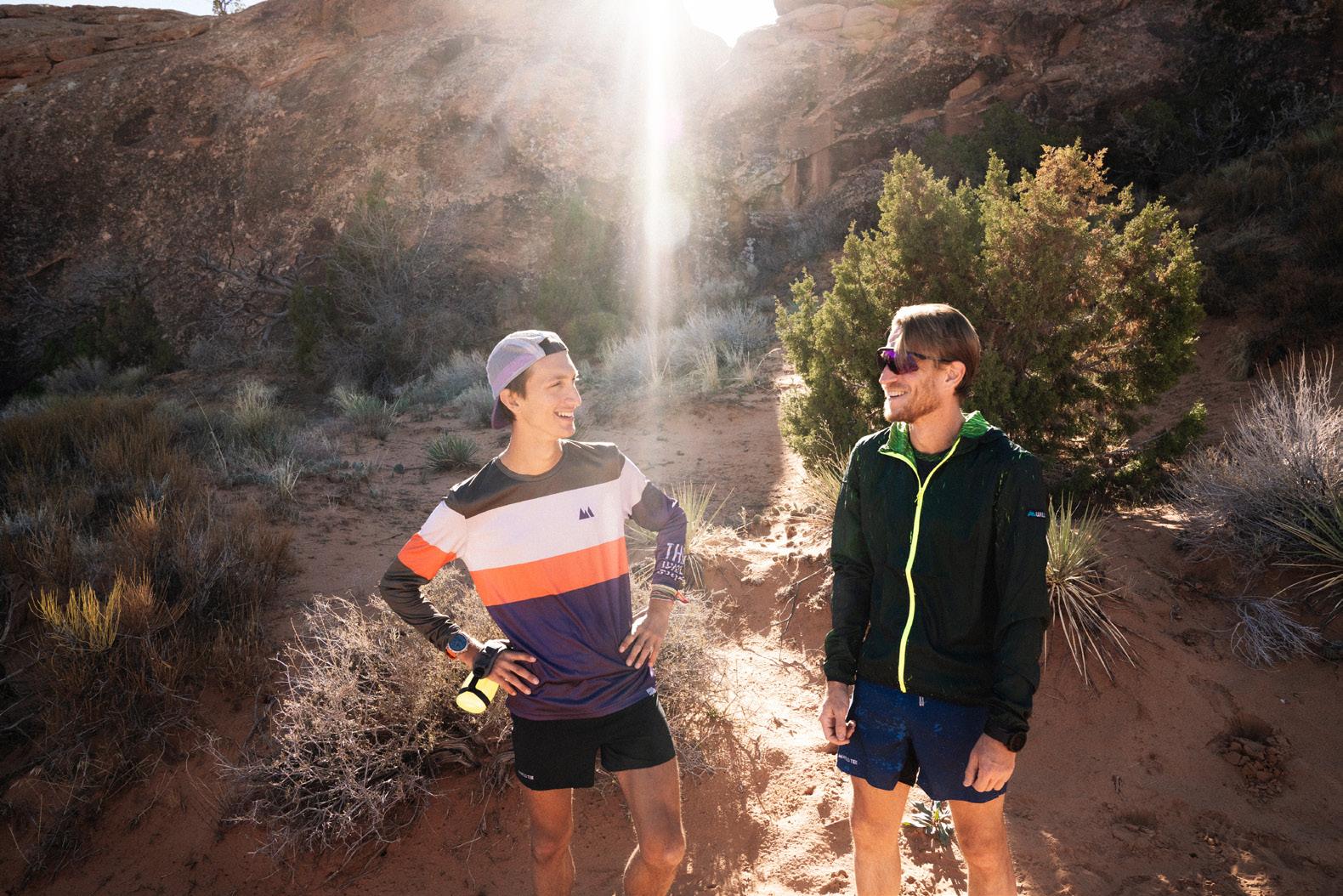
175


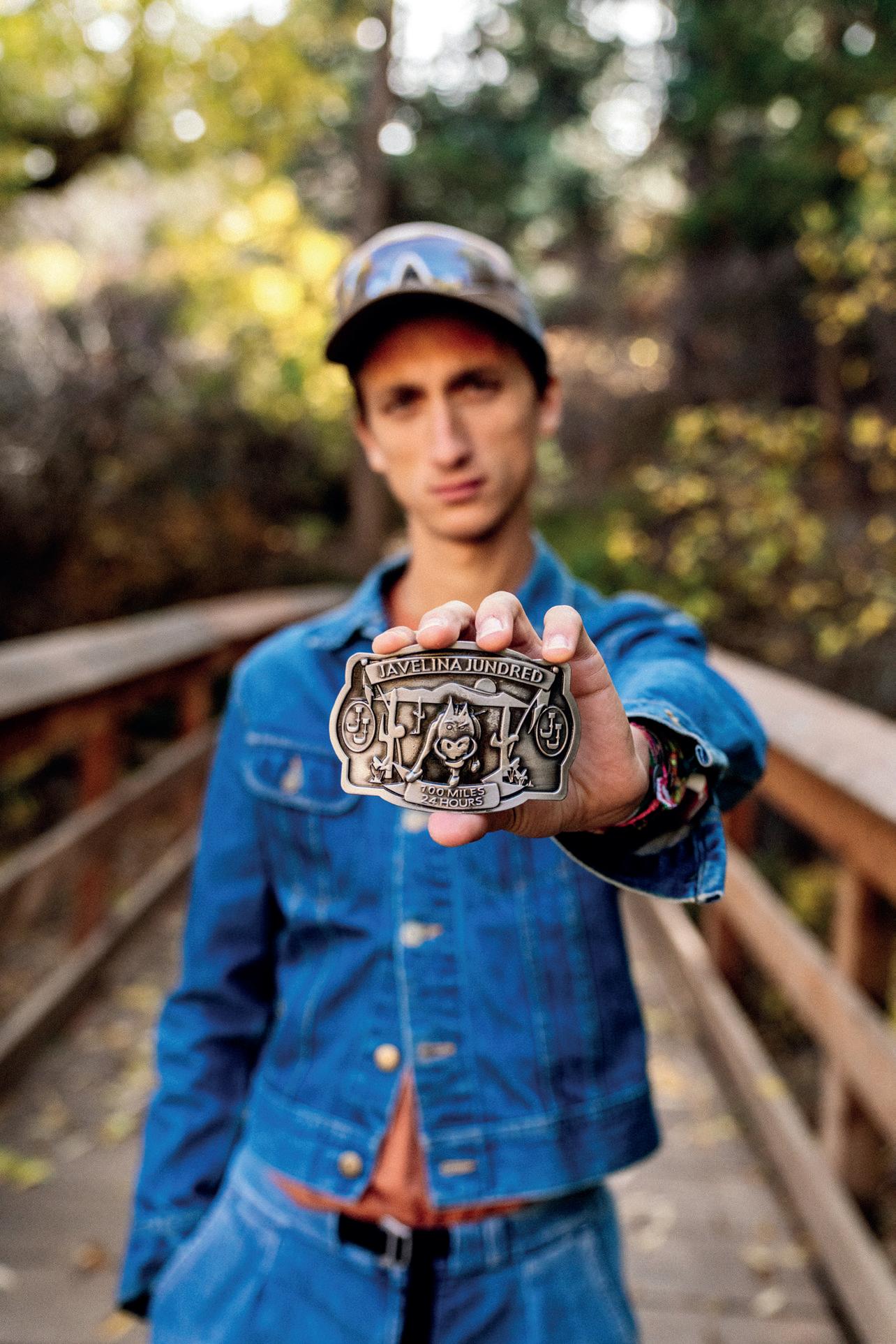
178
5. Colorado


There are places that for some astral alignment become the prototype of what will happen in the rest of the world five or ten years later. California. It is as if they were laboratories, once upon a time God took care of them, today Californians take care of them. For a specific slice of the world, that of people who go to the mountains, that laboratory is a small Colorado town called Boulder.
It was founded in 1859 on the ashes of an Arapaho encampment during the Pikes Peak Gold Rush. Although looking at it on a map today it looks like a suburban neighborhood of Denver, the state capital that is progressively expanding horizontally by incorporating everything that surrounds it, Boulder is an autonomous city, more or less with the same inhabitants as Trento, one of its college, a football team, and a website that reads: Boulder. Hip since 1858. Like Trento, Boulder is only partially a mountain city: it rises along Interstate 25 which divi-
des the great American plains from the Colorado Rockies. Its location, served by a large city and an international airport, but close to the mountains and places such as Eldorado Canyon, the Flatirons and Rocky Mountain National Park, all full of trails and cliffs, has contributed over the last thirty years to transforming it into a little outdoor mecca. Over the years, many athletes have moved here from across the country, including Scott Jurek and Jon Krakauer, they both moved here from Seattle.
As the city began to fill with bike shops, mountain gear flagstores, organic coffee shops, craft breweries and hipster clubs, the average cost of living increased marginalizing everyone who didn't have the means or the interest to pursue this gentrification. Today, a house in Boulder costs an average of $1 million. These are classic single-family homes in residential neighborhoods: a garden without a fence, a garage, plasterboard, two
179
floors, do you understand the genre?
Movie stuff, which in a neighboring state would easily cost less than half. Even according to those who live there, it is too expensive, so much so that after San Francisco, Los Angeles and Portland, it is the most expensive place west of the Mississippi River.
The city develops on Pearl Street, which vaguely resembles a European historic center: pedestrianized, relatively old, multi-storey buildings and commercial activities, bookshops, technical clothing stores, ethnic restaurants and cafés. Otherwise, it looks like one of those carpets you see in children's bedrooms, with the streets and the houses and the library and the fire station and the police station all in place: Boulder is that thing.
Walking through it in November you can breathe an air of collective torpor, full of infallible optimism. In Boulder, one gets the impression that all of humanity is jointly heading in the same direction. That there is a mission. And that everyone is part of it, that they have somehow found the meaning of life, and after the first days of neurosis you start to believe it too.
The university doesn’t give it a bohemian look. The University of Colorado is a medium-sized university but has a strong identity mainly due to the track and field team, the Colorado Buffaloes. There’s also a book, Running with the Buffaloes, that made Magnolia Road famous, a gravel road not far from Boulder, where the team trained. Their merchandise can be found everywhere in the city: from Safeway, in small shops on Pearl Street, in bookstores, in cafes. The team has had better years but we still go to a football game. They play versus the Oregon Ducks, it finishes 49 to 10 for seconds, but it's worth the $50 ticket.
Few things represent the United States of America like four hours of a football game. And I'm not talking about the Super Bowl, but any college
league game. Sports are only a sideline of it, so that people arrive after a game and leave mid-even if they've flown in from Portland to see it. It's more of a collective, transgenerational ritual, something you have to participate in to keep a certain image of that country alive. A lot of things happen during a game, many of them simultaneously with the action, so much so that distraction is encouraged, almost demanded: cheerleaders, bands, bison running around the field – it's not a metaphor, they really free a bison in the field, and how it is possible in such an environmentalist city, this remains a mystery. There is also the oath of graduates who will enter the army, during which a guy in uniform shouts something into a microphone: he says that those guys are putting their lives at the service of American democracy. Everyone around is drunk, there's Coca Cola on the floor and a strange sticky patina on the seats: it's American democracy that those guys will bring to the world, what they're swearing to defend, that collective ritual, fucking American football.
In reality, the city seems far removed from all of that. Boulder is a concentration of California east of the Rocky Mountains. A progressive, environmentalist, enlightened city, where hippies fleeing the increasingly rich and bourgeois West have found their space, only to discover that they have met the same fate as what they were fleeing from. This nascent outdoorsy civilization that finds its most complete form in Boulder has created an entire lifestyle in the last decade, with its myths and must-haves. The hipster and somewhat patchy mountaineers of the seventies have retired, and their ragged fetishes have now become status symbols of a new bourgeoisie, only a little more strange and hip, and with a converted van, which today is worth as much as an apartment . And then the dress code and the accessories: the checkered shirt, the metal cup and the steel bicycle.
When even a camping fridge makes status, a cultural movement has turned into an economy.
Society, you’re a crazy breed / I hope you’re not lonely without me.
I'm staying with a couple of friends of Noah's, she graduated in engineering at Stanford, he graduated in law at Harvard, both Californians. She sold her apartment in the Silicon Valley and moved here a year ago.
Their day starts quite late, like mine on the other hand. It snowed during the night, it's the first snowfall of the season, but she still went for a run with Django, their dog, and to drink coffee with some friends. There is the feeling that the mornings are eternal, that there is enough time to take care of yourself. No frenzy. In the morning Brent and Natalie have two different speeds, but in both cases it seems that nothing can curb their optimism. After a French press coffee they get to work, it will be half past ten. I seek refuge at Trident's, a bookstore with a cafeteria inside. I know the place from an old film about Anton Krupicka, but now it's full of students, freelancers, teachers. Everyone is working, everyone talking and screaming. Here everyone works from home, or rather, from the cafeteria. In general, it seems that in Boulder work is seen as something to be given as little time as possible, which takes time away from self-care and well-being. They give little importance to their career, but at the same time they earn a lot. On the other hand, to escape the neoliberal slavery of the workplace, to be masters of their own time, everyone here works from home, with the consequence that nobody ever really stops working. Freelancers have swept away fundamental rights such as working hours, but on the other hand, nobody here seems to care. The only difference between those who chose Boulder over San Francisco is a matter of priorities. Then, it's the same.
180
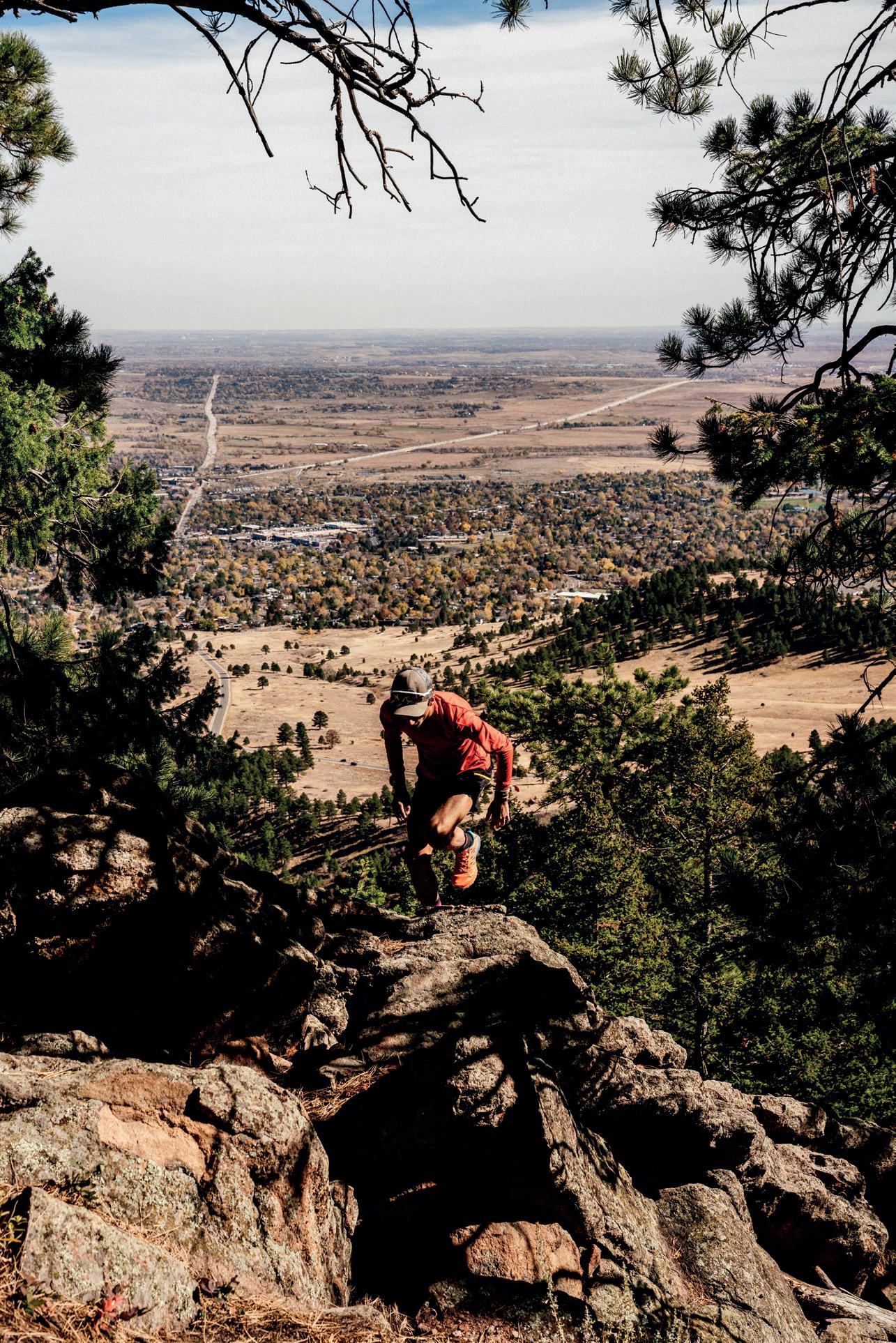
181
A coffee costs six dollars, and the sandwich you will have after the fifth cups of coffee to soothe the caffeine spasms costs fourteen. Every shop has a coffee shop inside, or at least a coffee pot. It's a bit hipster, but it creates affiliation, a sense of community. Nothing new, but we are still in a small town in Colorado, not in London. Gentrification may also be consuming Boulder, making it more fake and standardized, but then standardized against what? Boulder still looks just like itself. It's still the capital of sports, and it's changing as fast as its community is. That's why I came to Colorado after all.
Anyway, I need a break from this city. Denis is gone and with him the Mitsubishi. That car had become really ridiculous by now. One Friday, Noah and I take Brent's old stripped Lexus IS 300 and hit the road to Leadville. The car is missing the rear seats and in their place is a large chipboard that leaves the internal bodywork, cables and bolts exposed. The front seats look like they were attacked by a jaguar and the foam is ripped open and the springs are sticking out of the upholstery. It's snowing, and of course the wheels suck too, but by now we've absorbed the local optimism and decide the road to Leadville will be clear.
Leadville sits at an elevation of 10.000 feet above sea level and it is the highest city in the United States. It is an old mining center, abandoned during the twentieth century until in the early eighties Jim Butera and Ken Chlouber designed Leadville 100 to stem the country's crisis, inventing what later became one of the most legendary American ultramarathons, as well as one of the first. The local community is close-knit, as often happens in mountain villages, otherwise it is just a street with Victorian-style buildings, a pub, a Mexican restaurant and the local newspaper (one room), you can visit in fifteen minutes. Out of solidarity we buy something from
le isn't Aspen, or Vail, you can’t ski here, and it's cold, bloody cold in the winter. The only person capable of living here, apart from a few Mexicans, is Courtney Dauwalter. At the end of October there is already half a meter of snow and snow chains are used eight months a year.
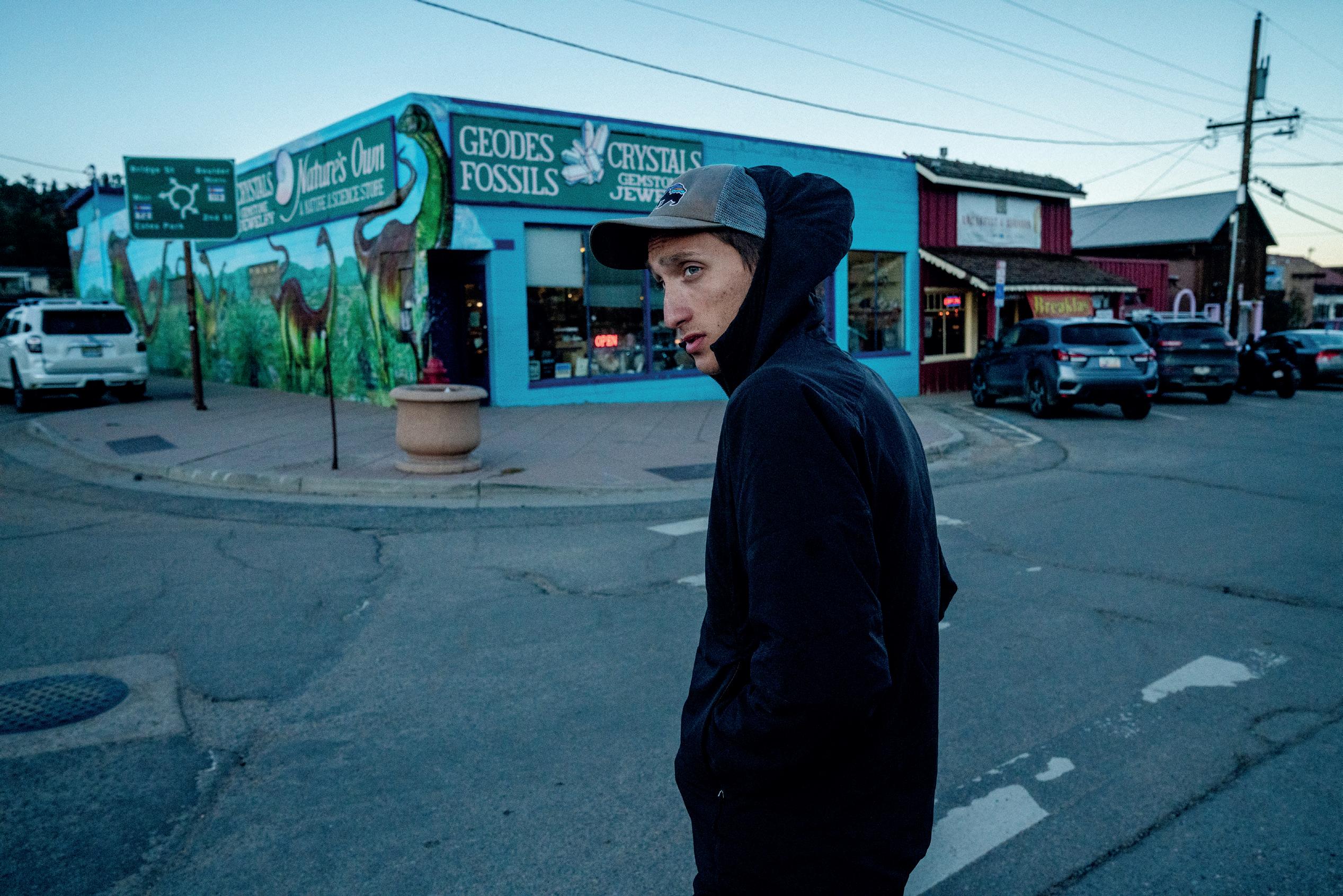
Obviously we don't have them, or the
metal sinks deeper and deeper. Stuck in the middle of nowhere, nice title for the piece: stuck in the snow 10 miles from the most remote city in the United States of America, in winter, two hours before sunset, four days after running a 100 miles. At least it seems like a story to tell. I try to take some notes on the edge of the Herald Democrat but the pen is empty, so I give
182
up and open a beer. No gasoline, no heating, but Noah remembers an old insurance with AAA (read triple-A), which he had forgotten to cancel the previous winter, because when he would ever get stuck in the snow in the States United States of America, living in Trento. The phone rings, then the voice on the other end asks us if we have a way to get out of there: mate, there's no way, there's nothing. The only possibility remains the police. What a fucking idea. However, one thing is certain: "the beer must go, and that can must not be here when the sheriff arrives.”
I'm not sure I get the point, but I trust
Noah's sense of the law, he's still a fucking Harvard lawyer after all. I get out of the car, close my eyes and throw the can in the middle of untouched nature. Fucking alcoholic. A bad throw, however, I throw it as far as possible and it falls a couple of meters in front of me, just over the side of the road, no way to reach it. I never had a chance as a baseball player. Meanwhile, they found us a tow truck - no cops. When the guy arrives it's dark, the temperature has dropped by fifteen degrees. He looks like something out of a Discovery Channel show, he questions us about our intentions. Americans tend to do this: if you're stranded in the middle
of nowhere, the tow truck will, after getting there, ask you if you're willing to pay a surcharge for any extra time, or if you'd rather be left there, to die, or waiting for someone to bring you a briefcase full of cash to pay for it. Either way, being abandoned is always a possibility. You can pay and be saved, or try to do something with what you have, in our case, old chains and a diesel-free Lexus.
The United States are the perfect place for living lost in the middle of nowhere or in a huge city, the in-between, like Boulder, doesn't work. When you're in the desert, or stuck in the snow in the middle of these mountains, even Starbucks feels like something, it feels like a full tank. But places like Boulder, somewhere in between, are too big to be wowed by a franchised restaurant and too small to find anything more than that. Among these thoughts we return to Leadville three and a half hours after leaving it, distraught and frozen, seeking asylum in the only place in town where spending is unreasonable. We spend dinner in silence, our eyes fixed on the steaming dish of curry and our bare feet wrapped around the duvet.
Who knows if I'll ever go back to this place. However, it seems like forever since we were in the desert.
Apart from Boulder, Estes Park and little else, Colorado is pure west. Mountains are mountains, and in Rocky Mountain National Park you have to think about it to understand that they are more than 4000 meters high, but they look really wild. Maybe it's John Denver on the radio, but Ponderosa Pine filters light differently than European trees. There is something the Alps don't have, or maybe just the fact that they are seven thousand miles from home.
To grasp the true meaning of Boulder, to understand the city, the role it has played in the ultrarunning scene, understand the meaning of this place, I

183
still have one last thing to do. I have to see one more person before I leave. I have to write the piece, after all.
I meet him in a downtown bar, where Pearl Street is open to traffic and looks like any other street. He doesn't come here often, once a month he says, even though he lives only two blocks north, it's overpriced and crowded here. It is all of these things, but there are no great alternatives. It's four in the afternoon, too late for a coffee and too early for a beer, however he opts for the former. We meet at The Laughing Goat, a classic Boulder hipster coffee shop.
Anton is originally from Nebraska but has lived here for thirteen years now, when he moved there for his master's degree. He is perhaps one of the best known figures in this sport, and in particular he represents a moment in his history, a moment of extreme freedom and creativity, before companies arrived and wiped out everything. Those were the years of Jenn Shelton, the Skaggs brothers, Joe Grant, Dakota Jones and Hal Koerner,
but he's the one who condenses them all together. Then he got injured he looked for other ways: cycling, climbing, gardening. Anton is one of the most creative figures in the outdoor world and one of those who has perhaps marked it most profoundly. In Italy he became famous for his beard and long hair, and because he ran bare-chested and cut the soles of his shoes: we never really understood anything about this sport.
I spend the days leading up to that meeting thinking about what to ask him, but nothing comes to mind: what do you want to ask Anton Krupicka that you don't already know? Skateboard magazine-style back-andforth interviews no one reads anymore. What music do you listen to, what is your favorite trick, who cares. On the other hand, my English sucks and if he didn't want to talk it would be over. There is a big difference between meeting an athlete in Chamonix all dressed up the day before UTMB and meeting him here at his home. It's completely different. Anyway, I decided, no interview.
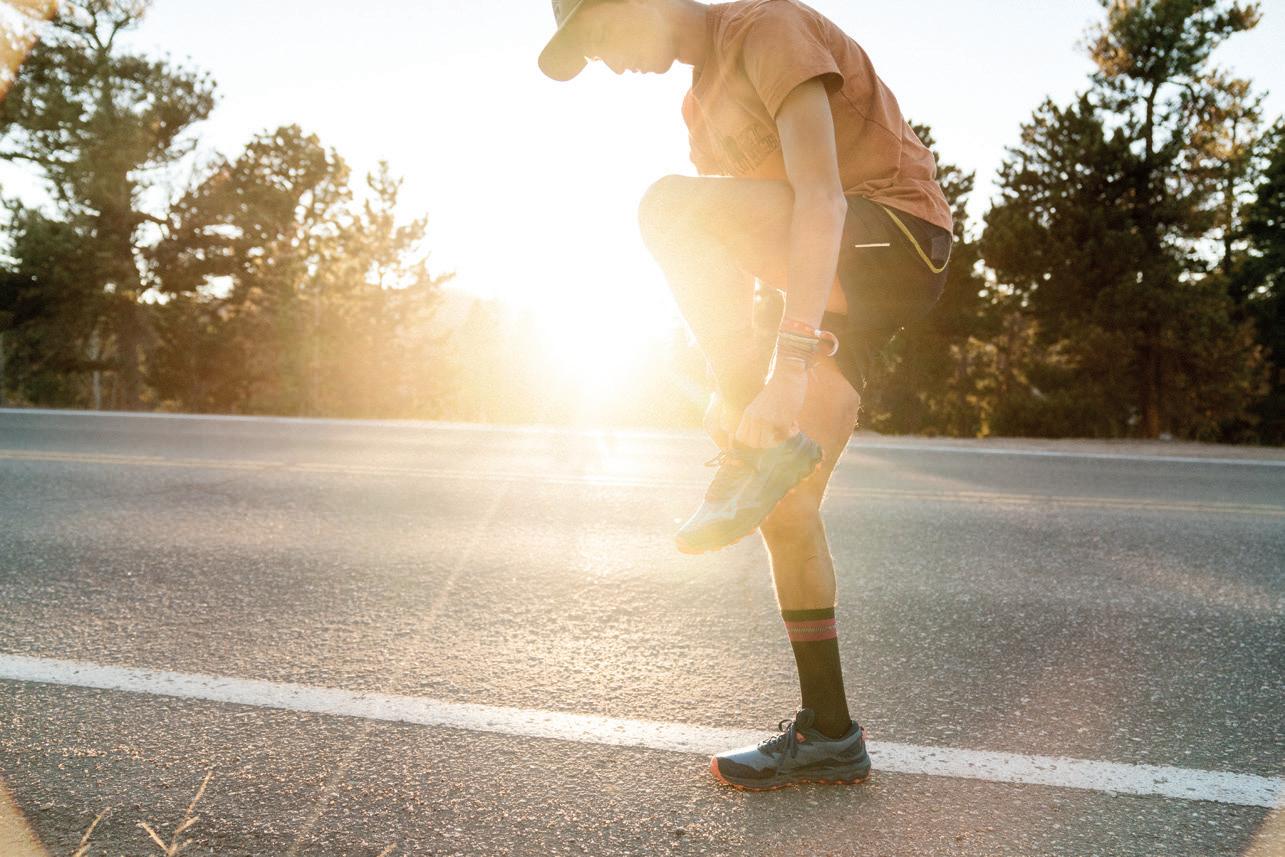
It's the last evening in Boulder, there's an autumn light, warm and cold at the same time, the sun low on the Flatirons and the houses of Melody Heights wrapped in orange plane trees. I take Natalie's bike and take the road south to downtown. I stand outside the cafeteria for a while with my cell phone in my hand, to give myself some composure, then I look up and there he is: Anton Krupicka. We talk about mutual friends, distant friends, and we talk about Boulder, Chamonix, Trento. We talk about what the outdoors is becoming, how ultrarunning is changing, and aboutthis city. It's the first time this has happened to me, Americans almost never understand our rejection of the commercialization and spectacularization of our sport. In the US, a thing can have a message and move money at the same time. For us, the two things are irreconcilable. Instead, he understands it, it moves me.
We talk about how Trento and Boulder are at two different stages of the same journey. Trento is as if it were at a primordial level, a lot of people
184
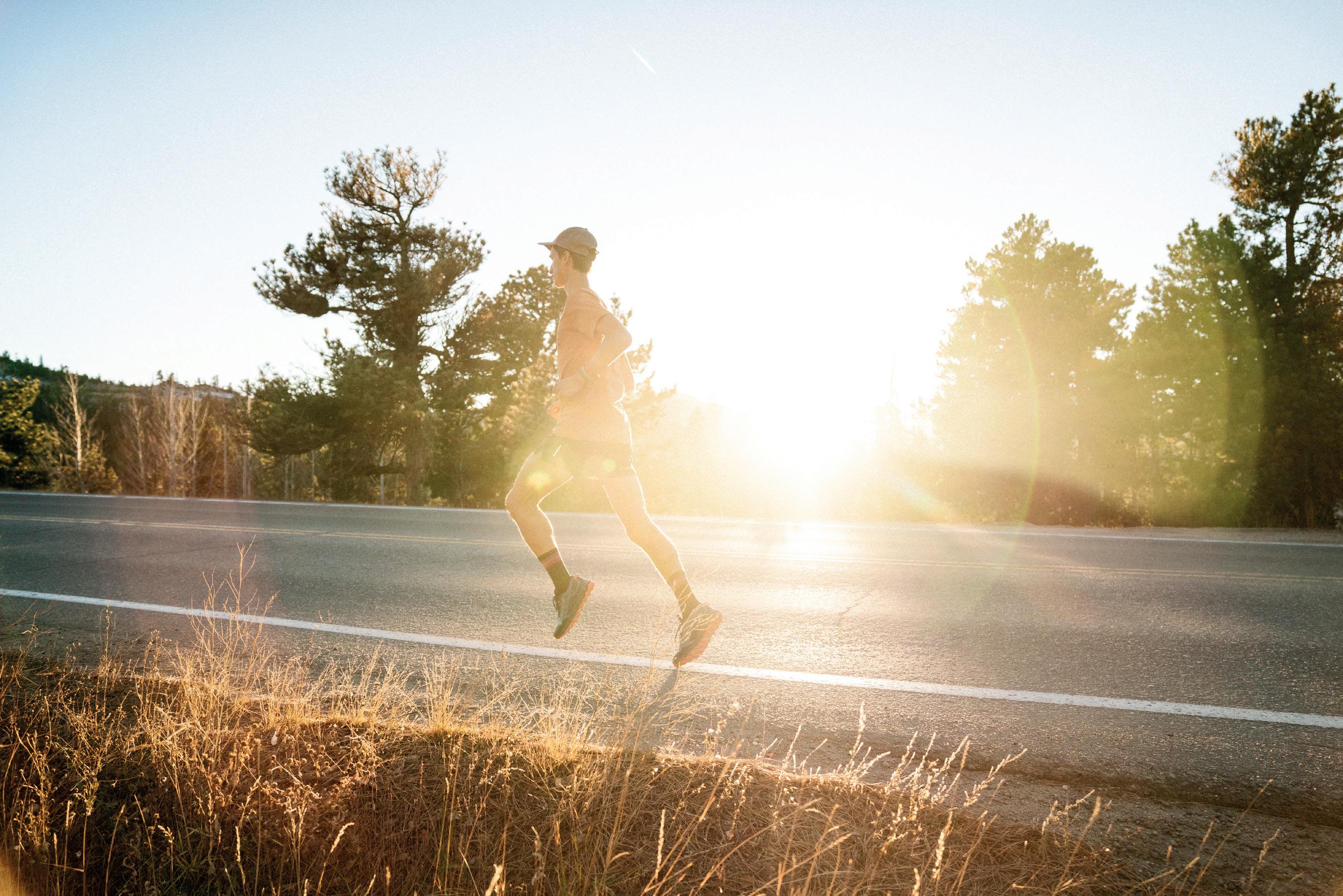
185
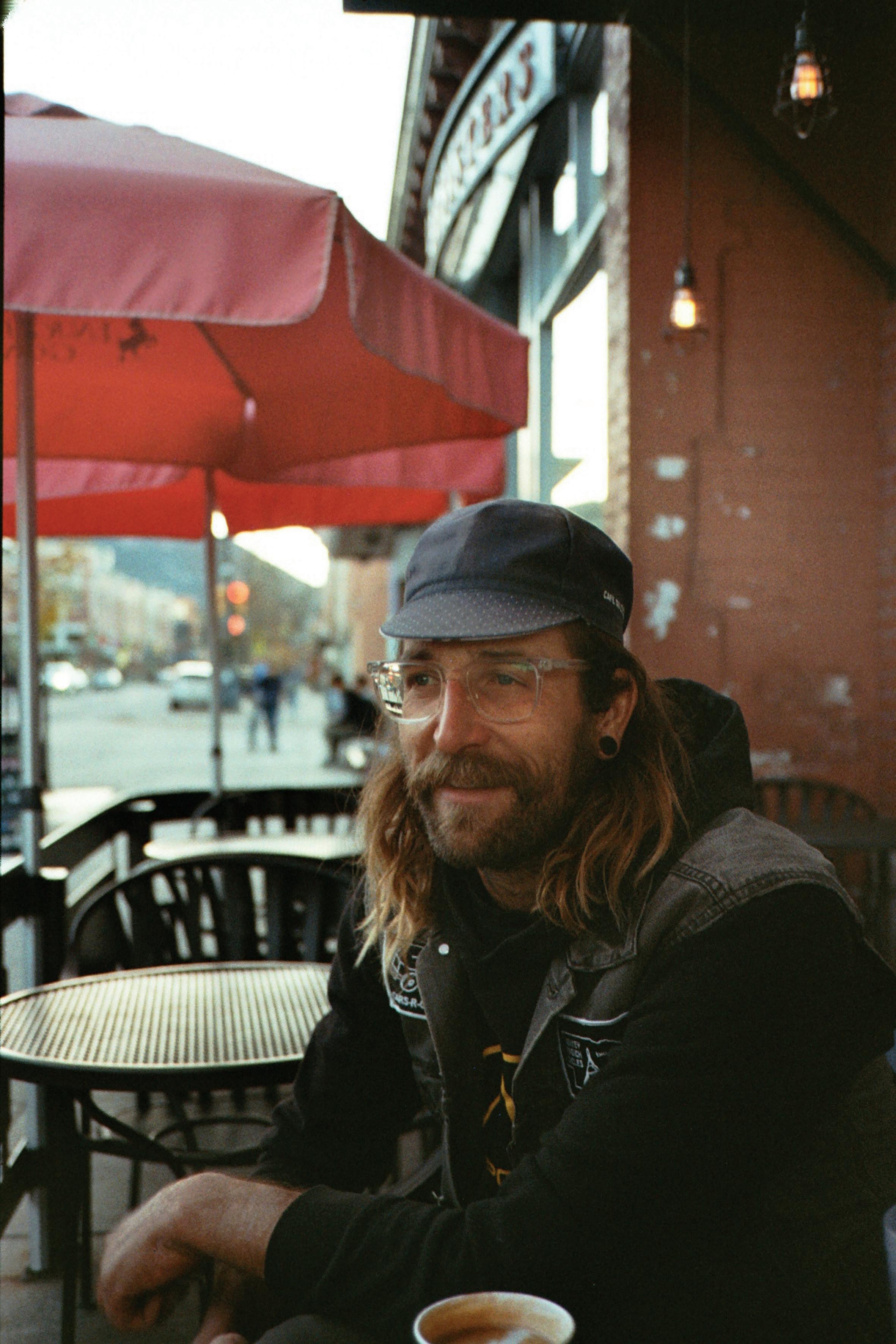
play sports but there is no sense of community. In Boulder all this hap pened fifteen years ago, and now it is at the other end of the road. Here the outdoors has been institutionali zed and has become homogenized, and the times when Leadville won and slept in public toilets before the race are long gone. Maybe In the High Country's Boulder is over, but he ha sn't changed, he still looks like the same idealist of the New Balance vi deos. However, it has happened that all the others have become like him, and he now rides his bike with his girl and giggles, aware that he was among the first to ride that wave, and we do nothing but try to chase him.
I won't tell him, but I have a poster of him hanging behind my bedroom door. Not a great photo, but Camilla lets me keep it. And now here I am, on Pearl Street, having coffee with him, with the Flatirons in the background. He's the reason I came here. There it
are not the heirs of Jim Bridwell and Gordon Ainsleigh, not of those assholes of Joshua Tree, of the sixties, but of our parents, of the eighties, we are just a little more angry and depressed. And there's nothing wrong with
and perhaps a little more now than before. With this buckle I close a circle that started a year ago, and I had to get here somehow.

187

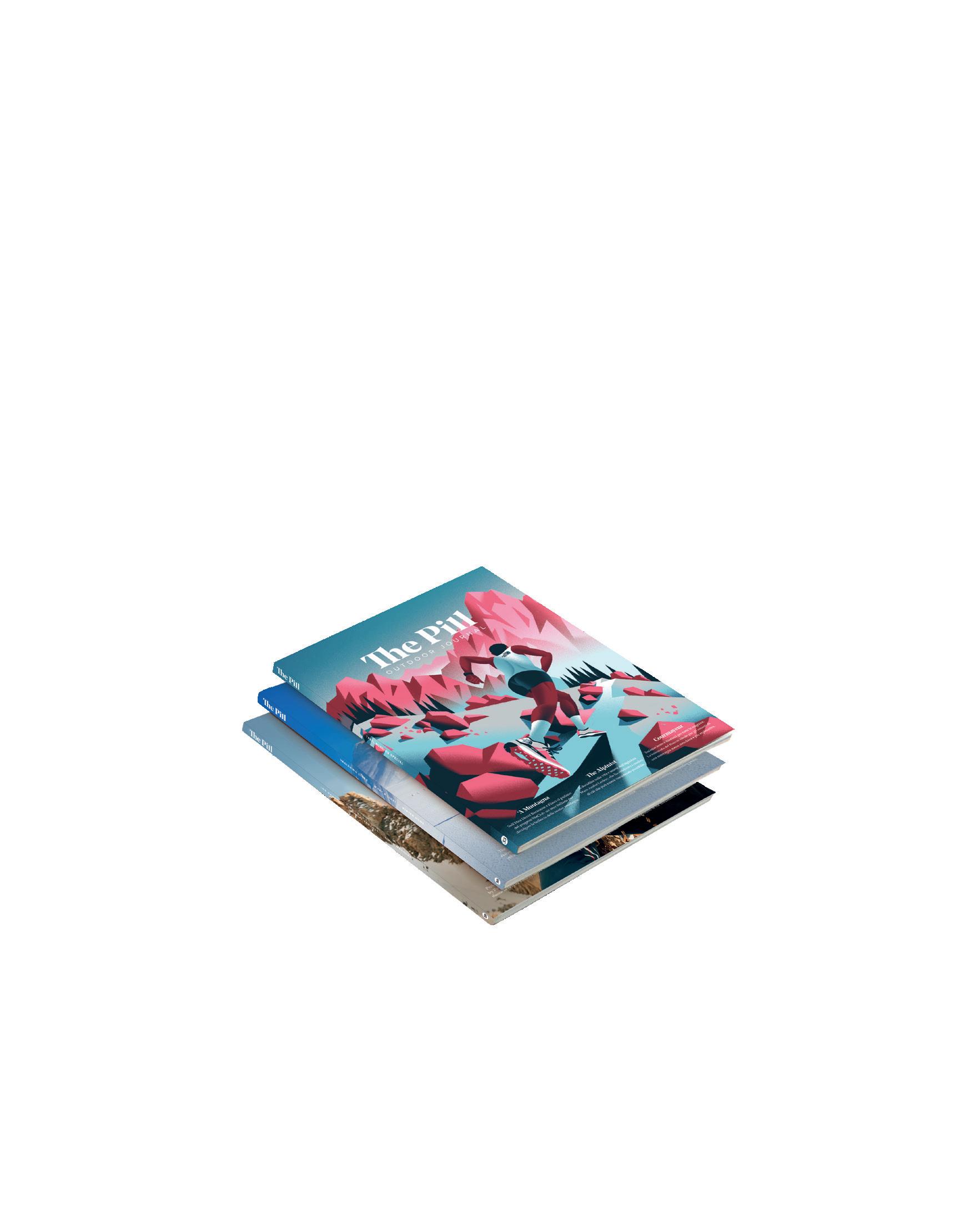
1607. LEADING RELAX HOTEL MARIA 1608. RESIDENCE LASTÈ 1609. RESORT DOLCE CASA 1610. HOTEL BELLAVISTA 1611. WINE HOTEL SAN GIACOMO 1612. HOTEL ALPECHIARA 1613. HOTEL PIANDINEVE 1614. SPORT HOTEL VITTORIA 1615. ALPIN HOTEL SONNBLICK 1616. HOTEL WALDHOF 1617. HOTEL BARRAGE 1618. HOTEL VILLA GLICINI 1619. HOTEL EUROPEO 1620. BEVERLY HOTEL 1621. DOLOMEET BOUTIQUE HOTEL 1622. HOTEL CRISTINA 1623. LEFAY RESORT&SPA DOLOMITI 1624. OLYMPIC PALACE 1625. BLU HOTEL ACQUASERIA 1626. GRAND HOTEL PARADISO 1627. HOTEL GARNI SORRISO 1628. HOTEL MIRELLA 1629. JOLLY RESORT&SPA 1630. RESIDENCE CLUB 1631. CHALET LA CIASETA 1632. FAMILY HOTEL GRAN BAITA 1633. HOTEL ANDA 1634. HOTEL TERME ANTICO BAGNO 1635. WELLNESS FASSA 1636. HOTEL CASTEL PIETRA 1637. FALKENSTEINER HOTEL 1638. HOTEL RUDOLF 1639. K1 MOUNTAIN CHALET 1640. MAJESTIC HOTEL & SPA RESORT 1641. PARKHOTEL SCHÖNBLICK 1642. ROYAL HOTEL HINTERHUBER 1643. GRAND HOTEL LIBERTY 1644. GRAND HOTEL RIVA 1645. HOTEL ANTICO BORGO 1646. HOTEL EUROPA 1647. HOTEL LIDO PALACE 1648. HOTEL LUISE 1649. HOTEL PORTICI 1650. HOTEL SOLE RELAX 1651. VILLA NICOLLI 1652. HOTEL LEON D’ORO 1653. HOTEL BELLERIVE 1654. HOTEL LAURIN 1655. HOTEL SALÒ DU PARC 1656. RIVALTA LIFE STYLE HOTEL 1657. HOTEL ORSO GRIGIO 1658. HOTEL VILLA STEFANIA 1659. NATURHOTEL LEITLHOF 1660. PARKHOTEL SOLE PARADISO 1661. POST HOTEL 1662. RESIDENCE SILVIA 1663. SPORTHOTEL TYROL 1664. ZIN SENFTER RESIDENCE 1665. HOTEL LA VETTA 1666. HOTEL LADINIA 1667. RENÈ DOLOMITES BOUTIQUE 1668. X ALP HOTEL 1669. HOTEL MONTE SELLA 1670. CHRISTOPHORUS MOUNTAIN 1671. HOTEL AL SONNENHOF 1672. HOTEL CHALET CORSO 1673. HOTEL CONDOR 1674. HOTEL MAREO DOLOMITES 1675. HOTEL TERESA 1676. RESIDENCE PLAN DE CORONES 1677. SPORTHOTEL EXCLUSIVE 1678. HOTEL BAITA FIORITA 1679. HOTEL RESIDENCE 3 SIGNORI 1680. HOTEL VEDIG 1681. CHABERTON LODGE 1682. HOTEL LA TORRE 1683. RELAIS DES ALPES 1684. AGRITURISMO MASO LARCIUNEI 1685. APARTMENTS SUNELA 1686. ARTHOTEL ANTERLEGHES 1687. ASTOR SUITES B&B 1688. BIANCANEVE FAMILY HOTEL 1689. BOUTIQUE HOTEL NIVES 1690. CHALET ELISABETH 1691. GRANBAITA DOLOMITES 1692. HOTEL AARITZ 1693. HOTEL ACADIA 1694. HOTEL ALPENROYAL 1695. HOTEL ANTARES 1696. HOTEL CHALET S 1697. HOTEL CONTINENTAL 1698. HOTEL DORFER 1699. HOTEL FANES 1700. HOTEL FREINA 1701. HOTEL GARNI DOLOMIEU 1702. HOTEL GENZIANA 1703. HOTEL MIRAVALLE 1704. HOTEL OSWALD 1705. HOTEL PORTILLO DOLOMITES 1706. HOTEL SOMONT 1707. HOTEL SUN VALLEY 1708. HOTEL TYROL 1709. HOTEL WELPONER 1710. LUXURY CHALET PLAZOLA 1711. MOUNTAIN DESIGN HOTEL 1712. MOUNTAIN HOME VILLA ANNA 1713. RESIDENCE ISABELL 1714. RESIDENCE VILLA FUNTANES 1715. RESIDENCE VILLA GRAN BAITA 1716. THE LAURIN SMALL&CHARMING 1717. WELLNESS RESIDENCE VILLA 1718. RESIDENCE VILLA AL SOLE 1719. HOTEL TRE CIME SESTO 1720. ALPENWELLNESSHOTEL ST.VEIT 1721. APARTMENTS RIEGA 1722. BERGHOTEL SEXTEN 1723. CIMA DODICI B&B 1724. FAMILY RESORT RAINER 1725. HOTEL ALPENBLICK 1726. HOTEL DOLOMITENHOF 1727. HOTEL MONIKA 1728. HOTEL MONTE CROCE 1729. BAD MOOS 1730. GRAND HOTEL SESTRIERE 1731. HOTEL CRISTALLO 1732. HOTEL IL FRAITEVINO 1733. HOTEL SHACKLETON MOUNTAIN 1734. PRINCIPI DI PIEMONTE 1735. ACTIVEHOTEL DIANA 1736. ARTNATUR DOLOMITES HOTEL 1737. HOTEL WALDRAST DOLOMITI 1738. MIRABELL ALPINE GARDEN 1739. NATUR RESIDENCE 1740. SCHWARZER ADLER 1741. SENSORIA DOLOMITES 1742. DOLMITES NATURE 1743. BAD RATZES 1744. HOTEL CEVEDALE 1745. PARADIES MOUNTAIN RESORT 1746. GRAND HOTEL DELLA POSTA 1747. GRAND HOTEL BRISTOL 1748. GRAND HOTEL DES ILES 1749. HOTEL ASTORIA 1750. HOTEL LA PALMA 1751. HOTEL MILAN SPERANZA 1752. HOTEL REGINA PALACE 1753. HOTEL EDELHOF 1754. HOTEL IL CERVO 1755. CURT DI CLEMENT ECO 1756. HOTEL CENTRALE 1757. HOTEL DOSSES 1758. ALPINHOTEL VAJOLET 1759. GRAND HOTEL TREMEZZO 1760. HOTEL LENNO 1761. ALBERGO ACCADEMIA 1762. BOUTIQUE EXCLUSIVE B&B 1763. GRAND HOTEL TRENTO 1764. HOTEL AMERICA 1765. HOTEL BUONCONSIGLIO 1766. BÄRENHOTEL 1767. BERGHOTEL HOTEL 1768. HOTEL CHRISTOPH 1769. KRONPLATZ-RESORT 1770. HOTEL DU LAC 1771. HOTEL ROYAL VICTORIA 1772. HOTEL VILLA CIPRESSI 1773. GRAND HOTEL MAJESTIC 1774. HOTEL ANCORA 1775. HOTEL BELVEDERE 1776. HOTEL PALLANZA 1777. GRAND HOTEL MIRAMONTI 1778. HOTEL DELLE ALPI 1779. HOTEL RESTAURANT LILIE 1780. WELLNESS PARADISE MOENA MOENA MOENA MONTEBELLUNA ITA ITA ITA ITA
We should talk about running and instead we talk about market rules, influencers, brands. We talk about regulations, organizations, federa tions, teams, competitions, results, training, athletes, photographers, prices and we never talk about pe ople. The community only makes sense as a compass to read market trends, and to understand what wor ks and what doesn't work and what will work tomorrow. We talk about these things and don't do anything really meaningful, anything worth living for. We measure people’s wor th by the hours they spend behind a desk and the checks they write, not by the actual emotional impact they miles is about downsizing, under-

standing that all these things don't help you much when you've run 100 miles and still have a whole night to run ahead of you. The only things that matter are a flying eagle, the sky that burns the mountains, the blue of a lake, a song, a half-sentence, short, muffled. This sort of things. The rest
Oh, it took 300 days for the timbers to be raised, and the silhouette was seen for miles around. And the gables reached as high as the eagles in the sky, but it only took one night to bring it down. When
192

jack-wolfskin.com
DURABLE RELIABLE ADAPTABLE
INTENSE SHOES

UP FOR ANYTHING



























































































































































 BY DAVIDE FIORASO & SILVIA GALLIANI
BY DAVIDE FIORASO & SILVIA GALLIANI























































 BY EVA TOSCHI
BY EVA TOSCHI










 BY EVA TOSCHI
BY EVA TOSCHI

 BY ILARIA CHIAVACCI
BY ILARIA CHIAVACCI



































 ODLO X-ALP TEAM ATHLETE
ODLO X-ALP TEAM ATHLETE


























 BY STEFANO LIONETTI CREW RUNAWAY MILANO
BY STEFANO LIONETTI CREW RUNAWAY MILANO




























































